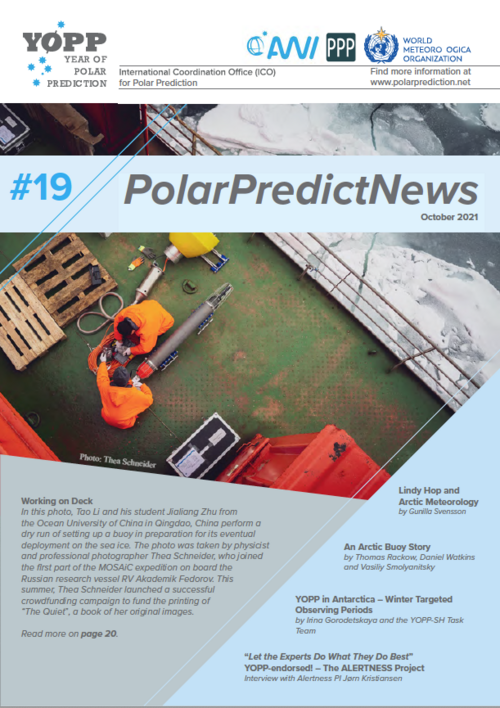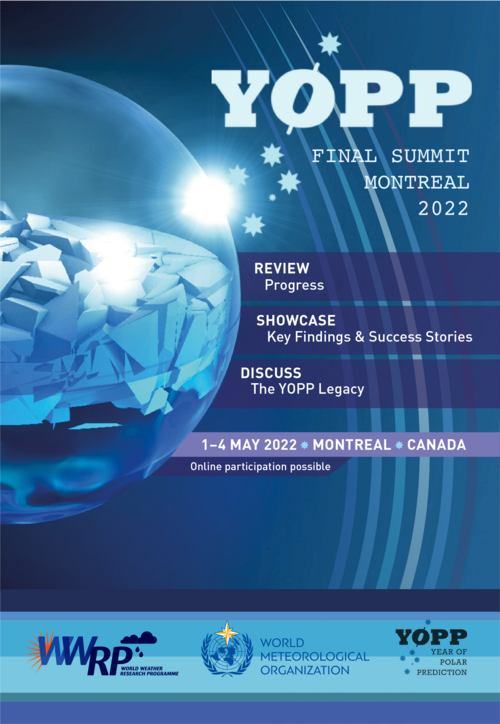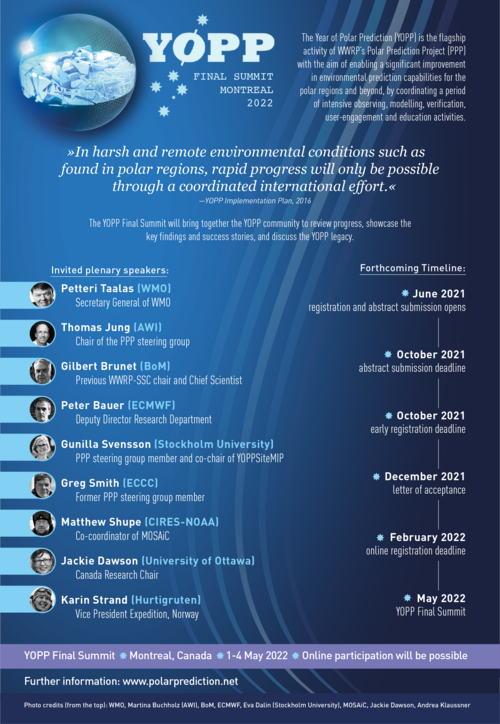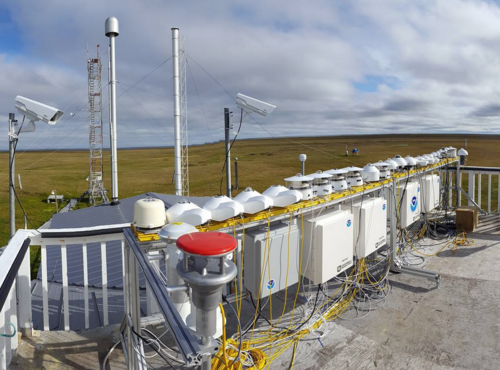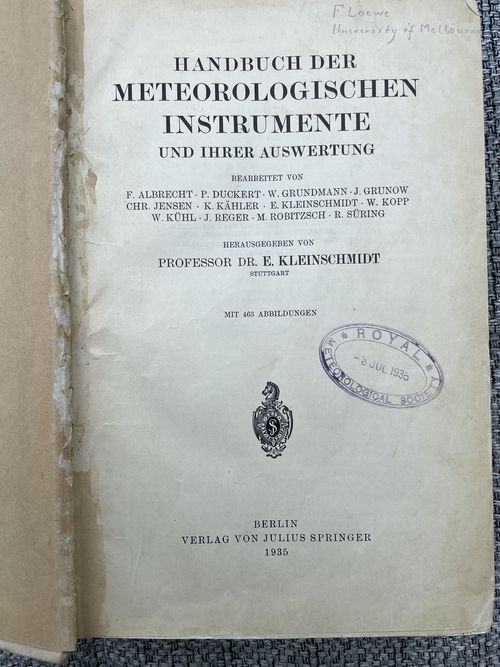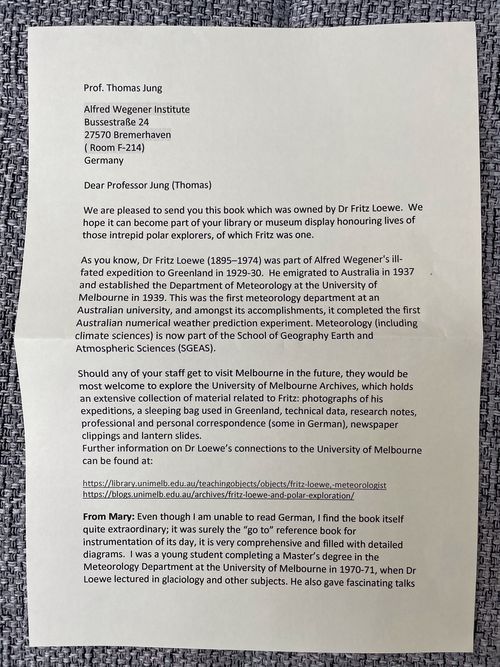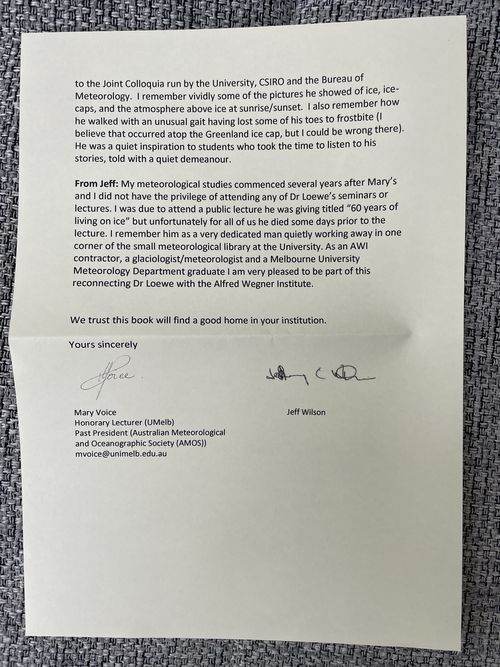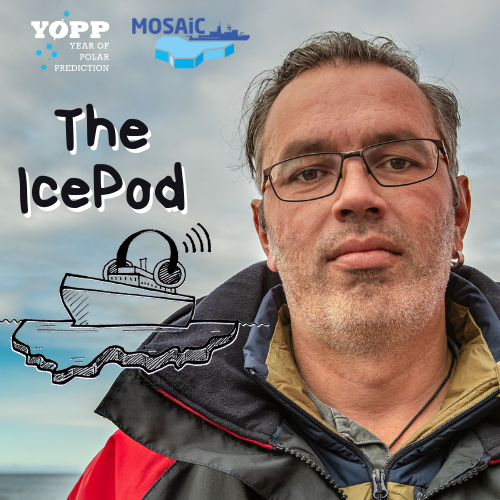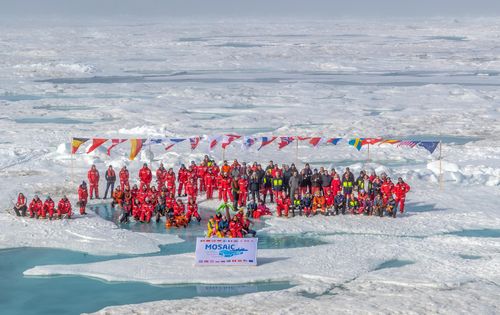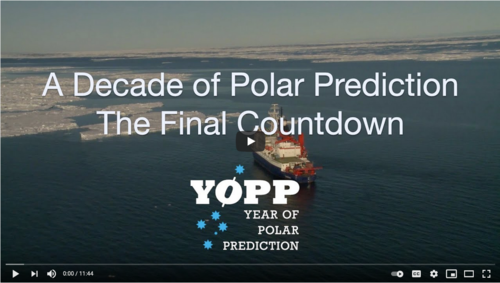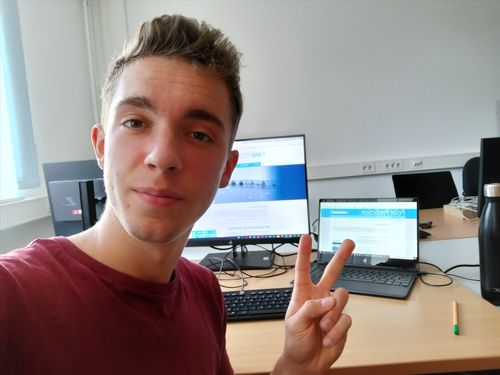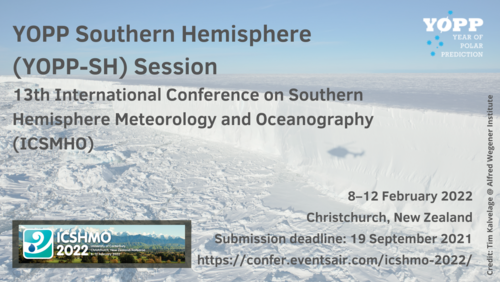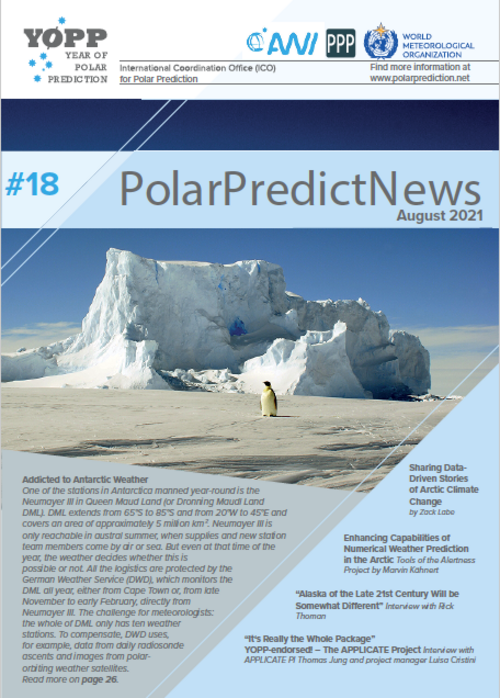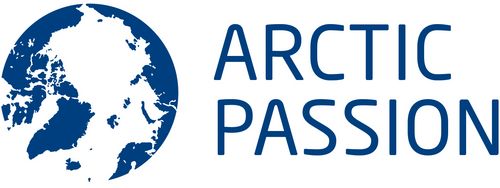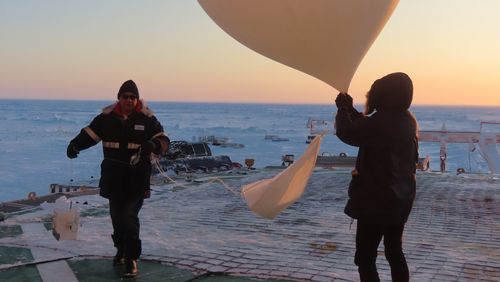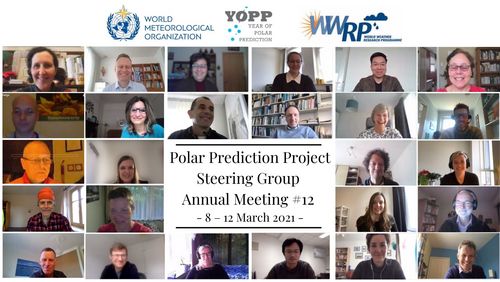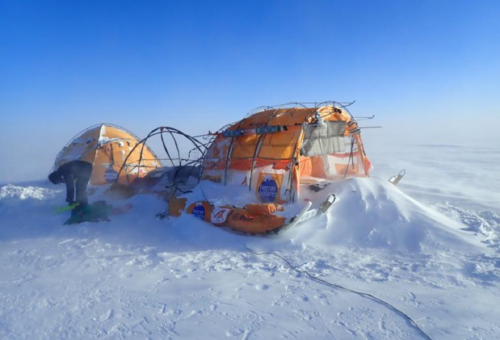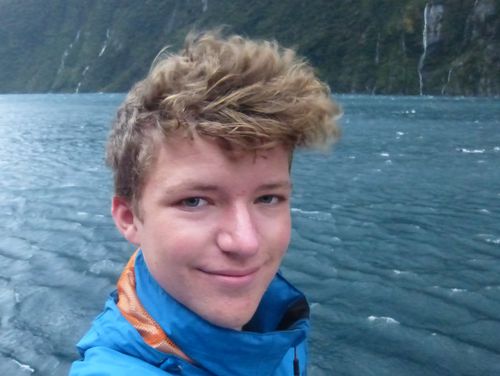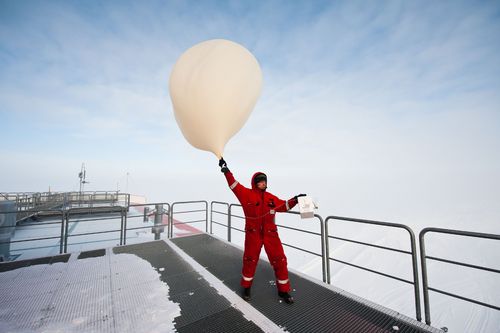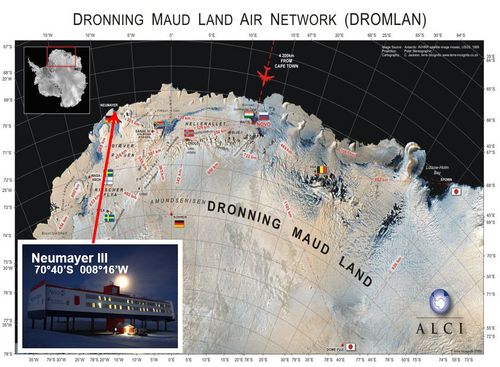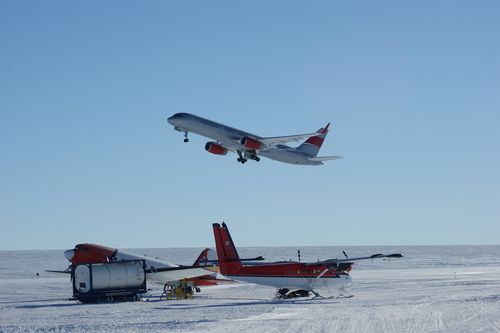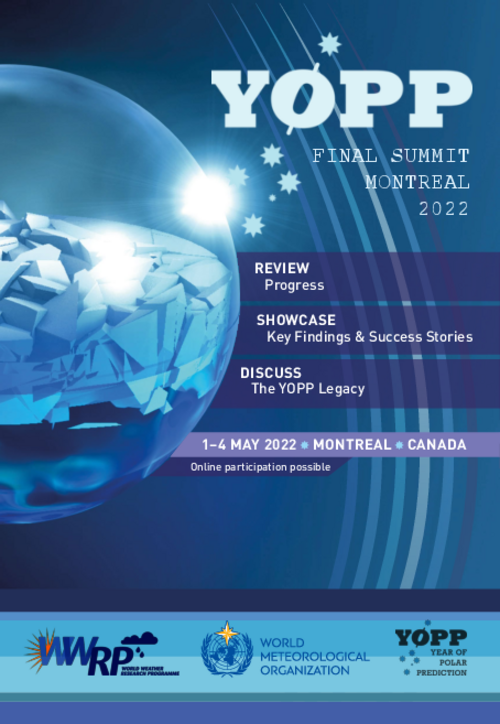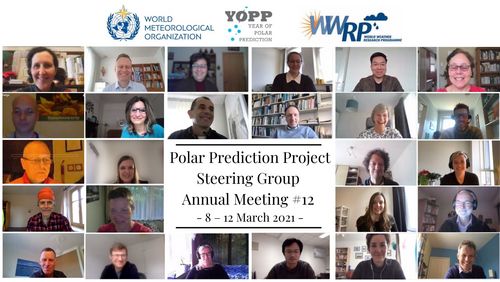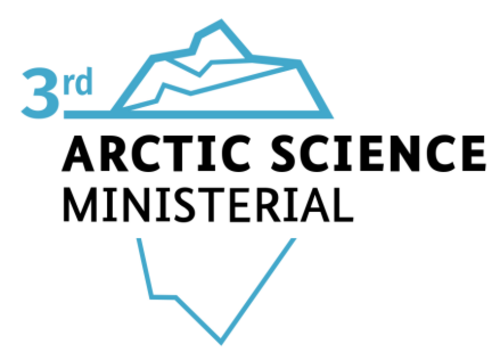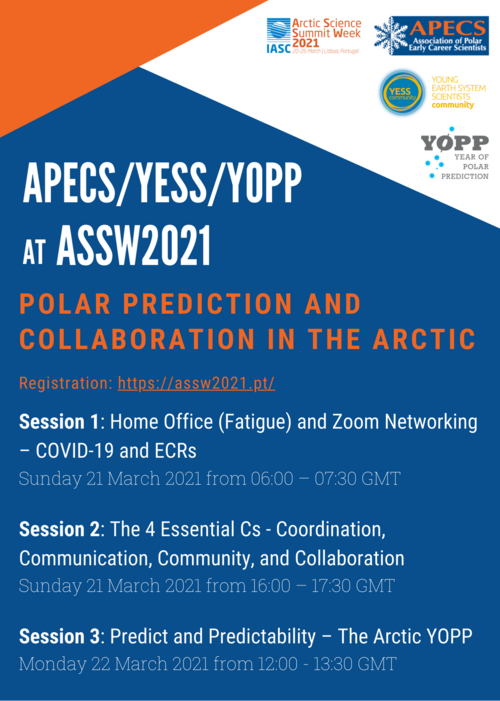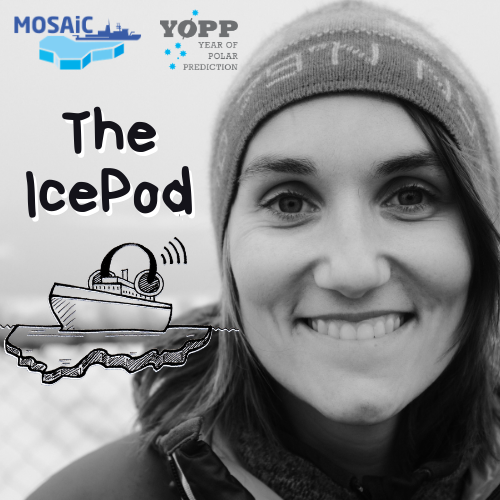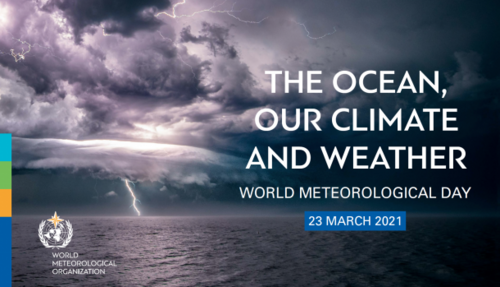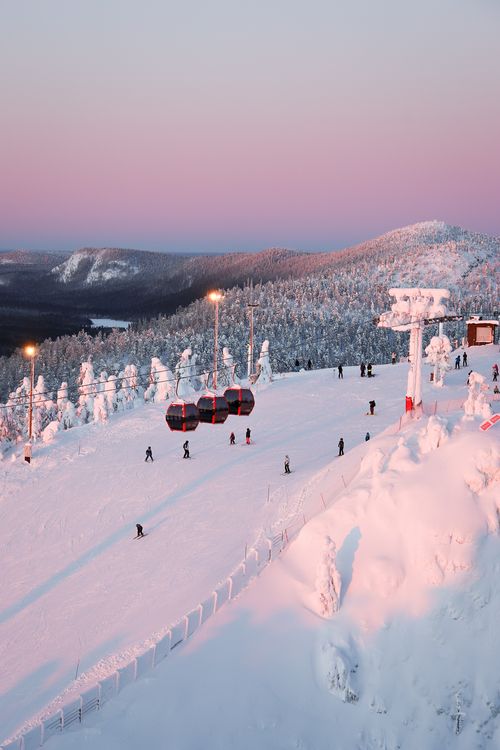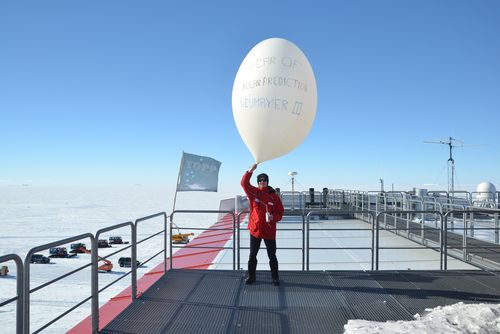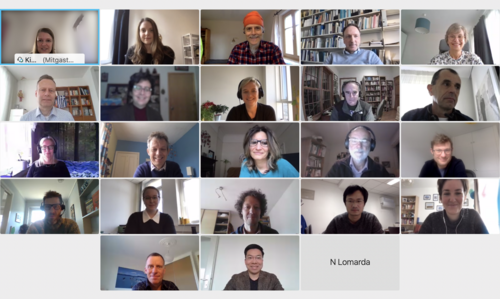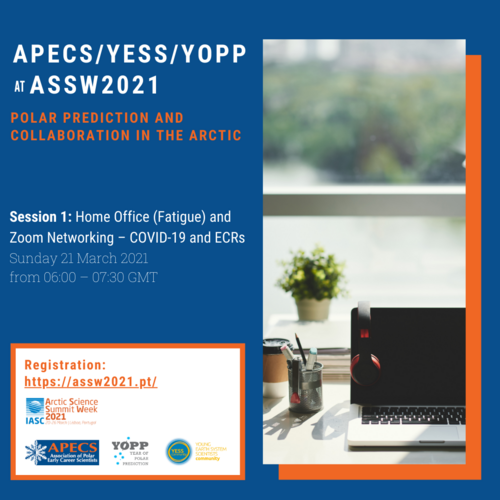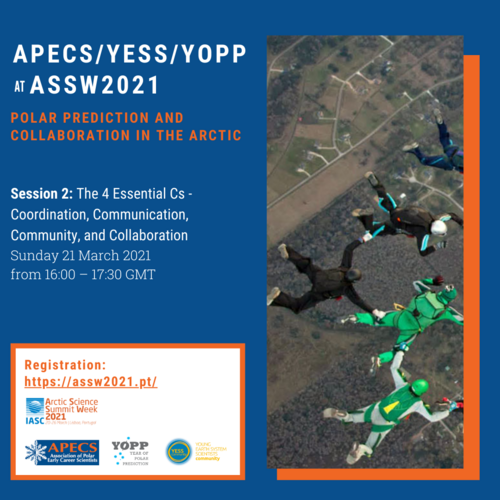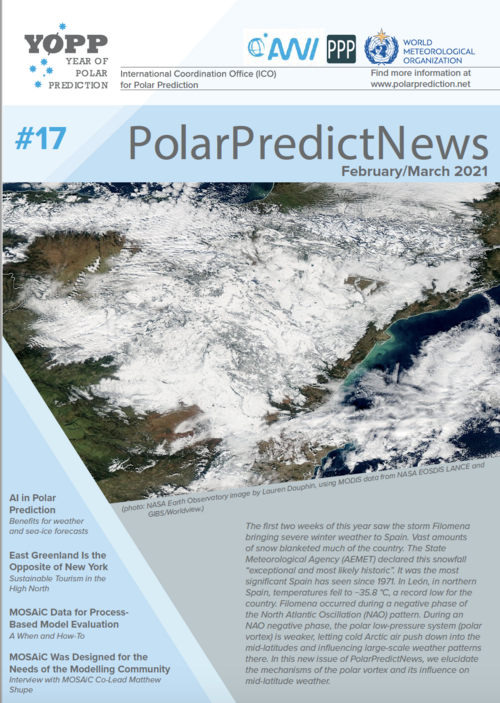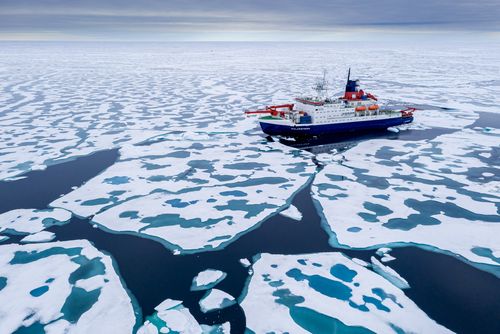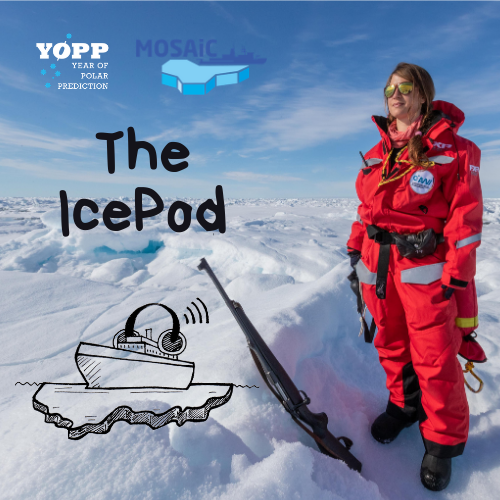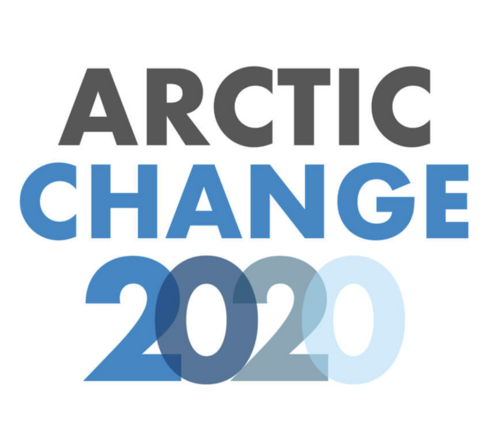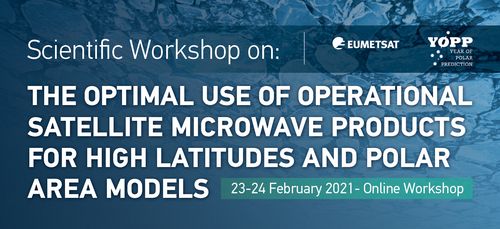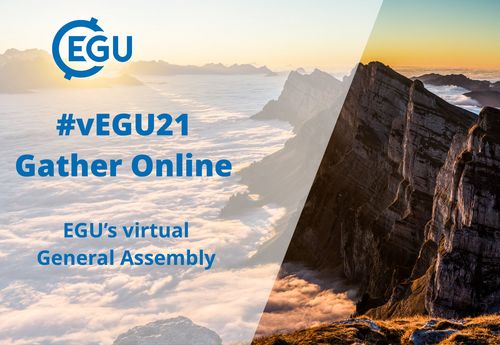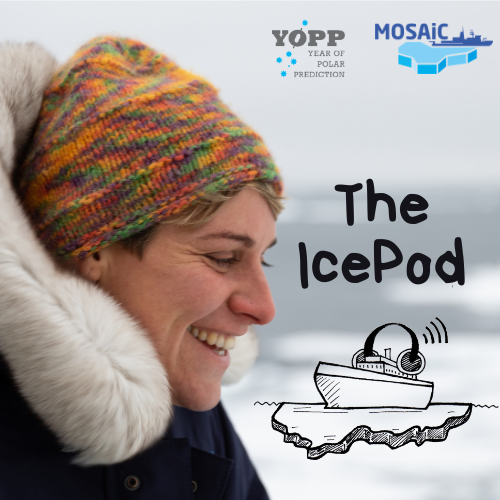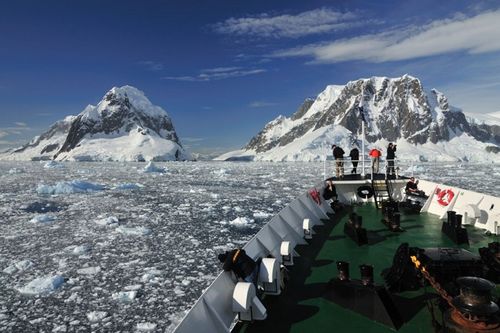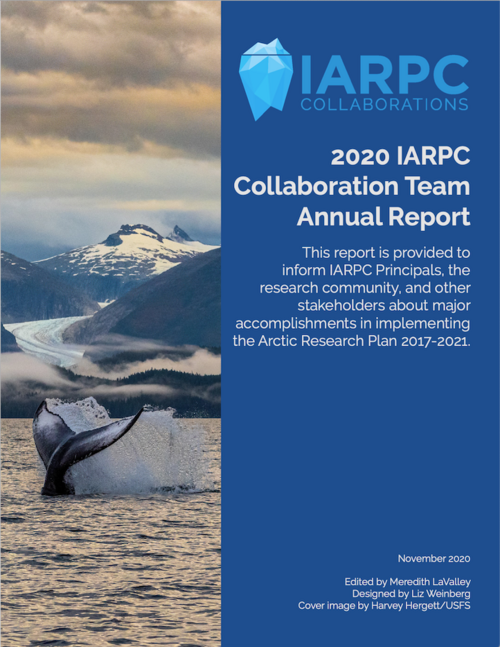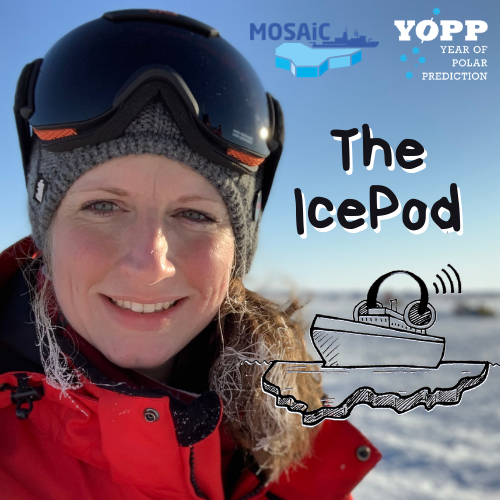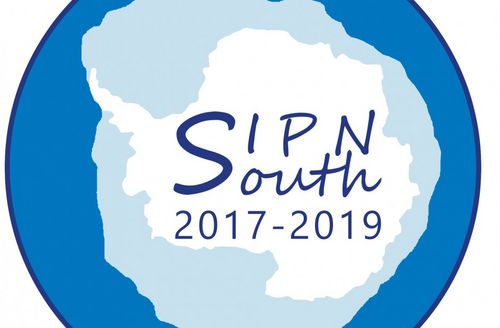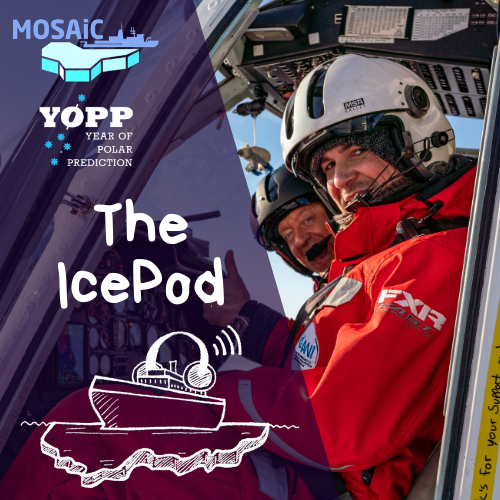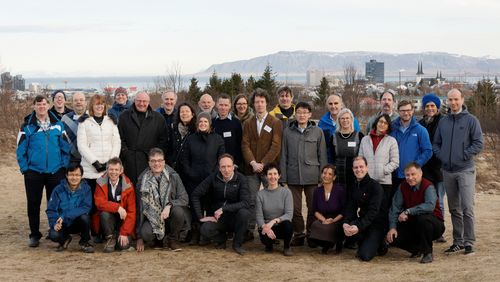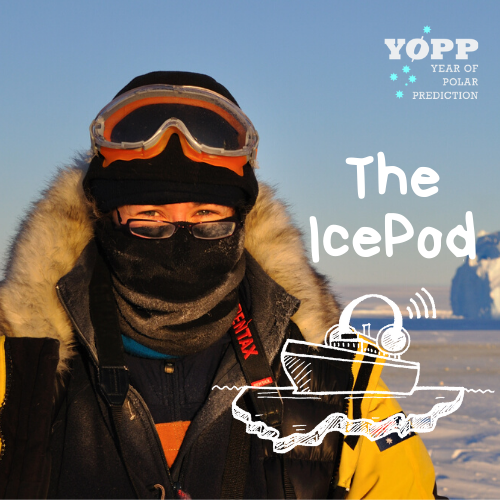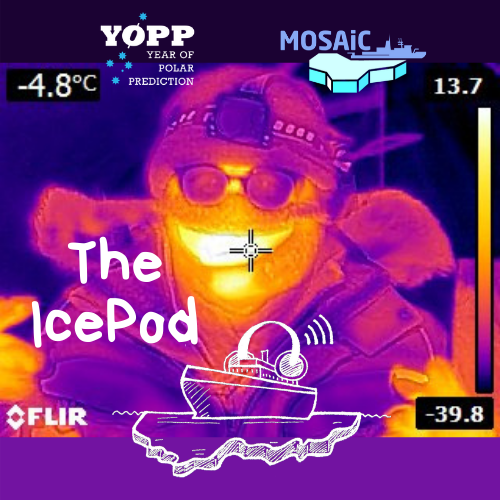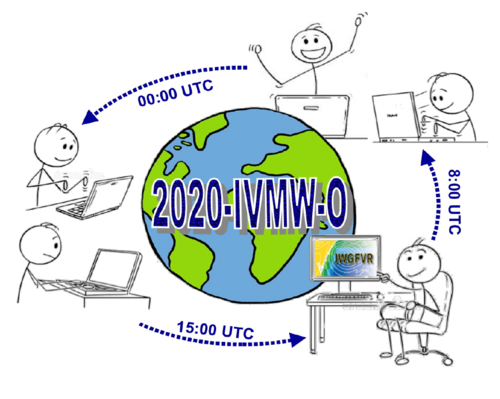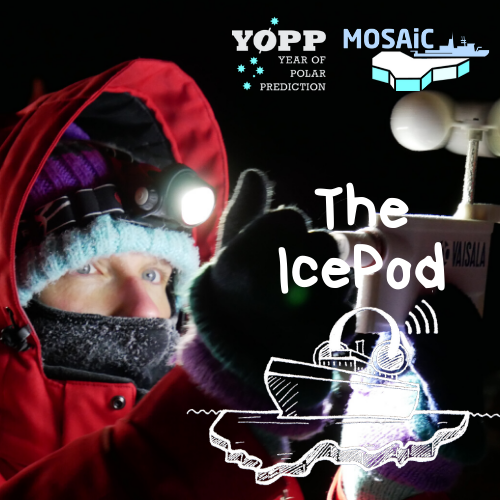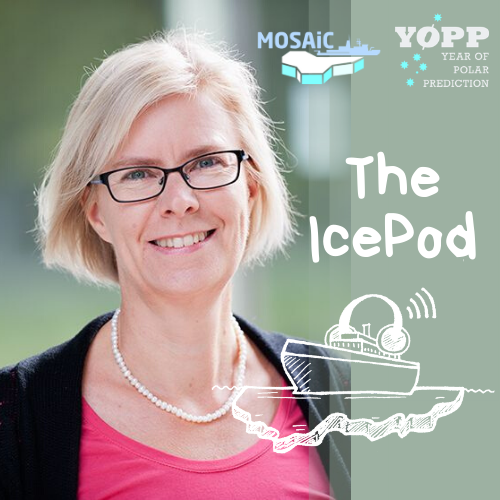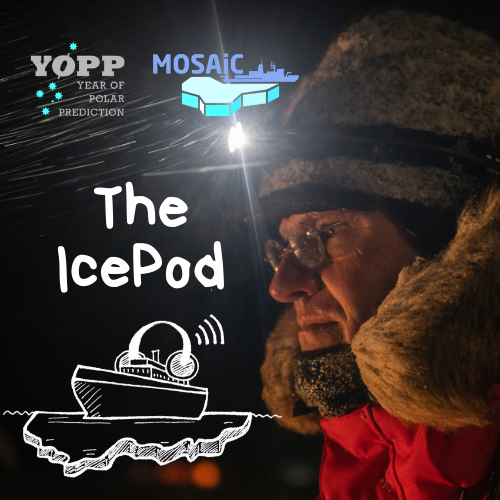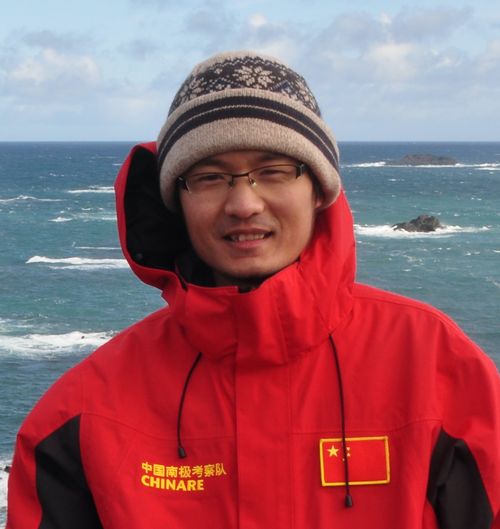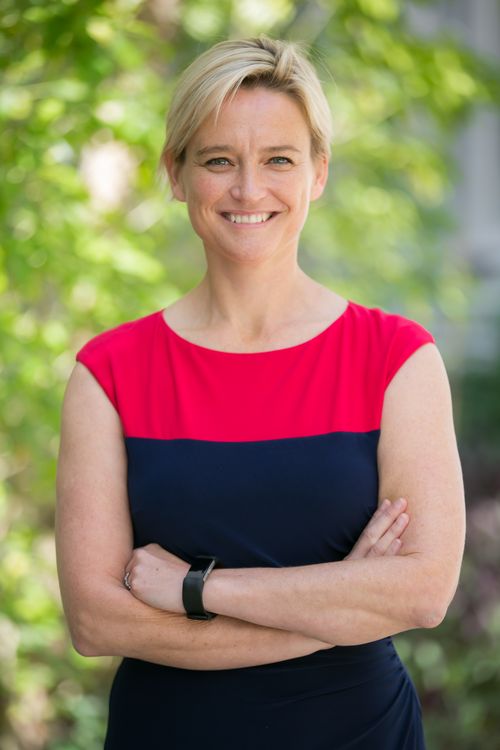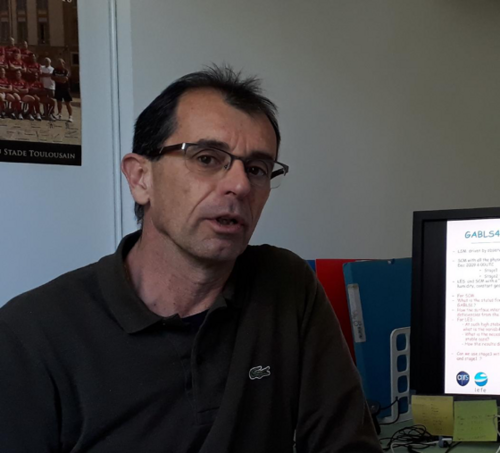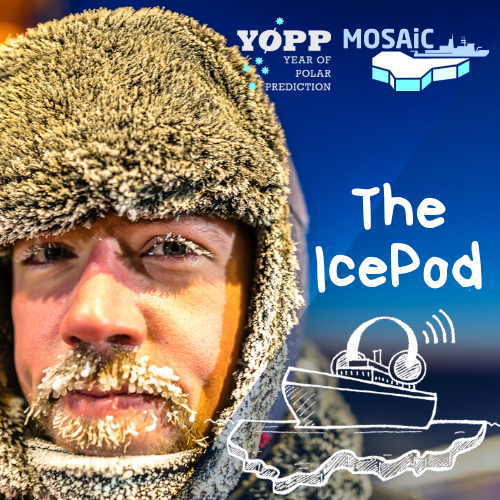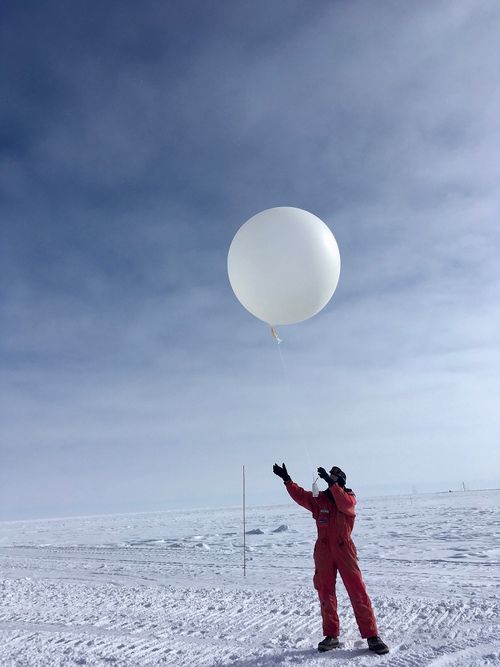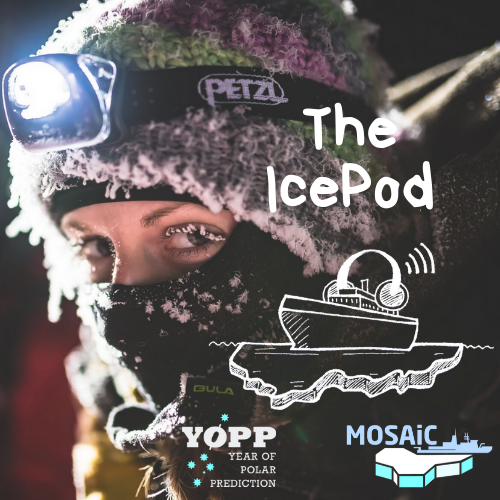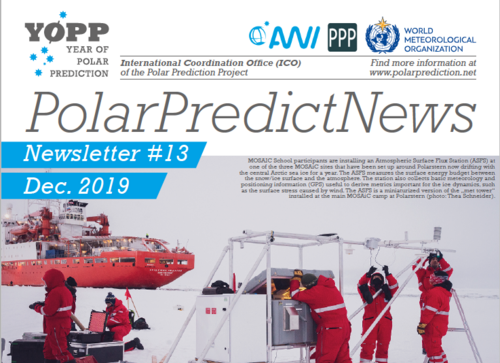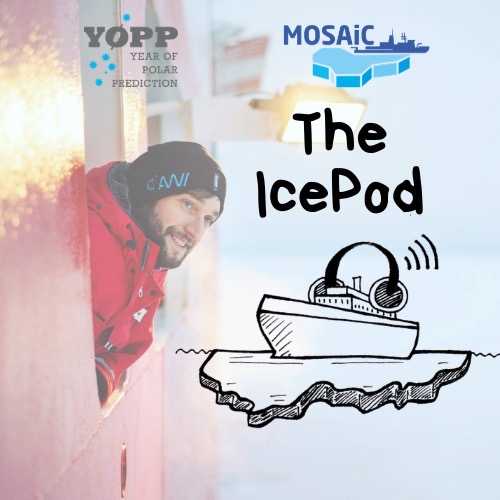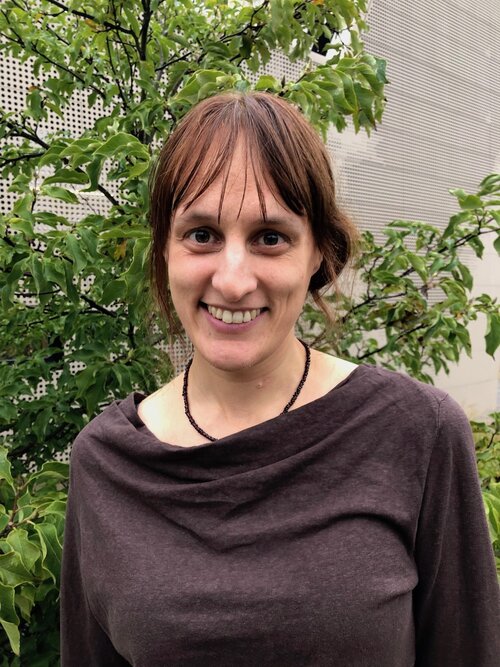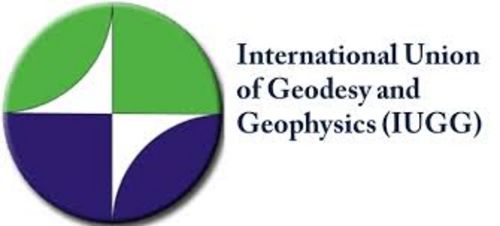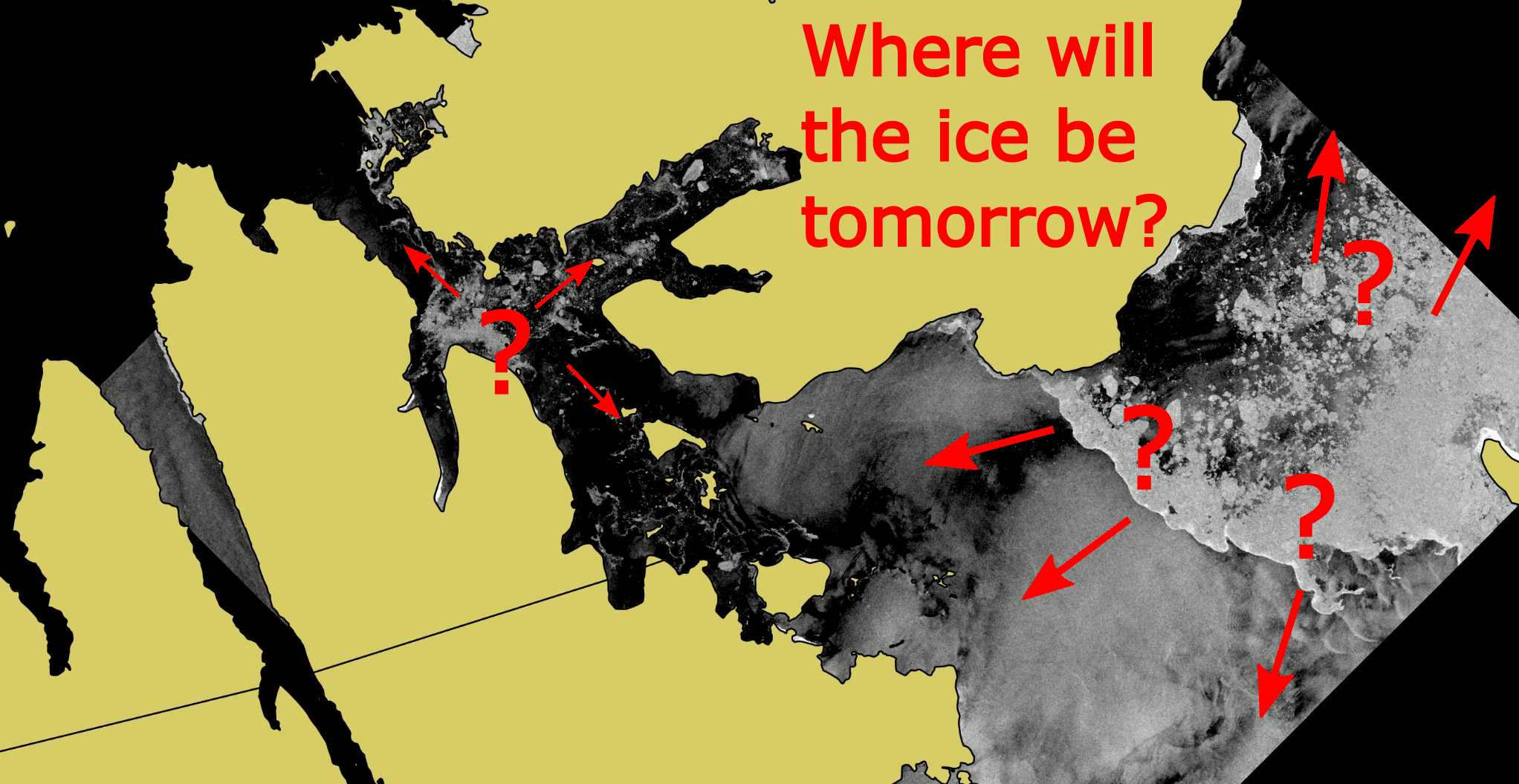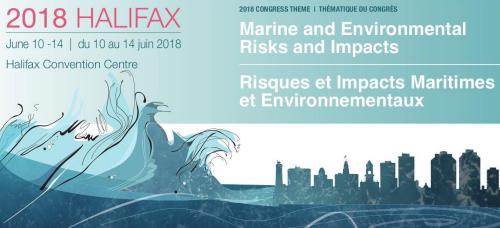ARCUS has compiled a list of all AGU sessions, town halls, and lectures focused on the Arctic to help the Arctic research community connect at AGU. Please visit our AGU Arctic Sessions page to view them.
NEWS
On this page you can find relevant news related to polar weather and climate prediction and predictability. Besides, you can download all issues of our newsletter called PolarPredictNews. We also provide an overview of PPP and YOPP appearance in the media.
05 September 2022: The polar regions: a perfect testbed for the digital twin capabilities
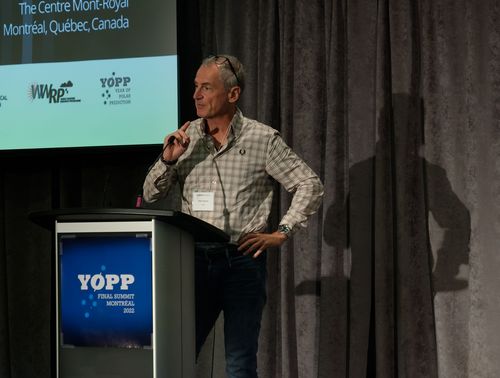
Photo: Neil Gordon
Dr Peter Bauer, Director of Destination Earth for the European Centre for Medium-Range Weather Forecasts (ECMWF), explained how digital twins can support polar science in a keynote speech at the opening day of the Year of Polar Prediction (YOPP) final summit, held in Montreal until 1 September.
His speech about Destination Earth raised strong interest among the audience, and some of the questions couldn’t be answered during the live event as the session ran out of time.
Dr Peter Bauer took the opportunity to challenge the polar research community to get involved on DestinE, saying “I think it would be great to create demonstration cases of the digital twins in polar areas. A digital twin is a tool. We don’t create digital twins for the sake of digital twins, they are supposed to help science, for the benefit of what we are trying to achieve here in the YOPP and PPP.”
More about Peter Bauer's speech can be found here.
19 May 2022: New Dates for Polar Prediction School
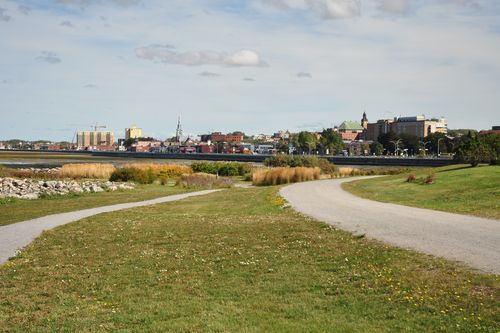
Rimouski
Photo: Gwenaëlle Gremion
Due to the uncertainty of the world health situation, the YOPP Final Summit and the Polar Prediction School, originally planned for spring 2022, were postponed. Now the new dates for the Polar Prediction School have been set.
By Nadine Hillenbrand
The YOPP Final Summit and the Polar Prediction school were postponed. The YOPP Final Summit was rescheduled for 29 August – 1 September 2022 and now a new date for the Polar Prediction School has been decided. The school will take place from 23-28 August 2022 at Université du Québec à Rimouski and end in Montréal ahead of the YOPP Final Summit. This offers the possibility for ECRs and students not only to join the Polar Prediction School but also to participate the YOPP Final Summit.
The school is planned for 30 students coming from all over the world to discuss Arctic and Antarctic weather and seaice predictions. The six-day school program will offer lectures and assignments as well as field work in the region around Rimouski. The students and early career researchers will be introduced to sea ice and predictability and will learn about user engagement and polar prediction in the southern hemisphere. The program includes social activities like a Speed Dating Event in Rimouski and a Q&A Session in Montréal to learn about researchers from different disciplines who work and contribute to environmental and polar prediction.
17 May 2022: Good bye, Nadine
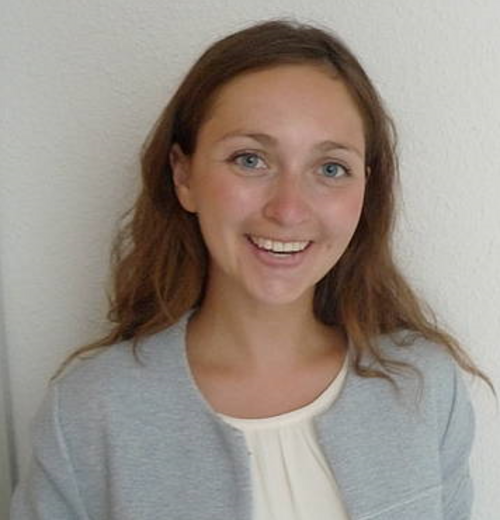
Photo: private
The International Coordination Office for Polar Prediction would like to thank Nadine for her support with the Polar Prediction Project. On 1 June 2022, Nadine will leave the ICO and embark new adventures.
Nadine joined the ICO in summer 2021 in order to support the conclusion of the decade long polar prediction project. Nadine’s initial role focused on the preparation of the YOPP Final Summit and the third Polar Prediction School originally scheduled for spring 2022 now taking place in August 2022. Due to her previous work in knowledge transfer and outreach in the educational project climate fit, Nadine was a perfect fit with the communication, outreach and education team. After five years at Alfred Wegener Institute, Nadine is starting a new adventure on the Mediterranean Sea, following her passion for nature and ocean. The International Coordination Office is grateful for her continuous effort and commitment and wishes her the very best for future endeavors.
17 May 2022: Welcome to ICO

Photo: private
A new member has joined the International Coordination Office for Polar Prediction. From 1 May on, our new colleague Ke Li will support the ICO.
Ke received her Bachelor degree in Business English in China and her Master degree in Applied Linguistics in England at the University of Essex. In May 2022, she joined Alfred Wegener Institute to support the Paleoclimate Dynamics section and the Climate Dynamics section including the Polar Prediction Project. Ke is helping with the office management and is responsible for administrational and financial tasks of the Polar Prediction Project. Prior to AWI, she worked in a German StartUp company and helped build up a more sustainable, more transparent and decentralized food supply chain to support small-to-medium-sized food manufacturers. Ke is looking forward to her work with the Paleoclimate Dynamics section and Climate Dynamics section, including the ICO.
29 April 2022: YOPP Final Summit Early Bird has been extended

In four months time on 29 August 2022 the Year of Polar Prediction (YOPP) Final Summit will take place in Montréal, Canada. The scientific program is now live on the YOPP Final Summit website and early bird registration has been extended until the end of May.
by Nadine Hillenbrand
The YOPP Final Summit is fast approaching and will be held from 29 August – 1 September 2022 in Montréal, Canada. The conference will unite the Polar Prediction Community and present outcomes and achievements of the ten year Polar Prediction Project. Final Summit participants will range from operational centres and academia, to environment services, polar prediction users and northern communities. Details of sessions and speakers can now be found online on the of YOPP Final Summit website: Program | YOPP Final Summit | 29 August - 1 September, 2022. Furthermore, the early bird registration deadline has been extended from May 15 to 31 May 2022 to allow participants time for planning and to organize fee payment. Standard registration fees within the early bird period are CAD$ 400, after May 31 the fees will be raised to CAD$ 550. All details on the Final Summit registration and deadlines can be found here.
Use @polarprediction on Twitter and Instagram to follow us for further updates on the YOPP Final Summit.
11 April 2022: Extra radiosonde launches during the second Special Observing Period in the Southern Hemisphere
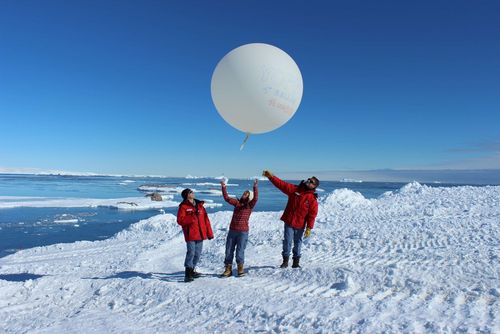
Meteo France - Dumont d'Urville: YOPP-SH SOP first balloon launch, 2018 (photo: Meteo France)
In the framework of the Year of Polar Prediction (YOPP), the YOPP Southern Hemisphere Team will undertake another Special Observing Period (SOP). The SOP, starting this week on 15 April, will run during the austral winter from mid-April to the end of August 2022.
by Nadine Hillenbrand
YOPP-SH started a first special observing period (SOP) in the 2018/19 season during austral summer from mid-November 2018 to mid-February 2019. The intensive launch of additional radiosondes was undertaken by the YOPP Southern Hemisphere Community in the framework of the Year of Polar Prediction. Now, another SOP will be staged, this time during austral winter from mid-April to the end of August 2022, which will be the second Special Observing Period in the Southern Hemisphere. Originally, the SOP was scheduled for mid April to mid July but will be extended.
The YOPP Southern Hemisphere (YOPP-SH) team contributes to enhance environmental prediction for the Southern Ocean and Antarctica and to increase the urgency of Antarctic observations. The general aim of the Special Observing Periods is to intensify regular observations in order to gather more data on weather, ice and climate than the conventional Arctic and Antarctic observing systems do. The main objective of the first Southern Hemisphere SOP was to evaluate the effect of additional and constant observations in Antarctica. During this three month period about 2 200 extra radiosondes were launched. More information regarding the 2018/2019 SOP can be found in an overview publication authored by Bromwich et al. (2020).
Due to limited resources during austral winter, this period of observations will include Targeted Observing Periods (TOPs) which encompass the launch of additional radiosondes. The aim is to receive better understanding of cyclones and atmospheric rivers in particular. Additional radiosondes will be launched from stations on sub-Antarctic islands, at the Antarctic coast, at inland stations and from mid latitude continent stations.
25 February 2022: Goodbye, Katharina!
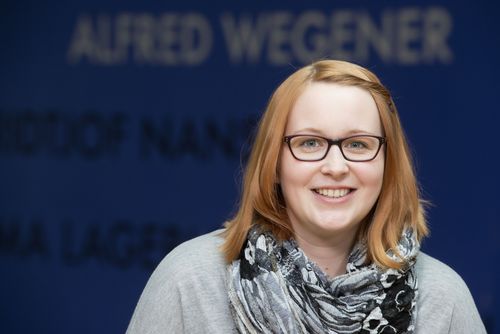
Photo: Martina Buchholz/Alfred Wegener Institute
The International Coordination Office (ICO) for Polar Prediction would like to thank Katharina Kirchhoff for more than 5 years of support and commitment to the ICO. On 1 March 2022, Katharina will start a new job with the Senator for Climate Protection in Bremen.
by Nadine Hillenbrand
Since 2016, when Katharina joined Alfred Wegener Institute, she has supported Paleoclimate Dynamics section and Climate Dynamics section including the Polar Prediction Project. Not only was she the first contact for administrative or organizational issues, but also the person to ask about project details and processes. Working at Alfred Wegener Institute for five and a half years made her become an integral part of the ICO team. Her work has been valuable and essential input for the whole International Coordination Office. Following her interest in climate protection and sustainability, she decided to take a job, which will be more related to her studies again. The International Coordination Office for Polar Prediction is grateful for Katharina’s support and wishes her all the best for future endeavors and new adventures.
23 February 2022: This Time A Guest – The IcePod with Kirstin Werner, Former Head of PPP's Coordination Office
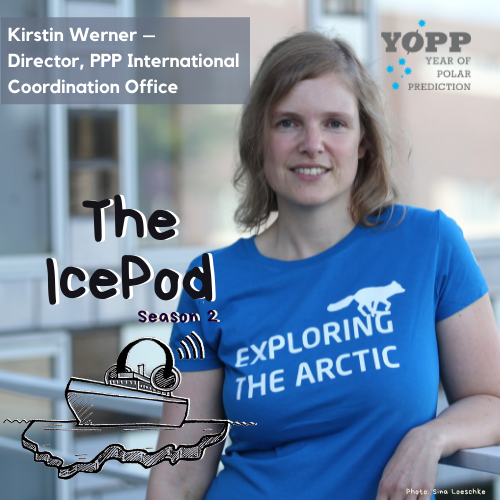
In this final episode of The IcePod, Kirstin Werner gives a glimpes into her work as the former director of the Polar Prediction International Office (photo: Sina Loeschke/Alfred Wegener Institute).
What do Ronald Reagan and Mikhail Gorbachev have to do with the Polar Prediction Project? In the very last episode of The IcePod, things get turned upside down. When Kirstin Werner, former head of the PPP Coordination Office, moved on last fall, someone got the idea to grill her about her work with the Polar Prediction community before she left. Here, Kirstin talks about her experiences with the Year of Polar Prediction, but also gives insights into her background in Arctic research, her previous work as a journalist, and takes us back to that moment in her childhood when she saw Ronald Reagan and Michael Gorbatshev on TV and realized that Iceland might be an interesting spot for her to explore...
This time, Lorraine Youds, Scientific Officer for WMO's World Weather Research Program, asks the questions. For this and all previous episodes of The IcePod go to e.g. Spotify, Apple Podcast, Castbox (no sign-up needed) or on our website theicepodcast.home.blog
The IcePod is produced by the International Coordination Office of the Polar Prediction Project, a project initiated by the World Meteorological Organization to improve weather and sea ice forecasting in the polar regions. For any question or feedback, please contact polarprediction@gmail.com.
28 January 2022: New Date for Year of Polar Prediction Final Summit
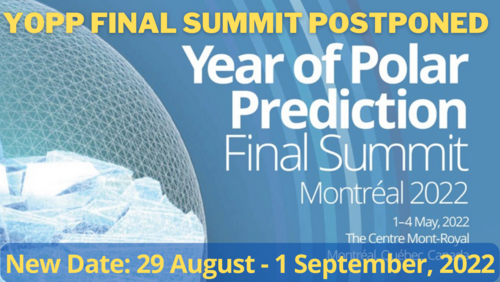
The Year of Polar Prediction (YOPP) Final Summit has been rescheduled. New dates are Monday, August 29 - Thursday, September 1 2022.
The YOPP Final Summit was scheduled to take place in Montréal (QC), Canada, from 1-4 May 2022. Due to the uncertainty of the present world health situation the decision was made to defer the YOPP Final Summit to 29 August - 1 September 2022. The conference will still take place at the Centre Mont-Royal, Montréal, Canada. A pre-summit side program is being a considered for Sunday 28 August with the possibility of networking, workshops and the opportunity to informally exchange ideas and results. In accordance with the new dates the registration deadline has been adjusted. Early bird registration has been extended until May 15.
The Year of Polar Prediction (YOPP) Final Summit aims to bring the polar prediction community of operational centres, academia, environment services and polar prediction users and northern communities together, to showcase the successes of Year of Polar Prediction and contribute to the legacy of the Polar Prediction Project. Further information on the YOPP Final Summit and the deferral can be found here.
19 January 2022: The IcePod with RV Polarstern Captain Thomas Wunderlich – English Version
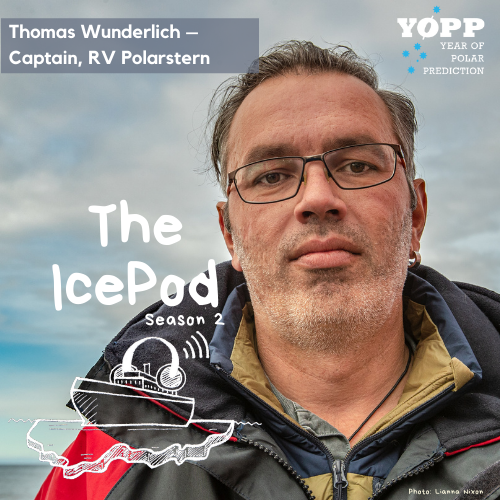
Photo: Lianna Nixon
by Kirstin Werner
Finally, it's there! As promised earlier, the short version of our The IcePod interview with Captain Thomas Wunderlich in English language is now available. Thomas Wunderlich took over the command of the German research icebreaker RV Polarstern for leg 4 and 5 of the MOSAiC expedition in June 2020.
Thomas Wunderlich is one of currently three captains on board Polarstern; together with his colleague Captain Stefan Schwarze he made sure that scientists could carry out their work during the one-year drifting MOSAiC ice camp in the central Arctic. In this special edition of The IcePod, we we hear about how to pursue a career at sea, how to become the captain of the 39 year-old Lady Polarstern, and what is the role of a captain when the ship is not actively moving but just drifting through sea-ice floes.
Wunderlich recalls the precious moment when he met his Captain colleague Stefan Schwarze somewhere at the sea-ice edge in June 2020 to take over the command of Polarstern out on the MOSAiC expedition to study the Arctic for a full year. He tells us about the uncertainty of the expedition under pandemic circumstances and about the good spirit kept on board to make sure the scientists can happily carry out their research. In October 2020, after one year in the ice, Thomas Wunderlich maneuvered RV Polarstern back home to Bremerhaven. The moment has been hilarious and very emotional when the vessel entered port on a sunny early October morning, accompanied by the many welcome-honking escort boats and happy-waving people at the quay.
For the full episode with Captain Thomas Wunderlich in German language and all previous IcePod episodes go to e.g. Spotify, Apple Podcast, Castbox (no sign-up needed) or on our website theicepodcast.home.blog
The IcePod is produced by the International Coordination Office of the Polar Prediction Project, a project initiated by the World Meteorological Organization to improve weather and sea ice forecasting in the polar regions. For any question or feedback, please contact polarprediction@gmail.com.
13 December 2021: We Have to Move with the Weather – The IcePod with Karin Strand
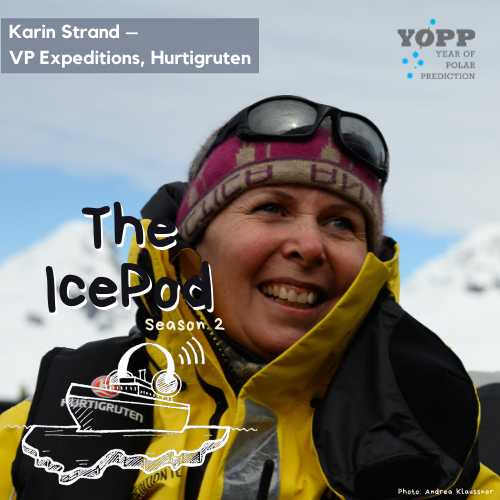
In the new episode of The IcePod, we meet with Karin Strand, Vice President of Expeditions of Hurtigruten, a Norwegian coastal ferry service and cruise line that offers expeditions to Antarctica.
When Karin Strand began studying law in the late 1990s, she had no idea where life would take her. It all started with a student job in the summer; here she cleaned cabins aboard the ships of the traditional Norwegian ferry service that carries people from Bergen to Kirkenes in northern Norway. "Little did I know by the time", how much nature would become her profession. "During breaks at sea, I used to go out on deck and look at the coastline," she says. After graduating from law school, she decided to leave law behind and work for Hurtigruten on their ships instead. At the time, Hurtigruten had begun operations on the Chilean coast and in Antarctica which Karin was able to join as a purser to take care of passengers. She remembers well her first glimpse of Antarctica: while she expected it to basically be a copy of what she knew from the Norwegian coast, she quickly realized that Antarctica was "way bigger than myself". She has returned to Antarctica every year since, with the exception of last season when Hurtigruten had to temporarily suspend service due to COVID-19.
When Hurtigruten established an outdoor program, Karin was offered the opportunity to join the Antarctic cruises as an expedition leader. Being an expedition leader requires three things: a good eye for logisticts, curiosity and passion. "This is much more than a job, it's a lifestyle", Karin explains. Today, as the Vice President of Expeditions, Karin is responsible for a fleet of six ships in Antarctica and the Arctic, including onshore expeditions and the onboard educational program. The latter has grown significantly over the years; Hurtigruten not only conducts Citizen Science projects, but offers scientists the opportunity to collect data during cruises.
In her role, Karin is heavily involved into the planning the expedition itinerary. The team onboard uses several sources to check weather and sea-ice forecast, including windy.com (https://www.windy.com) and the Norwegian weather forecast from yr.no (https://www.yr.no). To make sure, we stay safe, "we usually go with the worst-case scenario", Karin explains. Better fog and wind forecasts would be very useful, and if there were a wish list, Karin would look for a combined product where information on sea ice, wind and ocean currents would be available from a single source, "because those are the elements that would stop us on our way."
Find the new and previous IcePod season 1 episodes e.g. on Spotify, Apple Podcast, Castbox (no sign-up needed) or on our website theicepodcast.home.blog
The episode with music is played
at https://www.medialabnord.de/radio-livestream/ (Bremerhaven) on
Saturday, 1 January 2022, 1–3 pm UTC (2–4 pm CET).
For any question, send and email to polarprediction@gmail.com
And here's the playlist from Karin:
- Liberetto – Lars Danielsson, Tigran, John Parricelli, Magnus Östrom
- Sisters are Doin' It for Themselves – Eurythmics, Annie Lennox, Dave Stewart, Aretha Franklin
- Message in A Bottle – The Police
- Mystify – INXS
The IcePod is produced by the International Coordination Office of the Polar Prediction Project, a project initiated by the World Meteorological Organization to improve weather and sea ice forecasting in the polar regions. For any question or feedback, please contact polarprediction@gmail.com.
26 November 2021: Observations and improved model representation of heat and moisture exchange over sea ice
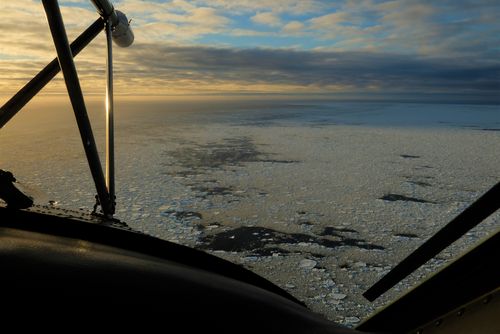
Obtaining atmospheric measurements over marginal Arctic sea ice from a British Antarctic Survey research aircraft during the Iceland Greenland Seas Project (photo: Andrew Elvidge)
by Andrew Elvidge and Simon Schaepe
A new study using field observations obtained from two Arctic field campaigns advances our understanding of surface heat and moisture exchanges over sea ice and introduces a new parameterization scheme to represent these exchanges in weather and climate models.
Elvidge et al. (2021) use observations from research aircraft to characterize turbulence-driven atmosphere-surface exchanges over the Marginal Ice Zone (MIZ). The MIZ is the region of broken and deformed sea ice that is affected by ocean waves and swells, extending from the sea ice edge to the ice pack. Here, atmospheric turbulence and strong gradients in temperature and humidity result in elevated surface fluxes of momentum, heat and moisture, which exert a significant influence on the weather and climate of the mid- to high-latitudes, on ocean circulation, and on the melting and transport of sea ice.
The authors find that the observed exchanges of heat and moisture depend on the aerodynamic roughness of the ice surface, consistent with long-standing theory. Accordingly, they have developed and tested a new, simple, physically-motivated parameterization scheme for heat and moisture exchange over the MIZ that incorporates sensitivity to aerodynamic roughness. In comparison to the crude parameterizations currently employed in two state-of-the-art weather and climate models, this new scheme performs much better for the aerodynamically rough conditions of the “IGP” field campaign and marginally better for the aerodynamically smooth conditions of the “ACCACIA” field campaign. However, to harness its full potential, an improved representation of sea ice topography is necessary and should be a priority for future work on this topic.
This study contributes to our understanding of the air-sea-ice interactions that are critical to how the Arctic is changing, and to our capacity to predict these interactions.
“The volume and spatial coverage of sea ice and marginal ice in the Polar oceans are changing[...]. The potential impacts of these changes on the atmosphere are poorly understood as our current capacity to model the variability in air-sea-ice exchanges in the polar regions is lacking. New shipping routes resulting from these changes will also require improved weather forecasts across the Arctic Ocean. Consequently, there is strong motivation to improve the representation of surface fluxes of heat and moisture over sea ice in weather and climate models. The scheme we have developed provides a straightforward framework for doing so, though improved representation of [sea ice topography] will be necessary to reap its full benefit.” (Elvidge et al., 2021)
Elvidge, A. D., Renfrew, I. A., Brooks, I. M., Srivastava, P., Yelland, M. J., & Prytherch, J. (2021). Surface heat and moisture exchange in the marginal ice zone: Observations and a new parameterization scheme for weather and climate models. Journal of Geophysical Research: Atmospheres, 126(17), e2021JD034827. https://doi.org/10.1029/2021JD034827
15 November 2021: The Drake Lake & the Drake Shake – The IcePod with Nina Gallo
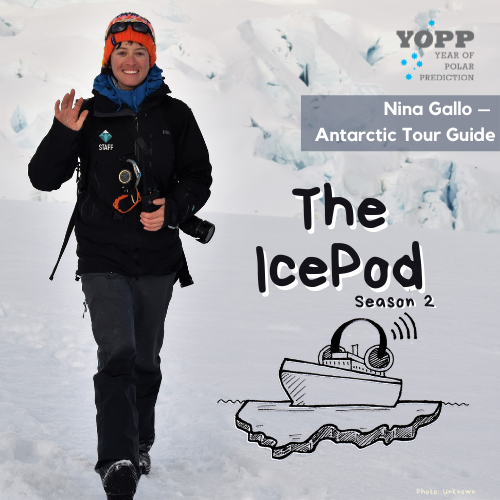
In this episode of The IcePod, we talk to Nina Gallo about her work as a tour guide in Antarctica and how she gets the most out for her Antarctica-loving passengers, even when the weather is unstable.
Nina came to Antarctica about five years ago when she applied for a tour guide position in Antarctica. "Australia has a strong connection to Antarctica, and I heard about it when I was a kid in school," says the Australian writer and photographer. What she likes best about the Antarctic landscape is that it is "always surprising". After each of her trips south, you'd think Nina would be exhausted from a 24-hour job lasting several weeks, but no, she's always excited to just turn around and go back.
Her work as a guide consists, on the one hand, briefing and preparing the passengers who have boarded in Ushuaia, Argentina, and are now finally entering Antarctica. On the other hand, she explores the untouched nature of the southernmost continent in Zodiacs with the passengers. In addition to the specialist knowledge she has acquired in various training courses, her intuition is important for exploring the area and assessing possible risks and dangers at an early stage.
Because the weather is often difficult to predict, her expedition team uses some popular tools like www.windy.com and www.zygrib.org to plan their trips to the landing sites. "We go with whatever Antarctica has to offer" to make the trip as enjoyable as possible for passengers. "It doesn't matter what the weather is like in Antarctica, there is always something magical to see", says Nina.
Find the new and previous IcePod season 1 episodes e.g. on Spotify, Apple Podcast, Castbox (no sign-up needed) or on our website theicepodcast.home.blog
The episode with music is played
at https://www.medialabnord.de/radio-livestream/ (Bremerhaven) on
Saturday, 4 December 2021, 1–3 pm UTC (2–4 pm CET).
For any question, send and email to polarprediction@gmail.com
And here's the playlist from Nina:
- Wise Women – Moonchild
- Under Control – The Internet
- The Storm – Boy & Bear
- Cool Change – Little River Band
- Sunrise - Pillows – Alfa Mist, Emmavie
- Nakamarra – Hiatus Kaiyote
- Sunset (Amber Navran Remix) – Ashley Chanel, Amber Navran
The IcePod is produced by the International Coordination Office of the Polar Prediction Project, a project initiated by the World Meteorological Organization to improve weather and sea ice forecasting in the polar regions. For any question or feedback, please contact polarprediction@gmail.com.
29 October 2021: YOPP Final Summit – Call for abstracts ends 15 November
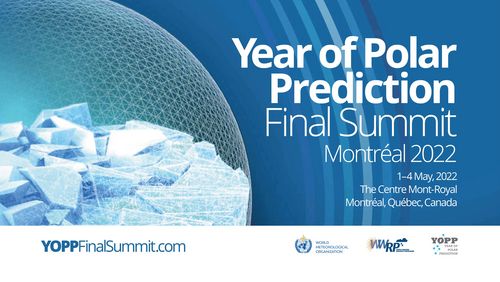
The Year of Polar Prediction (YOPP) Final Summit will take place in Montreal (QC), Canada, on 1-4 May 2022. Registration for the YOPP Final Summit is now open. The call for abstracts is closing 15 November 2021.
The Year of Polar Prediction (YOPP) Final Summit will bring together the polar prediction community, from operational centres and academia, to environment services and polar prediction users and northern communities, to showcase the successes of Year of Polar Prediction and contribute to the legacy of the Polar Prediction Project. Registration is now open to the YOPP Final summit, which will take place 1-4 May 2022 in Montreal, Canada. The deadline for the call for abstracts, however, is approaching, it will end 15 November 2021.
There are also special opportunities for early career scientists: the YOPP Final Summit School and the YOPP Fellowship Programme. The YOPP Final Summit School is the 3rd Polar Prediction School and will take place in Rimouski, Canada from 27 April to 1 May 2022. The Polar Prediction School preceding the YOPP Final Summit will introduce early career researchers to environmental prediction in polar regions combining lectures and modeling assignments with field observations. The Fellowship Programme offers networking opportunities at the YOPP Final Summit and allows early career researches to present their research.
The application deadline for both the YOPP Final Summit School and the YOPP Fellowship Programme is 15 November 2021. Further information on the application process as well as on the call for abstracts can be found here: https://yoppfinalsummit.com
29 October 2021: Goodbye, Kirstin!
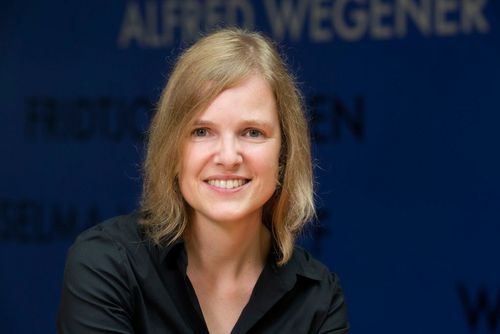
Photo: Martina Buchholz/Alfred Wegener Institute
For more than five years, Kirstin Werner has supported the Polar Prediction Project as director of the International Coordination Office for Polar Prediction (ICO). Starting 1 November 2021, Kirstin will leave for new adventures at the University of Rostock, Germany. The International Coordination Office for Polar Prediction would like to thank Kirstin for her outstanding work and dedication to the Polar Prediction Project.
Since May 2016, Kirstin Werner has been shaping the Polar Prediction Project. With her knowledge in communications and outreach as well as her scientific background in polar research and science marketing, she was ideally suited to lead the internal and external communication for the Polar Prediction Project. Furthermore, her work helped connect the various PPP Task Teams and the polar prediction community; without her commitment, PPP would not be as special as it is today.
The International Coordination Office for Polar Prediction and the polar prediction community are grateful for her support of the PPP/YOPP efforts and wish her the very best for all that is to come.
Please find below Kirstin’s farewell greetings as published in PolarPredictNews #19:
Dear Colleagues,
The past five and a half polar prediction years went by quickly. Eventually, things come to an end, and people move on – and so am I, to take on a new and very exciting role. At the same time, this means leaving a position as director of the International Coordination Office for Polar Prediction that was truly fulfilling down to my last work day.
Throughout my tenure, I have enjoyed working with all of you and learning things about which I previously had basically no clear idea. I have felt very welcome in the community, and it was encouraging to us at the ICO to see first-hand this network of enthusiastic scientists growing over the years and working toward one common goal.
With this change at the ICO, this 19th issue of the PolarPredictNews newsletter will also be the final one. I do hope you have enjoyed reading PolarPredictNews, or at least had fun flipping through it.
Thomas Jung, Jeff Wilson, Katharina Kirchhoff and Nadine Hillenbrand will continue to be there to make sure that YOPP and PPP activities can thrive in view of the consolidation phase and the conclusion of the polar prediction decade at the end of 2022. However, please note that with this transition, activity at the ICO will be slightly reduced from now on.
I would like to thank you all for letting me be part of your world, and I look forward to seeing you on other occasions. There is a German saying: “Man trifft sich immer zwei Mal” – you always meet again.
Sincerely yours,
Kirstin
18 October 2021: Let the Data Speak to You – The IcePod with Lasse Rabenstein and Panagiotis Kountouris
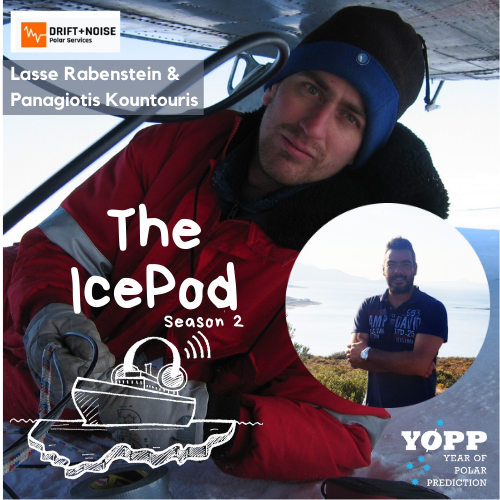
In the first episode of The IcePod, season 2, we talk to Lasse Rabenstein and Panagiotis Kountouris. They run the start-up Drift+Noise Polar Services, which could potentially become the ‘one-stop solution for ice information'.
"If I were the captain of a fishing vessel sailing north of Svalbard..." – In this episode, Lasse and Panos tell us about their start-up company, which primarily aims to support shipping activities in polar regions fjnd a safe path through the ice. To that end, they are developing products such as an app that integrates various information, such as satellite data and ice-drift forecasts, to provide users with an easy-to-use solution, "so that the data speaks to you", Panos says. While a forecast is always subject to uncertainty, users need a truly accurate forecast; for them "the perfect product is a perfect forecast", he adds. However, "on a ship in the Arctic, you can still feel like you're back in the 1990s", says Lasse – low bandwidth is one of the issues Drift+Noise is trying to solve with its service.
As an intermediate provider that passes information from data providers to end users, there is a need to take care of customers – communication and user feedback are key to further improving the company's products. "And… it's really important to educate people by showing them what the innovations are", the company partners add. "Especially the new generations of captains and ice pilots will appreciate getting any information they need to run their operations."
Find the new and previous IcePod season 1 episodes e.g. on Spotify, Apple Podcast, Castbox (no sign-up needed) or on our website theicepodcast.home.blog
The episode with music is played
at https://www.medialabnord.de/radio-livestream/ (Bremerhaven) on
Saturday, 6 November 2021, 1–3 pm UTC (2–4 pm CET).
at https://www.medialabnord.de/radio-livestream/ (Bremen) on
Saturday, 20 November 2021, 3–5 pm UTC (4–6 pm CET).
Sunday, 28 November 2021, 11 am –1 pm UTC (12–2 pm CET).
For any question, send and email to polarprediction@gmail.com
And here's the playlist from Lasse:
- Der Traum ist aus - Ton Steine Scherben
- Child in Time - Deep Purple
- Alles muss man selber machen lassen - Deichkind
- Nordisch by Nature - Fettes Brot
- Verdächtig - Systemabsturz
- Feed Your Head - Kalkbrenner
The IcePod is produced by the International Coordination Office of the Polar Prediction Project, a project initiated by the World Meteorological Organization to improve weather and sea ice forecasting in the polar regions. For any question or feedback, please contact polarprediction@gmail.com.
11 October 2021: Second Season of The IcePod
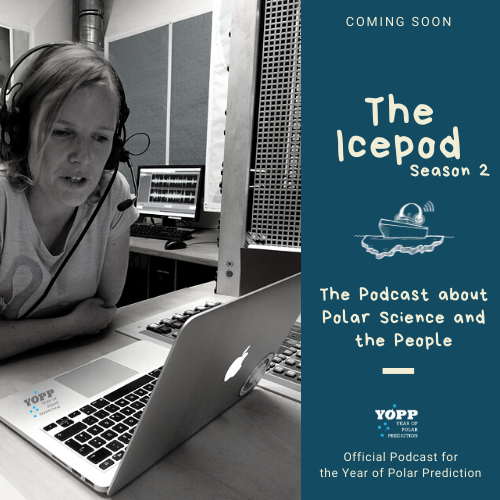
(photo & logo of The IcePod: Sara Pasqualetto)
The second season of The IcePod, the official podcast for the Year of Polar Prediction, will launch in the coming weeks.
In the first season, Sara Pasqualetto and Kirstin Werner of the International Polar Prediction Coordination Office invited participants from the MOSAiC expedition who spent a year drifting through Arctic sea ice on the German research icebreaker RV Polarstern. Guests on the podcast were able to share details from the MOSAiC expedition about their scientific work on the ice, as well as about life on board, insights that would otherwise have been left untold. The episodes were broadcast on the community radio station Radio Weser TV in Bremen and Bremerhaven and are still available on Spotify and other podcast platforms.
In the second season of The IcePod, Kirstin Werner continues to invite podcast guests to bring along their favorite songs and get to know the guests a little better that way. In particular, the second season is about learning more about a range of activities in the Arctic and Antarctic that require good forecasts of environmental conditions. At high latitudes, reliable weather and sea ice forecasts are key to safe operations. However, data on weather and sea ice at the poles are still relatively sparse because these areas are difficult to access. As a result, accurate forecasts are still lacking in these regions. In Season 2 of The IcePod, Kirstin talks to Drift+Noise Polar Services, a start-up that turns forecast data into applied services. You'll also hear from Hurtigruten, a major coastal ferry service and cruise company in Norway, an Antarctic expedition leader, and a helicopter pilot working on Polarstern. Stay tuned and watch out for the next episodes of The IcePod.
A trailer for the new season of The IcePod is available here.
The IcePod is produced by the International Coordination Office of the Polar Prediction Project, a project initiated by the World Meteorological Organization to improve weather and sea ice forecasting in the polar regions. For any question or feedback, please contact polarprediction@gmail.com.
08 October 2021: PolarPredictNews#19
by Kirstin Werner
The 19th issue of PolarPredictNews is now available. Here, Sergi González (AEMET) and Sara Pasqualetto (former YOPP ICO) present their "Stations&Stripes" to illustrate the surface temperature evolution at various Antarctic research stations. Find more on Lindy Hop at the North Pole, on the role of the oceans in making forecasts for the polar regions, about a buoy with 359 days of survival, the Antarctic winter Special Observing Period next year, and much more.
"Why would anyone do the Lindy Hop on sea ice at the North Pole?" In PolarPredictNews #19, Gunilla Svensson reports on the YOPP-endorsed project ACAS being part of a research cruise with the Swedish icebreaker Oden and what this cruise has to do with Lindy Hop, you know, this dance (p 5.).
Beginning of 2021, the Decade of Ocean Science has been launched by the United Nations. Daniel Butkaitis took this opportunity to look at the role of the oceans in making forecasts for the polar regions (p. 8).
In fall 2019, the Russian research vessel Akademik Fedorov supported the MOSAiC expedition by deploying a large number of buoys in the distributed network around the ice camp. Some of the buoys, including 2019P123 with 359 days of survival, had incredible lifetimes. Here's a virtual conversation between Vasily Smolyanitsky, Daniel Watkins and Thomas Rackow, who deployed 2019P123 by helicopter (p. 12).
Another YOPP in the Southern Hemisphere (YOPP-SH) Special Observing Period will take place during the Australian winter of 2022. Irina Gorodetskaya and David Bromwich, in support of the entire YOPP-SH group, provide insight into the planned regular observations as well as the Targeted Observing Periods when additional radiosondes will be launched to study intense extratropical weather systems to better understand the processes and better represent them in models (p. 24).
In an interview, YOPP Education activities leader Clare Eayrs told us about YOPP’s education activities in general, her specific tasks and this task team’s plans in view of the YOPP Final Summit, which will feature the third Polar Prediction School and a YOPP Summit Fellowship (p. 30).
And we spoke to Jørn Kristiansen, PI of the YOPP-endorsed research project Alertness (“Advanced models and weather prediction in the Arctic”) about the objectives and main achievements in the project, national and international collaboration, and about building a reliable relationship with forecast end users (p. 38).
Read about these and more topics in PolarPredictNews#19.
05 October 2021: YOPP Final Summit – Website Launched with Abstracts Now Open for Submission
The Year of Polar Prediction (YOPP) Final Summit will take place in Montreal (QC), Canada, on 1–4 May 2022. The YOPP Final Summit website has been launched now and the link for abstract submission is open.
The YOPP Final Summit is the apex of the decade-long Polar Prediction Project initiated by the World Meteorological Organization’s World Weather Research Programme in 2013. The conference aims to review progress, share key findings and success stories, and discuss and shape the legacy of the Polar Prediction Project. The summit will bring together polar science experts from operational prediction centres, academia and research institutes, government, and corporate representatives as well as northern communities and users of polar prediction services.
Contributors are invited to submit their abstracts on their research and achievements produced in the frame of PPP and YOPP, on the below topics:
- Advancements in polar prediction during YOPP (2017–2019) and their operationalization;
- Building international cooperation amongst the polar prediction community;
- Paving the way for the legacy of the Polar Prediction Project, to enable environmental safety in the Arctic and Antarctic in the future;
- Representation of polar processes in numerical models, with a focus on coupling of the atmosphere, ocean and sea ice;
- Ocean and sea ice modelling and services;
- The MOSAiC expedition and other polar observation campaigns;
- Supersite multi-variate observations and process studies (YOPPsiteMIP);
- Observing System Experiments (OSE) and reanalyses in polar regions;
- Teleconnections linking polar weather to mid-latitudes predictability;
- Science to services: tailoring polar forecasting products and services to meet user needs; and
- Societal and economic implications of accessible, relevant, and useable forecasts.
Early Career Researchers (ECRs)
Participation of Early Career Researchers (ECRs) is encouraged. A third Polar Prediction School will precede the YOPP Final Summit from 27 April to 01 May 2022 in Rimouski, QC, Canada. Also, PPP Early Career Scientist fellowships will provide ECRs with the opportunity to showcase their research and networking with senior mentors at the YOPP Final Summit. For information how to apply to become a YOPP Final Summit Fellow (self-nominations are welcome) and to participate in the Polar Prediction School, please find more information on the YOPP final summit website.
Plenary Speakers
The following science plenary speaker have confirmed their contributions:
- Petteri Taalas (WMO), Secretary General of WMO;
- Thomas Jung (AWI), PPP Steering Group Chair, on the realization and successes of YOPP, and on the PPP legacy;
- Gilbert Brunet (BoM), on the design of the WMO WWRP Polar Prediction Project;
- Peter Bauer (ECMWF), on Earth System Modelling and predictability in polar regions and beyond;
- Gunilla Svensson (Stockholm University), on using observations for evaluating process representation in models;
- Gregory Smith (ECCC), on the NWP modelling contributions to YOPP;
- Matthew Shupe (CIRES/NOAA), on the Multidisciplinary drifting Observatory for the Study of Arctic Climate (MOSAiC);
- Jackie Dawson (University of Ottawa), on societal and economic research and applications of YOPP; and
- Karin Strand (Hurtigruten), Vice President of Expeditions.
Abstract Submission
Submit your abstract by 15 November 2021 at yoppfinalsummit.com. Early Bird registration will be open until 15 February 2022. All information including for the Early Career Researchers‘ opportunities and options to request funding to attend can be found at https://yoppfinalsummit.com/
Follow also @polarprediction on Twitter and Instagram for any updates.
01 October 2021: Radiation in Alaska – How to Keep Sensors Free of Ice
by Simon Schaepe and Chris Cox
In their new paper, Cox et al. present a study on improving radiative flux measurement in polar regions where icing of radiometers, especially during winter, is a major issue. The study therefore focussed on de-icing and heating technologies and on using ventilation to improve measurements. Results show that ventilation can largely avoid ice formation.
Ice, rime and snow accreting on sensors is a huge issue, especially in cold regions. Iced-up instruments can result in less accurate measurements. Existing technologies the international research and development communities use to reduce radiometer icing were tested in a De-Icing Comparison Experiment presented by the authors of this paper.
Cox et al. chose the NOAA Atmospheric Baseline Observatory in Utqiagvik (Alaska) as the site to carry out their experiment. Thirty-four broadband radiometers, including both pyranometers and pyrgeometers, were outfitted with various configurations of ventilation, heating, or both, and installed. Data was collected for a year to quantify the influence of icing on the sensors and associated biases in the measured fluxes. The study also quantified the magnitude and sign of biases under different cloud and lighting conditions.
Counterintuitively, the results showed that unheated ventilation can be successful in mitigating ice if aspiration is distributed properly around the sensor domes. This result was found to be explainable by a combination of waste heat from the ventilator fans and adiabatic compression of air downstream.
Ice mitigation was sufficiently successful to permit construction of a complete record of ice-free downwelling longwave and shortwave radiometric fluxes using the collective measurements (August 2017 to July 2018). These data could be used for model evaluation, e. g. for the first Special Observing Period (SOP1) of the Year of Polar Prediction (YOPP).
The data from ice-free measurements of radiative fluxes can now feed into better prediction of short-term and long-term distortions in measurements. Ice was found to instantaneously produce large biases; according to the authors, however “because of the frequency of icing, mitigation of ice by ventilators, cloud conditions, and the timing of icing relative to available sunlight, the biases in the monthly means were generally less than the aggregate uncertainty attributed to other conventional sources in both the shortwave and longwave”, state the authors in their paper. One exception appeared in early spring, when a combination of clearer skies, sunlight, and icing events produced significant biases in solar measurement devices, which were found to be more vulnerable to developing ice than pyrgeometers due to difference in the construction of the domes.
Cox, C.J., Morris, S.M., Uttal, T., Burgener, R., Hall E., et al. (2021). The De-Icing Comparison Experiment (D-ICE): a study of broadband radiometric measurements under icing conditions in the Arctic. Atmospheric Measurement Techniques, 14(3), 1445–1467. doi.org/10.5194/gmd-14-1445-2021
27 September 2021: PPP Helps Old Book Find a New Home
by Jeff Wilson
During a clean out of her office at the University of Melbourne earlier this year Ms Mary Voice (ex Head of Climate Services at the Australian Bureau of Meteorology) came across an old reference book originally owned by Prof Fritz Loewe who founded Australia’s first Meteorology Department in Melbourne in the late 1930’s. The book has now found its way to the German Alfred Wegener Institute.
The book is in German and is a primary reference book of the time for meteorological instruments. Following an intervention by PPP consultant Jeff Wilson, the book is now part of the AWI display material.
German-born meteorologist and polar explorer Fritz Loewe (1895–1974) studied law and languages in Berlin and Grenoble, before serving in World War I as a wireless operator. He gained his PhD in geography and physics in 1926 and established the Department of Meteorology at the University of Melbourne in 1939. He joined Alfred Wegener's ill-fated expedition to Greenland in 1929-30.
Loewe accompanied Professor Alfred Wegener, pioneer of continental-drift theory, on his last Greenland expeditions. In 1929, with Ernst Sorge, he made the first seismic measurements of the surprising thickness of the ice cap close to its margin. During the over-wintering (1930-31) Loewe's toes were crudely amputated at Eismitte camp when gangrene followed frostbite. He and Wegener observed that the bulk of snowdrift transport occurs at considerable heights above the ice surface. When Wegener died attempting to reach the coast, Loewe became acting leader. With Wegener’s widow Else, he returned to Greenland in 1932 as adviser for the film, S.O.S. Eisberg. He was to assist Else Wegener to publish Greenland Journey (London, 1939), an account of the 1930-31 expedition.
Until today, the University of Melbourne Archives hold a collection of the material Fritz Loewe used during the expedition, e.g. a sleeping bag, research notes or some photographs. PPP-SG Chair Thomas Jung noted how appropriate it was for this book belonging to one of Alfred Wagner’s co-workers to return to AWI: “After this book travelled around the world for many years which so much history attached, I am more than happy to give it an suitable home eventually at our institute, named after Alfred Wegener.”
7 September 2021: The IcePod with RV Polarstern Captain Thomas Wunderlich
by Kirstin Werner
Surprise, surprise! After the final episode with Matt Shupe, we have another one for you. In this German edition of The IcePod, we talk to Captain Thomas Wunderlich who took over the command of the German research icebreaker RV Polarstern for leg 4 and 5 of the MOSAiC expedition in June 2020.
Thomas Wunderlich is one of currently three captains on board Polarstern; together with his colleague Captain Stefan Schwarze he made sure that scientists could carry out their work during the one-year drifting MOSAiC ice camp in the central Arctic. How to become the captain of the 39 year-old Lady Polarstern, and what is the role of a captain when the ship is not actively moving but just drifting through sea-ice floes? Not only we learn about the bunch of items Thomas Wunderlich always takes with him aboard when leaving for the north or south (we only mention 'night socks' here), but also we hear about how to pursue a career at sea, about the different marine officer grades and on the general aspects of seafaring in Germany and around the world.
'There are the dead, there are the living, and there are sailors', Thomas Wunderlich quotes an unknown source; his life is divided into six months at sea and six months at home each year, both being intensive times of living, and yes, Thomas Wunderlich also likes to be on land, using his spare time for work in the garden or to explore the beautiful Spreewald area south of Berlin, which is home for Captain Wunderlich.
Wunderlich tells us about the moment, many years ago, when for the first time he had heard that something called the MOSAiC expedition was discussed. And he revisits with us the precious moment when he met his Captain colleague Stefan Schwarze somewhere at the sea-ice edge in June last year. Yes, he can't deny, they gave each other a hug when he took over the command after leg 3. After all, in times when it is uncertain whether a MOSAiC expedition can continue even under pandemic circumstances, it was also his endorsement to expedition lead Markus Rex to keep on going, thanks to the brilliant logistic efforts that made seemingly impossible things possible.
There is one common goal at a research vessel, which is making the scientists happy by enabling them to do their research; for which both parties need to be treated overly respectfully on board, and this has worked out very well for Thomas Wunderlich's leg 4 and 5 of MOSAiC. "While we, the captain and crew, can take water samples, we cannot analyze them. But at the same time, if there wasn't us, the ship would still sit in Bremerhaven." In October 2020, after one year in the ice, Thomas Wunderlich maneuvered RV Polarstern back home to Bremerhaven. The moment has been hilarious and very emotional when the vessel entered port on a sunny early October morning, accompanied by the many welcome-honking escort boats and happy-waving people at the quay.
Find the new and all previous IcePod episodes e.g. on Spotify, Apple Podcast, Castbox (no sign-up needed) or on our website theicepodcast.home.blog
If you miss the music, find Thomas Wunderlich's playlist on Spotify.
The episode with music is played
at https://www.medialabnord.de/radio-livestream/ (Bremen) on
Saturday, 18 September 2021, 8–10 am UTC (10 am–12 pm CET) and on
Sunday, 26 September 2021, 12–2 pm UTC (2–4 pm CET)
For updates and other materials, check also our website: theicepodcast.home.blog
---
The IcePod is the podcast about polar science and the people. We’ll talk to scientists who went on board Polarstern, the German research icebreaker, for the biggest research expedition in the Arctic. It is produced in collaboration with the Alfred Wegener Institute and Radio Weser.TV where the full episode with music will be played at www.medialabnord.de/radio-livestream/. For dates check back with polarprediction@gmail.com.
Editorial responsibility: Kirstin Werner and Sara Pasqualetto
30 August 2021: International MOSAiC Science Conference/Workshop – POSTPONED
+++Due to increasing numbers of COVID-19 infection rates, the conference needs to be postponed.
Check back for updates on https://mosaic-expedition.org/+++
by Nadine Hillenbrand
One year after the return of the research icebreaker RV Polarstern from drifting in the Arctic ice, the International MOSAiC Science Conference will be held in Potsdam, Germany, from 18 to 22 October 2021.
In September 2019, the German research vessel Polarstern left for the Arctic Ocean to start the MOSAiC expedition (MOSAiC - Multidisciplinary drifting Observatory for the Study of Arctic Climate). One entire year, the research vessel was drifting in the central Arctic to study climate and environmental processes in this region and with this, to better understand global climate change. Two years after the start of this expedition, the International MOSAiC Science Conference/Workshop allows scientists and the whole MOSAiC community to discuss the scientific data and results coming from this expedition. The conference will be held in Potsdam from 18th to 22nd October 2021 and strives to unite all different disciplines that are and have been working on the Arctic climate system. Focusing on the scientific exchange of the coupled Arctic climate system, the international MOSAiC Science Conference/Workshop pursues the goal to enhance sea ice and weather forecast as well as regional and global climate models.
To comply with the scientific work of the MOSAiC scientists, the conference includes 16 thematic highlights outlined in sessions that can be viewed online. The MOSAiC meeting will function as a conference and workshop mixing sessions for oral and poster presentations with various breakout sessions in order to allow detailed discussions. The opening of the conference will be made by Markus Rex, project and MOSAIC expedition lead who will give an overview of the MOSAiC expedition, followed by Uwe Nixdorf, AWI vice director and part of the MOSAiC logistics team. The conference will be filled with different scientific talks, task group discussions or team sessions all week including social event gatherings.
According to the latest information, the conference will be planned as an in-person meeting. For all updates and possible changes due to COVID-19, visit the conference website (https://mosaic-expedition.org/science-conference/) or contact the conference organization team (local@mosaic-expedition.org).
27 August 2021: New YOPP Video Available – A Decade of Polar Prediction
A video on the activities during the final phase of the Polar Prediction Project (PPP) is now available. PPP Steering Group members explain the relevance of environmental forecast research in the Arctic and Antarctic and how the Year of Polar Prediction could help to initiate action. The video also highlights next steps to move forward and enable a legacy for PPP with many follow-up activities to come.
The Polar Prediction Project is a 10-year (2013–2022) endeavor of the World Meteorological Organization’s (WMO) World Weather Research Programme (WWRP) with the aim of promoting cooperative international research enabling development of improved weather and environmental prediction services for the polar regions, on time scales from hours to seasonal.
The Year of Polar Prediction (May 2017 to June 2019) has been the flagship activity of PPP to enable a significant improvement in environmental prediction capabilities for the polar regions and beyond, by coordinating a period of intensive observing, modelling, verification, user-engagement and education activities.
The video produced by the YOPP International Coordination Office provides an overview of various activities to enhance weather and sea-ice forecasts within PPP. It depicts the importance of advancing environmental prediction capabilities to ensure environmental safety in the Arctic and Arctic in the future. Moreover, the video explains how research and education activities were intensified during the Polar Prediction Project’s decade which eventually will result in the YOPP Final Summit (https://yoppfinalsummit.com/) held from 1 to 4 May 2022 in Montreal, Canada, to bring together the polar prediction community and to discuss results their numerous efforts to improve weather and sea-ice predictions in polar regions.
The video is available from the YOPP Youtube channel here.
24 August 2021: New Intern for YOPP ICO
17 August 2021: YOPP Southern Hemisphere Session at ICSHMO Conference in New Zealand
From 8 to 12 February 2022, the 13th International Conference on Southern Hemisphere Meteorology and Oceanography (ICSHMO) will be held. Aim of the conference is to review „all things south the equator” such as “oceans, ice, weather, climate, advances in science and technology”. A YOPP in the Southern Hemisphere (YOPP-SH) session is planned during ICSHMO to summarize the current state of knowledge around meteorological research in preparation of the upcoming YOPP-SH special observing period in austral winter/spring 2022.
ICSHMO was founded in the early 1980s and since then, it has provided a regular platform for researchers to discuss scientific developments. The conference takes place every few years with the last one held in 2018 in Sydney, Australia. The majority of participants is from New Zealand and Australia, however, everyone interested is welcome.
The YOPP in the Southern Hemisphere (YOPP-SH) community seeks to improve environmental prediction for the Southern Ocean and Antarctica on time scales from hours up to one month. YOPP-SH held a special observing period (SOP) in the 2018/19 season, coinciding with the greatest summer operational activity in the Antarctic on record. YOPP-SH is undertaking another SOP from mid-April to mid-July 2022 to sample the period of rapid Antarctic sea-ice growth. Recognizing the limited resources and personnel available during austral winter, Targeted Observing Periods (TOPs) featuring enhanced observations are adopted within this SOP. Four to five TOPs lasting a few days each are planned to target major forecasting challenges such as intense oceanic cyclones and atmospheric rivers. The YOPP-SH session held during the ICSHMO aims to discuss the current state of knowledge around meteorological research and forecasting in the Antarctic as well as challenges relating to using this knowledge to improve operational safety. Contributions to advance YOPP-SH goals are welcome:
• Data denial experiments with regional and global forecasting systems to examine the forecast impact of the 2200 additional radiosonde observations collected during the summer SOP.
• Characterization of Antarctic phenomena that are challenging to predict such as atmospheric rivers and barrier winds.
• Evaluation of coupled and uncoupled model forecasts for planetary boundary layer, clouds, precipitation, and sea ice.
• Advancing atmospheric data assimilation for the Southern Ocean and Antarctica.
• Studies aimed at optimizing the upcoming winter TOPs through Forecast Sensitivity to Observations (FSO), or similar approaches, to identify key regions for enhanced observations.
• Research on the use and value of environmental forecasts to inform operational decision-making.
The conference is scheduled as an in-person meeting in Christchurch, New Zealand. However, remote participation is also possible. The submission deadline has been extended to 19 September 2021. Abstracts can be submitted via the following link:
https://confer.eventsair.com/icshmo-2022/call-for-abstracts
12 August 2021: Newsletter PolarPredictNews #18 Now Available
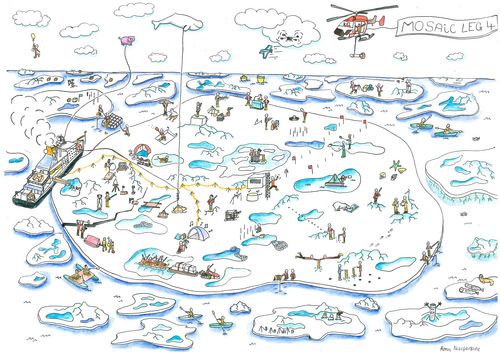
During her first five-month trip during leg 3 on board RV Polarstern, Amy MacFarlane, PhD student at the Snow and Avalanche Research Institute in Switzerland, extended her stay for another three months to join leg 4 of the MOSAiC campaign. Luckily, Amy did not abandon her previously pursued hobby and continued to paint to capture more moments from the MOSAiC adventure (read more on p. 4).
In the 18th issue of PolarPredictNews, Amy MacFarlane presents her second collection of water colour drawings from MOSAiC leg 4, which ended about a year ago (p. 4). PolarPredictNews’ top story is about the various ways Zack Labe visualizes Arctic climate data to ensure environmental changes are easy to grasp (p. 5).
In PolarPredictNews #18, Marvin Kähnert introduces a number of tools that the YOPP-endorsed Alertness project uses to enhance Arctic numerical weather prediction. Our former intern, Nikoleta Petridi, delves into current trends in Alaska’s weather and climate in an interview with Rick Thoman, a weather expert who for many years has been seeking dialogue with Alaskan communities. Lorenzo Zampieri asks whether the increasing complexity of sea-ice models is useful and suggests a number of strategies for dealing with it. The UN Ocean Decade was launched earlier this year. Daniel Butkaitis, from the YOPP ICO, looks how the polar oceans fit into that program. Not long after RV Polarstern returned from the MOSAiC drift last fall, it sailed south in order to resupply Germany’s Neumayer III station and carried out some research on the way. Stefanie Arndt was on board, and she shares her personal impressions with us in the form of a diary. Also, we took the opportunity to meet with and interview APPLICATE PI Thomas Jung and project manager Luisa Cristini to learn about the successes and outcomes of the recently ended, YOPP-endorsed, eight-million-Euro project.
Read about these and more topics in PolarPredictNews#18.
29 July 2021: The IcePod's Final Episode with Matthew Shupe – The Great Expectations
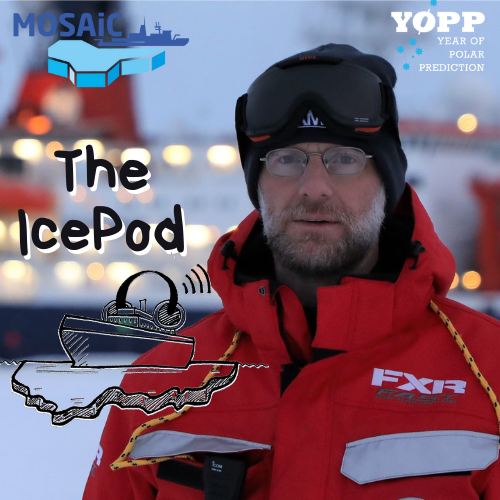
photo: MOSAiC consortium
Here's the final episode of The IcePod's season 1 . It's a pretty special one because we got to meet one of the highest-ranked people of MOSAiC – it's Matt Shupe. Matt has been the co-lead of the expedition and stayed onboard Polarstern for the first, the dark one, and the fourth, the light leg of the one-year expedition.
Matt really is a cloud person; he has been working on his sweet spot of research, the Arctic mixed-phase clouds, since basically forever. As a PhD student, he has already been involved into the Arctic drifting expedition SHEBA in 1997, and could thus bring on his experience camping on the ice into the new project.
After his return from the Arctic, he always wanted to go back to better understand what's going on there in terms of atmosphere/sea-ice interactions. When he met the German physicist Klaus Dethloff who by the time worked at the Alfred Wegener Institute, they realized they'd have similar dreams on an Arctic overwintering campaign. It took them quite some years and efforts to champion on these paired ideas but eventually they got more people convinced and the German research vessel Polarstern on board.
In retrospect, Matt summarizes the expedition like this: "My expectations were not necessarily the plan of the Arctic but the Arctic came up and said 'Hej, this is what I am right now'." From COVID-19 to logistical issues, not to mention the fast drift of the ice floe, the MOSAiC expedition was sometimes not as they had pictured. But great expectations can only be topped by the unexpected reality, which turned out to be amazing, not only due to the various observations during polar night and day, but also to the team spirit, the human relationships and particularly the Italian card game connection that built over time on an Arctic island in the sun.
What are Matt's plans for the future? While looking at the "old stuff" may be in "some ways less sexy", it's a necessary step to pave the way to the next big thing of the future of Arctic research, which Matt is confident on is in great hands.
Find the new and all previous IcePod episodes e.g. on Spotify, Apple Podcast, Castbox (no sign-up needed) or on our website theicepodcast.home.blog
If you miss the music, find Matt's very special playlist for the episode on Spotify.
The episode with music is played
at https://www.medialabnord.de/radio-livestream/ (Bremerhaven) on
Saturday, 7 August 2021, 12–2 pm UTC (2–4 pm CET)
For updates and other materials, check also our website: theicepodcast.home.blog
---
The IcePod is the podcast about polar science and the people. We’ll talk to scientists who went on board Polarstern, the German research icebreaker, for the biggest research expedition in the Arctic. It is produced in collaboration with the Alfred Wegener Institute and Radio Weser.TV where the full episode with music will be played at www.medialabnord.de/radio-livestream/. For dates check back with polarprediction@gmail.com.
Editorial responsibility: Kirstin Werner and Sara Pasqualetto (sp/kw)
26 July 2021: Good Bye, Sara!
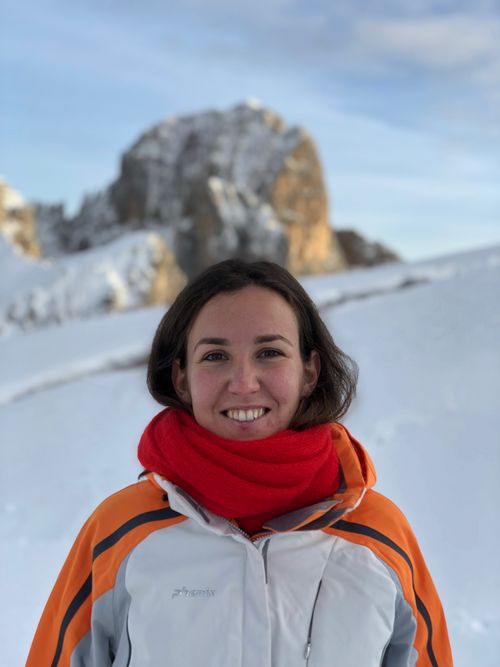
photo: private
The International Coordination Office for Polar Prediction would like to thank Sara Pasqualetto who supported the team for 2,5 years especially in the fields of outreach and communication. After her farewell at the end of June, we would like to express our gratitude for her great work.
Due to her studies in Political Science and International Relations in Italy and Germany and her work in the advocacy and outreach sections of international organizations like UNICEF and the Coalition for the ICC, Sara was ideally suited to aid the team with her skills. Following her interest in climate change and prediction, she was involved in the communication and management activities of the Polar Prediction Project as well as of the H2020 project APPLICATE and the Helmholtz Association-funded ESM project. The International Coordination Office for Polar Prediction is grateful for Sara’s continuous support and wishes her the very best for her future career.
9 July 2021: The Daily Life of a Polar Scientist – Intimate Glimpses into The Quietness of an Expedition
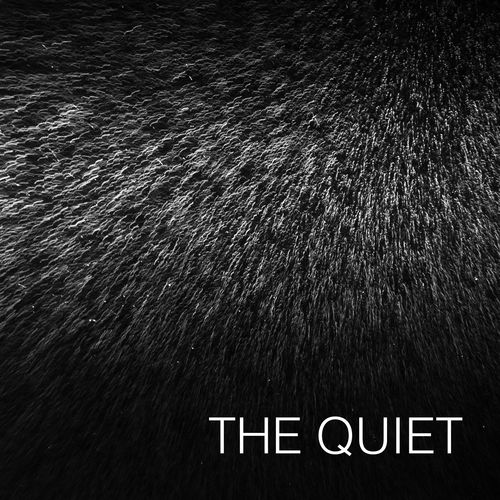
copyright: Thea Schneider
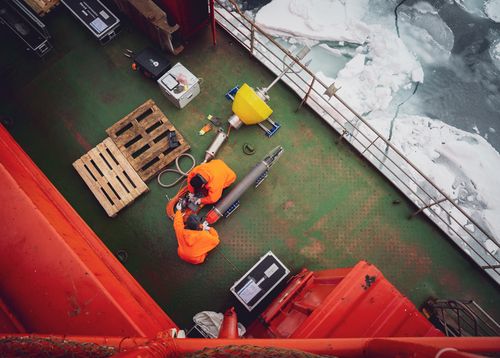
copyright: Thea Schneider
by Thomas Hasiweder
A new crowdfunding campaign under the name of “The Quiet” was initiated by Thea Schneider, a photographer and climate scientist who joined the very first part of the MOSAiC expedition aboard the Russian research vessel (RV) Akademik Fedorov. As a result of her participation in the MOSAiC School 2019 Thea Schneider is about to publish a photographic book which gives personal insights into the expedition life of polar scientists.
From fall 2019 and to fall 2020, the project Multidisciplinary drifting Observatory for the Study of Arctic Climate (MOSAiC) took place. To gain a better understanding of the processes in the Arctic driven by global climate change, the research icebreaker Polarstern was maneuvered into the sea ice of the central Arctic Ocean to drift with the ice for the first time over polar winter and summer and record important observational data.
Thea Schneider was one of the twenty early career scientists who were selected to participate in the MOSAiC School 2019 to board RV Akademik Fedorov in September 2019, which not only supported Polarstern on her way into the ice but also set up a network of autonomous instruments in Polarstern's vicinity. The school lasted six weeks and offered the students the opportunity to gain experience in different hands-on tasks, such as setting up measuring tools, but also to learn about all the different disciplines of MOSAiC, e.g. about sea ice forecasting, during lectures aboard the vessel.
Thea whose participation in the MOSAIC School had been supported by the Polar Prediction Project took the opportunity to indulge in her first profession as a photographer on board as well. The photographic book she is now about to publish will focus on the daily life and work during the expedition. The book aims to show the diversity of many different characters with different abilities, tasks and life stories and “the quiet, more mundane moments in between of an incredible expedition like MOSAiC which opens up the space for people to identify and empathize with the expedition participants on a human level.”
The Kickstarter campaign allowing Thea to actually make the book happen is currently ongoing. Available is the book itself for 24€ and selected postcards, stickers and prints as well as a special pupils and students book offers for 16€. Estimated delivery is in November 2021.
For more information and to support the campaign, visit her project page: https://www.kickstarter.com/projects/theaschneider/thequiet
7 July 2021: Two New Members Arrived at YOPP International Coordination Office
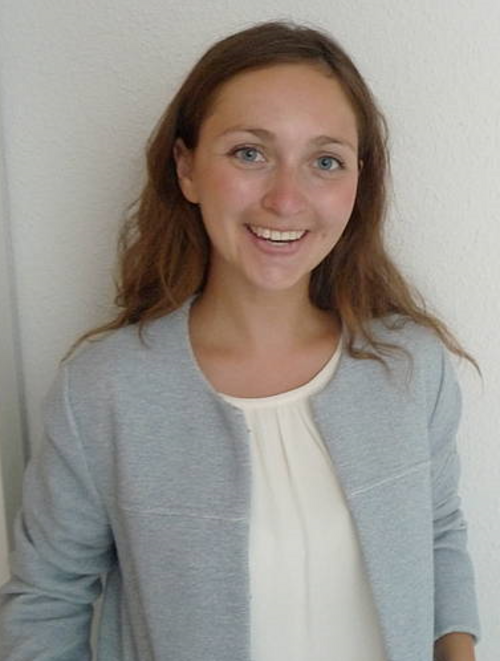
photo: private

photo: private
Two new members, Nadine Hillenbrand and Thomas Hasiweder, joined the International Coordination Office for Polar Prediction (ICO) in early July.
Nadine Hillenbrand joined the Alfred Wegener Institute already in 2017 working for the project "klimafit" to develop an adult education program on climate change with REKLIM. Her background is Geography and American Studies for which she received her bachelor and master degrees at the University of Heidelberg. Besides her work for klimafit, Nadine is now supporting the International Coordination Office for Polar Prediction.
Thomas Hasiweder joins the ICO from Austria where he obtained his bachelor’s degree at the University of Vienna. Currently, he is pursuing his master’s degree in sustainable chemistry at KU Leuven in Belgium. He will be supporting the Polar Prediction Project in July and August 2021.
6 July 2021: New YOPP-Endorsed Project “Arctic PASSION” to Recast Arctic Observing Systems
by Patrick Hansen
A new YOPP-endorsed project called “Arctic PASSION” has started on 1 July 2021. Funded by the European Union’s Horizon 2020 program with 15 million Euros over four years, the project will contribute to the development of a sustained and accessible observing system for the Arctic that can be utilized by a diverse range of users.
Global warming leads to rapid changes in the Arctic. In fact, these changes are happening even faster than anywhere else in the world. The impacts they have range from environmental to social and economic. The effects will not only be felt locally, but, due to the impact of the Arctic to our mid-latitude climate, much more widely. As environmental changes and their consequences to weather and climate become even more pronounced in the future, an increasing demand by users from local communities to scientists and decision-makers for more reliable and versatile observational data streams and services is expected.
The German Alfred Wegener Institute for Polar and Marine Research coordinates the EU project Arctic PASSION (Pan-Arctic observing System of Systems: Implementing Observations for societal Needs) in which 35 European and international partners from 17 countries participate. The Arctic PASSION Coordination Team consists of Michael Karcher (the project coordinator), Luisa Cristini (the project manager), and Tordis Hellmann (the project administrative and financial manager).
The project aims at integrating international environmental observing systems for the Arctic and improving these systems to meet the demands of different user groups as some components of Arctic observation systems are still fragmented and challenges remain in data accessibility. Arctic PASSION also intends to expand and better coordinate the Arctic Earth observation capacity and capabilities by taking additional measurements and improving international integration. To better understand local historic changes in the Arctic, plans also involve measurements that have been taken more than a few decades ago by Indigenous communities and national monitoring programs. As a final goal, together with international partners, Arctic PASSION plans to develop an integrated pan-Arctic Observing System of Systems (pan-AOSS).
The project officially started with an informal online welcome event on the 1 July 2021 with over 70 participants who had the chance to meet the coordination team and get a glimpse on the upcoming activities. The European Commission’s project officer also introduced the project in the wider portfolio of the EU-funded polar research.
More information on Arctic PASSION can be found at their website. An overview of this and other YOPP-endorsed projects is available at the data base of YOPP-Endorsed projects.
5 July 2021: What’s been Published? – First Results One Year after the MOSAiC Expedition
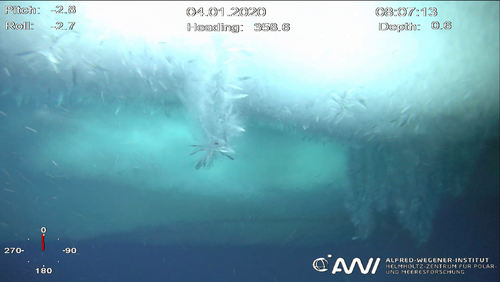
Brinicles covered in platelets (photo: Katlein et al, 2020; doi.org/10.1594/PANGAEA.919398)
by Patrick Hansen and Thomas Hasiweder
About one year after the return of the German research icebreaker RV Polarstern, a number of studies resulting from MOSAiC, the ever biggest Arctic international expedition have already been published. Here, we briefly summarize their results.
On 12 October 2020, RV Polarstern returned to Bremerhaven from the MOSAiC (Multidisciplinary drifting Observatory for the Study of Arctic Climate) expedition, 389 days after the ship left for the Arctic in fall 2019. During its mission, Polarstern was anchored to an ice floe and drifted with the ice through the Arctic Ocean. MOSAiC aimed at gathering data from the sea ice, the atmosphere, and the ocean and their interactions with each other. The collected data should help scientists to fill the knowledge gaps on processes taking place particularly during Arctic winter from which only limited observations were yet available due to the very harsh conditions making the central Arctic inaccessible during winter.
In June this year, von der Gathen et al. published in “Nature Communications” their article “Climate change favours large seasonal loss of Arctic ozone”. By looking at the formation of polar stratospheric clouds (PSCs) in cold winters and the output from General Circulation Models (GCMs), the authors monitor the Arctic ozone loss. They conclude that the potential formation of PSCs has a positive trend from 1950 to 2100. At the end of the century, the highest values are reached in their simulations where the radiative forcing of climate is increased by greenhouse gases. The Authors suspect that favorable conditions for large, seasonal loss of Arctic ozone could continue or potentially worsen until the end of the century if the emissions of greenhouse gases continue to rise. (ph)
Another study dealing with ozone loss entitled “Near-Complete Local Reduction of Arctic Stratospheric Ozone by Severe Chemical Loss in Spring 2020“ was already released in September 2020 by Wohltmann et al. in GRL, the “Geophysical Research Letters”. The authors state that the ozone loss in the Arctic, which normally is more limited than the ozone loss in the Antarctic, had reached values of 93%, during measurements from 17 March to 17 April 2020, compared to 95-99% in the Antarctic. Additionally, the portion of ozone in the atmosphere, which never before dropped below 0.5 ppm, had reached values of 0.2 ppm with individual profiles reaching 0.13 ppm in Eureka, Canada on 24 March 2020. The reason for this reduced mixing ratio was an unusually strong, stable, and cold polar vortex which lasted until early to mid-May. (ph)
A study by Katlein et al. also in GRL from August 2020 on “Platelet Ice Under Arctic Pack Ice in Winter” is about decimeter-sized thin ice plates, so-called platelet ice, which grows on the underside of sea ice. Platelet ice is mostly found in the Antarctic where it forms from water that is below the local freezing point. However, during the MOSAiC expedition, the authors could observe the formation of platelet ice in freely drifting pack ice during the Arctic winter; they conclude that platelet ice formation is a widely spread process in the Arctic during winter. (ph)
Krumpen et al. examined the ice floe on which “Polarstern” was initially anchored in fall 2019 and where most of the MOSAiC experiments were carried out during the first legs. In their study entitled “The MOSAiC ice floe: sediment-laden survivor from the Siberian shelf” which was published in “The Cryosphere” in February 2020, the authors were able to determine that the MOSAIC ice floe, that was also called the fortress due to its initial stability, had been formed north of the New Siberian Islands in December 2018. Measurements showed that the sea ice in the vicinity of the Central Observatory was 36% thinner and younger than the surrounding ice. In September 2019, the ice was already classified as exceptionally thin compared to data from the last 26 years, which leads to a higher possibility of a seasonally ice-free Arctic Ocean with big impacts on the Central Arctic ecosystem. (ph)
In June 2021, also Belter et al. published their study on sea ice “Interannual variability in Transpolar Drift summer sea ice thickness and potential impact of Atlantification” in “The Cryosphere”. The authors compare a summer time series, taken from July to August, of extensive ice thickness surveys from the end of the Transpolar Drift between 2001 and 2020 with preliminary results from the MOSAiC expedition. The results show that modal summer ice thickness of the MOSAiC floe and its surroundings are consistent with measurements from the late Transpolar Drift. The authors conclude that the winter sea-ice growth could be limited in time in the future while effects of processes, such as the Atlantification of the Arctic Ocean, would become extended over the summer season due to the shortened duration of the Transpolar Drift in the upcoming years. (ph)
A study published December 2020 by Stroeve et al. also in “The Cryosphere” with the title “Surface-based Ku- and Ka-band polarimetric radar for sea ice studies” was carried out to better understand how snow properties influence sea-ice thickness retrievals. The authors examined the potential for combining dual frequencies to simultaneously map snow depth and sea ice thickness with the Ku- and Ka-band radar. (ph)
In their article “Snow and Ice Thickness Retrievals Using GNSS-R: Preliminary Results of the MOSAiC Experiment”, Munoz-Martin et al. present techniques needed for measuring snow and sea ice thickness and the theory behind the Global Navigation Satellite Systems reflectometry (GNSS-R). The authors showed that this system is fully usable for measurements in the Arctic. The measurements published in the journal “Remote Sensing” in December 2020 showed that the snow layer over sea ice is dominant, while the ice thickness seems to have a smaller impact on the GNSS reflections. There is some sensitivity to ice thickness variations, especially at the lower frequency band, shown by the interference pattern which was produced by the four-layer model. (ph)
A recently published article on “Meteorological conditions during the MOSAiC expedition: Normal or anomalous?” by Rinke et al. in Elementa: Science of the Anthropocene depicts the meteorological conditions during the MOSAiC expedition. Furthermore, it compares the near-surface meteorological conditions with the interannual variability and extremes within the past four decades, based on hourly ERA5 reanalysis data. The conditions experienced at the research icebreaker RV Polarstern were relatively normal. However, from time to time from late fall 2019 until early spring 2020 anomalous and record-breaking conditions were recorded such as cases of especially warm and moist air intrusions as well as strong storm events during winter and spring. The summer was all-time warmest and wettest in July and August 2020. Moreover, the near-melting point conditions lasted more than a month longer than usual. These results fit into the general trend of increasing temperature and moisture in the central Arctic. Contrary, from November 2019 to March 2020 unusually cold conditions occurred, these are associated with a positive phase of the Arctic Oscillation pattern. (th)
At least five other publications, amongst them are Krumpen et al. (preprint) and Dethloff et al. (preprint) are currently under review and will be released in the near future.
Belter, H. J., Krumpen, T., von Albedyll, L., Alekseeva, T. A., Birnbaum, G., Frolov, S. V., Hendricks, S., Herber, A., Polyakov, I., Raphael, I., Ricker, R., Serovetnikov, S. S., Webster, M., and Haas, C. (2021). Interannual variability in Transpolar Drift summer sea ice thickness and potential impact of Atlantification. The Cryosphere, 15, 2575–2591, doi.org/10.5194/tc-15-2575-2021.
von der Gathen, P., Kivi, R., Wohltmann, I. et al. (2021). Climate change favours large seasonal loss of Arctic ozone. Nature Communications 12, 3886. doi.org/10.1038/s41467-021-24089-6
Katlein, C., Mohrholz, V., Sheikin, I., Itkin, P., Divine, D. V., & Stroeve, J., et al. (2020). Platelet Ice Under Arctic Pack Ice in Winter. Geophysical Research Letters, 47, e2020GL088898. doi.org/10.1029/2020GL088898
Krumpen, T., Birrien, F., Kauker, F., Rackow, T., von Albedyll, L., Angelopoulos, M., Belter, H. J., Bessonov, V., Damm, E., Dethloff, K., Haapala, J., Haas, C., Harris, C., Hendricks, S., Hoelemann, J., Hoppmann, M., Kaleschke, L., Karcher, M., Kolabutin, N., Lei, R., Lenz, J., Morgenstern, A., Nicolaus, M., Nixdorf, U., Petrovsky, T., Rabe, B., Rabenstein, L., Rex, M., Ricker, R., Rohde, J., Shimanchuk, E., Singha, S., Smolyanitsky, V., Sokolov, V., Stanton, T., Timofeeva, A., Tsamados, M., and Watkins, D. (2020). The MOSAiC ice floe: sediment-laden survivor from the Siberian shelf. The Cryosphere, 14, 2173–2187. doi.org/10.5194/tc-14-2173-2020.
Munoz-Martin, J.F., Perez, A., Camps, A., Ribó, S., Cardellach, E., Stroeve, J., Nandan, V., Itkin, P., Tonboe, R., Hendricks, S., Huntemann, M., Spreen, G., Pastena, M. (2020). Snow and Ice Thickness Retrievals Using GNSS-R: Preliminary Results of the MOSAiC Experiment. Remote Sensing, 12, 4038. doi.org/10.3390/rs12244038.
Rinke, A., Cassano, J., Cassano, E.N., Jaiser, R., Handorf, D. (2021). Meteorological conditions during the MOSAiC expedition: Normal or anomalous? Elementa: Science of the Anthropocene, 9(1), 00023. doi.org/10.1525/elementa.2021.00023.
Stroeve, J., Nandan, V., Willatt, R., Tonboe, R., Hendricks, S., Ricker, R., Mead, J., Mallett, R., Huntemann, M., Itkin, P., Schneebeli, M., Krampe, D., Spreen, G., Wilkinson, J., Matero, I., Hoppmann, M., and Tsamados, M. (2020). Surface-based Ku- and Ka-band polarimetric radar for sea ice studies. The Cryosphere, 14, 4405–4426. doi.org/10.5194/tc-14-4405-2020.
Wohltmann, I., von der Gathen, P., Lehmann, R., Maturilli, M., Deckelmann, H., Manney, G. L., et al. (2020). Near-Complete Local Reduction of Arctic Stratospheric Ozone by Severe Chemical Loss in Spring 2020. Geophysical Research Letters, 47, e2020GL089547. doi.org/10.1029/2020GL089547.
2 July 2021: PPP Steering Group meeting #12 – Meeting Report Available
by Jakob Hafner
The twelfth meeting of the Polar Prediction Project Steering Group (PPP-SG) was held online from 8 to 12 March 2021. The meeting report is now available.
The PPP-SG #12 meeting report summarizes the discussions held during the meeting with regards to the progress of the YOPP Consolidation Phase; activities and plans for the 2022 Polar Prediction Spring School; outreach and communication activities; options for the PPP evaluation and the legacy of the PPP; planning for the Targeted Observing Periods during Antarctic winter from mid-April to mid-June 2022; reviewing the outcomes from the Targeted Observing Period in the Northern Hemisphere (NH-TOP1); reviewing plans for activities by the PPP Societal and Economic research Applications (PPP-SERA) group; examining the benefits and outcomes from PPP’s collaboration with MOSAiC (Multidisciplinary drifting Observatory for the Study of the Arctic Climate); reviewing progress with the sea-ice prediction activities; reviewing progress with the YOPP Data Portal and the YOPP Supersite Model Intercomparison Project (YOPPsiteMIP); and, planning for the Final YOPP Summit as well as general coordination and administrative matters.
The meeting report can now be downloaded from here.
8 June 2021: Reanalysis Study Calls for More Small-Scale Observations over East Antarctic Plateau
by Patrick Hansen
In a new study, González et al. analyzed the mesoscale surface air temperature gradients around Dome F station on the Antarctic Plateau combining ERA5 reanalysis outputs and in-situ weather observations.
The East Antarctic Plateau is the world's coldest place and the highest region of the Antarctic ice-sheet with about 3,000 meters. The area of study is located in the African Sector around the Japanese Antarctic station Dome Fuji or Dome F. Even though the plateau has a smooth surface, the temperature does not follow a simple lapse rate. Because of the harsh conditions and the inaccessibility of the plateau, only a few weather stations are operating here. The lack of stations prevents the detection of potentially interesting small-scale temporary structures and horizontal gradients in the surface air temperature (SAT).
A study by González et al. was carried out to validate different reanalyses on a scale between hours and days and to evaluate the capacity of the state-of-the-art reanalyses to reproduce temporary and small-scale meteorological structures. They characterize the mesoscale SAT gradients by using local weather observations and ERA5 reanalysis. ERA5 is the European Centre for Medium-Range Weather Forecasts‘ (ECMWF) 5th generation global climate reanalysis. For the measurements, mobile automatic weather stations (M-AWS) were used to be able to record more meteorological observations in interesting areas that are not covered by automatic weather stations (AWS).
The measurements showed that the night-time SAT gradients have a strong variability from one night to the other. In addition, ERA5 does not reasonably represent the thermal gradients and their daily changes. Instead, it tends to underestimate these and especially struggles to reproduce the cold pool observed by M-AWS over the lowering of the plateau. ERA5 seems to work better when the observed SAT gradients are weak. The findings of this study complement climatological evaluations of regional SAT and can help to interpret the daily performance of the SAT values made by reanalysis.
The study proposes not only to increase the numbers of in-situ observations on the plateau, but also to balance the distribution of AWS over the whole area, to be able to receive more detailed information on small-scale close to the ground dynamics.
Further reading:
See also the article by Sergi González and Hilo Moreno about the Windsled Expedition on Polar Prediction Matters.
Reference:
González, S., Vasallo, F., Sanz, P., Quesada, A., Justel, A. (2021). Characterization of the summer surface mesoscale dynamics at Dome F, Antarctica. Atmospheric Research 259 Article 105699. https://doi.org/10.1016/j.atmosres.2021.105699.
7 June 2021: New Intern Supports International Coordination Office
On 1 June 2021, Jakob Hafner started his internship with the YOPP International Coordination Office (ICO).
Jakob studies physical geography in his last semester at the Friedrich-Alexander-University Erlangen-Nürnberg. He will be supporting the YOPP International Coordination Office as well as the Advanced Earth System Modelling project (ESM).
28 May 2021: Deadline Extended – Virtual Meetings on YOPP in the Southern Hemisphere & Antarctic Meteorology and Climate
The deadline has been extended to the 7 June 2021 to submit abstracts to the 16th Workshop on Antarctic Meteorology and Climate (WAMC) and the YOPP in the Southern Hemisphere (YOPP-SH) meetings. WAMC will be organized virtually from 21 to 23 June 2021. Anyone interested in Antarctic research, operations and logistics with a focus in Antarctic meteorology and forecasting and related disciplines is welcome to join the sessions to share and discuss their results. Along with WAMC goes the sixth meeting of the Year of Polar Prediction in the Southern Hemisphere (YOPP-SH) community. Focus will be to discuss plans and contributions to the Antarctic Targeted Observing Periods (TOPs) scheduled for Antarctic winter 2022.
The virtual 16th WAMC and the 6th YOPP-SH meeting are organized by the Byrd Polar and Climate Research Center at The Ohio State University, Columbus, Ohio, USA. WAMC will take place from the 21 – 23 June 2021. It brings together those interested in Antarctic research and operations/logistics to share their latest results and discuss future concepts to better understand atmospheric, oceanic and sea-ice processes relevant to enable numerical weather, climate and sea-ice predictions. Contributions to the workshop in the field of Antarctic meteorology and forecasting and related disciplines are welcome to be submitted (see information below).
As in previous years, the YOPP-SH meeting will be aligned with WAMC, this year taking place on 24 and 25 June, in the virtual world. Recently, the YOPP-SH community has met online on a regular basis to discuss interest and potential contributions to the Antarctic Special Observing Period that is scheduled during mid-April and mid-June 2022. During the sixth YOPP-SH meeting, national commitments will be coordinated amongst the different action teams that look at various Antarctic regions to develop the Targeted Observing Periods (TOPs) that explore the predictability of impactful atmospheric phenomena such major oceanic cyclones and Atmospheric Rivers. In addition, results from the summer Special Observing Period (SOP) in 2018-2019 will be presented to guide the planning and execution of the Antarctic winter TOPs.
Registration is open until 7 June 2021 for the 16th WAMC and the 6th YOPP-SH Meeting:
Day sessions (11:00 – 1:30pm EDT, 15:00-17:30 UTC)
Evening sessions (5:00 – 7:30 pm EDT, 21:00-23:30 UTC)
Year of Polar Prediction in the Southern Hemisphere (YOPP-SH):
June 24 – 25 2021:
https://byrd.osu.edu/events/yopp-sh/register
Workshop on Antarctic Meteorology and Climate (WAMC):
June 21 – 23 2021:
https://byrd.osu.edu/events/wamc/register (
Extended Abstracts
Extended abstracts for both meetings are as well accepted. Submission deadline is Monday June 14. Send a copy (30MB or smaller) to David Bromwich (bromwich.1@osu.edu) and to Jerry Zou (zou.219@osu.edu).
We are using the AMS conference format. An electronic document containing all abstracts will be prepared and distributed to registrants.
(kw/ms)
17 May 2021: PPP-SERA Shifted Their Annual Meeting 2021 Online
by Daniela Liggett
In a series of Zoom sessions between 12th and 16th April 2021, PPP-SERA met to discuss their work over the last 1.5 years and plan for the year ahead, leading up to the YOPP Final Summit in May 2022.
While it was a juggling act to bring together a team of people from 8 different timezones, the PPP-SERA team was able to progress their understanding and agreement on a range of topics, including PPP-SERA contributions to the YOPP Final Summit, to the YOPP Legacy and Evaluation efforts, and the third Polar Prediction School.
The task team also agreed on pursuing two joint publications – one a synthesis paper with the goal of summarising and evaluating the key outcomes PPP-SERA achieved, with a particular focus of the team’s interactive Open Sessions that engaged a range of PPP stakeholders in tourism, research, fishing or government operations in the polar regions; and the other one a high-level commentary paper exploring the impact of improved polar prediction and WWIC services on operational risk. Considerable time was spent at the meeting to discuss the foci of these publications, and PPP-SERA team members are presently working on developing these publications further.
Similarly, the team had in-depth discussions about how best to contribute to the YOPP Final Summit, which the team views as an ideal conduit to showcase the diversity and impact of PPP and YOPP efforts over the last 8 years. PPP-SERA strongly endorse an integrated approach to some of the sessions that bring together user and producer perspectives in the form of paired presentation, which serve as capacity-building exercises in their own right, that are woven throughout the entire Final Summit.
In democratic fashion, the PPP-SERA co-chairs Machiel Lamers and Daniela Liggett took turns chairing the four days of engaged and vibrant discussions, which all PPP-SERA members contributed to.
12 May 2021: Addicted to Antarctic Weather – Contribution by Germany’s National Weather Service to Polar Prediction Matters
In the contribution from the German Weather Service DWD to Polar Prediction Matters – the dialogue platform between providers and users of polar forecasting services – Gertrud Nöth, deputy head of the Press and Public Relations at the Deutscher Wetterdienst (DWD), writes about weather forecaster Christian Paulmann’s meteorological work, about DWD’s role in Antarctica and, about how the COVID-19 pandemic has complicated weather forecasting in the southern high latitudes.
In terms of weather predictions, Antarctica is subdivided into four regions where Germany provides forecasting services for Dronning Maud Land. Here, various countries maintain research stations, some of them even year-round. The stations can only be accessed and supplied by air or sea from late October to early March. But in Antarctica, weather is always the limiting factor. The German Weather Service provides meteorological information to ensure safe operations to and from all stations in Dronning Maud Land area.
“These assignments during the Antarctic summer on site give you a feeling of adventure. However, they demand a great sense of responsibility and a high level of risk awareness, independence and flexibility as well as social and professional competence“, says weather forecaster Christian Paulmann who had already spent six summer seasons at the German Antarctic station Neumayer III.
Compared to the 2,000 meteorological stations in Germany, weather observations are rare in Dronning Maud Land. In addition to observations from manned stations, meteorologists need to use weather reports, data from the daily radiosonde ascents, webcam images, and high-resolution images from polar-orbiting weather satellites.
For the 2020/21 austral season Christian Paulmann would have been down south for the seventh time. However, the pandemic has changed everything this time. Research activities have been limited to the minimum of required maintenance and measurements at the stations. Fand flights to Antarctica were drastically reduced, with implications to the forecast quality produced by numerical weather prediction models.
For the DWD this meant, that all meteorological consultations were provided remotely from DWD’s office in Hamburg by the few experts qualified in this field. Christian Paulmann is one of them: “But even from afar, I still feel ‘addicted’ to the Antarctic weather“.
Read the full article here.
10 May 2021: New Intern at YOPP Coordination Office
On 10 May 2021, a new intern Patrick Hansen has joined the International Coordination Office (ICO) for Polar Prediction.
Patrick studies Environmental Sciences at the Technical University in Brunswick, Germany. He will be supporting the YOPP International Coordination Office as well as the project offices of APPLICATE and ESM until 2 July 2021. (kw)
03 May 2021: Enhancing capabilities of NWP in the Arctic – Tools of the Alertness Project
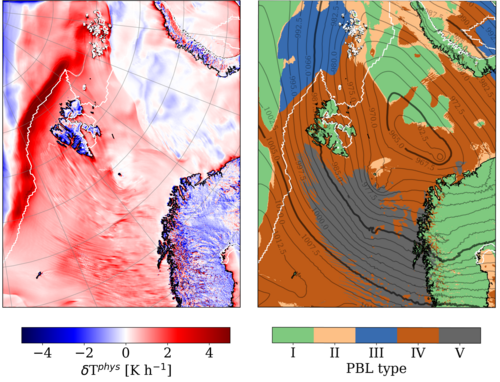
Physical tendency of temperature (left) of the lowest model level. Diagnosed boundary layer types in AROME-Arctic (right): I stable stratification, II dry convective, III stratocumulus topped, IV shallow cumulus topped, V deep convection. Northern Scandinavia is located in the bottom right corner, Svalbard is located near the middle of the model domain (source: Marvin Kähnert, University of Bergen/Bjerknes Center.
by Marvin Kähnert, University of Bergen, Bjerknes Centre for Climate Research
The YOPP-endorsed Norwegian Alertness project aims to improve AROME-Arctic – the recent entry-into-service weather forecast model at MET Norway. As an operational convection-permitting model system dedicated to the European Arctic it is one of the core models of the Year of Polar Prediction (YOPP). PhD student Marvin Kähnert employs a number of tools to enhance NWP capabilities in the Arctic as a collaborated effort within Alertness.
Many endeavours in the Arctic, from tourism to transportation to exploitation of natural resources require access to accurate weather forecasts. Yet, numerical weather prediction (NWP) models generally display comparatively low predictive skill at these high latitudes. Particularly, the sparse conventional observation network over the ocean and sea-ice as well as the pronounced impact of unresolved processes, such as surface fluxes, radiation or cloud microphysics on Arctic weather events pose a large challenge for numerical modelling. The YOPP-endorsed Norwegian Alertness project, led by Jørn Kristiansen (The Norwegian Meteorological Institute) and Marius O. Jonassen (UNIS), aims to tackle these key specifically Arctic challenges, while exploiting the opportunities of the Year of Polar Prediction in terms of field campaigns, observations and modelling efforts. The methodological basis of the work within Alertness is formed by the operational forecast systems AROME-Arctic. One dedicated aspect of the Alertness project, supervised by Harald Sodemann (University of Bergen), is to enhance the capabilities and diagnostics of AROME-Arctic. Therefore, a team consisting of members from the University of Bergen, the Nansen Environmental and Remote Sensing Center (NERSC), and The Norwegian Meteorological Institute employs a variety of tools that allow for a deeper insight into the “inner workings” of the NWP models.
Find these tools and their utility introduced by Marvin Kähnert here.
01 May 2021: Save the Date – YOPP Final Summit 1–4 May 2022
Exactly one year from now, the Year of Polar Prediction (YOPP) Final Summit will take place in Montreal (QC), Canada, 1-4 May 2022. The conference will bring together the polar prediction community, from operational centres and academia, to environment services and polar prediction users and northern communities, to showcase the successes of YOPP and contribute to the legacy of the Polar Prediction Project.
Topics to be discussed during the meeting will be on the representation of polar processes in numerical models, especially coupling of the atmosphere, ocean & sea ice; ocean and sea-ice modelling and services; the MOSAiC expedition and polar observation campaigns; supersite multi-variate observations and process studies (YOPPsiteMIP); Observing System Experiments and reanalyses in polar regions; teleconnections linking polar weather to mid-latitudes predictability; science to services: tailoring polar forecasting products and services to meet user needs; societal and economic implications of accessible, relevant, and useable forecasts. Participation of early career scientists is warmly encouraged, to shape the future of polar science.
Amongst others, science plenary speaker will include:
• Petteri Taalas (WMO), Secretary General of WMO
• Thomas Jung (AWI), Chair of PPP steering group
• Gilbert Brunet (BoM), Previous WWRP-SSC chair and Chief Scientist Australia
• Peter Bauer (ECMWF, Deputy Director Research Department
• Gunilla Svensson (Stockholm University), PPP steering group and co-chair of YOPPSiteMIP
• Gregory Smith (ECCC), Former PPP steering group member
• Matthew Shupe (CIRES-NOAA), Co-Coordinator of MOSAiC
• Jackie Dawson (University of Ottawa), Canada Research Chair
• Karin Strand (Hurtigruten) Vice President Expedition, Norway
Further information will be available in June when registration and abstract submission opens.
For updates, please check here.
28 April 2021: All Across the Globe – PPP Steering Group Annual Meeting #12
by Jeff Wilson
The twelfth annual meeting of the Polar Prediction Project Steering Group (PPP-SG) was held online due to travel restrictions caused by the global COVID-19 pandemic. The session took place from 8 to 12 March 2021 at different times of the UTC day to allow for different time zones of the PPP-SG members’ locations. Discussion around each agenda item was kept to a maximum of 90 minutes.
The PPP-SG #12 session specifically focused upon reviewing progress in the Year of Polar Prediction (YOPP) Consolidation Phase: YOPP education activities and plans for the 2022 Polar Prediction Spring School; outreach and communication activities; considering options for the PPP evaluation and suggestions how parts of the content produced during PPP can be kept public available beyond the end of the project; planning for the Targeted Observing Periods during Antarctic winter from mid-April to mid-June 2022; reviewing the outcomes from the Targeted Observing Period in the Northern Hemisphere (NH-TOP1); reviewing plans for activities by the PPP Societal and Economic research Applications (PPP-SERA) group; examining the benefits and outcomes from PPP’s collaboration with MOSAiC (Multidisciplinary drifting Observatory for the Study of the Arctic Climate); reviewing progress with the sea-ice prediction activities; reviewing progress with the YOPP Data Portal and the YOPP Supersite Model Intercomparison Project (YOPPSiteMIP); and, planning for the Final YOPP Summit as well as general coordination and administrative matters.
Progress with PPP and YOPP Activities
Prof Jung noted his pleasure in the progress to date with PPP and YOPP activities and the very positive outcomes associated with the collaboration of PPP with the MOSAiC expedition. Prof Jung stated that the next twelve months would be critical for PPP as individuals and institutions furthered their research and prepared results for publication and discussion at the YOPP Final Summit. Prof Jung also called on all PPP-SG members to seek further support for the PPP Trust Fund to enable the YOPP Final Summit and major activities such as the YOPP Data Portal and YOPPSiteMIP to be successfully completed before the end of 2022.
In summarizing the session, Prof Jung recalled that the session had made a range of tactical decisions related to: the YOPP Education activities and the Polar Prediction Spring School; the desirability of continuing the strong partnership with MOSAiC, particularly for YOPPSiteMIP and coupled modelling; to retro-actively define a Special Observing Period (SOP) from mid-December 2019 to mid-April 2020 to act as a focus for collecting the MOSAiC and wider YOPP observation and modelling data for further priority analysis; investigating the option for holding a second Northern Hemisphere Targeted Observing Period (TOP) in-conjunction with the HALO-AC3 campaign in March and April 2022; request YOPP projects and endorsed projects to check that their YOPP publications are included the YOPP Google Scholar list; to include lessons learnt in the YOPP Evaluation brochure; and consider the number of submissions for presentations at the YOPP Final Summit when confirming the final room bookings to allow as many speakers as possible to present.
Upsides and Downsides of the Online Format
In closing the session, the chair of PPP-SG, Professor Thomas Jung noted that the online format had worked well for much of the discussion while we, however, did not get the added benefits of the many side chats and out-of-session discussions that occurred during face-to-face meetings; it was also difficult to run “brain storming” activities. Additionally, it was challenging to reach out to all PPP SG members and invited guests considering the different time zones of the participants’ locations; therefore recordings of all sessions were provided to all members who had the opportunity to comment and contribute to the discussion of an agenda item at a later stage.
The full report will be available in the coming weeks.
21 April 2021: Big in Japan but Virtual – The Third Arctic Science Ministerial Meeting
by Mayleen Schlund, Kirstin Werner and Nikoleta Petridi
From 08 to 09 May 2021, the Arctic Science Ministerial Meeting 2021, co-hosted by Japan, Iceland and the European Polar Board, will take place. Since fall 2020, the European Polar Board had organized a webinar series to call for input from the Arctic research community, stakeholders and Indigenous people to engage with Arctic science and proposed operations.
With the aim to increase cooperation in Arctic science, two earlier Arctic Science Ministerial meetings had been organized; in 2016 in Washington D.C., USA and in 2018 in Berlin, Germany. The Third Arctic Science Ministerial takes place on 8 and 9 May 2021 in Tokyo, Japan, co-hosted by Iceland and Japan. The meeting aims to use the well-established foundation of the Ministerial as a means to take action on coordinated Arctic observing and research in an open and transparent format which includes all Arctic stakeholders.
The Year of Polar Prediction (YOPP) and the international Multidisciplinary Drifting Observatory for the Study of arctic Climate (MOSAiC) have been prominently mentioned during the first and second ASM meetings, as examples of voluntary international cooperation with a focus set to increase predictive capabilities for weather and climate in the Arctic and beyond.
The target of this year’s Arctic Ministerial meeting, hosted by Japan and Iceland, is to foster observations (networking and data sharing), process understanding (local and global impact), response (sustainable development), and strengthening (capacity building, education, resilience) of collaborations in Arctic research. The third Arctic Science Ministerial Meeting also aims at ensuring education opportunities and building sustainable capacity for future generations.
Due to the ongoing pandemic, the meetings are fully set online. While previous ASM meetings had a science day aligned where the research community came together for discussions, this year's meeting is only the Ministerial. However, the community had been able to contribute in discussions since fall 2020 during a webinar series organized by the European Polar Board. During the latest webinar on 15 April, "Theme 3, Respond: Sustainable development; Evaluation of vulnerability and resilience; Application of knowledge" was discussed. Here, a series of projects were presented, aiming to increase Arctic sustainability and resilience, protecting local communities, culture and environment (see for earlier news item on webinar series here). Input to be fed into ASM3 discussions was also collected through last year’s conferences ISAR 6 (March 2020), and ASSW 2020 (March/April 2020).
More information about this year’s ASM Meeting and the recordings from the European Polar Board webinar series are available here.
19 April 2021: Virtually Connected – The 2021 Online Arctic Science Summit Week
by Mayleen Schlund, Clare Eayrs and Kirstin Werner
This year’s Arctic Science Summit Week (ASSW) 2021 was organized by Portugal. While it was initially planned for everyone to convene in Lisbon, the meeting was eventually held online from 19 to 26 March 2021. The virtual conference gathered international Arctic researchers to discuss interdisciplinary topics framed by the overarching theme “The Arctic: Regional Changes, Global Impacts”. The virtual meeting included both science and business meetings, as well as a cultural day and a science symposium. A joint APECS-YOPP-YESS workshop took place during the weekend part of the conference.
The conference kicked off at the weekend with a series of business and community meetings. During the week, scientists presented their recent results from various initiatives and projects. The conference offered high-level discussions on how to transfer Arctic and Antarctic knowledge into operations and development. Despite the online nature of the conference, the organizers managed to bring some of Lisbon’s rich cultural heritage to the attendees through a series of videos and recordings.
As part of the business meetings, the International Coordination Office for Polar Prediction and the YOPP Education Task Team led by Dr Clare Eyars collaborated with the Association for Polar Early Career Scientists (APECS) and with the Young Earth System Science (YESS) network to host a workshop for Early Career Researchers on “Polar Prediction and Collaboration in the Arctic”. The workshop comprised three sessions from which recordings are now available at the Polar Prediction YouTube channel.
In the session, “Home Office (Fatigue) and Zoom Networking – COVID-19 and ECRs”, a lively discussion followed five brief presentations on recent national and international surveys. These discussions highlighted the experiences of researchers, and especially early career researchers, during the pandemic and described the variety of ways in which scientific work and researcher’s lives have been impacted.
The broad scope of the five presentations in the session entitled “The 4 Essential Cs - Coordination, Communication, Community, and Collaboration”, examined the various ways in which these ‘4 Cs’ are crucial to polar research. From finding ways to use your data to translate it into an engaging story for the public, through coordinating and fostering international, interdisciplinary, and even transdisciplinary cooperation and collaboration, this session highlighted the importance of Arctic research and the need to engage and motivate all aspects of the community.
In the session, “Predict and Predictability - The Arctic YOPP”, researchers associated with the Year of Polar Prediction and working within a number of YOPP-endorsed projects introduced their research activities aiming to improve predictive skill for the Arctic; also modelling datasets were introduced. This session provided a good overview about opportunities for ECRs to engage with the YOPP/PPP community including a number of upcoming education activities.
Part of the science part of ASSW 2021 was the session “Arctic climate change and its Impacts on Weather and Climate in the Midlatitudes”. Here, the YOPP-endorsed project APPLICATE highlighted their contribution to better understand Arctic atmospheric and sea ice processes to enable the development of of improved prediction services.
The next Arctic Science Summit Week 2022 is planned to be held in Tromsø, Norway from 26 to 31 March 2022.
Follow the link below for more information about this year’s ASSW:
https://assw2021.pt
08 April 2021: PolarPredictNews – Call for Polar Prediction “Art & Science” Pieces
The International Coordination Office for Polar Prediction and the Association for Polar Early Career Scientists (APECS) invite the polar prediction community to share creative and artsy outcome of polar prediction research to be considered for publication in PolarPredictNews, the newsletter for the Year of Polar Prediction.
In the last four issues of PolarPredictNews scientific artwork has been combined into the design of the newsletter. "Art & Science" connects polar prediction-related science with the creative and artsy work of the polar prediction community. With this, we, the International Coordination Office for Polar Prediction (ICO) aim to provide a platform for the PPP community to share a side of their research which is beyond pure science but rather involves impressions, emotions, and creative and aesthetic ways to display scientific results. It offers a way to view science from a slightly different angle or perspective, which for some cases might even be more accessible than reading a paper or understanding at particular x-y plots.
In the latest PolarPredictNews, the melting sea-ice stripes produced by Thomas Rackow were published. Other contributions were by Taneil Uttal (Pieceful Pictures of the Day from MOSAiC Leg 2), Amy MacFarlane (Watercolour Drawings from MOSAiC Leg 3), and Friederike Krüger and Thomas Rackow (The Drawn Distributed MOSAiC Network). You can find all issues of PolarPredictNews at https://www.polarprediction.net/news/polarpredictnews/.
As we like to continue to highlight artistic pieces resulting from the scientific achievements of YOPP and PPP, we warmly invite you to share your creative outcome with us to be considered for publication in one of the next PolarPredictNews issues. No matter if you already have produced something or always needed a motivation to do so – this is your chance to show it to your colleagues; may it be a result from your latest field work experience or an outcome of your newest model's weather forecast skills which you captured in pencil drawings, oil paintings or artistic photographs; even if you've transferred it into knitted pieces – we are open for pretty much everything that relates to your research contributing to improved Arctic and Antarctic weather and sea-ice forecasts.
Please submit examples of your artwork together with a short description how it relates to your polar prediction research, and in particular to YOPP, as a pdf file via email to the International Coordination Office for Polar Prediction office@polarprediction.net. After reviewed within a committee, we’ll get back to you with a decision.
01 April 2021: The IcePod Episode Eleven – Zoe and the Quiet Ocean
Number Eleven! It's the ocean episode. As we finally enter the last leg of the MOSAiC expedition, we get to talk to Zoe Koenig who is an Arctic physical oceanographer at the University of Bergen and the Norwegian Polar Institute in Tromsø. Zoe was leading team Ocean during leg 5 which clearly differed from the previous ones as the original MOSAiC ice floe had disintegrated and Polarstern now was looking for a new home.
Zoe always had a close relation to the ocean as she grew up in Brittany and spent her childhood's vacation sailing with the family off the French coasts. So the ocean has always been her special place of freedom, and even for some people it is just a blue out of the blue, she will always find a different shade of blue. The white is adding to the blue in the Arctic where the sea ice cover calms down the ocean moving; it's the quietness that fascinates Zoe.
This wasn't Zoe's first time drifting in the Arctic – during her PhD, she joined the Norwegian Young Sea Ice Experiment N-ICE on board the vessel Lance. And so she brought all her experience on how to measure the speed of the ocean, its temperature, and how salty it is into MOSAiC. Team Ocean was a small but busy team. To make sure no one gets bored by taking the same measurements over and over, Zoe introduced a rotating system so that everyone could run the different instruments. While they only built a light version of the previous ice camp during the last leg, Zoe and her team still had to work hard to maintain from refreezing the various holes in the ice to plunge the ocean instruments.
Polarstern had a shortage of cheese and chocolate during the last part of the cruise but Zoe and her team made it back healthy and in time to be heartily welcomed in Bremerhaven in October last year. But, sadly, the pandemic was still ongoing, and it felt odd to come back to a world of people hidden behind masks and with no hugs.
Find the new and all previous IcePod episodes e.g. on Spotify, Apple Podcast, Castbox (no sign-up needed) or on our website theicepodcast.home.blog
If you miss the music, find Zoe's very special playlist for the episode on Spotify.
The episode with music is played
at https://www.medialabnord.de/radio-livestream/ (Bremerhaven) on
Saturday, 3 April 2021, 12–2 pm UTC (2–4 pm CET)
For updates and other materials, check also our website: theicepodcast.home.blog
---
The IcePod is the podcast about polar science and the people. We’ll talk to scientists who went on board Polarstern, the German research icebreaker, for the biggest research expedition in the Arctic. It is produced in collaboration with the Alfred Wegener Institute and Radio Weser.TV where the full episode with music will be played at www.medialabnord.de/radio-livestream/. For dates check back with polarprediction@gmail.com.
Editorial responsibility: Kirstin Werner and Sara Pasqualetto (sp/kw)
30 March 2021: World Meteorological Day 2021 – The Ocean, Our Climate and Weather
On 23 March, World Meteorological Day is celebrated. This year, the World Meteorological Organization arranged an online event that brought together scientist and stakeholders from all over the world. During a two-hour session, the relevance of the world’s oceans for our climate and weather was discussed. World Meteorological Day is one of the activities of the United Nations Decade of Ocean Science for Sustainable Development which officially began in 2021.
On 23 March 2021, the World Meteorological Day took place; due to the ongoing pandemic WMO organized an online event. As 2021 is the first year of the United Nations Decade of Ocean Science for Sustainable Development (2021-2030), the WMO admitted to the project with this year´s World Meteorological Day theme: “The ocean, our climate and weather”. The goal of this conference was to draw the attention to the oceans and focus on the important linkages between ocean sciences and the Earth system to understand changes on Earth.
Covering seventy per cent of the Earth´s surface, the oceans and our climate are strongly linked. By carrying heat from the equator to the poles, by implementing density differences and by being in direct interaction with sea ice, the oceans are crucial to keep the Earth´s climate stable.
The polar oceans are amongst the most vulnerable regions on Earth; they are strongly affected by the ongoing changes of the global climate. Heating of the high-latitude oceans has led to significant sea-ice melt over the past few decades, with consequences in the global ocean’s heat budget leading also to changes in weather and climate conditions in lower latitudes such as extreme weather phenomena. Ocean observations are therefore one important element when it comes to improving weather and environmental forecasts to reliably predict extreme weather conditions.
The Year of Polar Prediction aims to advance polar prediction services through improved process understanding of the changes in polar environmental conditions on time scales from hours to seasons. Information about ocean conditions need to be taken into account in coupled numerical models in order to allow for reliable weather and sea-ice forecasts in the Arctic and Antarctic.
Amongst other speakers, director of the German Alfred Wegener Institute, professor Antje Boetius, shared her insight about the ocean’s relevance during the World Meteorological Day event, drawing attention to the opportunities that the MOSAiC one-year Arctic drift expedition has provided for polar research.
More information at https://public.wmo.int/en/resources/world-meteorological-day
Posters, Videos and other outreach materials for the World Meteorological Day 2021 can be downloaded here: https://trello.com/b/uOOqaJM6/world-meteorological-day-2021-the-ocean-our-climate-and-weather (np/ms/kw)
29 March 2021: New Intern at the YOPP Coordination Office
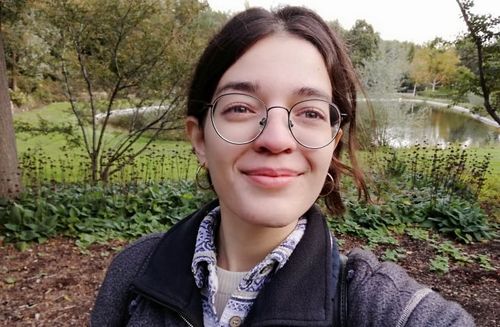
photo: private
Since Monday, 15 March 2021, Nikoleta Petridi from the University of Athens, Greece supports the International Coordination Office (ICO) for Polar Prediction as intern.
Nikoleta (Niki) Petridi is a geology student from the University of Athens, Greece. She has spent her last semester as an ERASMUS student at the University of Bremen, Germany. Niki is interested in various topics around climate change. Until 09 May 2021, she will be supporting the YOPP International Coordination Office as well as the project offices of APPLICATE and ESM, together with Mayleen Schlund who joined the ICO in February. (kw)
26 March 2021: New Polar Prediction Matters Contribution – Climate Service for the Chief Snowmaker
In the new Polar Prediction Matters contribution, Martin Coath from the YOPP-endorsed Blue-Action project and Carlo Carmagnola from the H2020 PROSNOW project talk about the opportunities and challenges that come with climate services for winter tourism management.
“Will there be enough snow on this slope for Christmas? Do I need to make more snow? And, how much water do I need to make the snow?” These are questions, a manager of a winter tourism resort might be asking. The two projects PROSNOW and Blue Action looked into these and came up with easy-to-use solutions how to predict snow-making conditions and indicate uncertainty with the ultimate goal to provide aid in decision-making.
In the new contribution of Polar Prediction Matters, the dialogue platform for providers and users of forecasting services, the outcome of the PROSNOW and Blue-Action studies are presented. Martin Coath from Blue-Action and Carlo Carmagnola from PROSNOW are discussing the differences and shared challenges between two projects looking at climate services for winter tourism. Amongst others, the co-designing process and close collaboration with stakeholders from different ski resorts has been “a key benefit and challenge” at the same time. While the finally available software application should be easy and simple to use, “it was a difficult process to simplify so much complexity”, says Carlo Carmagnola.
Find the full contribution to Polar Prediction Matters here.(kw/np)
24 March 2021: Save the Date and Submit – Virtual Meetings on YOPP in the Southern Hemisphere and Antarctic Meteorology and Climate
The 16th Workshop on Antarctic Meteorology and Climate (WAMC) will be organized virtually from 21 to 23 June 2021. Anyone interested in Antarctic research, operations and logistics with a focus in Antarctic meteorology and forecasting and related disciplines is welcome to join the sessions to share and discuss their results. Along with WAMC goes the sixth meeting of the Year of Polar Prediction in the Southern Hemisphere (YOPP-SH) community. Focus will be to discuss plans and contributions to the Antarctic Targeted Observing Periods (TOPs) scheduled for Antarctic winter 2022.
The virtual 16th WAMC and the 6th YOPP-SH meeting are organized by the Byrd Polar and Climate Research Center at The Ohio State University, Columbus, Ohio, USA. WAMC will take place from the 21 – 23 June 2021. It brings together those interested in Antarctic research and operations/logistics to share their latest results and discuss future concepts to better understand atmospheric, oceanic and sea-ice processes relevant to enable numerical weather, climate and sea-ice predictions. Contributions to the workshop in the field of Antarctic meteorology and forecasting and related disciplines are welcome to be submitted (see information below).
As in previous years, the YOPP-SH meeting will be aligned with WAMC, this year taking place on 24 and 25 June, in the virtual world. Recently, the YOPP-SH community has met online on a regular basis to discuss interest and potential contributions to the Antarctic Special Observing Period that is scheduled during mid-April and mid-June 2022. During the sixth YOPP-SH meeting, national commitments will be coordinated amongst the different action teams that look at various Antarctic regions to develop the Targeted Observing Periods (TOPs) that explore the predictability of impactful atmospheric phenomena such major oceanic cyclones and Atmospheric Rivers. In addition, results from the summer Special Observing Period (SOP) in 2018-2019 will be presented to guide the planning and execution of the Antarctic winter TOPs.
Registration is open until 31 May 2021 for the 16th WAMC and the 6th YOPP-SH Meeting:
Day sessions (11:00 – 1:30pm EDT, 15:00-17:30 UTC)
Evening sessions (5:00 – 7:30 pm EDT, 21:00-23:30 UTC)
Year of Polar Prediction in the Southern Hemisphere (YOPP-SH):
June 24 – 25 2021:
https://byrd.osu.edu/events/yopp-sh/register
Workshop on Antarctic Meteorology and Climate (WAMC):
June 21 – 23 2021:
https://byrd.osu.edu/events/wamc/register (kw/ms)
08 March 2021: Virtual PPP Steering Group Annual Meeting #12
From 8 to 12 March, the twelfth PPP Steering Group annual meeting takes place. Due to the ongoing pandemic, it will all be virtual. PPP SG#12 is organized by the International Coordination Office for Polar Prediction, hosted by the German Alfred Wegener Institute.
In order to make sure as many PPP SG members and guest as possible can join from all over the world, the ca 1.5- to 3-hours sessions twice a day are spread across a number of time zones. Day 1 starts off with the Welcoming session with PPP SG chair Thomas Jung, the WMO Director for Science and Innovation Jürg Luterbacher, and Estelle de Coning, Head of the World Weather Research Programm of WMO. During the first day, YOPP Education and Outreach activities will be discussed in view of the two final years of the Polar Prediction Project.
Day 2 of PPP SG#12 is in light of various ongoing PPP activities such as the Observing System Experiments (Irina Sandu), the YOPP Data Portal (Øystein Godøy and SiriJodha Khalsa), ongoing activities of the YOPP in the Southern Hemisphere community (David Bromwich), and engagements to increase the exchange between users and providers of polar forecasting products (PPP-SERA, Machiel Lamers and Daniela Liggett).
During day 3, activities aligned with the MOSAiC Arctic ice drift will be discussed; after a short review of MOSAiC by co-coordinator Matt Shupe, a summary of the Near-Real Time sea-ice verification (Amy Solomon) and on the Targeted Observing Period around Easter 2020 (Gunilla Svensson) both aligned with MOSAiC will be provided. On day 4, Gunilla Svensson and Taneil Uttal will summarize ongoing progress of the YOPPSiteMIP effort, and Helge Goessling will review outcomes of SidFex, a community effort to forecast RV Polarstern's track during MOSAiC.
Day 3 and day 4 are as well dedicated to planning and shaping the final two years of PPP, with a discussion on how to evaluate the success of the project and to ensure its legacy. Crucial for both will be the YOPP Final Summit that will also be topic for discussion later on Thursday, 11 March. On Friday, 12 March, internal PPP topics will be reviewed. The meeting will close with a summary of the week around 10.30 am UTC. (kw)
03 March 2021: Polar Prediction and Collaboration in the Arctic – Joint APECS-YESS-YOPP Workshop during #ASSW2021
The Association for Polar Early Career Scientists (APECS) is organizing together with the Polar Prediction Project’s (PPP) International Coordination Office and the Young Earth System Science (YESS) network a workshop during the business meetings of the Arctic Science Summit Week, this year organized virtually by Portugal.
The workshop is split into three 1.5h sessions over two days (21 and 22 March 2021). The first session “Home Office (Fatigue) and Zoom Networking – COVID-19 and ECRs” will take place on Sunday, 21 March 2021 06:00 – 07:30 GMT. We will hear about different international and national surveys and experiences that have been carried out to better understand the impact of the pandemic to academia. In a following panel discussion, we invite early career scientists to join us for a discussion on the impacts COVID-19 may have on your scientific work.
In session 2 “The 4 Essential Cs - Coordination, Communication, Community, and Collaboration” scheduled for Sunday 21 March 2021 16:00 – 17:30 GMT, you will learn about the Association of Polar Early Career Scientists (APECS), The Year of Polar Prediction (YOPP) and The Young Earth System Scientists community (YESS). International collaboration is crucial these days to carry out polar research. In order to bring researchers together from all over the globe, the above-mentioned communities coordinate and foster international and interdisciplinary studies in terms of related project groups, awareness-raising workshops and many more collaborative activities on both Polar and Alpine regions, and the wider cryosphere via communication with early career researchers. After a presentation on communication with the public, the session will touch upon some of the challenges of bringing the scientific community together. A panel discussion will expand on two short talks on Science and Diplomacy in the Arctic and insights about Indigenous collaboration. The session will conclude by bringing these ideas together by showing what is done across the collaboration and communication spectrum by YOPP’s International Coordination Office.
The third session “Predict and Predictability – The Arctic YOPP” on Monday 22 March 2021 12:00 – 13:30 GMT offers an overview of some of the key activities associated with the Year of Polar Prediction (YOPP) efforts and YOPP-endorsed projects in the Arctic and the North Atlantic. Through a series of rapid 5-min talks, the presenters will introduce a variety of YOPP activities, showcase a variety of available meteorological datasets and how to access them. The session will conclude by highlighting ways in which ECRs can contribute to YOPP and PPP.
Registration for early-bird rates is still possible by 7 March 2021. (ce/kw)
01 March 2021: Out now – First 2021 Issue of PolarPredictNews
The first 2021 issue of PolarPredictNews, the official newsletter for the Year of Polar Prediction, is now available with lots of news and updates from and for the polar prediction community. For the Art+Science part of the newsletter, we worked with climate scientist Thomas Rackow to present his the melting sea-ice stripes, inspired by Ed Hawkins’ concept of warming stripes.
Amongst others, find in the new issue of PolarPredictNews more about following topics:
Interview with Matthew Shupe, News about YOPPSiteMIP and the Merged Observing Data Files
We talked with MOSAiC Co-Leader Matt Shupe about the origins of the expedition, its challenging aspects, the mysteries whose answers may lie in the data and how to measure clouds during the polar night (p.9). Find out about the YOPPSiteMIP project (p.14), and for those who can’t wait to work with the unique datasets gathered during MOSAiC, there is also good news: The first merged-observatory data files (MODFs) are now available for use, and can be downloaded at the YOPP Data Portal (p.20).
Extreme Weather and the Polar Vortex
The stratospheric and tropospheric polar vortex, two distinct features of the atmospheric circulation, are an important driver of large-scale weather patterns in mid-latitudes. Recent extreme severe winter weather events, like storm Filomena in Spain (see cover picture) can be favored by certain conditions of these polar vortices. Commented by PPP Steering Group member Thomas Jung and Doug Smith from the UK Met Office, current knowledge about the different coupling mechanisms between the polar vortices and mid-latitudes is collected in this overview article (p.5).
East Greenland Is the Opposite of New York
In 1983, the south Tyrolean mountaineer Robert Peroni traversed the Greenland ice sheet at its widest point and never wanted to leave Greenland again. He bought a house and turned it into The Red House, a hotel where he welcomes anyone willing to stay at least a week. We interviewed Robert Peroni about weather forecasts and decision-making to ensure sustainable tourism in Greenland (p.12).
Artificial Intelligence in Polar Prediction
Machine learning and AI in particular are some of the hot topics, as many industries and public institutions can benefit from their usage already in the near future. This does also apply for weather and sea-ice forecasting in the polar regions. In this article, recent developments and improvements in polar prediction and weather forecasting in the Arctic by means of AI applications are highlighted (p.16).
Grab yourself a cup of tea and read about these and much more topics in PolarPredictNews#17.(db/kw)
26 February 2021: New Intern Joins YOPP Coordination Office
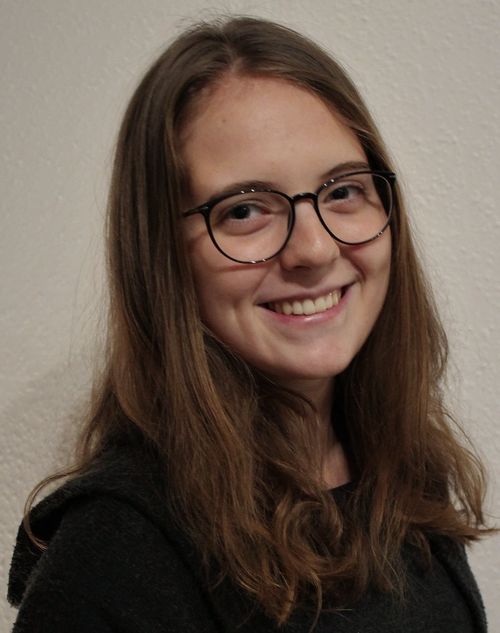
photo: private
On Monday, 22 February, a new intern has joined the International Coordination Office (ICO) for Polar Prediction to support PPP/YOPP until end of May.
Mayleen Schlund studies physical geography in her last bachelor's semester at the Leibniz University Hanover, Germany. Mayleen will assist the International Coordination Office (ICO) for Polar Prediction, the YOPP-endorsed project APPLICATE as well as the Helmholtz initiative Advanced Earth System Modelling project (ESM) until 27 May 2021. (kw)
19 February 2021: MOSAiC Data for Process-Based Model Evaluation – When and How?
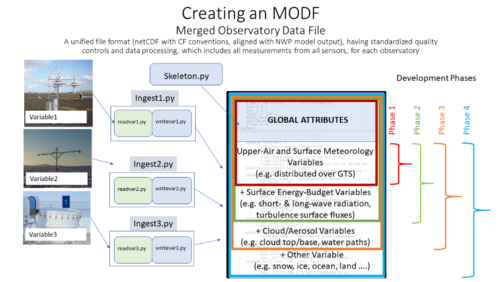
The creation of a merged observatory data file is facilitated by Python scripts that convert the observed variable name to the standardized one with all the needed netCDF attributes. Usability is thereby enhanced as the files for every observatory have the same structure and variable names. The files are developed in phases that successively include data from more instruments and parameters for more advanced process evaluation (source: Gunilla Svensson).
by Gunilla Svensson, Stockholm University, on behalf of the YOPP Process Task Team
The WMO WWRP Polar Prediction Project’s task teams for Processes, Data and Verification are actively pursuing several options to facilitate the community’s access to the unique and extremely valuable data that has been gathered during the MOSAiC expedition, and to pave the way for modellers to access the observational data. Merged Observatory Data Files (MODFs) for several YOPP supersites will be a way forward to enable standard observational data files from the supersites to be used by the polar prediction community. MODFs are available at the YOPP Data Portal (yopp.met.no).
Given the increasing demand for improved environmental prediction in the polar regions over the last decade, the polar prediction community is very excited about the observational data resulting from the MOSAiC expedition. The MOSAiC Data Policy states that all of the data will be freely and publicly available as of 1 January 2023. But some of the data will be available for model evaluation earlier as part of the YOPPsiteMIP effort.
Merged Observatory Data Files
Producing observational files of data that can be used by modelers for process evaluation is a complicated, time-consuming task. Through community efforts, we are doing this work “once and for all” in collaboration with the researchers responsible for the experimental data. The creation of a merged observatory data file is facilitated by Python scripts that convert the observed variable name to the standardized one with all the needed netCDF attributes. This means that the modelers are using the best suited observations in an easy-to access format that is used at all YOPPsiteMIP observatories.
At the moment, the PPP task teams for Processes, Data and Verification are focusing on creating MODFs for the YOPP supersites at Utqiagvik (formerly Barrow), Alaska; Sodankylä, Finland; Whitehorse and Iqaluit, Canada, for the YOPP Arctic winter Special Observing Period from 1 February–31 March 2018 as well as data from the MOSAiC site for boreal winter October 2019–March 2020. The goal is to have the first MODFs available at the YOPP Data Portal by the end of February 2021, with more to follow as soon as they are ready.
Read the full article by Gunilla Svensson.
09 February 2021: The IcePod Episode Ten – Binoculars are My Weapons
by Sara Pasqualetto and Kirstin Werner
For the tenth episode of The IcePod, we jump from the scientific part to the logistical aspects of the expedition. To carry out research in the living room of the polar bears requires people who take care of keeping everybody safe. "The binoculars are my weapons", says Laura Schmidt, member of the Safety and Logistics Team during MOSAiC leg 4.
Laura grew up in the alpine environment of Southern Germany which paved the way into the Arctic easily. Studying geography was a way to merge her passion for outdoor activities with scientific curiosity. And, Greenland was her first love – during her Master's degree she joined an excursion to the frozen super island and always wanted to come back.
This is what she did. As a self-employed, she has been guiding tourists through the extreme Greenlandic nature home to the Inuits. "In Greenland, everything is much different. Here, nature tells you what to do." One has to be able to read and feel the landscape in order to enjoy and get home safely and to deal with a pretty tough enemy when exploring Arctic environments: fog.
Safety was also the keyword for Laura's role onboard Polarstern. The polar bear watch was amongst a number of responsibilities to make sure scientists and crew could carry on with their jobs. But shooting a polar bear would only be the very last option she really had. There are a lot of other things that come first, such as retreating or using a flaring gun, explains Laura in the episode: "I would never want to be the person who shoots a polar bear."
It would be normal to wonder if Laura ever feels afraid, when working in such an extreme environment. But for her, fear is part of the job, and in the right doses, it is actually a key aspect to make her aware of her surroundings and keep her alert to perceive changes and dangers around her.
As part of a close team of researchers and professionals sharing the same home for three months, Laura had the opportunity to occasionally step out of her logistics role and contribute to other activities in the MOSAiC camp. That's how she got to feel being part of the atmosphere team, launching weather balloons and sending messages to the blue Arctic skies.
Find the new and all previous IcePod episodes e.g. on Spotify, Apple Podcast, Castbox (no sign-up needed) or on our website theicepodcast.home.blog
If you miss the music, find Laura's very special playlist for the episode on Spotify.
The episode with music was played
at https://www.medialabnord.de/radio-livestream/ (Bremerhaven) on
Saturday, 6 February 2021, 12–2 pm UTC (2–4 pm CET)
and will be played at https://www.medialabnord.de/radio-livestream/ (Bremen) on
Saturday, 20 February 2021, 2–4 pm UTC (4–6 pm CET)
Friday, 26 January 2021, 7–9 am UTC (9–11 am CET)
For updates and other materials, check also our website: theicepodcast.home.blog
---
The IcePod is the podcast about polar science and the people. We’ll talk to scientists who went on board Polarstern, the German research icebreaker, for the biggest research expedition in the Arctic. It is produced in collaboration with the Alfred Wegener Institute and Radio Weser.TV where the full episode with music will be played at www.medialabnord.de/radio-livestream/. For dates check back with polarprediction@gmail.com.
Editorial responsibility: Kirstin Werner and Sara Pasqualetto
02 February 2021: High-Resolution Ensemble Prediction System Improves Forecast Skill over the Antarctic Peninsula
In a new study by Gonzalez et al., the high-resolution Ensemble Prediction System (EPS) γSREPS recently developed by the Spanish Meteorological Organization (AEMET) has been validated in comparison with the ECMWF EPS. Their findings show that γSREPS presents added value over ECMWF EPS and will benefit future logistics activities and general safety in the Antarctic Peninsula.
Increasing logistics activity means skillful weather predictions are becoming crucial to the safety and security of scientific operations on the Antarctic continent. But the low density of assimilated weather observations in most high-latitude areas of the southern hemisphere limits the performance of numerical weather prediction (NWP) systems. In order to improve forecast skill for future logistics at the Spain’s Juan Carlos I (JCI) research station, the Spanish Meteorological Agency (AEMET) has developed the first operational convection-permitting limited area model ensemble prediction system (LAM-EPS) over Antarctica. It goes by the name γSREPS. It uses four mesoscale NWP models, each driven by three different global NWP models as boundary conditions (BCs). That is, it runs on three different assimilations to account for southern hemisphere mesoscale prediction and synoptic uncertainties and, as a result, consists of twelve ensemble members. It has a horizontal resolution of 2.5 km and 65 vertical levels.
During Spain’s Antarctic campaign of 2018/2019, which coincided with the YOPP Southern Hemisphere Special Observing Period, γSREPS was integrated at 0000 UTC for up to 48 hours over the Antarctic Peninsula (where the JCI research station is located) and operationally integrated into daily forecasting. Over the course of the campaign, forecasters subjectively assessed its performance very positively and perceived added value over ECMWF EPS, especially with respect to mesoscale wind and visibility features around Livingston Island. The authors objectively verified γSREPS in comparison with ECMWF EPS through a particular focus on 2 m temperature (T2m), 10 m wind speed (S10m) and visibility (vis). In this context, γSREPS improved forecast skill for all assessed variables except sea-level pressure.
A number case studies were also carried out. One of them, conducted during a low-level cloud event on 5 March 2019, compared the probability values for visibility and ceiling as determined by either model. The results confirmed that γSREPS, due to its high resolution, better represents the orography of the Antarctic Peninsula. Thanks to the better articulated results of γSREPS predicting good-enough visibility, forecasters could confidently recommend that planned scientific operations be carried out that day, where ECMWF EPS would not have permitted it.
γSREPS shows that high-resolution EPSs will be the way forward for precise short-range weather predictions. Its approach, combining multi-boundary conditions with different NWP systems, is somewhat unique and suited to studying the sources of uncertainty in polar prediction by segmenting outputs by BC and NWP. γSREPS will stay in operation during future campaigns. More members are to be added to the EPS.
Gonzalez, S., Callado, A., Martínez, M., & Elvira, B. (2020). The AEMET-γSREPS over the Antarctic Peninsula and the impact of kilometric-resolution EPS on logistic activities on the continent. Advances in Science and Research, 17, 209–217. https://doi.org/10.5194/asr-17-209-2020 (dbu)
27 January 2021: WMO Data Conference – Meet the Demand for Environmental Data from All Sectors of Society
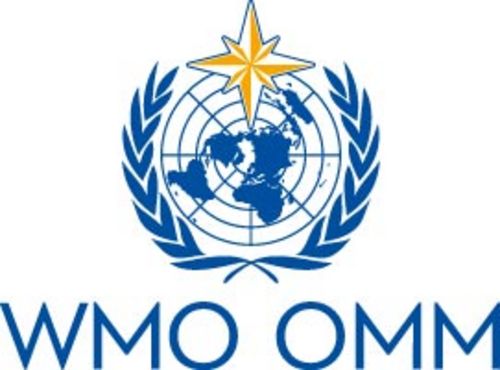
by Øystein Godøy, Norwegian Meteorological Institute
A WMO data conference was held from 16 to 19 November 2020 as a fully virtual conference. The purpose of the data conference was to engage a wide community in discussions of WMO data policy. WMO adopted an open data policy early on that was effectively implemented in three different WMO data policy resolutions that helped form the basis for the open data policy of the International Polar Year 2007–2008. The data policy is now under review. This data conference was part of the stakeholder engagement portion of the review process.
Since the establishment of WMO in 1950, the traditional WMO community has expanded its involvement of communities external to the organization, seeking to meet the demand for weather, climate, water and other environmental data in all sectors of society. Among these communities are both consumers and providers of relevant data and services. The conference was thus organized around four themes: The changing landscape of weather, climate and water data; Business models and data policy issues; Filling the gaps in global data coverage; and Data exchange for Earth system monitoring and prediction. Participants were drawn from a wide range of communities including WMO Members, space agencies, the private sector, global data users, academia, development partner organizations and other United Nations agencies and international organizations. For an introduction to the conference, a number of workshops were arranged that explored details of the conference’s themes from stakeholders’ perspectives.
The conference was designed to achieve several particular outcomes: Common understanding among all sectors of data exchange and its role in supporting the goals laid out in the WMO convention and the global agenda as articulated in the UN Sustainable Development Goals; improved understanding of the role of the private sector in data provision; stronger links between the private and public sectors; identification of the main obstacles to increased exchange of data and specific opportunities or activities to try to overcome them; recommendations for decision-making at the WMO Executive Council and the World Meteorological Congress in 2021.
The conference and the preceding workshops provided valuable input to the review process from communities both within as well as outside WMO. In particular, strong support was expressed for WMO maintaining a free and open data policy as well as for the development of a unified WMO data policy to include all Earth System disciplines. In this context, it was decided that the three existing data policy resolutions mentioned earlier will be replaced by a single resolution as a way to simplify the data policy issue for WMO activities and programmes. It was also noted that while advances in technology will help to implement the data policy, technology should and will not define the policy. Participants voiced some concern about the potential for conflicting national data policies among WMO Members to limit the capabilities of environmental monitoring and prediction. On the topic of gaps in Earth system observations, participants highlighted an increased level of engagement between National Meteorological and Hydrological Services and partnering communities, emphasizing the mutual benefits of data exchange and collaboration. This latter element is particularly important in the polar regions, where many monitoring efforts are undertaken by the academic community.
WMO, through efforts of the WMO Secretariat and the Study Group on Data Issues and Policy, is currently analysing the outcomes of the WMO data conference and related workshops as well as their meaning for WMO Data Policy.
For more information, please visit https://public.wmo.int/en/events/WMO-Data-Conference.
22 January 2021: New ECMWF Blog Article – Insights into Polar Observing Systems Using Numerical Models
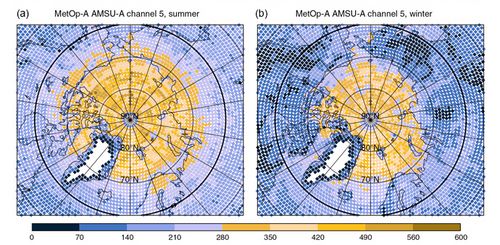
Figure from the ECMWF Blog Article: Number of observations assimilated in the ECMWF operational forecasting system from MetOp‐A AMSU‐A channel 5 (peaking around 850 hPa) in (a) June–September 2016 and (b) December 2017 to March 2018. Note that 60°N is indicated as a solid black line. Adapted from Lawrence et al. (2019).
by Laura Hüssner
In the new post on the Science Blog of the European Centre for Medium-Range Weather Forecasts (ECMWF), Irina Sandu, ECMWF Physical Processes Team Leader, and François Massonnet, F.R.S.-FNRS Research Associate at the Université Catholique de Louvain, Belgium, emphasize the importance of improved prediction skills and monitoring capabilities in the polar regions. The authors are calling for contributions to the special collection in QJRMS, to gather studies highlighting the impact of polar observations on predictive skill in polar regions and beyond.
Conventional observations such as radiosonde launches and surface observations are less common in polar regions. But looking at sounding satellite data, polar regions are sampled at higher frequency than any other region on the globe, due to the fact that polar-orbiting satellites pass over the pole at each orbit. These observations are a key ingredient for accurate predictions from hours to years ahead.
Irina Sandu currently represents ECMWF in the PPP Steering Group, while François Massonnet who leads the Antarctic Sea Ice Prediction Network SIPN South is active in the YOPP Southern Hemisphere Task Team. The blog describes how coordinated numerical experimentation with coupled prediction systems helps to identify the impact of atmospheric observations on short- and medium range weather forecasts (hours to days), and the impact of sea ice initialization on sub-seasonal to seasonal forecasts (weeks to months ahead).
Key to enhance future prediction capacities in polar regions are synergistic investments in observing and numerical prediction systems. As APPLICATE and the Polar Prediction Project (PPP) have demonstrated, numerical models can be used to show the impact of current observing systems on predictive skill, identify ways to maximize their uptake in numerical weather prediction (NWP) systems, and guide the design of future observing systems. “The clear message is that investment in observing systems must be carried out synergistically with the investment in numerical prediction systems”, is stated by the authors.
For the special collection in QJRMS, the Quarterly Journal of the Royal Meteorological Society is currently welcoming manuscripts covering Observing System Experiments on a range of time scales (from a few days to sub-seasonal or seasonal) as well as studies that use numerical experimentation to explore the possible added value on predictive skill of recently available or hypothetical observations.
Find Irina's and François' blog article here.
20 January 2021: Arctic Change 2020 Session on Weather, Water, Ice, and Climate Services
by Jackie Dawson, the Arctic Change 2020 Communication Team, and Daniel Butkaitis
During the Arctic Change 2020 conference, a special session on weather, water, ice and climate (WWIC) services took place, co-chaired by members of PPP-SERA. The session brought together WWIC users and providers from different industries and institutions all around the globe. Outside the presentations, the importance of end-user engagement and collaboration with local communities was discussed and highlighted.
2020 was a year like no other for Arctic research, and ArcticNet’s Arctic Change conference was no exception. It is generally held every three years at different locations in Canada. This year, the global COVID-19 pandemic shifted the international conference to a virtual setting, with 1 600 attendees tuning in online from across Canada and around the world. This year, there were 327 Northern participants and dozens of international delegates representing Arctic and non-Arctic nations around the globe.
Of the 320 virtual presentations with live question and answer sessions, many were highly relevant to exploring and better understanding the need for enhanced and improved weather, water, ice, and climate (WWIC) services and service delivery. Topical and plenary sessions covered everything from innovation in satellite technology for marine and terrestrial environmental systems observation to the role of Indigenous knowledge in science.
A special session on WWIC services was co-chaired by members of the Polar Prediction Project’s Societal and Economic Research Applications group (PPP-SERA): Gita Ljubicic from McMaster University, Canada and Jackie Dawson from the University of Ottawa. International presenters in the session discussed innovations in and needs of WWIC service provision and use in the polar regions. Presentations were given by, amongst others, Marta Terrado (Barcelona Supercomputing Center), Victoria Heinrich (Australian Bureau of Meteorology), Rick Thoman (Alaska Center for Climate Assessment and Policy) and Lynn Moorman (Mount Royal University, Canada). The session was attended by more than sixty participants representing a variety of service providers and end users from the shipping, oil and gas, tourism, fisheries, aviation and education sectors.
A rich question and answer session revealed the importance of engagement with Indigenous persons from the Arctic to enhance WWIC services and service provision to ensure safe local mobility. Similarly, the need to connect with end users and experts to enhance safe navigation in the Antarctic was emphasized.
A special session and side meeting focused on WWIC is being planned for the December 2021 ArcticNet meeting to be held in Toronto, Canada (or virtually depending on COVID-19 restrictions).
Further information on the Arctic Change conference 2020 can be found here.
12 January 2021: Workshop on Satellite Microwave Products for High Latitude and Polar Areas Models
In order to foster the utilization of satellite microwave data in weather, climate, ocean and sea-ice prediction services at high latitudes, EUMETSAT and YOPP are jointly organizing a workshop which is going to take place fully virtual on 23 and 24 February 2021. Abstract submission (on invitation only) is open until 31 January 2021. Attendance to talks and panel discussions is open to a wider audience, registration being possible until 12 February 2021.
Making use of satellite microwave observations has become essential for weather prediction and climate projection services, especially in polar regions, where the conventional observational network is generally sparsely developed compared to the rest of the world. Satellites provide important information beneficial for both coupled and stand-alone atmosphere-ocean-sea-ice models in numerical weather prediction (NWP) systems. However, numerical experiments within the framework of the YOPP, amongst other projects, have shown for example that the use of observations from microwave sounders still lacks optimal performance.
Therefore, YOPP and EUMETSAT are organizing an online workshop entitled “The Optimal Use of Satellite Microwave Products for High Latitude and Polar Areas Models”. This workshop seeks to bring together experts from all different areas contributing to the provision of weather, water, ice and climate (WWIC) information services, from satellite product development, coupled NWP or climate modelling, data assimilation, radiative transfer and in-situ observations. The workshop will take place on Tuesday, 23 and Wednesday, 24 February 2021. Similar to most meetings these days, this scientific workshop will be fully virtual.
The workshop includes several panel discussions from a number of experts who will identify current issues in the usage of satellite microwave products feeding into the important discussion about the most promising approaches to effectively increase the uptake of microwave observations in NWP and climate systems. Abstract submissions are invited until 31 January 2021.
Attendance to the workshop will also be open to the wider scientific community. Attendants will have the possibility to follow the panel discussions and ask questions to the experts via the sli.do platform. The deadline for registration to attend is 12 February 2021.
To attend at this workshop or to submit an abstract, you need to register on the workshop’s website. (db)
08 January 2021: vEGU2021 – Second Virtual EGU 2021
+++ Update: Deadline for abstract submission extended to 20 January, 13:00 CET +++
From 19 to 30 April, 2021, the 2021 European Geoscience Union (EGU) General Assembly will be held virtually for the second time. Built on the experience from last year’s “EGU2020: Sharing Geoscience Online”, the concept of the virtual EGU 2021, or #vEGU2021, has been designed, with the possibility for participants to join remotely from all around the globe. Abstract submission is open until 13 January 2021 at 13:00 CET.
The European Geoscience Union (EGU) is the leading organization for Earth, planetary and space science research in Europe. EGU fosters fundamental geoscience research, alongside applied research that addresses key social and environmental challenges.
Since networking opportunities were limited in 2020 for scientists, for the second time EGU is trying to counteract the ongoing situation with the majority of researchers working from home. #vEGU21 is the virtual platform for geoscientists from all around the world to engage, bringing together nearly seven hundred geoscience sessions held primarily from 26 to 30 April.
For the polar prediction community, multiple sessions are relevant, such as the session “Clouds, moisture, and precipitation in the Polar Regions: Sources, processes and impacts” submitted by Irina Gorodetskaya and colleagues engaged in the YOPP-Southern Hemisphere Task Team. A list with all sessions relevant for PPP and YOPP can be found here. The complete #vEGU2021 program is available here.
Abstracts to actively contribute to #vEGU2021 can be submitted by 13 January 2021, 13:00 CET. To submit your abstract, please use the following link.
Early registration rates are available until 31 March 2021, find the registration fees here. Undergraduate or master students can sign up for free.
For questions or concerns regarding vEGU21, visit the provisional format page or email egu21@copernicus.org. (lh/db/kw)
23 December 2020: The IcePod Episode Nine – Hugs, Dips in Melt Ponds, and WiFi on the Ice
by Kirstin Werner and Sara Pasqualetto
If anybody has an idea of the uncountable number of data points retrieved during the MOSAiC one-year ice drift, it can only be Antonia Immerz. Antonia is the data manager of MOSAiC, she has joined leg 1 and leg 4 onboard Polarstern, and she is one of the few lucky ones (or should we rather call her 'brave'?) who took a bath in an Arctic melt pond. In this ninth episode of The IcePod, we slightly change perspective by looking at MOSAiC from a data point of view.
Since 2018, Antonia has been coordinating the data activities and infrastructure to support the Arctic ice drift at the Alfred Wegener Institute. By taking on this role, it came together very well for Antonia who had spent her childhood snorkeling at the tropical beaches of Papua New Guinea. With Antonia, we uncover the perfect career development for a data scientist involved in such a big project like MOSAiC. Following her childhood dreams for the marine world, Antonia ended up just in the perfect place to combine her technical skills with her fascination for the ocean.
Now, the data is where the magic happens. 200 terra bytes of data, about 15,000 actions to retrieve data, and Antonia knows there is much more data available from the comprehensive central Arctic study that came to an end this past October. For her and the data team, the work even reaches a new level, now that everybody is interested in analyzing the data. All success relies on the human factor, and communication is key to make it work – these are some of the lessons learned for Antonia to efficiently support MOSAiC members working with the data. If you listen carefully, Antonia even whistle-blows some (not-so-secret) tricks how to potentially get access to data, even if you haven't been involved in the project earlier.
Leg 4 was also called the hugging leg – it probably was the only place on Earth where one hundred people were still allowed to have physical contact while the rest of us, half-face covered by masks, made a huge effort to smile-with-eyes at the supermarket's cashier or the post office lady. In the meantime, they had a good time onboard Polarstern during 'Art & Wine' nights, and acting, knitting, wood carving, or jam sessions. As a special treat of this IcePod episode, you will get to hear the MOSAiC song composed by Matt Boyer, Ingo Schuffenhauer und Felix Linhardt played during the last CTD cast of leg 4. Antonia was thus lucky enough to celebrate her birthday in the Arctic with great music and a party hosting around one hundred people – seeking some harmony, peace, and love in the time of Corona.
Find the new and all previous IcePod episodes e.g. on Spotify, Apple Podcast, Castbox (no sign-up needed) or on our website theicepodcast.home.blog
If you miss the music, find Antonia's very special playlist for the episode on Spotify.
The episode with music is played
at https://www.medialabnord.de/radio-livestream/ (Bremerhaven) on
Saturday, 2 January 2021, 12–2 pm UTC (14 am–16 pm CET)
and at https://www.medialabnord.de/radio-livestream/ (Bremen) on
Saturday, 23 January 2021, 2–4 pm UTC (4–6 pm CET)
Friday, 29 January 2021, 10 am –12 pm UTC (12–2 pm CET)
For updates and other materials, check also our website: theicepodcast.home.blog
---
The IcePod is the podcast about polar science and the people. We’ll talk to scientists who went on board Polarstern, the German research icebreaker, for the biggest research expedition in the Arctic. It is produced in collaboration with the Alfred Wegener Institute and Radio Weser.TV where the full episode with music will be played at www.medialabnord.de/radio-livestream/. For dates check back with polarprediction@gmail.com.
Editorial responsibility: Kirstin Werner and Sara Pasqualetto
22 December 2020: PPP-SERA Session at International Congress of Arctic Social Sciences (ICASS X)
The 10th International Congress of Arctic Social Sciences (ICASS X) is now scheduled to take place from 15 to 19 June 2021 in Arkhangelsk, Russia. A PPP-SERA session addresses the social-science and economics aspects of the Polar Prediction Project. Abstract submission is due 25 December.
Approximately four million people are living in the Arctic, counting numerous ethnicities among its inhabitants. Indigenous peoples make more than ten percent of the total population living in the Arctic.
The focus of the 10th International Congress of Arctic Social Sciences, or ICASS X, will be on all aspects – social, cultural, historical, economic, political, linguistic, to just name a few – of human existence in the Arctic in the past, present and future. During the conference, the history and the future of Arctic peoples and how to make their environments sustainable throughout generations will be discussed. Another important aspect is the co-production of knowledge with Indigenous knowledge holders and Arctic stakeholders.
The PPP Societal and Economic Research and Applications (SERA) Task Team will also contribute to ICASS X with a session “Tailoring Environmental Forecasting Information and Services to Diverse Polar Needs“. Organizers of the session Daniela Liggett, Machiel Lamers and Yulia Zaika aim to particularly address the social-science and economics aspects of the Polar Prediction Project. Invited are contributions on research related to the needs for and the use of environmental information, including decision-making processes by a diverse range of actors in polar regions and providers of environmental information. With this, the PPP-SERA task team encourage the communication between providers and users of polar weather and ice information.
The 10th International Congress of Arctic Social Sciences (ICASS X) is organized by the International Arctic Social Sciences Association (IASSA), and hosted The ARCTICenter at the University of Northern Iowa (USA) and Northern Arctic Federal University (Russia). Indigenous peoples, northern residents, decision-makers, politicians as well as academics are encouraged to participate.
The deadline for paper/poster abstracts is December 25, 2020. Please submit your abstract here. More information is available on https://icass.uni.edu/.
21 December 2020: PPP-SERA Special Services Projects Workshop on Co-Production in the European Arctic
The PPP Social and Economic Research and Applications (PPP-SERA) task team will host a Special Services Projects workshop on 25 January 2021. Bringing together an interdisciplinary group of researchers involved in the co-production of weather, water, ice and climate (WWIC) information services, this online workshop aims to capture the state of the art of co-production approaches in European Arctic research.
Environmental conditions in the Arctic are becoming more dynamic due to climate change, while the range of human activities in the European Arctic is projected to increase. Specialized environmental forecasting services are increasingly being made available by a growing range of public and commercial providers, to facilitate human safety, community well-being, as well as sustainable operations. The tailoring of these services is increasingly based on the premise of co-production, to suit diverse user needs across the Polar Regions, and research is funded under the condition that co-production with a range of stakeholders and end-users will need to take place. However, there is a limited understanding, both practically and conceptually, of what such co-production initiatives entail in the European Arctic context, and how co-production processes can be carried out in ways that benefit both user and research communities.
To address these challenges, an online workshop entitled “Co-production in the European Arctic Weather, Water, Ice and Climate Services” will be held on 25th of January 2021. Organized by the PPP-SERA members Machiel Lamers and Jelmer Jeuring, the workshop aims to bring together researchers and representatives from past and present projects in the European Arctic region, with a focus on co-production on WWIC information services for the benefit of communities and economic sectors. Through exchange of experiences and challenges, this workshop will help to understand the diverse range of co-production approaches as well as to discuss a roadmap for future activities.
A number of expert speakers have already confirmed their participation in the workshop. Keynotes are planned from Dr. Kirstin Werner (PPP), Dr. Annette Scheepstra (EU-PolarNet), Dr. Marta Bruno Soares (University of Leeds), Dr. Berill Blair (Wageningen University & Research) and Dr. Marta Terrado (Barcelona Supercomputing Center). Furthermore, a range of online breakout-sessions will allow for interactive engagement between workshop participants.
To get more information about the workshop held on Monday, 25 January 2020, 13:00 – 17:00 CET and to receive the Zoom link, fill in the registration form. The registration process includes a brief survey on your personal experience and perspective regarding co-production processes. Registration will close on the 18th of January 2021. (db/jj/ml)
16 December 2020: IARPC Collaboration Team Annual Report 2020
by Daniel Butkaitis
The Interagency Arctic Research Policy Committee (IARPC) has recently published their Annual Report for 2020. It contains a summary of this year’s major achievements of IARPCs different collaboration teams made in connection with the Arctic Research Plan 2017-2021.
With dramatic environmental changes being observed throughout the Arctic and its effects on the global weather and climate system, IARPC had developed an Arctic Research Plan 2017-2021 back in 2016 in order to improve critical research areas of common interest in the Arctic. The implementation of this plan has been ensured by the activities of twelve different collaboration teams within IARPC. Their recent developments are described in detail in the 2020 IARPC Collaboration Team Annual Report.
This year was especially marked by challenges associated with the COVID-19 pandemic. The Terrestrial Ecosystems Collaboration Team (TECT) has evaluated the impacts on research in detail and is going to release a report on their findings in early 2021. Despite the altered conditions for field activities, the Atmosphere Collaboration Team (ACT) has still been able to support the coordination of the MOSAiC ice drift, as well as the planning of the YOPP Targeted Observing Periods (TOPs) that aligned with it. Furthermore, ACT continued their efforts in data consolidation. Model evaluation and comparison activities using observatory data through the Year of Polar Prediction site Model Inter-comparison Project (YOPPSiteMIP) could still be further advanced.
The full IARPC Annual Report 2020 can be downloaded here.
More information on the Arctic Research Plan 2017-2021 can be found on IARPC’s website.
10 December 2020: Overview Paper on YOPP in the Southern Hemisphere (YOPP-SH) Effort

Number of additional radiosondes launched during the YOPP-SH SOP by land location and by ship (ship symbols plotted at representative locations). “King George Island” combines the soundings from Escudero and King Sejong stations. “Terra Nova Bay” merges the efforts of Mario Zucchelli and Jang Bogo stations. The extra radiosondes add to the routine launches from Rothera, Halley, Neumayer, Novolazarevskaya, Syowa, Mawson, Davis, Mirny, Casey, Dumont D’Urville, Macquarie Island, Mario Zucchelli, Dome C (aka Concordia), McMurdo, and South Pole. McMurdo and South Pole each had two routine soundings per day but nothing in addition (source: Bromwich et al., 2020, BAMS).
In a community effort, activities to enhance forecast capabilities in the Antarctic and the Southern Ocean in the frame of the Year of Polar Prediction in the Southern Hemisphere (YOPP-SH) have recently been summarized in the Bulletin of the American Meteorological Society (BAMS).
Led by PPP Steering Group member David Bromwich, efforts around the YOPP Special Observing Period (SOP) during the Antarctic summer season 2018/2019 have been published in BAMS. During the three-month period, more than 2,200 additional weather balloons were launched which roughly doubled the Antarctic routine radiosonde program. In addition, the network of drifting buoys in the Southern Ocean was enhanced.
Early results from observing system experiments using the extra data from the SOP indicate greatest forecast improvement for deep cyclones near the Antarctic coast. SOP data have also been applied to provide insights on an atmospheric river event as well as to better understand spatial and temporal characteristics of Antarctic sea-ice extent. Based on the success of the Antarctic summer YOPP-SH SOP, a winter YOPP-SH SOP is currently being organized to support explorations of Antarctic atmospheric predictability in the austral cold season when sea ice is rapidly expanding over the Southern Ocean. (kw)
Bromwich, D., Werner, K., Casati, B., Powers, J.G., Gorodetskaya, I., Massonnet, F. et al.: The Year of Polar Prediction in the Southern Hemisphere (YOPP-SH). Bull. Amer. Meteor. Soc., 101(10), E1653–E1676 (2020), doi.org/10.1175BAMS-D-19-0255.1
08 December 2020: ECMWF Global Coupled Atmosphere, Ocean and Sea-Ice Dataset for the Year of Polar Prediction 2017–2020

Schematic of the YOPP dataset production framework: The initial conditions and ensemble forecasts are generated by ECMWF’s operational forecasting system based on ensembles of data assimilation and models. Atmosphere, land and ocean waves are separate from the ocean and sea-ice circulation in the data assimilation system, while the forecasts are fully coupled. Only the unperturbed control experiment output is ingested in the YOPP dataset from day 0 to day 15, and complemented by physical process tendency output from day 0 to day 2 (source: Bauer et al., 2020, Scientific Data. From: ECMWF global coupled atmosphere, ocean and sea-ice dataset for the Year of Polar Prediction 2017–2020)
by Daniel Butkaitis, Peter Bauer and Kirstin Werner
A detailed description of the global ECMWF-YOPP dataset has just been released in Nature’s journal Scientific Data. The is expected to spawn novel research ideas, generate more funding opportunities and promote inspiring masters and PhD work. It is publicly available at the YOPP Data Portal (https://yopp.met.no/).
In parallel to all field campaigns and numerical experiments that so far contributed to the Year of Polar Prediction, the European Centre for Medium-Range Weather Forecasts (ECMWF) has produced a unique dataset to monitor the state of the coupled system along several seasons in polar region. In addition to the entire model output on atmosphere, ocean and sea ice, the resulting, extensive database contains specific information on the individual physical processes. This allows scientists to investigate how the system’s state is affected by, e.g., dynamic transport, radiation or cloud microphysics.
Peter Bauer et al. have now published their article entitled “ECMWF global coupled atmosphere, ocean and sea-ice dataset for the Year of Polar Prediction 2017–2020” in Scientific Data. The authors describe the ECMWF-YOPP dataset which contains initial condition and forecast model output from the operational global, coupled numerical weather prediction system. The dataset which can be accessed through the YOPP Data Portal (https://yopp.met.no) offers freely available atmosphere, ocean and sea-ice output from the world’s leading global medium-range numerical weather prediction system.
Read a related blog article at Springer Nature https://researchdata.springernature.com/posts/ecmwf-s-year-of-polar-prediction-dataset-a-reference-for-polar-weather-and-climate-research
Bauer, P., Sandu, I., Magnusson, L. et al. ECMWF global coupled atmosphere, ocean and sea-ice dataset for the Year of Polar Prediction 2017–2020. Sci Data 7, 427 (2020). https://doi.org/10.1038/s41597-020-00765-y
03 December 2020: The IcePod Episode Eight – Snowflakes, Pee Bottles and a Mosaic of Floes
by Sara Pasqualetto and Kirstin Werner
In episode eight of the IcePod, we get to hear back from one of our previous guests – Stefanie Arndt who already spoke with us before leaving for the Arctic (Bonus Episode One). After 145 days away from her home in Bremerhaven, she tells us all about MOSAiC expedition leg 3. Stefanie Arndt is a sea-ice scientist at the German Alfred Wegener Institute, and she has a special sense of snow. While Antarctic snow has been her first love, this time Steffi ventured northern fields and flirted with Arctic snowflakes.
After she managed to survive the shortage of muesli brought from her home just at the end of the transit on board the Russian support icebreaker Kapitan Dranitsyn that brought leg 3 to the ice camp during the return of sun, Steffi led Team Ice during a challenging time: Not only it was the coldest leg of MOSAiC but there was lots of uncertainty due to very dynamic ice conditions. In addition, the leg got extended because of the pandemic that let no aircraft leaving from Svalbard for the planned exchange with the next leg. But Steffi and her team adapted well to the altered circumstances, studying spring conditions much longer into the season than expected – as the days became longer the sea ice energy and ice albedo changed and eventually the MOSAiC ice floe became a mosaic of floes…
What to do when something's becoming very urgent on the ice? Steffi gives some yet unknown insights to the logistic challenges of MOSAiC. Or did you already know that pee bottles were an item due to the no-pee policy for MOSAiC field work?
Even polar scientists are not immune to Arctic temperatures so one has to find a strategy for sampling snow at -40°C. MOSAiC's Smilla had a pretty elaborate way using warming pads and two layers of warm gloves under her pair of plastic gloves to not contaminate the snow. Another way to keep yourself warm is to "walk five hundred miles" across the ice ridges. Luckily, there was always hot tea when returning from a long day out on the camp to a warm and cosy home called Polarstern.
While Corona was affecting life on land, Steffi and the team of leg 3 had still chance to collect hugs before leaving the ice and go back home. Something she could draw on for the months to come...
Find the new and all previous IcePod episodes e.g. on Spotify, Apple Podcast, Castbox (no sign-up needed) or on our website theicepodcast.home.blog
If you miss the music, find the very special playlist for the episode on Spotify.
The episode with music is also played
at https://www.medialabnord.de/radio-livestream/ (Bremerhaven) on
Saturday, 5 December 2020, 12–2 pm UTC (14 am–16 pm CET)
and at https://www.medialabnord.de/radio-livestream/ (Bremen) on
Friday, 11 December 2020, 7–9 am UTC (9–11 am CET)
Saturday, 19 December 2020, 2–4 pm UTC (4–6 pm CET)
For updates and other materials, check also our website: theicepodcast.home.blog
---
The IcePod is the podcast about polar science and the people. We’ll talk to scientists who went on board Polarstern, the German research icebreaker, for the biggest research expedition in the Arctic. It is produced in collaboration with the Alfred Wegener Institute and Radio Weser.TV where the full episode with music will be played at www.medialabnord.de/radio-livestream/. For dates check back with polarprediction@gmail.com.
Editorial responsibility: Kirstin Werner and Sara Pasqualetto
01 December 2020: Webinar Series – Third Arctic Science Ministerial (ASM3)
by Daniel Butkaitis
In order to sustain scientific exchange between Arctic researchers even under pandemic conditions, the organizers of the third Arctic Science Ministerial (ASM3) have launched a webinar series. Scientists, Indigenous peoples and other Arctic stakeholders are invited to further engage in the science process in preparation of the third Arctic Science Ministerial meeting held in Tokyo, Japan, in May 2021.
Mitigating the impacts of climate change in the Arctic may be one of the biggest challenges our society is facing nowadays. International cooperation and science-based policy decisions? will be essential to counteract global warming, which is affecting the livelihood of Arctic communities all around the circumpolar north, where the effects of climate change are most notable. To strengthen the cooperation amongst Arctic scientists has therefore been a key goal of the Arctic Science Ministerial meetings with the first two meetings hosted by the United States in Washington D.C. in 2015 and by the European Commission, the Republic of Finland and the Federal Republic of Germany in Berlin, Germany, in 2018, respectively.
Due to the ongoing travel restrictions under pandemic conditions, the third ASM meeting that was supposed to take place in November 2020 has been postponed to take place on 8 and 9 May 2021 in Tokyo, Japan, co-hosted by Iceland and Japan. To keep scientific dialogue ongoing, the European Polar Board launched a monthly webinar series in preparation of the ASM3 meeting. Everyone interested is invited to participate in the online meetings and workshops that will take place until June 2021. As such, the webinar series aims to increase transparency of the ASM science process taking on board all Arctic stakeholders, including scientists, Indigenous communities, and other groups living or working in the Arctic.
Gaps and Barriers in International Arctic Research
The second of the webinar series on 11 November in particular focussed on current gaps and barriers in international Arctic research. Over 130 participants from all over the world joined the Zoom meeting where the need of more international approaches but also opportunities in Arctic research was highlighted. A panel of five speakers presented their work and synthesis reports from recent research projects to give best-practice examples on international cooperation. Amongst the speakers, MOSAiC project manager Anja Sommerfeld elaborated on the lessons-learned from the one-year ice-drift mission and why MOSAiC is a shining example for fruitful international cooperation. Followed by the speakers’ presentations, the participants met in several breakout sessions to specify the resulting actions needed for better international cooperation; these will be integrated in the final report for the ASM3 meeting.
The next webinar session will take place on 3 December 2020, 5 to 7 pm UTC (register here), with a focus on Indigenous people and their contributions to Arctic science research, in order to include their voices and perspectives in the recommendations to be documented in the ASM3 report.
The online platform to be used for the ASM3 webinars is Zoom. Each session will be recorded and uploaded on the European Polar Board YouTube-Channel.
For more information see https://asm3.org/webinar-series/
26 November 2020: First Integrated European Polar Research Programme Published
by Daniel Butkaitis
EU-PolarNet has recently concluded their work on an integrated European Polar Research Programme, which guides the future research to respond to current and prospective needs and expectations of European societies regarding the changing polar regions. Two new white papers have been released in accordance to the new programme.
After five years of thrilling collaborative work, the new European Polar Research Programme (EPRP) has been published now by EU-PolarNet. The new programme will contribute to a better understanding of societal and environmental vulnerabilities in both polar regions. Six overarching research issues have been identified, that will need close collaboration with local stakeholder groups. Answering the research questions posed in the EPRP will further improve our knowledge on the interactions between natural and social sciences. The EPRP also emphasizes the need for a polar observing campaign, which could “build upon and extend the Year of Polar Prediction effort.”
In addition, EU-PolarNet also published two new white papers. The “White Paper on Status of Stakeholder Engagement in Polar Research” provides evidence-based advice on best-practices for communication and engagement with polar stakeholders. The “White Paper on European Polar Infrastructure Access and Interoperability” discusses how to improve access and interoperability and includes an implementation plan for the EPRP to enhance future perspectives for polar operations.
EU-PolarNet started in 2015 as the world’s largest consortium in polar research, with expertise and infrastructure provided by 22 of Europe’s leading Arctic research institutions. The initiative was funded by the EU Horizon 2020 Programme with two million Euro. Throughout the last five years, the consortium’s ambition has been to advance international cooperation as well as cooperation with stakeholders, to advise policy-makers regarding the polar regions, and to identify the social relevance of polar research needs.
EU-PolarNet 1 came to an end in June this year. But the work is not done yet. Rather, the second phase of the consortium, EU-PolarNet 2, is already at the door. Compared to its first phase, EU-PolarNet 2 has remarkably grown and is now counting 25 partners, with all European countries being included. EU-PolarNet 2 will continue and build upon the polar framework that has formed in the last years to develop a platform to mutually advance future polar research actions.
For more information about EU-PolarNet 2 take a look at the Kick-Off Event, which took place during the 2020 European Polar science week. The event video is still available online and can be found here.
To access the European Polar Research Programme and the white papers click on the respective links or visit the EU-PolarNet web page: https://www.eu-polarnet.eu/
24 November 2020: New YOPP-Endorsed Project – Isotopic Links to Atmospheric Water's Sources (ISLAS)
by Daniel Butkaitis
A new research project has received YOPP-Endorsement: The project “Isotopic Links to Atmospheric Water’s Sources” (ISLAS) investigates the local water cycle in the Nordic Seas region by means of stable isotope instrumentation applied from research aircraft and ground-based observations. ISLAS will thus make substantial contributions towards enabling a better representation of the water cycle in operational weather prediction models, including ocean evaporation, cloud cover and mixed-phase precipitation.
When it comes to our understanding of the hydrological water cycle, there are still significant uncertainties. Especially water vapor and clouds remain the largest error sources in weather predictions and climate models. The reason for this uncertainty is that many processes in the water cycle occur on smaller scale resolutions than the model grids, thereby highly limiting the predictive skill of hydrological extreme events.
However, we can gain information on the moisture transport history and phase changes of the water throughout the hydrological cycle from the stable isotopes of water, namely hydrogen 2H, and oxygen 17O and 18O. Measuring the distribution of these isotopes can therefore contribute to overcome model uncertainties. Recent technological improvements in isotope measurement and in-situ sample collection allow to gather a high-resolution and high-precision data set of isotopes – and this is what ISLAS is aiming for. The collected data will set new benchmarks for improved weather prediction and climate models, thereby enabling an increased understanding of the hydrological cycle.
Main activities for the data collection led by Harald Sodemann from the University of Bergen in Norway will be a set of field experiments to measure the atmospheric vapour and precipitation isotope composition. After a first ground-based campaign in spring 2020, an airborne campaign is planned now for March/April 2021. The observations will be analysed by a unique palette of sophisticated model tools. To plan successful aircraft measurement operations, a short-term probabilistic forecast system will be developed and shared with both the Norwegian Meteorological Institute (MET Norway) and other scientific aircraft operators. Furthermore, several model sensitivity experiments are planned using the isotope-enabled, regional numerical weather prediction model COSMO-iso, as well as the AROME Arctic model used by groups working with the Consortium for Small-Scale Modelling and with MET Norway, respectively.
More information on ISLAS can be found on their website.
An overview on ISLAS and other YOPP-endorsed projects is also available at the data base of YOPP-endorsed projects.
19 November 2020: SIPN South Antarctic Sea-Ice Predictions – Call for Contributions
The YOPP-endorsed Sea Ice Prediction Network South (SIPN South) invites contributions to the fourth coordinated sea-ice prediction experiment in the Southern Ocean.
SIPN South is an international project endorsed by the Year of Polar Prediction (YOPP). Its goal is to make an initial assessment of the ability of forecasting systems to predict circumpolar-average, regional-average, and local Antarctic sea ice conditions, with a focus on the summer season.
SIPN South is now inviting contributors to participate in the fourth coordinated sea-ice prediction experiment in the Southern Ocean, targeting the period December 2020-February 2021.
For more information about the project and for submission guidelines, please follow this link. The deadline for submission of the forecasts is Tuesday, 8 December 2020.
Questions or feedbacks may be directed to François Massonnet (francois.massonnet@uclouvain.be).(lh)
17 November 2020: New Polar Prediction Matters Contribution – Is Alaska Prepared for Extreme Wildfires?

Is Alaska prepared for extreme wildfires? EU project APPLICATE scientists contribute to forecasting Alaska wildfires to enable better forecasts to prepare for serious wildfires in the future. Improving the predictive skill of the Extreme Forecast Index (EFI) highly related to the risk of wildfires can help Arctic communities to make more efficient risk management decisions (photo: Pixabay).
by Sara Octenjak, Barcelona Supercomputing Center
In the new contribution to Polar Prediction Matters – the dialogue platform for users and providers of polar weather and sea-ice forecasts – researchers working within the YOPP-endorsed EU 2020 Horizon APPLICATE project present a case study analysing Alaska’s extreme wildfire season in 2019. on forecasts of Alaska wildfires.
The work belongs to a series of case studies developed within the YOPP-endorsed APPLICATE project, showing the use of weather, climate and sea-ice forecasts in the case of specific events with a significant impact on certain sectors or communities. This particular case study focuses on the local and global impacts of wildfires in Alaska and on the contribution of APPLICATE scientists to forecasting such extreme events in order to better prepare for them in the future.
In the summer 2019, vast areas of multiple Arctic regions (Siberia, Canada, Greenland) were burning. Alaska, in particular, experienced severe droughts and heatwaves in July and August 2019. Scientists recorded some of the highest temperatures and lowest moisture levels since records started in 1952. Additionally, the probability of a wildfire outbreak was higher in 2019 than on average from April to September since 1952. During that summer, over a million hectares of land burned in more than seven hundred wildfires, with the smoke spreading to an even larger area and polluting the atmosphere with fine particles of black carbon. The polluted air harmed both people and ecosystems in the area. Furthermore, the numerous large wildfires contributed to exacerbating climate change, due to the fact that a large amount of CO2 stored in the soil and permafrost in the region had been released.
That is why this case study emphasizes the need to use and improve prediction systems that allow communities to be better prepared for extreme fire events. Scientists from ECMWF and from other institutions participating in the APPLICATE consortium have been continuously working on predictions of essential climate variables such as temperature and precipitation. In addition, they are improving predictive skill of the Extreme Forecast Index (EFI) of regions for which, compared to local climate, potentially anomalous, extreme or severe weather conditions are forecasted. The forecasted climate variables and the EFI are highly related to the risk of wildfire occurrence and can help the authorities to make more efficient risk management decisions. For instance, Numerical Weather Prediction models forecasting weather for the next few days predicted extremely high values of temperature from 7 to 9 July already one week in advance of the drought, while the fire danger high-resolution forecast warned of an increased fire danger six days ahead. Such warnings can thus help authorities relocate firefighting resources in time.
In summary, wildfire management in boreal forests is crucial for the local environment, but also relevant on a global scale, as managing wildfires successfully can limit greenhouse gas emissions. APPLICATE scientists are therefore working on further improving the forecasting systems that contribute to better wildfire management.
Find the Polar Prediction Matters contribution on extreme wildfires in Alaska here.
13 November 2020: Inuit Culture on Thin Ice – The Alaska Climate Change Challenge
by Laura Hüßner and Kirstin Werner
A report recently released by the Inuit Circumpolar Council Alaska (ICC Alaska) describes how food sovereignty and self-governance are affected by changes of weather and climate, and how governmental restrictions are complicating traditional ways of living. A respectful interaction with each other is therefore needed to cooperate with satisfaction for both groups, the Indigenous peoples and the government. This also applies to other collaborators, such as foreign scientists who work with Indigenous groups: a recently published study by Fox et al. discusses the impressive relationship between visiting meteorologists and Inuit people during a long-term research project.
Food Sovereignty and Self-Governance
Inuit communities have inhabited the high northern latitudes for centuries; their lifestyles are perfectly adapted to the cold, harsh Arctic weather conditions. The Inuit Circumpolar Council Alaska (ICC Alaska) recently released a report led by Inuit, entitled “Food Sovereignty and Self-Governance - Inuit Role in Arctic Marine Resource Management”. Currently, Arctic coastal communities face environmental changes regularly in their everyday lives where – with the ongoing climate changes – traditional Inuit knowledge on weather and sea ice is gradually becoming less trustworthy. Providing the northern communities with highly reliable Arctic weather and sea-ice forecasts is therefore crucial for them to plan e.g., their year-round hunting schedule to ensure their survival.
To ensure that the Inuit peoples maintain sovereignty and continue their traditional food procurement activities, the ICC Alaska report recommends close cooperation between the government and Inuit representatives, e.g., when setting up hunting and fishing regulations for northern Alaska. In this way, Inuit food sovereignty can be connected to a holistic and adaptive management to ensure food security, health, and well-being throughout the Arctic for the Inuit generations to come.
Making Use of Traditional Knowledge
The recommendation by ICC Alaska is also true for other groups working with Indigenous communities. In their study recently published, Fox et al. describe their long-term research project based in Kangiqtugaapik (Clyde River) in Nunavut, Canada. The project was motivated by the commonality of Inuit hunters and meteorologists both paying close attention to weather conditions that eventually lead to making decisions on the basis of their weather observations. For the study, the team comprising Inuit and visiting meteorologists combined Indigenous traditional knowledge with information from a community-based weather station network. Interviews were conducted to feed into mutual discussions to co-produce knowledge related to human-to-weather relationships as well as weather information needs and uses in one of the Canadian Nunavut communities. This work, including linking Indigenous knowledge with environmental modeling, presents an approach to not only better understand human-to-weather relationships both in general and regionally but also provides insights into the process of building diverse research teams and knowledge co-production. The visiting scientists learned about the sources of information Indigenous people use to infer on upcoming weather conditions – a precious ability to save lives that needs to be refined under the conditions of a changing Arctic to continue to protect northern communities in the changing Arctic.
Fox, S., Qillaq, E., Angutikjuak, I., Tigullaraq, D. J., Kautuk, R., Huntington, H., Liston, G.E. and Elder, K (2020). Connecting understandings of weather and climate: steps towards co-production of knowledge and collaborative environmental management in Inuit Nunangat. Arctic Science. 6(3): 267-278. https://doi.org/10.1139/as-2019-0010
Read the full article about “Inuit Culture on Thin Ice” in the PPP Background Story.
10 November 2020: The IcePod Episode #7 – The Weather Man
by Kirstin Werner and Sara Pasqualetto
Have you managed to make your hobby a profession? Everybody tries – Robert Hausen succeeded. For the seventh episode of The IcePod, we met with Robert Hausen who works as a forecaster for the German Weather Service (DWD) and joined leg 3 of the MOSAiC expedition.
Since Robert was a kid, he always waited for the snow to fall and grew up wondering about all kinds of weather phenomena. And this is where he ended up: Polarstern. MOSAiC has been his first Arctic cruise while Robert usually sails the Antarctic seas. This actually qualified him to take part in the coldest leg that MOSAiC could offer its participants.
Part of his job aboard Polarstern was to inform people every day at 8 am about how the weather will be like that day. For that, Robert had to look at different weather forecasts and choose the one that fits the best to ... well, we're not telling you but go listen to the episode!
Eventually, he was rewarded with a helicopter flight across the Arctic sea ice. This might have also consoled him for not being able to be back in Germany for his daughter's birthday end of April – leg 3 of MOSAiC was also the longest leg due to the rearrangements caused by the Corona pandemic. Another highlight for him was the crusted lamb that was served to the science team and crew on Easter Sunday. With Robert, we debunk some weather myths: Sheepy clouds don't actually bring rain, and red skies are not always foreteller of good weather.
Find the new and all previous IcePod episodes e.g. on Spotify, Apple Podcast, Castbox (no sign-up needed) or on our website theicepodcast.home.blog
If you miss the music, find the very special playlist for the episode on Spotify.
The episode with music is also played at https://www.medialabnord.de/radio-livestream/ (Bremen) on
Saturday, 14 November 2020, 9–11 am UTC (10 am–12 pm CEST)
Sunday, 22 November 2020, 11 am–1 pm UTC (12–2 pm CEST)
For updates and other materials, check also our website: theicepodcast.home.blog
---
The IcePod is the podcast about polar science and the people. We’ll talk to scientists who went on board Polarstern, the German research icebreaker, for the biggest research expedition in the Arctic. It is produced in collaboration with the Alfred Wegener Institute and Radio Weser.TV where the full episode with music will be played at www.medialabnord.de/radio-livestream/. For dates check back with polarprediction@gmail.com.
Editorial responsibility: Kirstin Werner and Sara Pasqualetto
06 November 2020: New YOPP-Endorsed Project – The Arctic Rain on Snow Study
by Laura Hüßner
The project Arctic Rain on Snow Study (AROSS) recently received YOPP Endorsement. AROSS seeks to better understand Arctic rain on snow events and melt-refreeze, with a focus on hunting and, in particular, reindeer herding livelihoods.
The Arctic Rain on Snow Study (AROSS) is a collaboration between the University of Colorado Boulder, the Alaska Pacific University, the University of Lapland and involves extensive community engagement and co-production of knowledge.
When rain falls on an existing cover of snow, followed by cold temperatures, or it falls as freezing rain, a hard crust can be formed. There is growing evidence that such events are becoming more common in the rapidly warming Arctic, and it is increasingly recognized that they can have pronounced impacts on Arctic wildlife, domesticated reindeer, and human activities such as travelling or hunting. Rain on Snow (ROS) events have already resulted in large die-offs of reindeer because the icy crust makes it difficult for reindeer to find forage and their movements may be inhibited.
The goal of AROSS is to develop and analyze a database of the location, timing and intensity of Rain on Snow and extreme cold-season precipitation events spanning the entire Arctic. Moreover, Mark Serreze and his international team are going to assess how these events have been forecasted and how prediction of ROS can be improved in the future.
Furthermore, AROSS aspires to quantify the impacts of events on semi-domesticated reindeer or Arctic wildlife, and develop an online Data and Knowledge Hub as a resource on the state of knowledge of Arctic ROS and extreme precipitation events and their impacts. As ROS events have a major impact on the physical, ecological and human elements on the Arctic system, the project team will work in close collaboration with the Indigenous community. More information about AROSS can be found on the project’s website.
AROSS and other YOPP-endorsed projects can be found at the data base of YOPP-endorsed projects.
04 November 2020: Impact of Polar Observing Systems on Forecast Accuracy – Special Collection of the RMetS’ Quarterly Journal
The Royal Meteorological Society (RMetS) calls for manuscripts to contribute to a special collection in their Quarterly Journal to gather various studies on the impact of polar observations on predictive skill in polar regions and beyond.
The RMetS Quarterly Journal (QJRMS) is one of the world’s leading peer-reviewed scientific journals on meteorology. A special issue of the Quarterly Journal has currently been opened to gather studies that document the impact of polar observing systems on the accuracy of predictions from hours to months ahead and on climate monitoring capabilities. The special issue will also provide recommendations on how to increase the uptake of existing polar observations in prediction systems, and to guide the design of future observing systems in polar regions. Some of the studies to be published in the Quarterly Journal’s special collection will rely on extensive numerical experimentation performed in the framework of the Year of Polar Prediction (YOPP) and the YOPP-endorsed H2020 project APPLICATE.
Part of the special issue relies on so-called Observing System Experiments (OSEs) for which certain observations were withdrawn, or denied, from the data assimilation system which is used to create initial conditions for weather forecasts. As part of this effort for which articles are already available, coordinated OSEs in which observations were denied in polar regions, were performed for the first time at several operational weather centres, including the ECMWF, Environment and Climate Change Canada, German Weather Service (DWD) and Met Norway. The results of the Observing System Experiments were analyzed to better understand the impact of observations on short and medium-range forecast skill. OSEs covered the YOPP Special Observing Periods in 2018 and 2019 in both, the Arctic and the Antarctic. The RMetS Quarterly Journal special issue also welcomes OSEs studies covering longer time scales, e.g., analyzing the impact of degrading initial oceanic and/or sea ice initial conditions on the predictive skill at sub-seasonal to seasonal time scales, as well as studies that use numerical experimentation to explore the possible added value of recently available or hypothetical observations (for which instruments are not deployed yet) on predictive skill.
Submission are due on 31 December 2021. Find further information including the link to submit your manuscript here. (is/lh/kw)
02 November 2020: PolarPredictNews #16 – The Autumn 2020 Issue
by Kirstin Werner and Daniel Butkaitis
A new issue of PolarPredictNews, the official newsletter for the Year of Polar Prediction, is now available with news for and from the polar prediction community. As our Art+Science project resumes, PolarPredictNews #16 features beautiful 'Pieceful Pictures of the Day' during MOSAiC Leg 2, drawn by PPP Steering Group member Taneil Uttal.
MOSAiC Field Campaign Successfully Finished
In the autumn issue of PolarPredictNews, find out more about the MOSAiC flight campaigns (AC)3 and IceBird over the Arctic (p. 5). Also, the YOPP Coordination Office attended the return of RV Polarstern to Bremerhaven right on the spot (p. 8). And, there is still a lot more to talk about the MOSAiC expedition: In the sixth episode of The IcePod podcast, NOAA meteorologist and PPP Steering Group member Taneil Uttal shares her impressions from Leg 2 of the MOSAiC expedition. Plus: the first live episode of The IcePod went online, with Australian weather observer and Ph.D. candidate Vicki Heinrich (p. 22).
The Arctic Sea Ice in 2020
This year’s Arctic sea-ice minimum extent was at its second lowest since the beginning of the satellite recordings. The recent discoveries and investigations made in the Arctic regarding the current state of Arctic sea-ice predictions and consequences for society are revisited and commented by sea-ice expert Helge Goessling from the Alfred Wegener Institute (p. 9).
Vis-a-vis with the PPP Community
In the new contribution to Polar Prediction Matters, the dialogue platform for users and providers of polar forecasts, Antarctic forecaster Graham Oakley provides insights into his experience in weather forecasting (p. 23). For the YOPP-endorsed! interview, we spoke with project PI Gijs de Boer about the YOPP-endorsed project POPEYE that took place during the Arctic summer YOPP Special Observing Period to study the atmosphere over Alaska p. 34).
News from the YOPP International Coordination Office
The first in a series of video tutorials on how to use the YOPP Data Portal is now available on YouTube (p. 21). Acknowledgement of YOPP is continued to be highly appreciated in order to help determining the success of PPP and YOPP. To inform the wider community, authors of YOPP-related papers are invited to send their papers to the YOPP Coordination Office. Chief of the WWRP Paolo Puti was recently appointed as Chief Scientist with EUMETSAT. The PPP Steering Group and the YOPP Coordination Office are grateful for Paolo's continuous support of the PPP/YOPP effort and wish him the very best for his future.
Find a relaxing spot at home to read this and much more in PolarPredictNews #16.
29 October 2020: Goodbye, Paolo!
by Daniel Butkaitis and Kirstin Werner
Since 2014, Paolo Ruti held the position of Chief of the World Meteorological Organization’s World Weather Research (WWR) Division. With 1 October 2020, he has moved as Chief Scientist to EUMETSAT, the European Organization for the Exploitation of Meteorological Satellites.
Over the past 15 years, Paolo Ruti has supported various projects and programmes – amongst those was the Polar Prediction Project – of the World Weather Research Programme (WWRP) with his active scientific experience, focusing on climate change, climate services and applications to key sectors. He coordinated the first EU project on climate Services (CLIM-RUN), served as member of various executive committees and scientific steering groups such as the European Climate Research Alliance. He had also been involved in the international agenda as to support the Sendai Framework or the Paris Agreement.
Thanks to Paolo’s efforts and support, the PPP Steering Group and the YOPP Coordination Office were able to globally collaborate and to build a strong international community around YOPP and PPP. This strengthened the science underpinning the advancement of polar predictive capacity and improved the weather and sea-ice forecast services for the Arctic, the Antarctic and beyond.
In his future role as chief scientist for EUMETSAT, Paolo Ruti will remain true to his passion for weather and climate research and risk management. EUMETSAT is specialized in observing the atmosphere, ocean and land surfaces and offers products that help to enhance and safeguard the daily lives of European citizens.
The PPP Steering Group, the International Coordination Office for Polar Prediction and the polar prediction community are grateful for Paolo’s support of the PPP/YOPP effort and wishes him the very best and – most importantly – lots of fun with future challenges.
26 October 2020: Shaping the Future of Geoscience – AGU Fall Meeting 2020

by Laura Hüßner
The AGU Fall Meeting 2020 will be one of the world‘s largest virtual scientific conferences. It is designed for global engagement and participation. AGU 2020 will bring together leading Earth and space scientists, current and future global thought leaders and scholars at a challenging time for Earth’s citizens and environment.
From 1 to 17 December 2020, the AGU Fall Meeting will be held online. With an impressive meeting schedule, there are twelve exciting days about to come. To make the conference accessible for people across all time zones, most content will be made available for attendees to view and peruse outside of scheduled sessions during the meeting. The American Geophysical Union promises to make it the most diverse, engaging and dynamic AGU Fall Meeting to date.
To gain access to the virtual platform, attendees need to create an AGU account to access the Fall Meeting 2020 registration site and then register for the AGU Fall Meeting 2020. Early bird registration ends by Friday, 30 October at 11:59 PM ET. Students and people with low income are free to attend. If there are any questions left, find some answers here.
ARCUS has compiled a list of all AGU sessions, town halls, and lectures focused on the Arctic to help the Arctic research community connect at AGU. Please visit our AGU Arctic Sessions page to view them.
23 October 2020: In Antarctica, the Weather Comes First – Interview with Antarctic Forecaster Graham Oakley
by Kirstin Werner
In an interview for Polar Prediction Matters, the dialogue platform for providers and users of polar forecasts, Antarctic forecaster Graham Oakley provides insights into his experience in weather forecasting. Antarctic weather observer and psychology Ph.D. student Vicki Heinrich talked to her colleague at the Australian Bureau of Meteorology (BoM) about a typical day as an Antarctic forecaster, how progress has been made in Antarctic meteorology, and why Graham Oakley considers himself a seasonal refugee.
For many years, Graham Oakley has worked for the Australian Bureau of Meteorology (BoM) and the Australian Antarctic Program. “In Antarctica, the weather comes first”, he says in his interview with Vicki Heinrich. The difference between weather forecasting in Australia compared to in Antarctica would be the change in priorities, explains Oakley. While in Australia, people ask for the weather only after they have decided to do certain things, “in Antarctica it‘s „where and when will the weather be ok, then we will decide what we‘re going to do.“
Oakley has not only worked on the three Australian Antarctic bases Mawson, Davis or Casey; he has also worked with a tourism operator and joined several research voyages aboard the Australian research icebreaker RSV Aurora Australis.
After so many years in Antarctica, it is still the weather that makes his job challenging: “It is a bit like playing golf. As soon as you start thinking you‘re good, you spray one into the bush. You always need to be thinking about what else could happen and make sure everyone is aware of any uncertainty and prepares for it.“
Find the Polar Prediction Matters interview with Graham Oakley here.
___________
About Polar Prediction Matters
Polar Prediction Matters is a non-peer reviewed forum initiated as a means to foster the dialogue between those that research, develop, and provide polar environmental forecasts and those that use (or could use) polar environmental forecasts to guide socio-economic decisions. As a contribution to the Year of Polar Prediction, PPM features written contributions that provide a range of individual views on how polar environmental forecasts (and other environmental information, e.g., satellite imagery) are actually used, whether additional needs exist, and what factors might limit the effective use of forecasts.
21 October 2020: SCAR Survey on COVID-19 Impacts on Antarctic Research Community
To learn about the impacts of COVID-19 on the Antarctic research
community, the Standing Committee on the Humanities and Social Sciences of the Scientific Committee on Antarctic Research (SCAR) opened a survey.
Antarctic researchers, support staff, students, and anyone else involved in Antarctic research or logistics are invited to participate in a survey initiated by the Scientific Committee on Antarctic Research (SCAR) Standing Committee on the Humanities and Social Sciences (SC-HASS) to better understand how the Antarctic research community feels impacted by the COVID-19 pandemic. The survey will take 15 to 20 minutes to complete and can be found under this link. Survey results will help SCAR adapting new strategies to mitigate negative impacts that COVID-19 might have on the Antarctic science community. Responses may also be used in future academic publications, presentations and workshops. The survey will be open until 8 November.
The survey has been reviewed and approved by the Human Ethics Committee of the University of Canterbury. For any questions regarding the survey, project investigators Andrea Herbert (andrea.herbert@canterbury.ac.nz) and Daniela Liggett (daniela.liggett@canterbury.ac.nz) can be contacted. (dbu)
19 October 2020: YOPP with High Visibility
The YOPP Implementation Plan, version 2, has recently been mentioned in the latest report of “Changes in the Arctic: Background and Issues for Congress” of the U.S. Congressional Research Service (CRS).
The goal of the Polar Prediction Project is to enable a significant improvement in environmental prediction capabilities for the polar regions and beyond, by coordinating a period of intensive observing, modelling, prediction, verification, user-engagement and education activities.
The YOPP Implementation Plan, version 2, has recently been mentioned in the latest report of “Changes in the Arctic: Background and Issues for Congress” (10 September 2020) of the U.S. Congressional Research Service (CRS) – the public policy research agency of the U.S. Congress and was used to guide the development of funding for U.S. Arctic research activities in the 2020/2021 period.
This further confirms that YOPP has reached high visibility in a number of major international science investment decision making bodies and bodes well for the immediate YOPP Legacy. YOPP has thus featured in funding and policy decisions in the United States, the European Commission and through the Arctic Science Ministerial meetings. As well, YOPP is high on the agenda of the Interagency Arctic Research Policy Committee (IARPC). (jw/lh/kw)
16 October 2020: MOSAiC on Air – This Year’s First Airborne Campaigns over the Central Arctic
by Daniel Butkaitis and Kirstin Werner
After five months of compulsory break due to the COVID-19 pandemic, the polar research aircraft Polar 5 and Polar 6 were finally able to launch their airborne campaigns from Svalbard on August 30. These were the first survey flights the aircraft maintained by the German Alfred Wegener Institute could carry out over the Arctic since Svalbard had been closed in spring. The three-week campaign, which was part of the MOSAiC expedition, aimed at collecting data on sea-ice thickness and from the atmosphere to improve our understanding of essential atmospheric processes that lead to cloud formation over the Arctic.
In total, four survey flight campaigns had been planned for 2020 to support the MOSAiC one-year ice drift through the central Arctic. Two of them had been planned for spring and another two for late summer. However, both spring campaigns had to be cancelled due to the pandemic. Thanks to the support by the Norwegian government and the Governor of Svalbard, the summer flights were finally able to set off on August 30 from Longyearbyen airport, Svalbard. During three weeks, both research aircraft performed a total of 17 flights over the Arctic Ocean. Polar 5 focused on measuring atmospheric processes that lead to cloud formation over the Arctic, as part of the YOPP-endorsed (AC)3 project. Polar 6 aimed on collecting data on sea-ice characteristics, continuing the long-term IceBird project conducted by the Alfred Wegener Institute.
Read the full article on the Polar Prediction Background Stories.
14 October 2020: New Video Tutorial – How to Search for Data in the YOPP Data Portal
by Laura Hüßner and Kirstin Werner
MET Norway and the YOPP International Coordination Office are publishing the first of a series of video tutorials on how data can be searched in the YOPP Data Portal. YOPP maintains this metadata portal as an overview archive for Arctic and Antarctic data generated during the Year of Polar Prediction. The community is invited to find YOPP data from a specific area or time to use for their various purposes.
Through discovery metadata, the YOPP Data Portal offers a web interface to find information about YOPP datasets. The YOPP Data Portal utilizes interoperability interfaces to harvest metadata describing YOPP datasets from the data centers where they are archived. The YOPP Data Portal also serves as the interface for YOPP datasets feeding into the WMO Information System (WIS). It facilitates real-time access to data through the internet and the WMO Global Telecommunication System (GTS) as requested by the user community.
A new video tutorial is now available to learn more on how to search for metadata at the YOPP Data Portal. This video is the first of a series of video tutorials to be produced in order to make the use of the YOPP Data Portal as easy as possible.
Find the first YOPP Data Portal video tutorial on the YOPP YouTube channel.
12 October 2020: Welcome Home, Polarstern!
by Daniel Butkaitis and Laura Hüßner
After almost a full year in the Arctic, the German research icebreaker RV Polarstern this morning finally returned to Bremerhaven, along with the scientific crew of the fifth leg of MOSAiC – and with them a whole bunch of yet untold stories and uncharted data sets. Laura and Daniel from the YOPP Coordination Office followed this historical moment right on the spot.
It was early this morning, before sunrise, when boarding for the consort ship “Ubena” started. The boat would accompany the Polarstern’s return to Bremerhaven’s Lloyd dockyard; only a few people were standing in line to get onto Ubena. Before boarding, everybody’s temperature had to be checked, face masks were also mandatory.
The city and the harbor were wrapped in darkness and silence up to this time. Even though everybody still seemed a bit tired at this early morning hour, this sleepy mood soon changed to pure excitement as we passed the watergate around 6:45 am, waiting for the moment Polarstern would appear on the horizon.
Around 07:30 am, a silhouette finally appeared on the horizon – is it…? Yes, it’s her! Polarstern was about to enter the ports of Bremerhaven, surrounded by an escort fleet of smaller boats, which we would join. The crew of Polarstern really received a warm welcome from every side, as all ships started to honk their horns. Even a few tears of joy were shed. It seemed as if mother nature also wanted to say hello to the homecoming crew, bringing sunshine and even rainbows along Bremerhaven, despite the weather report predicting rain for this morning.
To this date, the MOSAiC expedition has been the largest of its kind with a duration of 389 operating days and a total of more than 500 experts from twenty nations on board while another 300 colleagues worked in the background. Aim of the expedition was to gather information and data on atmosphere, ocean, sea-ice, ecosystems and biogeochemistry of the Arctic. The researchers collected more than 150 terabytes of data and around one hundred ice samples. Although it will take several years to analyze all of the data, the crew members of MOSAiC still witnessed “a dying Arctic Ocean”, as Markus Rex, leader of the MOSAiC expedition, stated to the press today.
After the strains of the past year, Polarstern now needs a little rest. The next station for the good old lady will be to receive preventive maintenance in order to get ready for the next expedition in December, this time heading southwards towards Antarctica.
Find more on our @polarprediction instagram and twitter accounts as well as on www.awi.de
9 October 2020: European Polar Science Week – YOPP-APPLICATE Virtual Session on Satellite Observations for High-Latitude Numerical Weather Prediction
Addressing the major future challenges in polar research will require integrated approaches and significant collaborative efforts between scientists. To support these requirements for the science community, the European Polar Science Week, a fully virtual event, will take place from 26 to 30 October. Amongst others, PPP Steering Group member Irina Sandu (ECMWF) and SIPN South lead Francois Massonnet (UCLouvain) will hold a YOPP-APPLICATE session there.
Numerical Weather Prediction (NWP) systems have experienced a silent revolution over the last decades, thanks to improved methodologies, a higher number of observational data, and increasing computing capacities. The quality of weather forecast has much improved over the last twenty years. Weather forecasts six days ahead are just as reliable as forecasts four days ahead were twenty years ago. Besides the NWP systems, climate models also received a number of improvements in the last years and share many similar elements with weather models.
Weather Forecast in Polar Regions
However, reliable weather forecasts in the polar regions turn out to be much more difficult than anywhere else on earth. Many processes and interactions between ocean, sea ice and the atmosphere remain difficult to be represented in models, and the number of reliable in-situ observations is limited. In addition, the use of satellite observations (e.g. from microwave sounder) when creating the initial conditions for the weather forecasts is sub-optimal during winter, particularly in areas with snow and sea-ice (Lawrence et al., 2019).
To Bring together the European Polar Science Community
To face the future challenges in polar science research, the European Commission in cooperation with the European Space Agency (ESA) established the 2020 European Polar Science Week, a fully virtual event and the first of its kind, holding place from 26 to 30 October 2020. Aim of the event is to bring together the European Polar Science Community and reinforce collaborations between them.
On Wednesday, 28 October, 11 am, PPP Steering Group Member Irina Sandu from ECMWF and SIPN South lead Francois Massonnet from UCLouvain will hold a session entitled “How to maximize the uptake of satellite observations for high-latitude weather prediction and climate monitoring?”. In the session, the challenges related to the use of existing satellite observing systems in modelling systems used for predictions from a few hours to seasons ahead and for reanalysis will be discussed. Other speakers in the session are PPP Steering Group Member Jørn Kristiansen (MET Norway), François Montagner (EUMETSAT), Samantha Burgess (ECMWF/C3S) and Martin Vancoppenolle (LOCEAN).
Registration is still possible until 15 October 2020. Sign up here. (dbut)
07 October 2020: Paid to Look at the Clouds and Play with Balloons – The Live Episode of The IcePod
by Sara Pasqualetto and Kirstin Werner
The IcePod goes live and Antarctic! For our first live episode that we broadcasted during the APECS workshop "Antarctic Science: Global connections", we met with the Australian weather observer and Ph.D. candidate Vicki Heinrich. Well, actually, it wasn't only Vicki but we had another special guest: Vickie's pet cat sneaking around.
For more than ten years, Vicki has been a regular in the Antarctic to look at the clouds and play with balloons, all courtesy of the Australian Bureau of Meteorology (BoM). To be trained on the ten types of clouds, she found this opportunity once in a newspaper, and it saved her from the mining industry. To get paid to stay twelve months at a weather station in Antarctica still feels extraordinary to her – as are the beauty of the Antarctic icescape and the many friendships she has built along the way, both with colleagues and penguin colonies.
So why did Vicki then move into psychology? In 2019, she started her Ph.D. thesis with the project "Use of Weather and Climate Information: Risk perception and decision-making in the Antarctic" in order to learn more about how people use weather information to make their daily decisions. To get to know the other side – the user's perspective – is clearly an add-on to her career, and to us as her project got YOPP-endorsed. It turns out – as a preliminary result – everybody wants to know about the wind.
Find the new and all previous IcePod episodes e.g. on Spotify, Apple Podcast, Castbox (no sign-up needed) or on our website theicepodcast.home.blog
---
The IcePod is the podcast about polar science and the people. We’ll talk to scientists who went on board Polarstern, the German research icebreaker, for the biggest research expedition in the Arctic. It is produced in collaboration with the Alfred Wegener Institute and Radio Weser.TV. For feedback or questions, please check back with polarprediction@gmail.com.
Editorial responsibility: Kirstin Werner and Sara Pasqualetto
06 October 2020: YOPP Down South – The YOPP-SH Sessions at the APECS Southern Hemisphere Workshop
by Clare Eyars
On 11 August 2020, YOPP in the Southern Hemisphere (YOPP-SH) researchers participated in the APECS Online Workshop “Antarctic Science: Global Connections” that took place alongside the online events for the cancelled Scientific Committee on Antarctic Research biennial Open Science Conference and Delegates Meeting (SCARCOMNAP2020).
YOPP-SH researchers joined a total of 31 invited speakers from around the world to engage with over two hundred attendees who participated in the seven online workshops. These workshop sessions, ranging from science communication to logistical collaborations were spread out over 11- 13 August 2020 to accommodate as many different time zones as possible. The recordings from all sessions are available at the APECS vimeo site.
Live Episode of The IcePod
Kirstin Werner and Sara Pasqualetto from the Year of Polar Prediction International Coordination Office made the first-ever live broadcast of The IcePod, the official podcast of the YOPP initiative to improve weather and sea-ice forecast in the Arctic and Antarctic. In this episode, they interviewed Vicki Heinrich, a psychology PhD candidate at the University of Tasmania in Hobart, Australia, and a member of the YOPP-Southern Hemisphere Task Team. In an entertaining discussion, Vicki described her experiences as an Antarctic weather observer, what life is like on the ice, and how understanding the weather helps in decision-making. The edited version of the podcast will be released in the coming days.
YOPP-SH Science Session
The YOPP-SH science session on 11 August 2020 was supported by ten speakers from the YOPP-SH community who presented an overview of some of the key activities associated with YOPP-SH. This was a session bursting with information on a wide range of YOPP-SH activities such as the SIPN South sea-ice prediction initiative, the Antarctic Automatic Weather Stations network, and a project where Antarctica atmospheric observations were carried out by a windsled. The presentations therefore provided early career researchers (ECRs) with a great opportunity to find out more about some of the projects associated with YOPP, how they can use weather and ice forecasts in their research, the different kinds of data that are available, and ways to contribute to YOPP and PPP. There were also examples of some innovative ways that projects and programs work to overcome the challenges of collecting data in and around Antarctica.
Recordings of all the APECS workshop sessions (including the YOPP Southern Hemisphere session) can be found at the APECS Vimeo site. If you weren’t able to make the workshop, we encourage you head to the APECS Vimeo site to catch up here. In case you’d like to watch the YOPP-SH talks separately or have a particular interest, the table shows the timestamp for each of the presentations in the recording.
| Presentation Title | Speaker | Time Stamp |
|---|---|---|
| YOPP Communications | Sara Pasqualetto, Year Of Polar Prediction International Coordination Office | 2:58 |
| SIPN South | François Massonnet, l’Université catholique de Louvain, Belgium. Leads the Sea Ice Prediction Network South (SIPN South) | 20:48 |
| ANTCLIMNOW | Tom Bracegirdle, British Antarctic Survey | 38:32 |
| YOPP-SH Overview | David Bromwich, Ohio State's Byrd Polar Research Center, The Ohio State University. YOPP-SH Task Team leader | 55:08 |
| Antarctic AWS system | Taylor Norton, Sophie Orendorf, and Matthew Lazzara, Antarctic Meteorological Research Center (AMRC) at the University of Wisconsin–Madison (UW–Madison). | 1:17:24 |
| Gone with the Wind – Providing Forecasts to the Polar Windsled Expeditions | Sergi Gonzalez, Spanish Meteorological Service (AEMET) | 1:31:39 |
| ASPeCT observations | Marilyn Raphael, University of California, Los Angeles | 1:46:29 |
| YOPP Data Portal | Siri Jodha Khalsa, National Snow and Ice Data Center, USA | 2:03:12 |
01 October 2020: SALIENSEAS Survey – About Salient Sea-Ice Services
by Laura Hüßner
Having new projects in the pipeline, the YOPP-endorsed SALIENSEAS project is looking for experienced mariners and providers and developers of Arctic maritime navigation products.
In collaboration with the Danish Meteorological Institute (DMI), the YOPP-endorsed SALIENSEAS project has started a brief survey about salient sea-ice services. SALIENSEAS is seeking input from two groups of experts:
1) mariners who have experience in navigating and operating in Arctic waters, and
2) providers and developers of Arctic maritime navigation products (sea ice charts, satellite images, ocean model forecasts) including researchers.
The survey takes about 10 to 15 minutes to complete; everybody who feels addressed is welcome to participate. Any input will be important to SALIENSEAS and follow-up research projects, with the ultimate goal to improve future application and user-friendliness of sea-ice products. The information resulting from this survey will be shared via the website www.salienseas.com.
Find the survey here: https://framaforms.org/salienseas-1597937927.
For more information about our project please visit salienseas.com or feel free to get in touch with Berill Blair at berill.blair (at) wur.nl
29 September 2020: The IcePod Episode Six with Taneil Uttal – Measuring the Zeros
by Sara Pasqualetto and Kirstin Werner
For the sixth episode, The IcePod went overseas where we connected with Taneil Uttal in Boulder, Colorado. Taneil is a meteorologist at NOAA, the U.S. National Oceanic and Atmospheric Administration. To join the second leg of MOSAiC, Taneil didn't have to do anything but hire Matt Shupe – MOSAiC's co-lead – many years ago. How smart it sometimes can be to hire young people!
Taneil Uttal and Anja Sommerfeld from the fifth episode of The IcePod were the female atmospheric force during the darkest hours of the MOSAiC sea-ice drift. As the leader of the Atmospheric Team, Taneil felt it was her main job to make everybody else's job easy. As she was standing on an ice floe in the middle of Arctic nowhere in darkness, hearing the same humming noise of the atmospheric surface flux station she once heard in hot-summer Colorado made her feel they had built a space shuttle that landed on another planet. Leg 2 being the only fully sun-free period of the expedition, it provided Taneil with the best opportunities to observe the most extreme conditions in the Arctic, and to measure all the 'zeros' during darkness.
Science makes just one (fulfilling) part of a scientist; there is more, and much more to Taneil. Spending the morning hours in Polarstern's red salon, Taneil volunteered for the leg 2 entry on the ship's guestbook – the whole lot of her impressions from the central Arctic she pieced together into a colourful vibrant drawing. If you're getting curious now (and you should!) check out the next PolarPredictNews newsletter out by the end of October.
As a senior scientist, Taneil is now very much looking forward to retire, "to be a scientist" as she says. For the remainder at NOAA, she aims to "make herself obsolete in order to build a team of people" that are going to continue her work.
Find the new and all previous IcePod episodes e.g. on Spotify, Apple Podcast, Castbox (no sign-up needed) or on our website theicepodcast.home.blog
If you miss the music, find the very special playlist that Taneil created on Spotify.
The episode with music is also played at https://www.medialabnord.de/radio-livestream/ (Bremerhaven) on
Saturday, 3 October 2020, 12–2 pm UTC (2–4 pm CEST)
The episode with music is also played at https://www.medialabnord.de/radio-livestream/ (Bremen) on
Sunday, 18 October 2020, 10 am–12 pm UTC (12–2 pm CEST)
Friday, 23 October 2020, 7–9 am UTC (9–11 am CEST)
For updates and other materials, check also our website: https://theicepodcast.home.blog/
---
The IcePod is the podcast about polar science and the people. We’ll talk to scientists who went on board Polarstern, the German research icebreaker, for the biggest research expedition in the Arctic. It is produced in collaboration with the Alfred Wegener Institute and Radio Weser.TV where the full episode with music will be played at www.medialabnord.de/radio-livestream/. For dates check back with polarprediction@gmail.com.
Editorial responsibility: Kirstin Werner and Sara Pasqualetto
28 September 2020: Reminder to Register by 30 September – Around-the-Clock International Verification Method Workshop
by Barbara Casati
Registration for the November 2020 Around-the-Clock International Verification
Methods Workshop Online (2020-IVMW-O) is still open until 30 September 2020. The workshop spanning two weeks in November consists of daily two-hour online sessions, with live-stream presentations and discussions.
The November 2020 Around-the-Clock International Verification Methods Workshop Online (2020-IVMW-O) is an outreach activity of the WWRP/WGNE Joint Working Group on Forecast Verification Research (JWGFVR). This virtual event intends to fill the gap between the 7th and 8th International Verifications Methods Workshop, since the latter has been postponed due to the COVID-19 pandemic. The workshop spans two weeks, from 9 to 13 and from 16 to 20 November 2020.
The sessions are staggered across different time zones in order to accommodate presenters from different countries around the Globe, while maintaining the verification discussion spinning around-the-clock. The sessions are by design limited to two hours per day, in order to enable attendance without compromising daily regular (home-based) work flow. Participation is only for registered attendees. All presentations are made available to registered attendees one week prior the event. Live-stream presentations and discussion are performed online via MS Teams.
Registration for the 2020 IVMW-O is now open until 30 September 2020.
Find the registration link here.
Further information is available on the 2020-IVMW-O website.
23 September 2020: Home Coming – A Year of Observations in the Backpack
by Daniel Butkaitis
After a full year in the Arctic, the German research icebreaker RV Polarstern is now on her way back home to Bremerhaven. Two airborne campaigns IceBird and ACA (Airborne observations in the Central Arctic) complemented observations during the last weeks of the MOSAiC drift.
Since when the research icebreaker RV Polarstern set sail from Tromsø, Norway, in September 2019, it truly has been an exciting year for the whole team involved in MOSAiC. Not only has it been the largest polar expedition in history, scientists in the field were able to take the closest look ever at the processes going on in the Arctic – the epicenter of global warming – to gain key insights to better understand global climate change.
In addition, two airborne campaigns IceBird and ACA, which launched on 28 August, were performed with the research aircraft Polar 5 (ACA) and Polar 6 (IceBird). Aim was to complement the measurements obtained during the MOSAiC drift across the Arctic Ocean for about two weeks. IceBird’s major focus was on sea ice, while the ACA campaign looked at atmospheric processes. ACA is part of the YOPP-endorsed project (AC)3 – ArctiC Amplification: Climate Relevant Atmospheric and SurfaCe Processes, and Feedback Mechanisms.
Polarstern’s return to her home port in Bremerhaven on Monday morning, 12 October 2020, can be followed online. Watch out for further information during the upcoming weeks on Twitter and Instagram @polarprediction.
22 September 2020: This Year’s Arctic Sea Ice Extent – Second Lowest Ever Recorded
by Daniel Butkaitis
On September 15, the Arctic sea ice shrank down to its annual minimum extent of 3.74 million square kilometers (1.44 million square miles), thus being the second lowest value since the beginning of modern record keeping in the late 1970s. The long-term trend is alarming.
After a period of rapid melting rates in the Arctic during August and the beginning of September, the extent of sea ice dropped below 4.0 million square kilometers. This happened only once before, in 2012, when the sea-ice extent reached its all time record low of 3.39 million square kilometers (1.13 million square miles). After 8 September 2020, daily melt began to level out, leading to a minimum extent of 3.74 million square kilometers on 15 September 2020. However, a shift in wind patterns or a period of late season melt could still push the ice extent lower.
The 2020 ice retreat has been part of a well-defined pattern. The 14 lowest minimums for sea-ice extent have occurred during the last 14 years. The downward trend is likely to go on, leading to an ice-free Arctic during summer by the next ten to twenty years, according to Mark Serreze, Director of the Colorado-based NSIDC. “That is rather telling,” Serreze said. “The story is, we are in this new age.”
The new state of the Arctic might also have a big influence on weather and climate conditions in major population centers such as in North America, Europe and Asia, especially during winter. Less ice cover in the Arctic leads to a stronger heat release into the atmosphere over the Arctic Ocean, which influences low and high air-pressure systems over the Arctic as well as, through air mass exchanges, in lower latitudes.
21 September 2020: The Northern Climate Observer – E-Journal from the North
by Daniel Butkaitis and Kirstin Werner
As part of the globally active Local Environmental Observer (LEO) network, the Northern Climate Observer (NCO) e-journal regularly issues climate-related news including those about unprecedented changes to nature from the circumpolar northern latitudes.
The impacts of climate change to nature are getting more and more dramatic. This is particularly evident in the polar regions. The people living and working in the circumpolar north, in particular in the northern parts of Canada, Finland, Denmark, Russia, Iceland, Norway, Sweden or Alaska, are strongly affected by the ongoing changes in their surroundings. For the approximately 13.1 million people living in this area, it is therefore important to stay up-to-date about the prevailing environmental dynamics in the Arctic.
Published and distributed by the Centre of Climate and Health at the Alaska Native Tribal Health Consortium (ANTHC), the e-journal Northern Climate Observer (NCO) collects the latest news about climate-related health issues and unprecedented environmental changes in the high northern latitudes. The NCO thus provides important information from various resources such as the LEO-Network or the ClimeMap. In addition, the newsletter also links to highlights published by various other organisations and online newspaper resources from the region.
Regular readers of the NCO e-journal therefore acquire a deep understanding of the observable consequences of climate change, and how these directly impact the live and work of the northerners. In more or less weekly releases, NCO shares tangible insights about a changing environment in the circumpolar north. In their latest release, for example, a link is provided to a news release by the Norwegian broadcasting company NRK on the record heat on Svalbard this summer, causing the flooding of a coal mine by thawing glaciers. Another article linked from the Independent Barents Observer features the impacts of climate change on wildlife in Russia.
In addition, NCO provides their own articles such as on the Fireweed Mystery, about the changing characteristics of the fireweed plant that recently started to grow with multiple flowering heads – an observation made by someone within the community. As the LEO Network is a globally acting network of local environmental observers, basically everybody can contribute data or information to the network. As such, people from the area who notice particular changes in their environment can share their observation with the LEO-Network. To do this, ANTHC provides a mobile-phone app called the LEO Reporter where one easily can report any unusual observation or discovery. The idea behind this concept is to improve the dialogue and exchange between the local community and experts either local to the region or specified in a particular topic.
More information about the LEO Network can be found on their YouTube Channel. To subscribe to the NCO e-journal, follow the link here.
17 September 2020: ICO Support from the South
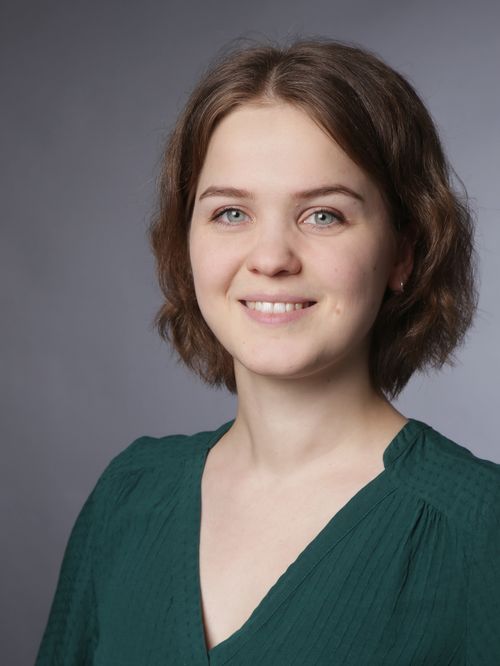
photo: private

photo: PhotoArt Manuela Hund
As the Polar Prediction Project is now in the middle of its Consolidation Phase, a lot of work has to be done in terms of coordination and communication. Therefore, two new interns recently relocated from the south of Germany to support the International Coordination Office (ICO) for Polar Prediction at the Alfred Wegener Institute in Bremerhaven.
Laura Hüßner is currently studying environmental engineering at the University of Applied Science Weihenstephan-Triesdorf in Triesdorf, close to Nuremberg, Southern Germany. In 2018, she already completed a Bachelor of Music. Laura will assist the YOPP International Coordination Office, as well as APPLICATE and ESM project until February 2021.
Daniel Butkaitis is studying Water Resources Management at the Rottenburg University of Applied Forest Science, close to Stuttgart, Germany. As a member of the non-governmental organisation “Technology without Borders“, he recently supported a project in Gambia where he already gained some practical experience within project management. Driven by his interest in science and climate change, he will assist the YOPP International Coordination Office, as well as the APPLICATE and ESM project teams in their daily business until March 2021.
15 September 2020: The Arctic Sea Ice Minimum 2020
by Daniel Butkaitis, Laura Huessner, Sara Pasqualetto and Kirstin Werner
Every year around mid-September, the sea-ice extent in the Arctic shrinks down to its annual minimum. This year, after an entire month of abnormally high melting rates, many scientists expected to see another new negative record for the sea ice minimum extent. While the diminishing trend is ongoing, it is, however, almost certain now that the 2020 sea-ice minimum will not fall below the record minimum of 2012.
Regular changes in sea-ice extent over seasons, months, weeks or even from day to day fall under what is called the natural variability. As such, around mid-March, the Arctic sea ice usually reaches its maximum, while the Antarctic sea ice reduces to its lowest extent. During mid-September, the situation is reversed. Comprehensive records on sea-ice variability in the Arctic have been rare until the late 1970s, prior to the start of satellite observations. Nowadays, satellite data build the base for many of the sea-ice prediction models. The graph shows the average September Arctic sea-ice extent since 1979.
A discernible downward trend can be noted; on average the sea-ice extent has decreased by almost 13 percent per decade. Accordingly, the temperatures in the Arctic have increased more than twice as fast as the current global average of 1,8°C, compared to pre-industrial period (1720-1800). If the ongoing trend continues, the Arctic summer ice is expected to be gone completely by 2035, a recent study published in Nature Climate Change prompts.
This year’s development of the sea ice has been particularly thrilling. In August 2020, the Arctic sea ice was experiencing rapid sea-ice loss extending into the last week of August, which made many scientists foresee another new minimum for the sea-ice extent. However, with the onset of autumn, the melting rate has slowed down in the Arctic. The upcoming week will determine if this year can break the overall record of 2012.
Daily updates on the current sea-ice status are provided on the website seaiceportal.de, maintained by the Alfred Wegener Institute in cooperation with the University of Bremen.
11 September 2020: YOPP Research Publications and Acknowledgement
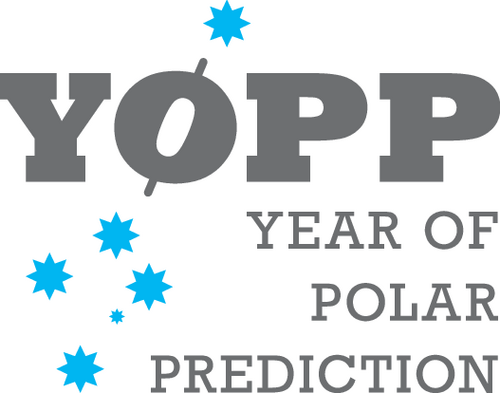
by Laura Huessner
Acknowledgement of YOPP is highly appreciated in order to help determining the success PPP and YOPP. To inform the wider community, authors of YOPP-related papers are invited to send their papers to the International Coordination Office for Polar Prediction (ICO).
In order to help determining the success of PPP and YOPP towards the end of the Consolidation Phase, the ICO kindly asks authors of YOPP-related papers to include the following statement in the acknowledgements section of their articles:
'This is a contribution to the Year of Polar Prediction (YOPP), a flagship activity of the Polar Prediction Project (PPP), initiated by the World Weather Research Programme (WWRP) of the World Meteorological Organization (WMO). We acknowledge the WMO WWRP for its role in coordinating this international research activity.'
Furthermore, please cite the following paper whenever you consider it applicable as it provides a good overview of the scientific rationale and the main components of YOPP:
Jung, T., Gordon, N.D., Bauer, P., Bromwich, D.H., Chevallier, M., Day, J.J., Dawson, J., Doblas-Reyes, F., Fairall, C., Goessling, H.F., Holland, M., Inoue, J., Iversen, T., Klebe, S., Lemke, P., Losch, M., Makshtas. A., Mills, B., Nurmi, P., Perovich, D., Reid, P., Renfrew, I.A., Smith, G., Svensson, G., Tolstykh, M., Yang, Q., 2016: Advancing Polar Prediction Capabilities on Daily to Seasonal Time Scales. Bulletin of the American Meteorological Society. doi: 10.1175/BAMS-D-14-00246.1
The ICO welcomes any information on new papers that provide contributions to YOPP, optionally including a short summary on the paper, formulated for a general audience, to potentially feature selected publications on the website or in the newsletter to inform the wider community.
Please send references of newly published papers (plus a short summary) to office@polarprediction.net.
Research publications related to polar prediction topics, and in particular resulting from the various Year of Polar Prediction efforts, are listed in chronological order under https://www.polarprediction.net/publications/research-publications/.
09 September 2020: Update - Arctic Frontiers goes Online
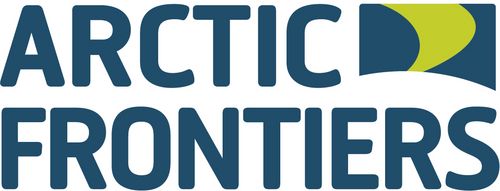
by Sara Pasqualetto
The 2021 edition of the Arctic Frontiers Science Conference will be organised in a new format. Taking into account concerns related to the spread of COVID-19, the organising committee of Arctic Frontiers decided to hold the meeting online, instead of the in-person gathering in Tromsø, Norway, on 1-4 February 2021. Amongst six different topics, a session on polar prediction is going to be part of the conference. Abstracts can still be submitted by 6 October 2020.
"While we believe now more than ever in the importance of bringing people together”, explain organizers in a note on the conference website, "we have decided to move the content of Arctic Frontiers 2021 online to ensure that no one will lose out on the Arctic Frontiers experience. So the Arctic family will meet from February 1-4 2021 in a slightly different way than what we are used to."
The abstract submission deadline has also been moved: there is now time to submit contributions until 6 October 2020. YOPP and our co-organizing partners ECCC, DKI and Met Norway are looking forward to many scientific updates for our session entitled Advanced prediction capabilities for the Arctic and beyond.
For all information and updates on the Arctic Frontiers conference visit their website or Twitter account.
03 September 2020: Arctic Change 2020 – Call for Abstracts

by Laura Huessner and Kirstin Werner
From 7 to 10 December 2020, the Arctic Change Conference 2020 will take place. While usually held as a face-to-face meeting around Canada, this year’s ArcticNet annual science meeting will be organized completely virtual. A YOPP-related session chaired by PPP-SERA members Gita Ljubicic and Jackie Dawson will be part of the program. Abstracts to contribute are due on 8 September 2020.
The Arctic is experiencing an unprecedented change. Circumpolar nations face an increased demand to enhancing their observational capacity and to better understanding Arctic processes to ensure availability of all information needed to support evidence-based policy and decision-making. Science and knowledge mobilization play a pivotal role in this process.
A major goal of the Canadian Network of Centres of Excellence (NCE) ArcticNet is to engage Inuit organizations, northern communities, universities, research institutes, industry as well as government and international agencies as partners in the scientific process and the steering of the network. What started as the first Arctic Change conference in 2008 in Québec has developed into one of the largest trans-sectoral international research conferences. The 2020 online-only meeting is the fourth Arctic Change conference to bring together the world’s foremost northern scientists to discuss the emerging global challenges and opportunities to face them.
Co-chaired by PPP–SERA members Gita Ljubicic and Jackie Dawson, the Year of Polar Prediction is participating in the Arctic Change 2020 conference with the session entitled ‘Tailoring Polar Weather, Water, Ice, and Climate Information and Services to Address Diverse User Needs’. It is the third of a series of sessions that Ljubicic and Dawson so far have organized for ArcticNet where various initiatives that tailor, translate, or adapt current weather, water, ice and climate (WWIC) information and services are invited to present how to suit the diverse user needs. This time, focus is on „Arctic or Antarctic examples and experiences with tailoring polar WWIC information and services" in a range of, amongst others, the following sectors: subsistence hunting and harvesting, fisheries, shipping, tourism or aviation.
Find more on the YOPP session here. An overview of all Topical Sessions at the Arctic Change 2020 Conference can be found at https://arcticnetmeetings.ca/ac2020/topical-sessions. Abstract submission is due on 08 September, 2020 at midnight EDT. Final decision notices will be sent to authors by Friday, September 25, 2020. For submission guidelines, go to https://arcticnetmeetings.ca/ac2020/call-abstracts.
ArcticNet Network of Centres of Excellence and partners warmly invite the global Arctic community to join the conference – from wherever you are. For further information, visit https://arcticnetmeetings.ca/ac2020/.
20 August 2020: Second International Verification Challenge – Seeking for Best New Verification Metrics
Original article from community.wmo.int/news/2nd-international-verification-challenge
The Joint Working Group of Forecast Verification Research (JWGFVR) calls for participation in the second International Verification Challenge – Seeking for the Best New Verification Metrics Making Use of Non-Traditional Observations.
Forecast verification is evolving beyond traditional metrics for basic weather variables to make use of many new sources of data to assess forecast quality. This additional information gives people greater confidence to use the forecasts in their decision making.
Research shows that impact-based forecasts and warnings are more effective than traditional weather forecasts and warnings in prompting people to take action, but we are only just starting to quantify the impact of the weather on human activities and use this information to evaluate forecasts. The advent of social media and the ease of sharing photos and other data from smart phones and home weather stations means that citizens can now contribute relevant information for assessing forecasts and warnings. Weather and climate sensitive industries also have a strong interest in measuring the utility of forecasts and warnings for their business, which means translating the forecasts into user-relevant variables (e.g. energy output, crop yield, aircraft departure rates, etc.) that can be verified against industry measurements.
To encourage the development of verification approaches making use of new sources and types of observations, the World Meteorological Organization's Joint Working Group on Forecast Verification Research (JWGFVR) is conducting a challenge to develop and demonstrate new forecast verification metrics using non-traditional observations. The contest is in support of the WWRP projects on High Impact Weather, Subseasonal to Seasonal Prediction (S2S), and Polar Prediction Project (PPP).
The challenge will consider all applications of meteorological and hydrological forecasts, deterministic and ensemble, that are relevant to the public and user sectors including operational forecasting, agriculture, energy, emergency management, transport, etc. The metrics can be quantitative scores or diagnostics (e.g., diagrams), but they must use non-traditional observations to be considered for the prize.
The JWGFVR warmly encourages all interested researchers and practitioners to participate.
Please find more information including the submission forms here.
12 August 2020: 2021 Arctic Frontiers YOPP and Partners Session – Abstract Submission Open
During the 2021 Arctic Frontiers Science Conference, the Year of Polar Prediction and partners will hold a session entitled “Advanced Prediction Capabilities for the Arctic and Beyond”. Abstracts submission is open until early September.
Since Arctic Frontiers started out in 2006, this northernmost Nordic winter conference has steadily grown to what is now ‘the event’ when it comes to a pan-Arctic forum for dialogue and exchange between science, government and industry. Escorted by beautiful northern lights, Tromsø in February is usually the place where new partnerships across nations, generations and ethnic groups are being built. And so – ‘Building Bridges’ – is the title of the 2021 Arctic Frontiers Science conference that is scheduled from 1 to 4 February 2021.
Session by YOPP and Partners
The session on ‘Advanced Prediction Capabilities for the Arctic Region and Beyond’ organized by YOPP, WMO, MET Norway, ECCC, and DMI capitalizes on and consolidates recent scientific accomplishments for advanced probabilistic climate, weather and sea-ice Arctic forecast information, tailored to key social, environmental and economic needs. Welcome are any presentations on activities and results from YOPP-endorsed projects as well as contributions from other projects that focus on Arctic environmental monitoring, prediction and services for safe and sustainable Arctic operations as well as on basic science, observations, model development and implementation. For further information on the session organized by YOPP and partners, please check the session proposal site.
Abstracts can be submitted by 8 September 2020. The abstract submission form can be found on the Arctic Frontiers website.
The Arctic Frontiers secretariat will closely monitor the situation with Covid-19 and develop an optimal technical solution and format for the conference. As of now, it will likely combine elements of a traditional in-person and digital conferences, with a possibility to participate online. Further information and updates on https://www.arcticfrontiers.com/pillar/science/
4 August 2020: Improving Weather, Water, Ice and Climate Information in the Canadian Arctic
The Canadian project Community WWIC Uses and Needs (CWWICUN) recently received YOPP Endorsement. CWWICUN looks at improving the weather, water, ice and climate information and services available to Canadian Inuit communities.
For people living in the Canadian Arctic, information on weather and ice conditions are crucial for planning their daily life and work. However, with the ongoing changes in climate and industrial development, weather, water, ice and climate (WWIC) information and services have become less unpredictable, posing a risk for Inuit and other northern residents. The CWWICUN project led by Gita Ljubicic, an Associate Professor in the School of Earth, Environment and Society at McMaster University (Hamilton, Canada), aims to better understand what Canadian Arctic communities need to inform safe travel and how the required information can be better accessed and communicated. Local research coordinators are facilitating surveys in their home communities, and responses will inform service providers and policy makers with the ultimate goal of improving WWIC information and service delivery from local to international scales. More information on CWWICUN can be found on the project‘s website.
CWWICUN and other YOPP-endorsed projects can be found at the data base https://apps3.awi.de/YPP/endorsed/projects. (kw/nm)
31 July 2020: Around-the-Clock November 2020 International Verification Method Workshop
by Barbara Casati
The WMO Joint Working Group on Forecast Verification Research (JWGFVR) is organizing the 2020 around-the-clock International Verification Methods Workshop Online (2020-IVMW-O). This virtual event intends to fill the time-gap between the 7th and 8th International Verification Methods Workshop, since the latter has been postponed due to the COVID-19 pandemic. The 2020-IVMW-O will span two weeks, from the 9th to the 13th and from the 16th to the 20th of November 2020, and will consist in 2-hour online daily sessions, with live-stream presentations and discussion.
The goal of the workshop is to discuss recent aspects of verification research and keep the research community updated on new verification practices, as applied to different types of weather forecasts and environmental predictions, on all spatial and temporal scales, from weather and sub-seasonal to seasonal and decadal, as well as for long climate projections. Participants are welcome from operational, research and forecast-user communities. The sessions will be staggered across time-zones in order to accommodate presenters from different countries around the Globe, while maintaining the verification discussion spinning around-the-clock.
The workshop will include keynote talks along with contributed presentations. Abstracts are solicited on all aspects of verification methodology. Note that the focus of abstracts and presentations should be on the methodology rather than application of the methods to specific datasets. Subjects of interest include (but are not limited to): physical process diagnostics; error tracking; spatial verification methods; verification of high impact weather and extremes; use of alternative observations; representativeness and observation uncertainty; user-oriented verification and estimation of forecast value; verification of probability and ensemble forecasts; inference and properties of verification methods; verification tools and software; verification practices in operational environment. Abstract contributions from the World Meteorological Organization’s (WMO) endorsed High Impact Weather (HIW), Polar Prediction Project (PPP) and Sub-seasonal to Seasonal prediction project (S2S) are particularly encouraged.
Abstract submission and registration open: 30 June 2020.
Abstract submission closes: 31 August 2020.
Registration closes: 30 September 2020.
Participation to the 2020-IVMW-O is only for registered attendees.
Registration is free of charge.
Find the official announcement as pdf here.
Further information are available on the 2020-IVMW-O web-site https://jwgfvr.univie.ac.at/
29 July 2020: The Fifth Episode of The IcePod – 77 Luftballons
by Kirstin Werner and Sara Pasqualetto
In episode 5 of The IcePod, the podcast about polar science and the people, atmospheric scientist and project manager of MOSAiC Anja Sommerfeld explains why she set her alarm clock to exactly 7.13 am every morning during Leg 2, what it took to prepare 77 early-morning weather balloons for their ascent, and why working with Lady Miss Piggy can be a tough job.
Here is the scary episode of the IcePod. In the fifth full episode of the IcePod, we talk to Anja Sommerfeld, atmospheric scientist and project manager of MOSAiC. During Leg 2 on board Polarstern, however, Anja had an additional role to fill: In the murderer game she happened to pick the 'wrong' ticket but fulfilled her job as a murderer brilliantly. Nobody ever suspected her, and so colleagues were rather puzzled when Anja approached to kill them, of course just by saying so.
Anja not only had an excel spreadsheet of people to murder aboard Polarstern, but is in general one of the most organized people we met so far. For her job as a project manager she makes to-do lists for everything: for today, for next week, for the long term, and, guess what, Markus Rex has his own to-do list. Over time, she consolidated her strategy and through learning-by-doing, Anja grew as a project manager together with MOSAiC.
As part of Team Atmosphere during Leg 2, Anja woke up at exactly 7.13 am every day to launch 77 early-morning weather balloons from Deck A of the research vessel (in total, there are four radiosondes launches per day on board Polarstern). Special conditions require special preparations: Because of the Arctic low temperatures, the weather balloon needed to be pampered in a bath of oil and kerosene before actually being sent up in the air.
Special guest of the expedition and Anja's highlight when working on the ice was Lady Miss Piggy. Everybody loves that big and hard-to-miss red balloon and her home, balloon town, which appears to be the prettiest place on the ice floe observatory. Preparing a flight with Miss Piggy can be a tough job though, as the drama queen is very sensitive to winds.
Find the new and all previous IcePod episodes e.g. on Spotify, Apple Podcast, Castbox (no sign-up needed) or on our website theicepodcast.home.blog
If you miss the music, find the very special playlist that Anja created on Spotify.
The episode with music is also played at https://www.medialabnord.de/radio-livestream/ (Bremerhaven) on the following dates:
Saturday, 5 September 2020, 2–4 pm CEST
For updates and other materials, check also our website: https://theicepodcast.home.blog/
---
The IcePod is the podcast about polar science and the people. We’ll talk to scientists who went on board Polarstern, the German research icebreaker, for the biggest research expedition in the Arctic. It is produced in collaboration with the Alfred Wegener Institute and Radio Weser.TV where the full episode with music will be played at www.medialabnord.de/radio-livestream/. For dates check back with polarprediction@gmail.com.
Editorial responsibility: Kirstin Werner and Sara Pasqualetto
28 July 2020: Summer 2020 PolarPredictNews Issue Out Now
The summer 2020 issue of PolarPredictNews, the newsletter for the Year of Polar Prediction, is now available with updates and news from the polar prediction community, and with the beautiful watercolour drawings by sea-ice scientist Amy MacFarlane.
For the 15th issue of PolarPredictNews, the YOPP Coordination Office has done some research about how the COVID-19 pandemic has impacted the polar prediction community so far, what is expected for the coming polar field seasons and how the German Weather Service took immediate action to compensate for the loss of airborne observations caused by the reduced commercial air traffic that came with the pandemic.
Fostering Creativity for Networking and Exchange
But the pandemic may also introduce new habits and foster creativity among the science community. “In some cases, the new way of networking might even be an advantage, with new collaborations between far-apart colleagues being established and online conferences being much more accessible to everyone”, says Helge Goessling, former director of the YOPP Coordination Office and climate scientist at the Alfred Wegener Institute. New options how to organize exciting meetings to provide networking and exchange are explored these days; among them is the upcoming APECS Southern Hemisphere Workshop where YOPP runs an entire session plus a live broadcast of the YOPP podcast The IcePod. Abstracts can already be submitted to the 2021 Arctic Frontiers Science Conference from 1 to 2 February 2021 – expected to probably come as a hybrid meeting with face-to-face and online sessions – where YOPP with partners organizes another session, entitled Advanced Prediction Capability for the Arctic and Beyond
Contributions from the Community
Benefits of a new multi-layer snow scheme that is being implemented into the ECMWF weather forecast and scheduled to become operational within the next upgrade. Highlighted in the new issue of PolarPredictNews is also a recent study on seamless sea-ice prediction.
Further, two more YOPP Special Issues are now available, one on the progress being made in Antarctic meteorology and climate, and another one on the Societal Value of Improved Forecasting. As well, two new contributions to Polar Prediction Matters, the dialogue platform between users and providers of forecast, have been published. And make sure you don't miss the interview with the German meteorologist and PI of the YOPP-endorsed project DACAPO-PESO.
YOPP Endorsement Continues
For those of you currently submitting – or considering to submit – new research proposals: YOPP Endorsement is still available for projects, initiatives and institutions and will be until the end of 2021. We have now also introduced what we call a ‘blind’ YOPP-endorsement process for competitive funding situations.
The PolarPredictNews #15 Art-and-Science Project
As a special treat, PolarPredictNews #15 features beautiful watercolour cartoons drawn by sea-ice scientist Amy MacFarlane during MOSAiC leg 3. Find the drawings across the issue with the full drawing in the middle – you may want to print it as a poster to decorate your (home) office walls.
Get your issue of PolarPredictNews #15 as a pdf to read on the screen, or take out your prints to the lake to enjoy it with a summer drink – whatever way you choose: enjoy reading! (kw)
27 July 2020: New Contribution to Polar Prediction Matters – Ice and Weather Forecast Software Onboard Merchant Vessels
by Thomas Viguier and Kirstin Werner
A new contribution to Polar Prediction Matters – the Helmholtz dialogue platform for users and providers of forecast in the polar regions – is now published by Thomas Viguier. As an expert in Arctic shipping and maritime industries, he provides insights on why it is so important to have accurate ice and weather predictions on board and what challenges the currently available forecast software on the bridge are facing.
Shipping in polar regions is challenged by extreme ice and weather conditions. Over the past years, electronic ice and weather forecast software has been introduced and is nowadays the preferred tool for navigation from the bridge. It not only provides information about the current weather and ice situation but displays forecasts to support officers in their decision-making process. Focused on the interactions between the final users and the software application, Thomas Viguier explains the concept, benefits and challenges of the Integrated Bridge System (IBS). "In the IBS approach, there is a clear tendency in making data more accessible through software applications to maritime and shipping professionals, aiming to reduce risk related to navigation in polar regions." Yet, often the available software to display weather and ice forecasts appears complex, lacking user-friendliness. Involving maritime end users to develop future on board systems will be crucial to rapidly integrate new tools for successful use by the shipping industry.
Find the entire article here.
23 July 2020: YOPP Endorsement Open until 2021
by Kirstin Werner, Thomas Jung and Jeff Wilson
Projects, initiatives and institutions that contribute to the aims of the Year of Polar Prediction are invited to request YOPP endorsement until the end of 2021. A ‘blind’ YOPP-endorsement process is now also available on request for competitive funding situations.
Projects, initiatives and institutions that contribute to the aims of the Year of Polar Prediction are invited to request YOPP endorsement until the end of 2021. A ‘blind’ YOPP-endorsement process is now also available on request for competitive funding situations. The Polar Prediction Project (PPP) and its flagship Year of Polar Prediction (YOPP) initiative provide a unique collaboration and coordination opportunity for researchers involved in increasing the understanding and improvement of polar environmental prediction. Projects, initiatives and institutions may seek endorsement from the PPP Steering Group. Benefits of YOPP endorsement include increased visibility of research activities (e.g., listing on the PPP website, featuring in PolarPredictNews newsletter); an international framework for research to help leverage support and funding; improved coordination between different activities; and enhanced networking and communication within the PPP/YOPP community. The opportunity for receiving YOPP endorsement has been extended until the end of 2021.
Blind YOPP Endorsement
A blind YOPP endorsement process has now been introduced. This new mechanism will allow people to request YOPP endorsement for competitive projects for which a funding decision is still outstanding. As for the regular YOPP endorsement, activities that request blind endorsement will receive a YOPP endorsement letter. However, in order to treat certain activities more confidential, they will not be listed on the YOPP-endorsement page until funding is secured. Through the blind YOPP endorsement, it is also possible to preclude particular reviewers.
Institutional Endorsement
Institutional YOPP endorsement is also still available. Research institutes and operational forecasting centers whose activities contribute to the success of YOPP are invited to request institutional YOPP endorsement. This differs from the project YOPP endorsement in the way that it addresses general contributions to improving polar predictive skill rather than individual academic projects or programmes often sponsored through third-party funding. With the institutional endorsement, the PPP Steering Group provides the possibility for research consortia such as operational weather forecasting centres and academic institutions to link with the Year of Polar Prediction.
Further information can be found https://www.polarprediction.net/key-yopp-activities/yopp-endorsement/ or via email to office@polarprediction.net
14 July 2020: YOPP at APECS Workshop “Antarctic Science: Global Connections”
by Clare Eayrs
YOPP in the Southern Hemisphere (YOPP-SH) researchers will be contributing to an APECS Online Workshop “Antarctic Science: Global Connections” taking place alongside the online events for the cancelled Scientific Committee on Antarctic Research biennial Open Science Conference and Delegates Meeting (SCARCOMNAP2020). A live session of the YOPP Podcast The IcePod will be broadcasted on 11 August, 10:30 GMT.
The workshop aims to bring together polar Early Career Researchers (ECRs) from around the globe to network, engage with topics presented at the workshop through a series of plenary and workshop sessions, and to potentially develop new research ideas and collaborations to take forward into their careers in the future.
YOPP Session (11 August 15:00 GMT)
The YOPP-SH session on 11th August at 15:00 GMT offers an overview of some of the key activities associated with the YOPP in the Southern Hemisphere (YOPP-SH) efforts. The presenters will introduce a variety of YOPP-SH activities and provide an opportunity for ECRs to find out how they can use weather and ice forecasts for their research, what kind of meteorological data are available, and ways to contribute to YOPP and PPP.
1. YOPP-SH Overview: David Bromwich, the YOPP-SH Task Team leader, will kick-off the session with an overview of YOPP-SH and the Polar Prediction Project.
2. YOPP Communications: Sara Pasqualetto will describe how the International Coordination Office works together with the participating members of the Polar Prediction Project and other international programs to disseminate Polar Prediction stories and activities.
3. SIPN South: François Massonnet will provide an update on sea-ice prediction in the Southern Ocean and how realistic prediction exercises are being aligned with YOPP’s Special Observing Periods. François leads the Sea Ice Prediction Network South (SIPN South) initiative.
4. ANTCLIMNOW: Tom Bracegirdle will describe a new group, the Near-term Variability and Prediction of the Antarctic Climate System (ANTCLIMNOW) that aims to answer fundamental science questions (as identified by the SCAR Horizon Scan), relating to Antarctic Climate variability.
5. Antarctic AWS system: Taylor Norton, Sophie Orendorf, and Matthew Lazzara will report on the annual activities and status of the Antarctic Meteorological Research Center (AMRC), Automatic Weather Station (AWS), and Antarctic Mesoscale Prediction System (AMPS) and how these contribute to the YOPP Special Observing Period in the Southern Hemisphere.
6. Gone with the Wind – Providing Forecasts to the Polar Windsled Expeditions: Sergi Gonzalez will describe the atmospheric observations taken across the data-poor Antarctic Plateau using a zero-emissions Windsled, and how weather guidance was used to plan and develop the expedition
7. ASPeCT observations: Marilyn Raphael will describe the ASPeCT sea-ice program and how this program complements and contributes to YOPP and other international science programs.
8. YOPP Data Portal: Siri Jodha Khalsa will close the session with an introduction to the YOPP Data Portal and information on how to link and access data sets collected across the YOPP projects.
Link to connect to the YOPP-SH session:
YOPP Session (15:00 - 18:00 GMT) - Zoom Link: Zoom Link: https://us02web.zoom.us/webinar/register/WN_eUwd4tSITA-zv5ePd6jRhg
Live Session of The IcePod (11 August, 10:30 GMT)
In addition, Kirstin Werner and Sara Pasqualetto from the YOPP International Coordination Office will interview Vicki Heinrich, a psychology PhD candidate at the University of Tasmania, Hobart, Australia, in a live broadcast of The IcePod on 11th August at 10:30 GMT.
Through surveys, interviews and experiments, Vicki’s PhD project examines how, when, and why people use weather and climate information in Antarctica and the sub-Antarctic. Vicki is interested in how we may apply metacognition, social, and behavioural theories to better understand people’s weather-related risk perception and decision-making and ultimately assist people in making safer weather decisions. This research is endorsed by YOPP (find on Facebook @UWCIAntarctica).
Further details on the schedule, a list of presenters, and information on how to register for the event will be available on the APECS website soon.
Link to connect to The IcePod Live Session:
YOPP IcePod Session (10:30 - 11:30 GMT) - Zoom Link: https://us02web.zoom.us/webinar/register/WN_hO4G0jwyR2aL5SjaUYpF2Q
10 July 2020: Registration Open for SCAR 2020 Online
Registration is now open for the SCAR 2020 Online Conference that will take place from 3 to 7 August 2020.
SCAR stands for the Scientific Committee on Antarctic Research. SCAR’s Open Science Conferences have been a focal point for the Antarctic research community for over fifteen years. Through SCAR 2020 Online many of the science highlights that were originally planned to be displayed at the Hobart OSC, which was sadly cancelled due to the COVID-19 pandemic, are now going to be presented in a virtual gathering of the Antarctic research community.
Registration is free and open to everybody so it will indeed be a great opportunity to learn about what’s going on in Antarctic research and maybe even do some virtual networking with colleagues. At the same time, you can enjoy some ‘hygge’ time following the conference from your comfy-cozy sofa or garden chair.
All the activities of SCAR 2020 Online will take place via the OnAIR event portal. To join you will need to register here. Once you have registered you will receive a confirmation email. Your login details for the OnAIR portal will be sent to you on July 20. If you register after July 20, login details will be sent to you immediately upon registering. If you do not receive your login email, please first check your Junk inbox, before contacting brittany@laevents.com.au.
More information at https://www.scar2020.org/
9 July 2020: YOPP Sea Ice Experts: Farewell and Welcome
by Kirstin Werner and Helge Goessling
For over eight years, Greg Smith has supported the Polar Prediction Project with his knowledge and expertise to move forward capabilities in sea-ice prediction. Moving on to other duties within Environment and Climate Change Canada (ECCC), he recently decided to step down from the PPP Steering Group. His co-lead in the YOPP Sea Ice Task Team is taken over by Amy Solomon from the University of Colorado and the U.S. National Oceanic and Atmospheric Administration (NOAA).
As a research scientist in ECCC’s Environmental Numerical Prediction Research department, Greg Smith was ideally suited to provide his profound expertise on high-resolution ice-ocean modelling and forecasting to the PPP Steering Group. In collaboration with the Canadian Ice Service, he has helped much in fostering the transfer of new model sea-ice forecast products into operations. Due to new duties within ECCC, Greg Smith has now stepped down from PPP SG as well as from co-leading the YOPP Task Team on ‘Sea Ice Prediction and Verification’.
For the remainder of the Polar Prediction Project until end of 2022, Amy Solomon will lead the task team together with Helge Goessling from the German Alfred Wegener Institute. Amy is a senior research scientist at the Cooperative Institute for Research in the Environmental Sciences (CIRES) at the University of Colorado in Boulder, CO and the NOAA Earth System Research Laboratory (ESRL). Her interest is in Arctic short-term forecasting, meteorology and climate, with a special focus on cloud properties and processes and interactions of clouds with the boundary layer and surface.
The PPP Steering Group and International Coordination Office are grateful for Greg’s invaluable contributions to move forward various PPP and YOPP activities and thank him for his continuous support to improve Arctic predictions. Fortunately, Greg will continue his activities in another Task Team that currently prepares the YOPP Final Summit taking place from 2 to 5 May 2022 in Montréal, Canada.
A warm welcome to Amy Solomon, who has been part of the PPP community for a long time and brings broad and deep knowledge and experience to the Sea Ice Task Team. We are very much looking forward to working with her on polar prediction science.
8 July 2020: Call for Community Input – COVID-19 Impacts on Arctic and Antarctic Operations and Research within Weather and Sea Ice Forecasts
by Kirstin Werner
We invite the polar prediction community to contribute to a survey in order to better understand what the impacts that the COVID-19 pandemic so far had, and are expected to have, on Arctic and Antarctic Operations and Research within Weather and Sea Ice Forecasts.
A survey has been created in order to better understand what the impacts that the COVID-19 pandemic so far had, and are expected to have, to the community working within the field of weather and sea ice forecasts in the polar regions. Answers to the survey will be used for a newsletter article in PolarPredictNews https://www.polarprediction.net/news/polarpredictnews/
The survey can be found at forms.gle/PP6bgJQPN7eyDGtv9
We appreciate your input. Questions and further input can be sent to office@polarprediction.net
7 July 2020: Special Issue on the Societal Value of Improved Forecasting
The academic journal Polar Geography has just published a special issue ‘Societal Value of Improved Forecasting’ that compiles a range of papers detailing work that has been undertaken in conjunction with the PPP’s Societal and Economic Research and Applications (PPP-SERA) Task Team.
PPP-SERA championed this special issue as a community-building effort that also aims at reaching out to stakeholders world-wide. The publications featured in this special issue showcase research results and perspectives on “the use and potential improvement of WWIC [weather, water, ice and climate] services for the polar regions in an effort to translate scientific and technological advances into societal value” (Lamers & Liggett, 2020). The authors examine the multiple and complex ways of producing and using WWIC information in the polar regions and shed light on who is involved in this process, what their information needs are, what kind of information systems and infrastructures are being utilized, how data is being managed and how WWIC services are funded. To this end, regional case studies are included in this special issue and highlight how diverse the WWIC ‘actorscape’ is, and what current capabilities and constraints frame WWIC information provision and use.
There is increasing erosion of the duality of WWIC information users vs. providers and an increase in users also producing weather and climate information and vice versa. This development seems to go hand in hand with a move away from nation states and the public sector as the main providers of WWIC service towards a more prominent role for the private sector in this space. Overall, the articles in this special issue address some important questions regarding the use of WWIC and user needs as well as provider priorities, but they also raise further questions that serve as a timely reminder that further work is needed on the effects shifts in the WWIC actorscape, infrastructure and funding landscape have for the continued and reliable provision of WWIC services, ideally with the aim of reducing risks and improving operational (and environmental) health and safety in the polar regions.
The Special Issue in Polar Geography, Volume 43 (2–3), 2020 can be found here.
30 June 2020: A Virtual AGU Fall Meeting – Abstract Submission Open
Abstracts can now be submitted to this year’s AGU Fall Meeting which will mostly be a virtual event to be held from 7 to 11 December 2020.
Meeting organizers state on their website that even though mostly virtual, the AGU Fall Meeting 2020 “remains the global convening meeting for the Earth and space sciences community”. Featured meeting content will be held during the original 7-11 December dates, with additional content scheduled to best meet the needs of international attendees around the world. Content will include real-time sessions, networking opportunities and poster hall time. As a special offer, there will be recorded sessions that can be watched, or even ‘binge-watched’, at anyone’s convenient time. Convergent themes including global science policy, data, natural hazards and climate science will be prominently featured.
There are quite a number of sessions that are relevant to the Year of Polar Prediction. Among them is the session “Integrating Observations and Models to Better Understand a Changing Arctic System” that welcomes presentations on activities that combine models and observations to enhance the understanding of the changing Arctic system. Organizers of the session “Coupled-system Processes of the Central Arctic Atmosphere-Sea Ice-Ocean System: Harnessing Field Observations and Advancing Models” encourages abstract submissions that incorporate cross-disciplinary research topics, interseasonal linkages, and/or combined observing-modeling syntheses, with contributions from recent central Arctic field campaigns like MOSAiC being particularly relevant. The session on “Atmosphere and Cryosphere Coupling in the Arctic: Observations, Modeling, and Implications for Future Arctic Changes” will give the community a timely opportunity to review the current understandings and challenges ahead for advancing our knowledge about the Arctic energy cycle and climate change.
A list of further sessions relevant to YOPP/PPP can be found here.
To submit an abstract, you need to be an AGU member. A non-refundable abstract processing fee will be charged, which is separate from the registration fee, this year reduced about 50 per cent from the usual in-person fee, with in particular lowered rates for graduate students.
Abstracts can be submitted until 29 July 2020 at the following link: https://www.agu.org/Fall-Meeting/2020/Present/Abstracts
25 June 2020: The IcePod with PPP Captain Thomas Jung
In the second bonus episode of the IcePod on the Targeted Observing Periods, we speak with Thomas Jung, captain and structured mind behind YOPP and PPP.
Here is the second episode on the YOPP Targeted Observing Periods, or TOPs. This time, we speak to Thomas Jung, head of the section Climate Dynamics at the German Alfred Wegener Institute and professor for Physics of the Climate System at the University of Bremen. Even more important, as the chair of the Polar Prediction Project's Steering Group, he is the captain and structured mind behind YOPP and PPP.
His ability to chair a meeting even with fever from his bed not only provides him with all the skills needed to steer the Polar Prediction Project during a pandemic, but has been the ultimate test of his leadership skills. Keeping a healthy balance between management and science is probably his secret to success, in addition to creating extensive but ultrapractical mind maps and building an international network across the academic community and forecasting experts.
Thomas has also been the winner of our YOPP TOP Twitter challenge. How did he overcome the jumpiness of forecast? Here, he unveils his secret: Well, it's just like planning your next barbecue weekend (something we all look forward to during this COVID-19 summer).
Take your time between an ice cream and a cold drink and listen to this episode for a look behind the scenes of YOPP, how the project came to life and how it still surprises its master of mind maps and virtual meetings.
Find the new and all previous IcePod episodes e.g. on Spotify, Apple Podcast, Castbox (no sign-up needed) or on our website theicepodcast.home.blog
Editorial responsibility: Kirstin Werner and Sara Pasqualetto
---
The IcePod is the podcast about polar science and the people. We’ll talk to scientists who went on board Polarstern, the German research icebreaker, for the biggest research expedition in the Arctic. It is produced in collaboration with the Alfred Wegener Institute and Radio Weser.TV. The IcePod is the official podcast of the Year of Polar Prediction www.polarprediction.com
16 June 2020: New Podcast Episode – Gunilla Svensson on The IcePod
A new bonus episode of the IcePod, the podcast for the Year of Polar Prediction, is now on air. In this episode, we talk with the meteorology professor Gunilla Svensson about the YOPP Targeted Observing Periods, the process-based model evaluation project YOPPSiteMIP and why MOSAiC is a paradise for every Arctic Scientist.
Gunilla Svensson is a meteorology professor at Stockholm University, Sweden. She is also member of the Polar Prediction Project's Steering Group and leads the YOPP Processes Task Team. Within her role, she coordinates the YOPPSiteMIP project and the currently ongoing YOPP Targeted Observing Periods, or TOPs, aligned with MOSAiC. Wait a minute – what is YOPPSiteMIP? And what is a Targeted Observing Period? Well, listen to the new bonus episode of the IcePod where we speak with Gunilla about one of the key activities for the Year of Polar Prediction.
In our first episode of what we call the TOP series of the IcePod, Gunilla explains not only what these pan-Arctic campaigns of enhanced observations are meant for. She also talks about how the TOP studies of warm air intrusions from the mid-latitudes to the central Arctic are impacted by COVID-19. And: why Polarstern's current location in the Arctic is a paradise for every Arctic scientist.
Observations are just one part of the puzzle, and so is modelling. But blending the two allows to see the bigger picture. This is done within the YOPP Supersite Model Intercomparison activity – which is a long title so we just call it YOPPSiteMIP. Here, atmospheric and sea ice data from across the Arctic including MOSAiC, and respective modelling output are currently simultaneously examined.
Find the new and all previous IcePod episodes e.g. on Spotify, Apple Podcast, Castbox (no sign-up needed) or on our website theicepodcast.home.blog
Editorial responsibility: Kirstin Werner and Sara Pasqualetto
---
The IcePod is the podcast about polar science and the people. We’ll talk to scientists who went on board Polarstern, the German research icebreaker, for the biggest research expedition in the Arctic. It is produced in collaboration with the Alfred Wegener Institute and Radio Weser.TV. The IcePod is the official podcast of the Year of Polar Prediction www.polarprediction.com
09 June 2020: 2021 Arctic Frontiers – Building Bridges on Arctic Weather and Climate Prediction
During the 2021 Arctic Frontiers Science Conference, the Year of Polar Prediction and partners will hold a session entitled “Advanced Prediction Capabilities for the Arctic and Beyond”.
Since Arctic Frontiers started out in 2006, this northernmost Nordic winter conference has steadily grown to what is now ‘the event’ when it comes to a pan-Arctic forum for dialogue and exchange between science, government and industry. Escorted by beautiful northern lights, Tromsø in February is usually the place where new partnerships across nations, generations and ethnic groups are being built. And so – ‘Building Bridges’ – is the title of the 2021 Arctic Frontiers Science conference that is scheduled from 1 to 4 February 2021.
Session by YOPP and Partners
The session on ‘Advanced Prediction Capabilities for the Arctic Region and Beyond’ organized by YOPP, WMO, MET Norway, ECCC, and DMI capitalizes on and consolidates recent scientific accomplishments for advanced probabilistic climate, weather and sea-ice Arctic forecast information, tailored to key social, environmental and economic needs. Welcome are any presentations on activities and results from YOPP-endorsed projects as well as contributions from other projects that focus on Arctic environmental monitoring, prediction and services for safe and sustainable Arctic operations as well as on basic science, observations, model development and implementation. For further information on the session organized by YOPP and partners, please check the session proposal site.
The abstract submission form will be activated in late June 2020 on the Arctic Frontiers website. The Arctic Frontiers secretariat will closely monitor the situation with Covid-19 and develop an optimal technical solution and format for the conference. As of now, it will likely combine elements of a traditional in-person and digital conferences, with a possibility to participate online. Further information and updates on https://www.arcticfrontiers.com/pillar/science/
27 May 2020: Call for Abstracts – 10th International Workshop on Sea Ice Modelling, Assimilation, Observations, Predictions and Verification
by IICWG-DA
The 10th International Workshop on Sea Ice Modelling, Assimilation, Observations, Predictions and Verification will be held from 20 to 22 October 2020 in Toulouse, France, and Montréal, Canada, simultaneously. The workshop is supported by the Year of Polar Prediction.
This workshop aims to build on a series of successful workshops by the IICWG Data Assimilation Working Group to advance international capabilities for sea-ice prediction on timescales from hours to a season. Cross-cutting issues in sea-ice modelling and assimilation and how deficiencies of current systems can be more efficiently diagnosed and addressed will be discussed.General topics considered appropriate for this workshop include:
• Sea ice observations and uncertainties;
• Sea ice data assimilation (methods and results);
• Sea ice model parameterizations and coupling to ocean and atmosphere models;
• Verification approaches for sea-ice analyses and forecasts;
• Recent research to sea ice operation transfer;
• Automated predictions systems.
The workshop is jointly organized by the International Ice Charting Working Group (IICWG), the Copernicus Marine Environment Monitoring Service (CMEMS), OceanPredict (former GODAE OceanView, GOV) and the Coordination & Support Action KEPLER by the European Commission. It will be arranged around a few keynote and contributed presentations with ample time for discussion. As the number of participants is limited, a short abstract (or motivation for attending) is requested in the registration form. Attendees are encouraged to make a contribution, in the form of an oral or poster presentation.
For this 10th event, the workshop will be held in Toulouse and Montréal simultaneously via video conferences facilities. Participants are asked to mention in which place they will physically attend the workshop.
Registration is open until 15 June 2020 at the following link:
https://marinecopernicus.typeform.com/to/i3ufps
21 May 2020: Risks and Reward – New Polar Prediction Matters Contribution on Greenland Ice Sheet Melting

In her new contribution to Polar Prediction Matters, Jennifer Ross writes: "Icebergs have been of public interest since the sinking of the RMS Titanic in 1912, off the coast of Newfoundland, Canada. While few ships sink from collisions with icebergs in this region nowadays, due mainly to daily forecasts of iceberg activity, icebergs still pose a direct risk to shipping and stationary platforms in the North-West Atlantic." (Photo: Darrel Swift, University of Sheffield)
by Kirstin Werner and Anastasia Maksimova
A new contribution to Polar Prediction Matters – the dialogue platform for users and providers of forecast in the polar regions – is now available. In her article, PhD student Jennifer Ross from the University of Sheffield summarizes on the risks of the currently ongoing Greenland ice sheet melting, and the rewards to reliably predict and prevent harmful conditions.
Today, the Earth’s ice sheets are constantly losing mass because of climate change. With about 79 % ice-covered surface, Greenland has the second-largest ice sheet worldwide, after Antarctica. Ongoing melting of the Greenland Ice Sheet strongly affects the Atlantic and Arctic oceans, through sea-level rise and iceberg release. This not only causes the global ocean circulation to destabilize, but the water masses and numbers of icebergs released into the sea also bear a number of risks for human and environment.
In this new contribution to Polar Prediction Matters, Jennifer Ross describes the risks of sea-level rise and iceberg abundance in the Nordic Seas caused by the ongoing Greenland Ice Sheet melt. While there are fluctuations between seasons, the general trend of increased numbers of icebergs and meltwater input over the years is likely to further rise. There is thus a need to better understand and predict the risks that are associated with both, enhanced flooding and potential impacts to coastal areas, as well as hazards for ships and offshore platforms in the open ocean. To reliably forecast risks and thus help prevent hazards in the open ocean will be most rewarding to scientists and forecasters able to support environmentally safe operations in the northern regions.
Find the full article here.
About Polar Prediction Matters
Polar Prediction Matters is a non-peer reviewed forum initiated as a means to foster the dialogue between those that research, develop, and provide polar environmental forecasts and those that use (or could use) polar environmental forecasts to guide socio-economic decisions. It is hosted by the Helmholtz Association of German Research Center's blog portal and maintained by the International Coordination Office for Polar Prediction at the German Alfred Wegener Institute.
18 May 2020: Sharing Geoscience Online – Joint YOPP-APPLICATE Session at EGU2020
by Kirstin Werner
In response to the COVID-19 pandemic, a joint YOPP-APPLICATE live text chat took place on 8 May 2020, as part of this year’s European Geosciences Union (EGU) General Assembly #shareEGU20 online experiment.
Europe’s largest and most prominent geosciences conference, the EGU General Assembly, had to explore new grounds this year. Due to the COVID-19 pandemic, the Vienna happening which usually attracts more than 16,000 scientists from all over the globe had to be moved online. A week-long series of live text chats, closely aligned to the originally planned physical science sessions, symposia, debates and Townhall events, was held from 4 to 8 May 2020.
Joint YOPP-APPLICATE Session
To exchange knowledge and share results, a joint YOPP-APPLICATE session “Exploiting Polar Observations to Improve Weather and Climate Predictions" was scheduled in the form of a #stayathome live chat on 8 May 2020. Presenters had the chance to upload their material two weeks prior to the event to give the community a chance to look at in preparation of the chat. The live text exchange was organized by Luisa Cristini, APPLICATE project manager and convener of the session, in the way that three presenters at a time were asked to provide main outcomes of their research in the chat window. Followers of the chat could then type their questions and remarks. 14 out of 17 presenters were available for the discussions with, in total, more than sixty people following the session. Presentations resembled a manifold mixture of activities and scientific results from the YOPP and APPLICATE projects, in addition to contributions from other projects and institutes, with a focus on how to best capitalize on existing and additional Arctic and Antarctic observations to improve forecast initial states, verification, and model physics, and to optimize the future polar observing system.
Silent but Busy
Compared to the usual noise level, it was a silent EGU2020 this year – except one would turn on the radio while actively discussing or shyly following the soundless text chat conversation. Nevertheless, according to the EGU2020’s website, the experimental format turned out to be a great success throughout the week, with more than 18,000 abstracts presented in about 700 scientific sessions. 26,219 individual users joined the 721 live text chats and posted 200,400 messages. The EGU Programme Committee and the organizing team are more than satisfied: “We are very grateful and proud to see how our community has turned the challenges of the pandemic into opportunities and we are sure that part of these achievements will continue and contribute to greener events in the future.“
The material of the YOPP-APPLICATE session can still be viewed and downloaded at https://meetingorganizer.copernicus.org/EGU2020/session/36745
14 May 2020: Bonus Episode of the IcePod – Markus Rex about MOSAiC Leg 1
by Kirstin Werner and Sara Pasqualetto
In the new bonus episode of the IcePod, MOSAiC coordinator Markus Rex talks about his experiences and impressions during Leg 1 of the ever largest expedition in the Arctic.
When the world still has been in order and people were allowed to hang out in cosy offices, Kirstin Werner and Sara Pasqualetto met with Markus Rex, leader of the MOSAiC ice drift, who came to Bremerhaven for two days in February to join the YOPP Science Workshop at the Alfred Wegener Institute.
Markus Rex is one of those people who always manage to sleep well, even when the stress level is high. In his interview with the YOPP International Coordination Office, he talks about the greatest challenges, nicest moments and biggest surprises during Leg 1 of the MOSAiC expedition. Luckily, coordinating MOSAiC means not only work to him: Finding those rare moments of solitude skiing on the ice floe, with the full moon enlightening the out-of-the-world Arctic landscape, gives him reward and energy. At the moment, Markus is preparing for his return to the Arctic with Leg 4. As excited as he is to see the ice camp in daylight, we wonder: Will he be able to sleep even during polar day?
Find the new and all previous IcePod episodes e.g. on Spotify, Apple Podcast, Castbox (no sign-up needed) or on our website theicepodcast.home.blog
Editorial responsibility: Kirstin Werner and Sara Pasqualetto
---
The IcePod is the podcast about polar science and the people. We’ll talk to scientists who went on board Polarstern, the German research icebreaker, for the biggest research expedition in the Arctic. It is produced in collaboration with the Alfred Wegener Institute and Radio Weser.TV. The IcePod is the official podcast of the Year of Polar Prediction www.polarprediction.com
11 May 2020: Third Coordinated Sea-Ice Forecast Experiment in the Southern Ocean
by François Massonnet/UC Louvain
The Sea Ice Prediction Network South (SIPN South) just issued its third post-season report evaluating forecasts of sea ice conditions around Antarctica for the austral sea ice minimum season 2019/2020.
Operations in the Southern Ocean are intensifying, both as a result of increased scientific interest for this remote region and a growing interest from stakeholders. Navigating Antarctic waters is not without risk though. The presence of sea ice, even in summer months, can hinder the progression of vessels and, in the worst case, become a real danger. In recent years, the study of sea ice predictability in the Southern Ocean has progressed and several potential mechanisms have been identified that bear promise for skillful predictions.
SIPN South (https://fmassonn.github.io/sipn-south.github.io/) is an international initiative endorsed by the Year Of Polar Prediction (YOPP), that aims at coordinating realistic seasonal summer sea ice forecasts in the Southern Ocean. SIPN South has just issued its third post-season report evaluating forecasts submitted in lated November 2019 and targeting the three-month period December 2019-February 2020 (report available here). One of the key findings, already hinted at last year, is that forecasts based on statistical approaches seem more skillful than forecasts based on fully coupled dynamical models. This indicates a large potential for improvement in our physical understanding of the Southern Ocean sea ice using process-based models. Key regions like the Ross Sea appear to be intrinsically difficult to predict and strongly influenced by unpredictable weather events.
SIPN South will continue to collect forecast for the coming years, including for the winter YOPP-SH Special Observing Period that is scheduled for mid-April to mid-June 2022.
07 May 2020: New Sea Ice and Ocean Variables in S2S Forecast Database
by Lorenzo Zampieri, Alfred Wegener Institute and European Centre for Medium-Range Weather Forecasts
In Phase II of the Subseasonal-to-Seasonal (S2S) Prediction Project, nine new ocean and sea-ice variables have been introduced to its database. Most of the S2S forecast systems now feature dynamical ice models and assimilate sea-ice and ocean observations.
The Subseasonal-to-Seasonal (S2S) Prediction Project is an initiative endorsed by the World Meteorological Organization (WMO) that aims to improve our understanding of the Earth system predictability at the S2S timescale from 15 to 60 days into the future, with special emphasis on high-impact weather events. The main outcome of this project is the implementation of a database that collects forecasts from several Numerical Weather Prediction (NWP) centers and research institutions all over the world. These forecasts are produced with state-of-the-art probabilistic fully-coupled forecast models, meaning that the atmosphere, ocean, and sea-ice model components interact and allow to simulate the complex feedbacks in the Earth system. Furthermore, these models are run multiple times from slightly different initial conditions, generating an ensemble of forecasts that takes into account the uncertainties of observations, physical parameterizations in the model, and the Earth system‘s chaotic nature. The S2S forecasts are available for an overall period of almost three decades, allowing us to draw robust conclusions and to develop a deep understanding of the system. There are many beneficial aspects for the Polar Prediction community to explore the S2S database and to benefit from such a well-structured initiative. Firstly, there are good reasons to believe that the evolution of the sea ice, polar oceans, and snow on land could be predictable at the S2S timescale. Secondly, the description of the polar climate in the S2S forecast systems has grown in complexity since the start of the S2S initiative in November 2013. Most of the forecast systems now feature dynamical ice models and assimilate sea-ice and ocean observations. And finally, the focus of Phase II of the S2S Prediction Project has been broadened beyond the atmospheric domain, with the introduction of nine new ocean and sea-ice variables to the database.
These include:
• Depth of 20°C isotherm;
• Mean sea-level practical salinity in the upper 300 meters;
• Mean sea-level potential temperature in the upper 300 meters;
• Ocean mixed-layer thickness defined by sigma theta 0.01 kg/m3;
• U-component of surface current;
• V-component of surface current;
• Sea-ice thickness;
• Sea-surface height;
• Sea-surface practical salinity.
Since 1 January 2020, these new variables are archived in the S2S database in the GRIB2 format on a 1-degree latitude/longitude grid, they are openly available and ready to be investigated by the scientific community. “The new variables will help researchers to explore the predictability of ocean and sea-ice conditions and to compare the representation of air, ocean and sea-ice interactions in different models,” says Frederic Vitart, ECMWF scientist and co-chair of the S2S Prediction Project. Such additional information will increase our ability to understand and possibly correct the biases in models that so far limit the forecast skills in polar regions. At the same time, it casts light on still unknown or poorly understood predictability mechanisms, especially in polar regions. The implementation of the new ocean and sea-ice variables is thus an encouraging example of how the interaction between the S2S and the Polar Prediction communities improves our comprehension of the polar weather and climate. Additional information can be found on the S2S Prediction Project and ECMWF websites.
30 April 2020: PolarPredictNews #14 – Restyled!
PolarPredictNews come in new design and style! The 14th issue of the Year of Polar Prediction newsletter provides latest updates on activities within the polar prediction community and features an art-and-science project that evolved from the MOSAiC expedition.
Of course, the MOSAiC one-year ice drift is - once again – focus also in this new issue of PolarPredictNews: Scientists shed light on how the drift of RV Polarstern during the MOSAiC expedition is continuously being forecasted in SIDFEx (p. 5). The MOSAiC Near-Real-Time Verification invites further contributions to evaluate the skill of short-term forecasts with MOSAiC observations as part of the YOPPSiteMIP activity (p. 9). During spring and summer this year, YOPP invites Arctic meteorological stations to contribute with extra weather balloon observations to the YOPP Targeted Observing Periods when Arctic cold-air outbreaks and warm and moist air mass intrusions are being simultaneously forecasted and observed (p. 10).
But it's not all about MOSAiC
Read the interview with the Norwegian marine ecologist Marit Reigstad, PI of the YOPP-endorsed Nansen Legacy project (p. 32). Learn about new sea ice and ocean variables in the S2S Forecast Database (p. 13) and find a how-to on publishing YOPP Datasets (p. 12). Just before travelling has been strongly reduced for much of the remainder of the year, the YOPP Science Workshop (p. 26) and the twelfth PPP Steering Group meeting (p. 24) took place in February. Meeting updates due to the corona pandemic can be found on page 22 – with two sessions on polar prediction the EGU 2020: Sharing Geoscience Online definitely sticks out as one of the online highlights this year (p. 22).
And if you are in the mood of taking a pause from reading
Savor the digital drawings of the MOSAiC Distributed Network of instruments produced by school teacher Friederike Krüger and modelling lecturer Thomas Rackow during the MOSAiC School, featured in this issue (p. 4). And of course, never forget to listen to new episodes of the IcePod, the official Year of Polar Prediction podcast (p. 16).
Find all of this and much more in PolarPredictNews #14: download here.
21 April 2020: AAS Special Issue 'Antarctic Meteorology and Climate: Past Present and Future'

Featured on the cover of the AAS YOPP Southern Hemisphere Special Issue is China's first homemade icebreaker (Xuelong 2, left-hand vessel), which was designed to break 1.5-m-thick ice and 0.2-m-thick snow at a speed of 2-3 knots. It completed its testing by breaking through the shelf ice forwardly and backwardly near the Chinese station Zhongshan during the 36th Antarctic expedition. The icebreaker Xuelong (right-hand vessel) also joined this expedition, marking the first time for two Chinese icebreakers to have worked together and setting a new milestone for China's polar research (photo credit: Advances in Atmospheric Sciences)
by Jenny Lin, Advances in Atmospheric Sciences, original article from Eurek Alert!
The April 18 special issue of Advances in Atmospheric Sciences, entitled, "Antarctic Meteorology and Climate: Past, Present and Future" presents latest findings from expanded and ongoing research efforts in Antarctic meteorology, weather prediction, climate variability and climate change.
The issue presents research conducted during the Year of Polar Prediction – an international effort by the World Meteorological Organization to improve predictions of weather, climate and sea-ice conditions in the Arctic and Antarctic. This collection of peer-reviewed papers provides evidence of variability and change in Antarctic environmental conditions, mostly based on enhanced observations carried out during the YOPP Special Observing Period in the Southern Ocean, the most extensive period of observations ever conducted in and around Antarctica.
More Reliable Weather Forecasts and Climate Predictions
YOPP efforts in the Southern Hemisphere stimulated additional research in Antarctic meteorology and climate by enabling increased data collection and enhanced computing power for modeling. The AAS special issue suggests that future Antarctic weather forecasts and climate predictions will be more reliable based on the combined new insights into the atmosphere, land surface, ocean conditions and sea ice variability--ultimately making operations in Antarctica and the Southern Ocean safer.
"These studies make important contributions to our understanding of the weather and climate systems in the polar regions and can improve future climate projections while producing important information for policymakers", said Ming Xue, an AAS editor-in-chief, and professor and director of the Center for Analysis and Prediction of Storms at the University of Oklahoma in Norman, Oklahoma.
The special issue also indicates that long-term weather and climate changes are already underway across Antarctica and the Southern Ocean with potentially far-reaching consequences, which will be the object of future research.
Predict the Future Antarctic Climate more Accurate
"Climate change research in the Antarctic is relatively neglected compared to the Arctic," said Jiping Liu, the issue's lead editor and associate professor at the University at Albany in Albany, New York. "However, it's clear that climate change is already impacting the Antarctic and that studying the changes is vital, because it enables us to predict the future climate more accurately."
Signs of climate change in the Antarctic, added Liu, include a strong warming over the Antarctic Peninsula, a deepening of the Amundsen Sea low, rapid warming of the upper ocean north of the circumpolar current, an increase of sea ice since the late 1970s followed by a recent rapid decrease and accelerated ice loss from ice shelf/sheet during the same period.
"This is the second special issue published by AAS highlighting scientific progress in important areas addressed by the YOPP", said Thomas Jung, professor at the Alfred Wegener Institute in Bremerhaven, Germany, and YOPP coordinator. "In 2018, AAS also published a special issue focusing on the impact of Arctic change on Eurasian climate and weather."
###
AAS is co-published by Springer and Science Press. Special issue guest editors include David Bromwich, Dake Chen, Raul Cordero, Thomas Jung, Marilyn Raphael, John Turner and Qinghua Yang. The AAS editorial team appreciates efforts of the YOPP and International Association of Meteorology and Atmospheric Sciences in soliciting papers for the special issue.
17 April 2020: PPP Steering Group – Departures and Arrivals
by Aaron-Christoph Frehlich
During the 11th Steering Group meeting, held in February 2020 in Bremerhaven, Germany, three new members were elected to join the PPP Steering Group.
We are happy to welcome three new PPP Steering Group members who were elected at the recent PPP Steering Group meeting in Bremerhaven, Germany.
Qizhen Sun is an Associate Professor at the National Marine Environmental Forecasting Center (NMEFC) of China who is also responsible for the operational weather forecasts for the Chinese National Antarctic & Arctic Research Expedition (CHINARE). Together with Qinghua Yang, Qizhen will coordinate Chinese contributions to YOPP, with a special engagement in the Southern Hemisphere.
Clare Eayrs works at the New York University Abu Dhabi, United Arab Emirates as an ocean-ice scientist. Her long experience with the Association for Polar Early Career Scientists (APECS) makes her an excellent choice to take over the education parts for YOPP, having a leading role in the YOPP Communication, Outreach & Education Task Team.
Eric Bazile from Météo France has already been strongly engaged on the YOPP Southern Hemisphere Task Team as well as in a number of YOPP modelling activities. Eric also leads the GEWEX/GASS Atmospheric Boundary Layer Study GABLS4 to study the strong stable boundary layer in the Antarctic. Eric basically takes over the PPP SG membership from earlier PPP SG member Matthieu Chevallier who in the meantime became the Director of the Marine Forecasting and Oceanography department of Météo France.
At the same time, we would like to thank our former PPP-SG members Matthieu Chevallier and Mikhail Tolstykh for their continuous efforts and contributions to PPP/YOPP.
Matthieu Chevallier joined the PPP-SG in 2014. With his expertise on sea-ice prediction and atmosphere-ice-ocean interactions, he has coordinated various Météo France contributions during the YOPP Core Phase and has been strongly involved in the YOPP Modelling Task Team and the YOPP-endorsed H2020 project APPLICATE.
Mikhail Tolstykh has been member of the PPP-SG since the early days of PPP. Since 2012, Mikhail has coordinated the Russian contributions to PPP/YOPP and contributed with his expertise in medium-range and seasonal forecasts as well as in climate prediction modelling. Past his official PPP-SG membership, he will continue to be around, e.g., to participate in several YOPP activities such as the YOPPsiteMIP initiative.
Learn more about the PPP Steering Group here.
16 April 2020: The IcePod Episode Four – How do you like your eggs?
Remote Sensing Episode number two of The IcePod is now online! For this fourth episode, we met with sea-ice physicist Gunnar Spreen from the University of Bremen.
Gunnar Spreen from the University of Bremen joined leg 1 of the MOSAiC sea-ice drift. After the Moon Episode with Stefan Hendricks, we dive even deeper into how the Space Lords Gunnar and Stefan use remote sensing techniques to study Arctic sea ice. Gunnar brings into the MOSAiC Project Board his expertise on sea-ice physics and how to use satellites to tell us more about the status of the (decreasing) sea ice. Listen to why he did prefer studying sea ice instead of apple trees and how he likes his eggs cooked by Polarstern's chief cook on Thursdays and Sundays. Find out why Gunnar isn't happy with cloud uncertainties in satellite data and with scientists not taking part often enough in public debates.
In this fourth episode of The IcePod, Gunnar explains to us how do microwaves help him to figure out the season's maximum sea-ice extent and why a carpenter is needed to help scientists fix their broken instruments. And he uncovers for us what people get as their birthday present at Polarstern as well as... you've been waiting for it... which MOSAiC team jacket he has been wearing not only during the expedition but now and then still keeps him warm in his office in Bremen. (kw/sp)
Find the new and all previous IcePod episodes e.g. on Spotify, Apple Podcast, Castbox or on our website theicepodcast.home.blog
If you miss the music, find the very special playlist that Gunnar created on Spotify.
If you want to listen to the full episode with music, check back with us polarprediction@gmail.com . The episode with music is also played at https://www.medialabnord.de/radio-livestream/ (Bremerhaven) on the following dates:
Thursday, 28 May 2020, 4–6 pm CEST
Friday, 5 June 2020, 8–10 am CEST
Tuesday, 9 June 2020, 11am–1 pm CEST
Tuesday, 16 June 2020, 10 pm–12 am CEST
Saturday, 20 June 2020, 12–2 pm CEST
For updates and other materials, check also our website: https://theicepodcast.home.blog/
---
The IcePod is the podcast about polar science and the people. We’ll talk to scientists who went on board Polarstern, the German research icebreaker, for the biggest research expedition in the Arctic. It is produced in collaboration with the Alfred Wegener Institute and Radio Weser.TV where the full episode with music will be played at www.medialabnord.de/radio-livestream/. For dates check back with polarprediction@gmail.com.
15 April 2020: First Arctic Targeted Observing Period this Week
by Felix Pithan and Kirstin Werner
A first Year of Polar Prediction Targeted Observing Period (TOP) was identified during this past Easter Weekend. A warm and moist air intrusion coming from the Atlantic is expected to reach the MOSAiC camp in the central Arctic by the weekend. We invite the community to provide forecasts of surface temperatures at the Polarstern location for Sunday, 19 April, 12 UTC.
During this past winter season, the YOPP Processes Task Team led by the Swedish professor Gunilla Svensson has been tasked to define the YOPP Arctic Targeted Observing Periods aligned to the MOSAiC one-year drift through Arctic sea ice. The Task Team has endured a long wait, as an unusually zonal circulation allowed one cyclone after the other to pass the Atlantic towards Europe without guiding much moisture towards the pole. Finally, over the Easter weekend, forecasts suggested that an intrusion was about to occur in the Atlantic sector and is likely to cross the MOSAiC platform on its way towards the pole.
A band of low atmospheric pressure formed by initially two distinct low-pressure systems located east of Greenland and over Scandinavia, respectively, joined by high pressure over Scandinavia to the east, building the canonical pressure dipole that channels warm, moist air high into and possibly across the Arctic. Over the next few days, forecasts suggest that this flow will transport warm air from Eurasia across the Arctic ocean passing over Svalbard and the current location of Polarstern. The air mass will pass the North Pole on the Siberian side and then bend towards Alaska as it leaves the Arctic Ocean.
A number of observational sites along the pathway such as the Finnish station Sodankylä, the German-French AWIPEV station in Ny Alesund, Svalbard and Egilssta∂ir, Iceland have increased their radio sounding frequency to up to four weather balloons per day to get the best possible coverage of the event. From Polarstern, radiosondes are launched every six hours during the entire MOSAiC campaign. In addition, the MOSAiC sounding staff launches in 3-hour slots whenever feasible, depending on workload and other ongoing activities.
We invite the polar prediction community to provide forecasts of surface temperature that will reach the Polarstern location on Sunday, 19 April, 12 UTC. Please submit your forecast on twitter @polarprediction. The winner of this challenge will be invited to explain their predictive approach in one of the coming episodes of the Year of Polar Prediction podcast The IcePod.
15 April 2020: Prix de Quervain for Early Career Scientists in Switzerland
The call for the “Prix de Quervain” for Polar and High Altitude Research – an award annually granted to early career scientists for their outstanding achievement in a master or PhD thesis, or any other research project – is open now.
The "Prix de Quervain" is funded by the Swiss Committee on Polar and High Altitude Research (SKPH) and the Commission for the Research Station on Jungfraujoch (SKJF). Early career scientists who have submitted their master or PhD theses within research conducted in, or concerning polar regions between April 2018 and April 2020 in Switzerland are invited to submit their information to apply for the Prix de Quervain award which is 5,000 CHF.
Awardees will be given the opportunity to present their research results during a public symposium in November 2020 in Berne.
Application are due by 30 April 2020. The announcement letter featuring the details concerning the participation and the inscription form is available in German and French here. (nm/kw)
09 April 2020: Background Story – Tell it with a Comic
by Sara Pasqualetto, Alfred Wegener Institute
Thinking of alternative ideas to get scientific results across is becoming a greater part of the science process. Not only for peer-reviewed publications but also when writing research proposals and managing science projects, communication is playing a crucial and ever increasing role. The question often is: how to deliver my message to a larger audience, without losing important pieces in the process?
A team of researchers and artists thought about this and came up with a brilliant solution to make science fun and more accessible: In occasion of the AAAS Annual Meeting in Seattle (see also news item from 10 February 2020), artists from the RIVA Illustrations start-up company created amazing pieces of art, inspired by the scientific presentations at the meeting. APPLICATE coordinator and PPP Steering Group chair Thomas Jung Thomas Jung (AWI) was among the presenters of the session on “The Future of Earth’s Climate: A World of Extremes?”, organized by the European Commission and the Executive Agency for Small and Medium-sized Enterprises (EASME). While Thomas was discussing the APPLICATE project and its objectives and results, among the audience, the artist Fiammetta Ghedini transformed his words and science graphs into a drawing.
In an interview with Fiammetta Ghedini, who founded RIVA Illustration, we discuss with her what is behind this and many other illustrations of her start-up, we talk about visual storytelling and the relation between science and art. Read the full article in the Background Stories.
08 April 2020: Combining Modeling and Observations for Improved Sea-Ice Predictions

Sea-ice drift velocity averaged over the years 2008-2018 in the Arctic and Antarctic. Left column: the experiment without data assimilation, middle column: the experiment with data assimilation with improved drift, right column: comparison data from the Ocean and Sea Ice Satellite Application Facility (OSISAF) (source: Mu et al., for details see text).
by Lars Nerger, Alfred Wegener Institute
In a study recently published in the Journal of Advances in Modelling Earth Systems, a seamless sea-ice prediction system is introduced with a focus on the data assimilation component.
Sea ice is an important component of the Earth system because it strongly influences heat exchanges between the ocean and the atmosphere. Models are used to predict the state of the sea ice over time scales from days to years.
In a recent study, published in the Journal of Advances in Modeling Earth Systems, Longjiang Mu and his colleagues from the Alfred Wegener Institute Helmholtz Center for Polar and Marine Research developed and assessed a seamless sea ice prediction system with a focus on the data assimilation component. Data assimilation combines models with real observational data. In the study, this methodology is used to generate improved model fields which are then used to initialize the computation of model predictions. Other applications of data assimilation are the assessment of model error and an optimized representation of model processes.
A particularity of the model and data assimilation system is that a so-called coupled model – the Alfred-Wegener-Institute Climate Model (AWI-CM) – was used. AWI-CM simulates interactions between the ocean and sea ice as well as the atmosphere and land surface. In this study, the data assimilation software Parallel Data Assimilation Framework (PDAF) is directly connected to AWI-CM to provide online data-assimilation functionality. Directly combining the model with the data assimilation as done here reduces the computation time. In the study by Mu et al., the data assimilation focused on ocean and sea ice, by assimilating observations of the sea surface temperature and sea-ice properties like thickness, concentration and drift velocity.
Including the data assimilation, the sea ice and the ocean circulation becomes more realistic, as can be shown when comparing the study with independent, non-assimilated, observations. In general, the data-assimilation methodology is configured in a way that each observation type can influence all model variables. These effects can be assessed by studying single data types. For example, the sea-ice drift velocities help to improve the representation of the sea-ice thickness, and the sea-surface temperature observations improve the ocean circulation at mid depth.
The study by Mu et al. is therefore an important step toward a fully-featured sea-ice prediction system. It further builds the sea-ice component of the assimilation system that is currently developed in the Advanced Earth System Modelling Capacity (ESM) project funded by the German Helmholtz Association (see more here). Within the ESM project, also other observations of the ocean and the atmosphere will be assimilated into various models to find good initial fields for prediction simulations, but also for the assessment of the models’ skills.
The original article has been published here.
Mu, L., Nerger, L., Tang, Q., Losa, S.N., Sidorenko, D., Wang, Q., Semmler, T., Zampieri, L., Losch, M., Goessling, H.F. (2020) Toward a Data Assimilation System for Seamless Sea Ice Prediction Based on the AWI Climate Model. Journal of Advances in Modeling Earth Systems 12. https://agupubs.onlinelibrary.wiley.com/doi/full/10.1029/2019MS001937
02 April 2020: Updates of Meetings due to Corona Pandemic
While EGU has decided to run their sessions online this year as a Sharing Geoscience Online event from #stayhome offices, the fifth YOPP-SH meeting as part of the Workshop on Antarctic Meteorology and Climate had to be cancelled, as it was attached to this year's SCAR Conference as well cancelled. Also, the PPP-SERA Task Team annual meeting in 2020 had to be cancelled. The YOPP session of the planned ICASS X conference will be postponed to next year's ICASS conference in Arkhangelsk.
01) Polar Prediction Sessions at EGU2020: Sharing Geoscience Online (#shareEGU20)
The EGU 2020 management committee has decided to cancel this year’s physical General Assembly in Vienna in order to minimize a growing COVID-19 outbreak. Nonetheless, scientific research and collaboration are of significant importance. It was therefore decided to hold this year's EGU as online event instead, with a week-long series of activities from 3–8 May 2020.
Joint YOPP-APPLICATE Session
To exchange knowledge and share results, the joint YOPP-APPLICATE session “CL2.12 Exploiting Polar Observations to Improve Weather and Climate Predictions" has been re-scheduled for a live #stayhome chat on Friday, 08 May, 14:00–15:45. Activities and results from the YOPP and APPLICATE projects will be presented, as well as contributions from other projects and institutes that focus on how to best capitalize on existing and additional Arctic and Antarctic observations such as Copernicus to improve forecast initial states, verification, and model physics, and to optimize the future polar observing system.
Further details of the session programme can be found here.
Climate Variability and Prediction in High Latitudes
The CL4.15 on "Climate Variability and Prediction in High Latitudes" is now scheduled as a live chat for Friday, 8 May 2020, 10:45–12:30. Here, mechanisms that control high-latitude climate variability and predictability at sub-seasonal to multi-decadal time-scales will be discussed. The session aims to discuss how a better understanding and better representation of the mechanisms that control high-latitude climate variability and predictability in both hemispheres at sub-seasonal to multi-decadal time-scales in past, recent and future climates can be achieved. Ongoing efforts to improve climate predictions at high latitudes at various time scales (as e.g. usage of additional observations for initialization, improved initialization methods, impact of higher resolution, improved parameterizations) and potential teleconnections of high latitude climate with lower latitude climate will also be discussed.
Further details of the session programme can be found here.
02) Cancellation of 2020 YOPP-SH Meeting and Workshop on Antarctic Meteorology and Climate (WAMC) in Hobart, Tasmania
Due to the international updates related to COVID-19, the 15th Workshop on Antarctic Meteorology and Climate (WAMC) and the 5th YOPP in the Southern Hemisphere (YOPP-SH) meeting in Hobart, Tasmania from July 29-31, 2020, had to be cancelled. Those who planned on attending WAMC are invited to send a status report. These can be in the form of a short PowerPoint presentation, or as an extended abstract in the American Meteorological Society format. The reports can be sent to tnorton2@wisc.edu and orendorf@wisc.edu so they can be displayed on the WAMC 2020 page.
03) Postponing ICASS X and YOPP Session
Due to the COVID-19 pandemic, the 10th International Congress of Arctic Social Sciences (ICASS X) to be held in Arkhangelsk, Russia, from 15 to 20 June 2020 has been postponed. ICASS X will now take place in Arkhangelsk, Russia on 15 to 19 June 2021. The includes des YOPP session on “Tailoring Environmental Forecasting Information and Services to Diverse Polar Needs” that was supposed to be co-convened by PPP-SERA co-chairs Machiel Lamers and Daniela Liggett.
04) PPP-SERA 2020 Annual Meeting and Open Session Cancelled
The sixth annual PPP-SERA Task Team meeting including an Open Session to engage with users of polar forecast products which was supposed to be held from 20 to 24 April 2020 at the German Alfred Wegener Institute, Bremerhaven, had to be cancelled due to travel restrictions related to the Corona pandemic. Until their next annual meeting in 2021, the group will have regular online meetings.
31 March 2020: Polar Prediction Project Steering Group Meeting #11
The eleventh meeting of the Polar Prediction Project Steering Group (PPP-SG) took place from 19 to 21 February 2020 at the headquarters of the Alfred Wegner Institute (AWI) in Bremerhaven, Germany.
The meeting was preceded by the YOPP 2020 Science Workshop where results from the Special Observing Period (SOP) activities as well as efforts that have commenced during the PPP Consolidation Phase activities were reported (see here for more information on the YOPP 2020 Science Workshop).
The Wednesday morning session, 19 February, started off with break-out group discussions where both, YOPP Science Workshop participants and PPP SG members jointly reviewed progress of individual YOPP Task Teams activities.
The eleventh PPP SG meeting formally started after lunch on the same day, 19 February. Specifically, the meeting focused upon reviewing progress during the YOPP Consolidation Phase – the final phase of the Polar Prediction Project that will conclude by end of 2022. During the discussion, options for the PPP evaluation were considered, plans for the Targeted Observing Periods aligned with MOSAiC in spring and summer 2020 (see more here) were developed, and major activities such as the Final YOPP Summit were planned.
Following extensive discussion on the YOPP legacy, the PPP-SG recommended to hold a YOPP Legacy Scoping Workshop in 2020 for looking at how to capitalize on PPP accomplishments in the years following 2022. PPP-SG noted excellent progress on PPP science activities in Numerical Experimentation, Verification, Sea Ice Forecasting, and the YOPPSiteMIP initiative to evaluate model performance at YOPP Supersites in the Northern and Southern Hemispheres. The PPP-SG members agreed to extend the YOPP Southern Hemisphere effort (YOPP-SH) to the end of December 2024 due to the YOPP-SH Targeted Observing Periods (TOPs) potentially needing extra time for thorough planning. PPP-related education activities will be pursued alongside the Arctic Science Summit Week in Lisbon in March 2021, during a PPP Spring School in Abisko, Sweden planned for March 2022, and around the YOPP Final Summit in May 2022. The YOPPSiteMIP effort was endorsed as a high-priority activity by PPP-SG as one of the lighthouse activities. PPP-SG also underlined the importance of the YOPP Data Portal for YOPPSiteMIP and other YOPP Legacy activities. A YOPP Final Summit will be held from 2 to 5 May 2022 in Montreal, Canada, for which the overall concept and outline was endorsed by PPP SG.
The meeting report can be downloaded from here. (jw/kw)
30 March 2020: Start of Arctic YOPP Targeted Observing Periods
In support of the MOSAiC one-year ice drift, additional weather balloons will be launched during episodes of strong interactions between the Arctic and the mid-latitudes in spring and summer 2020. These so-called YOPP Targeted Observing Periods, or TOPs, will help to better understand cold-air outbreaks from the pole and warm air intrusions coming from the mid-latitudes.
In September 2019, the MOSAiC (Multidisciplinary Drifting Observatory for the Study of Arctic Climate) project (www.mosaic-expedition.org) commenced. The resulting central Arctic Ocean MOSAiC observations in concert with the ongoing measurements at the surrounding Arctic terrestrial observatories will provide an unprecedented opportunity to document the intricacies of the entire Arctic system for one year.
Linkages between the Arctic’s and mid-latitudes atmosphere are the focus of the upcoming YOPP Targeted Observing Periods, or TOPs. Starting from now and onwards into summer, TOPs will take place whenever the atmospheric circulation is favourable for strong interactions between the Arctic and mid-latitude atmosphere. During a TOP, the radiosonde frequency will be increased, similar to what happened during the Arctic Special Observing Periods in winter and summer 2018. The Targeted Observing Periods are different from SOPs, however, as extra observations will be taken for certain flow types only, that when air masses are undergoing a strong transformation on their way into or out of the Arctic.
YOPP Special Observing Periods
The main objective of the earlier YOPP Special Observing Periods (SOPs) during 2018 and 2019 was to assess the impact of increased frequency of observations in the polar regions on the prediction skill over the Northern Hemisphere. First results from observing system experiments (OSEs) suggest that on average this led to only minor improvement in prediction skill. There were, however, larger impacts during certain large-scale flow situations. Therefore, the PPP Steering Group decided at its tenth meeting in Helsinki in January 2019 to revise the concept for additional observations. Episodes of particularly strong Arctic-mid-latitude linkages and their associated air mass modifications are now targeted during what is called a TOP. Aligned with the MOSAiC campaign, this approach will further capitalize on the increasingly strong partnership that has been built between YOPP and the MOSAiC observing assets.
In order to prepare for the YOPP TOPs, the PPP Steering Group requested national weather centres to support on-demand radiosonde launches from Arctic meteorological stations during spring and summer 2020 to complement the MOSAiC Drifting Observatory radiosonde launches. Support was also requested from national centres and research institutions for a developing framework with regards to increasing the data uptake that will be achieved through data management and coding strategies that facilitate coordinated process-based evaluation of Numerical Weather Prediction (NWP) output.
Targeted Observing Periods (TOPs)
The focus of the YOPP TOPs planned during the MOSAiC experiment is on increasing radiosonde frequency during episodes of strong interactions between the Arctic and mid-latitudes, that is during warm air intrusions and cold air outbreaks. The start of the TOPs period was supposed to be aligned to an across-the Arctic aircraft campaign with AWI research aircraft Polar 5 and Polar 6 which unfortunately had to be cancelled due to the corona virus pandemic. Events will now be selected for targeted observations between March 2020 until melt season, based on the atmospheric flow situation, aiming at air masses expected to undergo significant transformation that will pass over (i) existing YOPP Supersites including the MOSAiC ice camp and (ii) the ARM mobile facility at Northern Norway and Bear Island that currently are supporting the Cold Air Outbreaks in the Marine Boundary Layer (COMBLE) project. Focus for the additional radiosonde launches is on the Atlantic sector of the Arctic, where the majority of warm air intrusions and cold air outbreaks occur. The YOPP Processes Task Team will closely monitor the atmospheric flow situation to request the targeted launch of additional radiosondes. Participating countries, institutions and stations will be notified of a TOP five days ahead of time with details of requested launches 24 to 48 hours ahead of time.
Development of Integrated Observation/Model Data Files
To support the TOPs, it will be important to facilitate the intercomparison of observations from densely instrumented observation sites with the high frequency model output in the immediate area around each of the identified supersites. This work is organized within the YOPP Supersite Model Intercomparison Project (see more on YOPPsiteMIP). The intercomparison concept is based on developing a well-defined file format and compatible semantics applicable across models and observations.
TOP Twitter Challenge and Social Media
To engage with the Polar Prediction community, a twitter challenge will accompany the Targeted Observing Periods. Aligned with the schedule of TOPs, the YOPP International Coordination Office will send out twitter posts for engaging the community: For expected cold-air outbreaks, the community could be asked, for example, to guess on the coldest temperature at the AWIPEV Station/Svalbard, including when it will happen; for moist air intrusion, the community might be asked to guess the maximum temperature at the of the MOSAiC camp. There will be a reward for the winner of the challenge.
We would also like to widely share the stories related to the TOP measurements with the community, using our Twitter and Instagram accounts @polarprediction and through partners’ social media channels. Therefore, participating stations are asked to share photos of radiosonde launches with the YOPP Office (send to: office@polarprediction.net) so material can be distributed via the @polarprediction social media accounts and through the PPP website (please do include copyright information, i.e. name of photographer).
See more information also on the website of the YOPP Processes Task Team.
16 March 2020: The YOPP Science Workshop 2020 – Polar Prediction in the Making

During the icebreaker reception at the German Maritime Museum, a panel discussion on ‘Decision Making in the Polar Regions’ took place with YOPP ICO director Kirstin Werner, expedition leader of the MOSAiC expedition Markus Rex, CEO of the start-up company Drift+Noise Lasse Rabenstein, and Polarstern Captains Thomas Wunderlich and Moritz Langhinrichs who all brought their experience and insights on working in the polar regions (Nadine Wieters/AWI).
About fifty international scientists and representatives from a number of major numerical weather prediction (NWP) centres came together from 17 to 19 February 2020 in Bremerhaven, Germany, to share scientific advances resulting from observational and modelling studies in the Arctic and Antarctic undertaken as part of the Polar Prediction Project. The Polar Prediction Project has the ultimate goal of improving environmental prediction and services in polar regions.
Currently, the polar regions are lacking observational data. The large observational gaps in the Arctic and Antarctic has implications for the accuracy of weather and sea-ice forecasts in the polar regions which is a topic of increasing interest for tourism, shipping and other industries. These industries are ready to expand their polar activities as a result of ongoing climate-related changes at high latitudes.
For two days in February, experts from international research institutes and operational forecasting centres convened at the Alfred Wegener Institute in Bremerhaven, Germany, to evaluate and discuss how additional observational data can help improving weather and sea-ice forecasts; how the representation of physical processes in a forecast model can be arranged to better reflect reality; and, how verification activities should implemented to assess the performance of the numerical models and the subsequent services.
Observing System Experiments
Of particular interest were the results from recent Observing System Experiments (OSEs) in the Northern Hemisphere which show that conventional observations have the highest impact during winter, which is partly due to shortcomings in assimilating microwave sounding data over snow and ice. In the summer months, the importance of microwave data predominated over the conventional observations which include radiosonde data. The additional radiosondes (increased frequency and coverage) released during the SOPs had a positive impact upon the forecasts with major impacts for particular weather events. This indicates that the current radiosonde network, when combined with satellite data, appears to capture the main atmospheric flow features. For particular weather events, additional radiosondes such as those deployed during SOPs can make a large difference. A Northern Hemisphere Targeted Observing Period (NH-TOP1), planned from March to April 2020 may provide further insight into this matter as well as provide more insight into the airmass transformation processes that cold air heading equatorward and warm air moving poleward undergo.
From Science to Services
One of the priorities for the final three years of YOPP will be to translate scientific advances of YOPP into operational products and services. Reaching users of forecasts in the polar region and providing them with the capacity to safely “navigate” these areas will be an important part of the YOPP legacy. The users of polar weather and sea-ice forecasts were the focus of an evening event hosted at the German Maritime Museum on 17 February. A panel discussion chaired by ICO director Kirstin Werner explored aspects of the topic of ‘Decision-Making and Polar Prediction’. The Panel was comprised of RV Polarstern captains Thomas Wunderlich and Moritz Langhinrichs, MOSAiC coordinator Markus Rex, and managing director of the company Drift+Noise Lasse Rabenstein. The panel described what was needed to safely navigate a research vessel through sea-ice, and which potential forecast services would support decision-making during polar operations in the future. Lasse Rabenstein summed up the discussion in the following statement. “With all the data we have, a lot is possible: but we have to make this data usable for those who are not researchers, who have other jobs and need this as an assistance for their decision-making”.
The Science Workshop was followed by the 11th Polar Prediction Project (PPP) Steering Group meeting from 19 to 21 February 2020. Taking into account the discussions during the YOPP Science Workshop, the PPP Steering Group continued the strategic development of the Polar Prediction Project. A special focus was on the project’s legacy and the key activities to be organized and carried out from now until the end of 2022 (see link to corresponding text item).
All the participants provided invaluable contributions and contributed to fruitful discussions during the workshop. The agenda for the YOPP Science Workshop with links to presentations can be found here.
Photos from the evening event can be found on our @polarprediction Instagram account. (kw/sp/jw)
13 March 2020: Implementation Plan, version 3.0 for the Year of Polar Prediction
A new version of the YOPP Implementation Plan is now available. This third version of the YOPP IP provides further details on the Polar Prediction Project (PPP) Consolidation Phase and outlines an approach for developing the legacy of PPP and YOPP.
The Consolidation Phase of the Polar Prediction Project started in July 2019 and is now in full swing. This final phase of an international effort to improve environmental predictions in polar regions and beyond will conclude at the end of 2022.
Details about the Consolidation Phase are now available from a third and final version of the YOPP Implementation Plan. Various activities that have been initiated during previous phases of PPP and YOPP will be continued during the Consolidation Phase. One example is data denial experiments, also called observing system experiments (OSEs). A number of modelling centres are coordinating to carry out OSEs to gain a better understanding of the impact of the additional observations during the three YOPP Special Observing Periods on prediction skill. A major effort during the Consolidation Phase will be using observation and model data from the three Special Observing Periods and the Arctic and Antarctic Targeted Observation Periods planned for early 2020 and during austral winter 2022, respectively, to gain a better understanding of the oceanographic, sea-ice and atmospheric processes in polar regions, particularly across the interfaces. To allow this research effort to progress, new data schemas have been developed to support the use of model and observational data.
In order to better prepare for the Consolidation Phase and what will be the legacies from PPP, the roles of the various PPP Task Teams, outlined in the new YOPP Implementation Plan, have been revised by the PPP Steering Group. Two new Task Teams have been formed while some of the earlier Task Teams were discontinued. Currently active Task Teams can be found here.
SAVE the DATE
A YOPP Final Summit will take place from 3 to 5 May 2022 in Montreal, Canada.
The new YOPP Implementation Plan is available here.
09 March 2020: Options for Publishing YOPP Datasets

The YOPP Data Portal is available at yopp.met.no
(by SiriJodha S. Khalsa)
The Year of Polar Prediction (YOPP) encourages good data management practices among the YOPP-endorsed projects, and facilitates the documentation and discoverability of datasets through the YOPP Data Portal. This article aims at providing guidance on the options that researchers doing YOPP-related work have for publishing their data.
Data, in the form of observations and numerical simulations, is the foundation YOPP will build upon to achieve its objectives. The outputs of the research that is done using YOPP data also needs to be discoverable and accessible. In fact, most publishers now require that the data upon which a manuscript is based be openly accessible. Funding agencies are also now requiring that data generated through publicly funded research be made openly available for the purposes of reuse and reproducibility.
Publication of Research Data
The publication of research data, as a scholarly output in its own right, stems from several different drivers, among them are: 1) the desire of researchers to publish as many works as possible, 2) the desire of dataset creators to be given recognition for their work, and 3) the desire of repository managers to quantify the impact of the data in their archives [1]. This has led to the creation of numerous journals focusing solely on datasets, and in some instances also experimental setup, data collection and analysis methodologies.
Digital Object Identifier (DOI)
When publishing research results it is important that the data used in the study is properly cited. The YOPP Data Portal provides basic guidelines for citing data in publications. Data citations aid in reproducibility, provide credit to the people and institutions who were essential for the data production, aid in tracking the use and impact of a data set, increase potential for finding new collaborators, and help future users learn how others have used a data set [2]. Data citation is greatly aided by having a digital object identifier (DOI) assigned to the dataset. Many data repositories now have the capability of assigning DOIs to the datasets they curate.
Publishing a Data Paper
Publishing a data article is another method of obtaining a DOI. A data paper can supply details on the collection, processing, file structure and other aspects of a dataset without going into the specifics of the scientific analysis. Material that is often relegated to the “supplementary material” of a journal article can be expanded upon and made into a separate publication. This makes it possible to establish ownership of the dataset, especially if it is required to be made open immediately after collection, ahead of research results. The Joint Declaration of Data Citation Principles [3] states that
“Data citations should be accorded the same importance in the scholarly record as citations of other research objects such as publications.”
A data article should therefore subsequently be cited in every publication that makes use of the data.
Data is becoming viewed as part of a scholarly ecosystem, which also includes software for data management and analysis, and the workflows used in the research process. The ultimate aim, which the F.A.I.R. Principles are intended to support, is to enable machines to automatically find and use data to generate new knowledge [4].
The YOPP ICO will advertise in its newsletter and website any published YOPP data articles. The YOPP Data Portal will display the citation for any data article describing data cataloged in the portal provided this information is included in the metadata that the Portal harvests. Alternatively, if the metadata has been submitted to the YOPP Data Portal via the metadata collection form, the “Dataset citation” fields will need to be completed.
References
[1] Callaghan, S., 2019. Research Data Publication: Moving Beyond the Metaphor. Data Science Journal, 18(1), p.39. http://doi.org/10.5334/dsj-2019-039
[2] ESIP Data Preservation and Stewardship Committee (2019): Data Citation Guidelines for Earth Science Data
, Version 2. ESIP. Online resource. https://doi.org/10.6084/m9.figshare.8441816.v1
[3] Data Citation Synthesis Group (2014): Joint Declaration of Data Citation Principles, Martone M. (ed.) San Diego CA: FORCE11. Online resource. https://doi.org/10.25490/a97f-egyk
[4] Wilkinson, M., et al. The FAIR Guiding Principles for scientific data management and stewardship. Sci Data 3, 160018 (2016). https://doi.org/10.1038/sdata.2016.18
04 March 2020: The MOSAiC Near Real-Time Verification Project
(by Amy Solomon)
A project led by NOAA/CIRES evaluates fully-coupled short-term forecasts with observations taken during MOSAiC in near real-time, with the ultimate goal of identifying biases in the representation of surface-boundary layer-cloud feedbacks that limit the skill of weather and sea-ice forecasts.
The MOSAiC Near Real-Time Verification (MOSAiC-NRV) project has been designed to evaluate the skill of fully-coupled short-term forecasts at the RV Polarstern location after each leg of the MOSAiC campaign, i.e. approximately every two to three months during the one-year ice drift campaign. Short-term forecasts of weather and sea ice are used in this project to identify potential errors in the representation of surface-boundary layer-cloud feedbacks that cause biases in climate model projections of Arctic climate change. The diagnostics that involve multiple models operated by different national weather services will focus on a process-based evaluation of the coupled Earth system to detect systematic biases that limit the ability to produce reliably forecasts of weather and sea-ice conditions in the Arctic. Field measurements of snow and sea-ice characteristics (from Ice Mass Balance Buoys), the atmospheric structure (from weather balloon radio soundings), cloud characteristics (based on radar/lidar measurements), and surface energy fluxes (from four separate surface flux stations) will be used in the evaluation to compare model output with actual observations.
Your Contribution of Model Output to the MOSAiC-NRV Project
The MOSAiC-NRV project is based on the YOPPSiteMIP activity (see documentation on YOPPSiteMIP). Therefore, contributors of model output are kindly requested to use the YOPPsiteMIP protocol so that field definitions and units are consistent for files from the different modelling centers. Since the model output for MOSAiC-NRV is provided for the MOSAiC ice floe as a moving target, most modelling centers will not be able to produce model output while the model is running, so they need to extract fields from archived files, which limits both the time resolution of the model output and the available fields. For this reason, model output up to six-hourly and a subset of the YOPPsiteMIP variables are requested. The YOPPsiteMIP list of requested variables can be found here with the subset of fields requested for the MOSAiC-NRV project highlighted in yellow. Contributors are asked to please provide as many of the highlighted fields as possible. The model output should be submitted within a month after the end of each leg. For example, provide the model output for leg 2 by the end of March so a telecon can be scheduled shortly thereafter.
Please contact Amy Solomon (amy.solomon@noaa.gov) for any questions or concerns, or if help is needed in formatting the model output using the YOPPsiteMIP protocol. All model files will be archived on the YOPP Data Portal operated by Met Norway.
A preliminary evaluation of five models (four forecast models and the climate reanalysis dataset ERA5) with Polarstern radio soundings and flux station data is available at https://www.esrl.noaa.gov/psd/people/amy.solomon/MOSAiC_NRV.html. This webpage will be updated when more observations are available and after more models have been submitted. Separate pages will be created for each leg of the campaign. In a teleconference shortly after each leg, the performance of the models, current and future diagnostics and potential case studies will be discussed. A recent presentation on MOSAiC-NRV by Amy Solomon can be found here.
For any questions, contact Amy Solomon amy.solomon@noaa.gov
02 March 2020: Fall Open Online Course by APPLICATE, APECS and YOPP
(by Andrea Schneider and Gerlis Fugmann, APECS)
During Fall 2019, an open online course entitled "Advancing Predictive Capability of Northern Hemisphere Weather and Climate” was organized by the Association of Polar Early Career Scientists (APECS), the project APPLICATE (Advanced Prediction in Polar regions and beyond: modelling, observing system design and LInkages associated with a Changing Arctic climaTE) and the Year of Polar Prediction (YOPP).
Designed for early career researchers (e.g., Master and PhD students, Postdocs) with a specific interest in Arctic weather and climate prediction and modelling, the course provided an overview of the state-of-the-art knowledge of Northern high-latitude weather and climate predictions.
Within eleven sessions, international experts provided their knowledge from September to December 2019 on a weekly basis to the participants. In total, 125 Master and PhD students as well as Postdocs from Europe, North and South America, Africa and Asia followed the online seminars and challenged the lecturers with detailed questions. In preparation for each session, lecturers provided three to five top scientific papers from their field which fed into a comprehensive literature collection resulting from the course. The sessions were recorded and is available online via the APECS vimeo channel.
Fore more information, please see the full article on the APPLICATE website.
28 February 2020: Out Now – The Moon Episode of the IcePod
On the third episode of the IcePod, the official podcast for the Year of Polar Prediction, we talk to Stefan Hendricks, who joined the first Leg of MOSAiC and worked along the Remote Sensing team on board Polarstern.
Here’s the Moon Episode of the IcePod! For our Third Episode, we met with Stefan Hendricks, who is a sea ice physicist at the Alfred Wegener Institute and joined MOSAiC Leg 1 on board Polarstern with the Remote Sensing Team. Not only we talked with Stefan about the Moon – the Earth satellite, which had quite some impact on Leg 1 sea ice conditions – but also about Saturn's Moon (as you will hear, Stefan knows a bunch of fun facts also about other moons), the freeboard, the weight watchers club on Polarstern and about his favourite satellites.
Remote sensing is like looking at the Earth through binoculars; and with the new techniques, applied by Stefan and his colleagues during MOSAiC, you can learn lots of things about sea ice. After some hard work, Remote Sensing City was eventually built along with the other cities on the ice. What happens when lunar and solar tides are teaming up, and why Stefan prefers doing science rather than eating cake. Apparently, no one sleepwalked during polar night while the Moon was shining brightly and gave a spectacular light for Stefan’s photos. Check out our Instagram account @polarprediction to see his pictures!
Find the new and all previous IcePod episodes e.g. on Spotify, Apple Podcast, Castbox or on our website theicepodcast.home.blog
If you miss the music, find the very special Moon playlist on Spotify.
If you want to listen to the full episode with music, check back with us polarprediction@gmail.com
For updates and other materials, check also our website: https://theicepodcast.home.blog/
---
The IcePod is the podcast about polar science and the people. We’ll talk to scientists who went on board Polarstern, the German research icebreaker, for the biggest research expedition in the Arctic. It is produced in collaboration with the Alfred Wegener Institute and Radio Weser.TV where the full episode with music will be played at www.medialabnord.de/radio-livestream/. For dates check back with polarprediction@gmail.com.
14 February 2020: Year of Polar Prediction Science Workshop 2020
On 17 and 18 February 2020, the Year of Polar Prediction (YOPP) Science Workshop 2020 takes place at the Alfred Wegener Institute in Bremerhaven, Germany. More than forty international experts will discuss scientific advances resulting from the various international activities within YOPP with the ultimate goal to improve accuracy of weather and sea-ice forecasts in the Arctic and Antarctic.
Currently, the polar regions are lacking observational data. This large observational gap in the Arctic and Antarctic has implications to the polar weather and sea-ice forecasts’ accuracy which is, however, of rising interest for e.g., the tourism or shipping industries that only wait in the starting blocks to expand their polar activities, responding to the ongoing Arctic sea-ice melt and other climate-related changes at high latitudes.
For two days, experts from international research institutes and operational forecasting centers convene in Bremerhaven to evaluate and discuss where additional observational data can help improving weather and sea-ice forecasts, how components in a forecast model can be arranged so that it closest reflects reality, and how verification activities should be set up to better assess how closely a forecast has resembled the actual weather pattern.
The users of polar weather and sea-ice forecast will be focus of an evening event at the German Maritime Museum on 17 February. During a panel discussion on ‘Decision-Making and Polar Prediction’, RV Polarstern captains Thomas Wunderlich and Moritz Langhinrichs, MOSAiC coordinator Markus Rex, and managing director of the company Drift+Noise Lasse Rabenstein will discuss what it needs to safely navigate a research vessel through sea-ice, and which potential forecast services would support decision-making during polar operations in the future.
The Science Workshop will be followed by the 11th Polar Prediction Project (PPP) Steering Group meeting from 19 to 21 February 2020 when PPP Steering Group members will discuss on the strategic agenda-setting for the Polar Prediction Project in the upcoming years, with a special focus on the project’s legacy and key activities to be organized and carried out from now until the end of 2022.
The agenda for the YOPP Science Workshop can be found here. For following the workshop online, please send an email to office@polarprediction.net.
10 February 2020: APPLICATE and the Polar Prediction Project at the AAAS Annual Meeting
The American Association for the Advancement of Science (AAAS), the world’s largest scientific society and publisher of the scientific journal Science, is organizing its annual meeting in Seattle (WA) and will take place on 13-16 February 2020.
The American Association for the Advancement of Science (AAAS), the world’s largest scientific society and publisher of the scientific journal Science, is organizing its annual meeting in Seattle (WA) and will take place on 13-16 February 2020.This is one of the main science events of the year, gathering researchers, policymakers, industry and journalists to report and share cutting-edge advancements in science, engineering, and innovation, with star-guest Bill Gates delivering a presentation on Friday, February, 14th.
It is in this setting that the European Commission and the Executive Agency for Small and Medium-sized Enterprises (EASME) have organized a session on “The Future of Earth’s Climate: A World of Extremes?”, held also on 14th February 2020. Here, APPLICATE Project Coordinator and Chair of the PPP Steering Group Thomas Jung is presenting on “Weather and Climate Extremes Caused by Rapid Warming of the Arctic”, including results from the Polar Amplification Model Intercomparison Project (PAMIP) and high-resolution simulations in the context of the YOPP-endorsed APPLICATE project. Thomas Jung will be presenting alongside representatives from other modelling projects from the European H2020 Research Programme PRIMAVERA and AtlantOS.
Browse the complete programme and other sessions on the meeting’s website.
06 February 2020: From Pole to Pole – The All-Atlantic Ocean Research Forum

Source: allatlanticoceanresearch.eu/home
On the 6th and 7th of February 2020, the city of Brussels will host the All-Atlantic Ocean Research Forum, an event organized by the European Commission to discuss strategies and cooperation in researching the Atlantic Ocean, from the Arctic to the Antarctic.
Representatives of institutes, projects, communities working on the Atlantic and addressing challenges and features of this environment will meet in the Belgian capital, to review the findings and recommendations stated in the latest IPCC Special Report on Oceans and Cryosphere as well as in the IPBES Global Assessment Report on Biodiversity and Ecosystem Services.
Since the signing of the Galway Statement on Atlantic Ocean Cooperation (EU - US - Canada) and the Belém Statement on Atlantic Ocean Research and Innovation Cooperation (EU - Brazil - South Africa) in 2017, many new projects and collaborations have been launched, which will be showcased during the Research Forum as stories of development and impact in the Atlantic research and cooperation.
Discussions will also involve the link between research with society, bringing together experts from all fields, ranging from science to industry to political leaders. The meeting will be an important occasion to set a strategic direction for the All-Atlantic Ocean Research Alliance, particularly for how the Alliance will contribute on matters such as the European Green Deal and the UN Decade of Ocean Science for Sustainable Development.
You can read more on the Forum and the programme on the website of the Forum.
28 January 2020: The IcePod Episode Two – The Set-Up Scene
On the second episode of the IcePod, the official podcast for the Year of Polar Prediction, we take a further look behind the scenes of MOSAiC. The master student and professional photographer Thea Schneider was one of the lucky ones, namely one of the twenty early career scientists who went on board the Russian icebreaker Akademik Fedorov, which supported Polarstern in the Central Arctic.
In our interview, Thea Schneider from the University of Potsdam tells us about the difficulties of assembling a sea-ice buoy without IKEA instructions, what a smoking curl has to do with Arctic turbulences, and how lonesome you can (not) be as a vegetarian among Russian meat-eaters.
How does a photographer look at the Arctic, and how does a physicist? - Both are very creative, and with Thea, everything comes together. Because at heart, she is a theoretical physicist: she loves equations; through physics she found a way to make her photography even more complete.
And, if you are looking for a PhD student who likes modelling and at the same time enjoys field work in the Arctic, maybe Thea is the choice...
Read also Thea's report on the MOSAiC School here.
Find the new and all previous IcePod episodes e.g. on Spotify, Apple Podcast, Castbox or on our website theicepodcast.home.blog
If you miss the music, find the very special playlist by Thea on Spotify
The IcePod is the podcast about polar science and the people. We’ll talk to scientists who went on board Polarstern, the German research icebreaker, for the biggest research expedition in the Arctic. The IcePod is the official podcast of the Year of Polar Prediction initiative to improve weather and sea-ice forecast in the Arctic and Antarctic. It is produced in collaboration with the Alfred Wegener Institute and Radio Weser.TV where the full episode with music will be played at https://www.medialabnord.de/radio-livestream/. For dates check back with polarprediction@gmail.com.
Editorial responsibility: Kirstin Werner and Sara Pasqualetto
10 January 2020: SAVE the DATE – Antarctic Meteorology and Climate Meetings 29–31 July 2020 in Hobart, Tasmania
Preceding the SCAR Open Science Conference 'Antarctic Science - Global Connections', the 2020 workshops on Antarctic Meteorology and Climate (WAMC) and on efforts for YOPP in the Southern Hemisphere (YOPP-SH) will be held from 29 to 31 July 2020 in Hobart, Tasmania.
Both meetings will be held just before the start of the Open Science Conference of the Scientific Committee on Antarctic Research (SCAR, see more). The 15th Workshop on Antarctic Meteorology and Climate will be focused on a variety of topics centered around Antarctic meteorological research and operational/logistical interests. Any presentations, workshop activities, and posters on these topics are welcome at the workshop. WAMC will be held at the CSIRO auditorium, Castray Esplanade, Battery Point, Hobart, Tasmania 7004, Australia.
As in previous years, the Year of Polar Prediction in the Southern Hemisphere (YOPP-SH) meeting will occur in conjunction with WAMC. Also held at the CSIRO auditorium, the 5th YOPP-SH meeting will be focusing on the upcoming austral winter Special Observing Period.
Additional information can be found at the following website: http://amrc.ssec.wisc.edu/meetings/meeting2020/
Further information on the meeting will be sent out as it becomes available. In order to stay up-to-date, send an email to office@polarprediction.net to be included to the YOPP-SH and PPP mailing lists.
08 January 2020: EGU 2020 Session "Climate Variability and Prediction in High Latitudes“
In the EGU session "Climate Variability and Prediction in High Latitudes" (CL4.15) mechanisms that control high-latitude climate variability and predictability at sub-seasonal to multi-decadal time-scales will be discussed.
This YOPP-related session aims for a better understanding and better representation of the mechanisms that control high-latitude climate variability and predictability in both hemispheres at sub-seasonal to multi-decadal time-scales in past, recent and future climates. Further, the session aims to discuss ongoing efforts to improve climate predictions at high latitudes at various time scales (as e.g. usage of additional observations for initialization, improved initialization methods, impact of higher resolution, improved parameterizations) and potential teleconnections of high latitude climate with lower latitude climate. We also aim to link polar climate variability and predictions to potential ecological and socio-economic impacts and encourage submissions on this topic.This session offers the possibility to present results from the ongoing projects and research efforts on the topic of high-latitude climate variability and prediction, including, but not limited to WWRP Year of Polar Prediction (YOPP), NordForsk-project ARCPATH, and the H2020-projects APPLICATE, INTAROS, BlueAction, PRIMAVERA.
CL4.15: Climate Variability and Prediction in High Latitudes
Co-organized by AS4/OS1
Convener: Torben Koenigk | Co-conveners: Neven-Stjepan Fuckar, Yongqi Gao, Helge Goessling
The Call for Abstracts is open until 15 Jan 2020, 13:00 CET.
07 January 2020: Abstract to Joint EGU YOPP-APPLICATE Session due next Wednesday
The Call for Abstracts is due on 15 January 2020, 13:00 CET for this year's European Geosciences Union (EGU) General Assembly to be held from 3 to 8 May 2020 in Vienna, Austria. A joint YOPP-APPLICATE session on "Exploiting Polar Observations to Improve Weather and Climate Predictions" will take place at this annually largest and most prominent European geosciences event.
To exchange knowledge and share results, we look forward to your abstract submission to our session “CL2.12 Exploiting Polar Observations to Improve Weather and Climate Predictions" at the upcoming EGU 2020 (Vienna | Austria | 3–8 May 2020).
We welcome presentations on activities and results from the YOPP and APPLICATE projects as well as contributions from other projects and institutes that focus on how to best capitalize on existing and additional Arctic and Antarctic observations such as Copernicus to improve forecast initial states, verification, and model physics, and to optimize the future polar observing system.
The Call for Abstracts is open until 15 Jan 2020, 13:00 CET.
06 January 2020: YOPP Session at ICASS X

The ARCTICenter at the University of Northern Iowa (USA) and Northern Arctic Federal University (Russia) are jointly organizing the tenth ICASS conference in Arkhangelsk, Russia (photo: icass.uni.edu/).
PPP-SERA co-chairs Machiel Lamers and Daniela Liggett will co-convene a session on “Tailoring Environmental Forecasting Information and Services to Diverse Polar Needs” at the Tenth International Congress of Arctic Social Sciences (ICASS X) which will take place in Arkhangelsk, Russia, from 15 to 19 June 2020.
To facilitate human safety, community well-being and environmental security in the changing polar regions, more and more specialized environmental forecasting services, based on weather, water, ice and climate (WWIC) information, are being made available by a growing range of providers, including national meteorological services, for-profit and non-profit organizations, and community-based organizations. The session aims to encourage a discussion of both research and practical cases addressing WWIC information requirements and services in terms of operational decision-making and user needs in various sectors, including, but not limited to shipping, tourism, science, government operations, search and rescue, fisheries, aviation, education, and subsistence hunting and harvesting. More on the session and conference can be found here.
Abstract submission has been extended to 20 January 2020 via https://icass.uni.edu/abstract-submission
23 December 2019: Bonus Episode of The IcePod with Stefanie Arndt
A bonus episode of The Icepod, the official podcast for the Year of Polar Prediction, is now available. In this extra episode, sea-ice scientist Stefanie Arndt talks about her preparations to join the third leg of the MOSAiC campaign.
Because it's Christmas, the International Coordination Office for Polar Prediction decided to provide a special gift to enjoy over the holiday season. In this bonus episode, the sea-ice scientist Stefanie Arndt from the Alfred Wegener Institute shares with us how she's preparing for her departure to join the MOSAiC ice camp end of January to lead the sea-ice team during Leg 3. Steffi has been involved in the Year of Polar Prediction for a long time deploying sea-ice buoys in the Antarctic. Now she's going to the other side of the world to measure snow and sea-ice conditions in the central Arctic. Hear about how she has been trained as a polar bear guard and sort of a firefighter on the ice and why her parents would rather want her to be the "weather guy" on TV than spending more than a year in total in the polar regions. Leg 3 will be the coldest period of the expedition, and Steffi has particular preparation for that (not only her woollen underwear). But the sun is coming back at some point...
Listen to The IcePod on various podcast platforms such as Spotify, Apple Podcast or Castbox.
Check also our website: https://theicepodcast.home.blog/ or send us an email to polarprediction@gmail.com
20 December 2019: PolarPredictNews #13
The December 2019 issue of PolarPredictNews, the newsletter for the Year of Polar Prediction, is now available.
In this new issue, read about two new ECMWF papers just published on observing system experiments utilizing the Arctic YOPP Special Observing Period extra data. Look into what YOPP ambassador Thea Schneider has to tell after her return from the MOSAiC School and learn about the Norwegian Weather App Yr.no that now provides weather forecast for the central Arctic. Also don't miss the interview with the Spanish weather forecaster Sergi Gonzalez on an exciting zero-emissions project to collect atmospheric data in the Antarctic. If you need something a bit more practical over the winter pause, have a try on DIYing your own MOSAiC Climate Cube (see the how-to-video) while listening to the first episode of The IcePod, the official Year of Polar Prediction podcast.
This and much more on publications, meetings and insight views to find in PolarPredictNews #13.
16 December 2019: MOSAiC School – The Importance of Being the Support
Thea Schneider was one of the twenty early career scientists who participated in the MOSAiC School – a floating university aboard the Russian research icebreaker Akademik Fedorov, in support of RV Polarstern’s transit into the Arctic. In her very personal report now published on the Polar Prediction website, the Master student in Physics shares insights from her time aboard and on the sea ice.
Master student Thea Schneider and climate modelling lecturer Thomas Rackow were supported through the WMO Polar Prediction Project to join the MOSAiC School. For six weeks in September and October 2019, the Russian research icebreaker Akademik Fedorov accompanied RV Polarstern, the German research icebreaker, on her transit into the central Arctic sea ice. In her report, Thea tells from the preparational days in Tromsø and from the collective search for an appropriate sea ice floe to be home for Polarstern for a year. She writes about the MOSAiC School participants’ support to install a comprehensive Distributed Network of instruments in a 50 km radius around Polarstern and the manifold topics covered in the MOSAiC School lectures.
Read Thea Schneider’s report here.
09 December 2019: In Whose Service? A World-Café Focus-Group Discussion

PPP-SERA carried out a focus-group discussion during the 14th Workshop on Antarctic Meteorology and Climate (WAMC), 25-27 June 2019, in Charleston, South Carolina. This focus-group discussion aimed at beta-testing the envisioned series of PPP-SERA Weather and Society Workshops to be held in 2020 (photo: Daniela Liggett/University of Canterbury).
During a focus-group discussion organized at the 14th Workshop on Antarctic Meteorology and Climate (WAMC) in June 2019, questions on weather, water, ice and climate (WWIC) services were raised and discussed with meteorologists, forecasters, and operators in the Antarctic.
The focus-group discussion aimed at beta-testing the envisioned series of the Weather and Society Workshops that PPP’s Task Team on Societal and Economic Research and Applications (PPP-SERA) has planned for the coming year. A world-café approach was chosen to facilitate targeted smaller-group conversations in four different round tables. Antarctic meteorologists, forecasters, and operators were provided with four questions to move from one to another table.
The four questions addressed (1) the biggest inadequacies of WWIC services for the Antarctic community, (2) the transition of PPP outcomes into better WWIC user experiences, as well as the (3) personal relevance of particular Antarctic WWIC information and (4) projected most meaningful contributions resulting from PPP and translated into services for individual WWIC user groups and the society. It was agreed by all participants that a better understanding of the users’ specific needs was necessary, not just in the transition to better services but also in the production of outcomes. Similarly, communication with users should be carefully planned and thought-through. Read the full report on the PPP-SERA website.
Find the report on the WAMC focus-group discussion here.
06 December 2019: Gone with the Wind – New Contribution to Polar Prediction Matters
In the new contribution to Polar Prediction Matters, the Spanish weather forecaster Sergi Gonzalez and the polar explorer Hilo Moreno explain what it took to plan and carry out an Antarctic expedition with a non-emission vehicle to measure weather conditions during the YOPP Southern Hemisphere Special Observing Period.
A windsled is a vehicle that has no engine but is only moved by wind through a 150 m2 kite that flies at about 100 to 200 m elevation above surface. It took the project team around the weather forecaster Sergi Gonzalez from the Spanish State Meteorological Agency AEMET quite a while to prepare for this windsled which was used in an Antarctic expedition during the YOPP Special Observing Period in the Southern Hemisphere. With a Mobile Automatic Weather Station (the YOPP-endorsed M-AWS) installed atop the windsled, the team was able to obtain data of Antarctic weather conditions from the Eastern Antarctic Plateau. The track with the Windsled covered more than 2,500 km.
In their contribution to the Polar Prediction Matters dialogue platform for users and providers of polar forecasts, Sergi Gonzalez and his colleague Hilo Moreno share exciting insights on preparing and carrying out this Antarctic zero-emissions campaign.
Find the new Polar Prediction Matters article here.
03 December 2019: First Time The IcePod – A Podcast for the MOSAiC Year of Polar Prediction
The IcePod is the podcast about polar science and the people. As a contribution to the YOPP-endorsed MOSAiC ice drift campaign, the International Coordination Office for Polar Prediction (ICO) has launched a series of podcasts entitled The IcePod.
The IcePod is the official podcast of the Year of Polar Prediction initiative to improve weather and sea-ice forecast in the Arctic and Antarctic. Monthly episodes will feature a scientist involved with both the Year of Polar Prediction and MOSAiC. After two short trailers released in September and October, the first episode of The Icepod, entitled "The First Time" is now available. In an interview with Kirstin Werner and Sara Pasqualetto from the ICO, climate scientist Thomas Rackow talks about his duties as a YOPP modelling lecturer for the MOSAiC school aboard the Russian research icebreaker Akademik Fedorov that accompanied Polarstern on her transit into the central Arctic sea ice in September and October 2019. Hear more from Thomas Rackow talking about his support of setting up the distributed instrument network on the sea ice around Polastern and how this unique experience will likely impact his future life of a scientist on ‘The Icepod’.
The IcePod is produced in collaboration with the community radio station Radio Weser.TV and will be available on all common podcast platforms (e.g. Spotify, Apple Podcast, Castbox).
21 November 2019: Call for Contributions to Sea Ice Prediction Network South (SIPN South)
The Sea Ice Prediction Network South (SIPN South) is inviting contributors to participate to the third coordinated sea ice prediction experiment in the Southern Ocean, targeting the period December 2019 to February 2020.
SIPN South is an international YOPP-endorsed effort to collect seasonal forecasts of Antarctic sea ice with the purpose to make an initial assessment of the ability of forecasting systems to predict circumpolar-average, regional-average, and local Antarctic sea ice conditions. With this call for contribution with a focus on the austral summer season targeting December 2019 to February 2020, the SIPN South Leadership team around François Massonnet invites the international community to participate in the third coordinated sea-ice prediction experiment in the Southern Ocean. Deadline for submission of the forecasts is 8th December 2019.
For more information about the project and for submission guidelines, see here. Find more on SIPN South also on the YOPP YouTube Channel (instagram story, presentation)
Questions or feedback may be directed to François Massonnet (francois.massonnet@uclouvain.be).
Who is part of the SIPN south Leadership team?
François Massonnet (UC Louvain, Belgium)
Phil Reid (BoM, Australia)
Jan Lieser (ACE CRC, Tasmania, Australia)
J. Fyfe (ECCC, Canada)
C. Bitz (U Washington, Seattle, US)
W. Hobbs (ACE CRC, Tasmania, Australia)
Congratulations!
François Massonnet will receive the 2020 European Union of Geosciences’ Arne Richter Outstanding Early Career Scientist Award for his contributions in the field of Earth sciences.
12 November 2019: Report of Fourth YOPP in Southern Hemisphere Meeting
The fourth meeting of the Year of Polar Prediction Task Team active in the Southern Hemisphere (YOPP-SH) took place from 27 to 28 June 2019 in Charleston, South Carolina, USA. As in previous years, it was preceded by the annual Workshop on Antarctic Meteorology and Climate (WAMC), this year organized by NAVWAR, the Naval Information Warfare Systems Command.
YOPP-SH#04 aimed at bringing together all parties involved in Antarctic meteorology and the advancement of this discipline through scientific research and improving operational support during the Year of Polar Prediction. In particular, the efforts in extra observations made during the YOPP-SH Special Observing Period (SOP) from 16 November 2018 to 15 February 2019 were reported during this meeting. Updates on various modelling, verification, Observing System Experiments (OSE), and user engagement efforts for YOPP-SH were presented at the meeting.
During the meeting, it was agreed to hold a second Southern Hemisphere Special Observing Period (YOPP-SH SOP2) during Antarctic winter. In order to cover the sea-ice growth in early winter, the current intent is to schedule it between mid-April to mid-July 2021.
The Fifth YOPP-SH meeting will take place on 31 July 2020, again in conjunction with WAMC, preceding the Ninth SCAR Open Science Conference in Hobart, Tasmania, 31 July to 11 August 2020.
The meeting report can now be downloaded from here.
A joint report with WAMC on this year’s and the 2018 WAMC and YOPP-SH meetings will be published in the Special Issue of the Advances in Atmospheric Sciences journal in the coming months.
31 October 2019: Model Intercomparison over European Arctic – Accurate Numerical Weather Prediction Remains Challenge

Figure 2: Averaged accumulated precipitation (estimated by temperature thresholds) in NWP systems for YOPP-SOP-NH1, from observations (SA obs) and after the observations have been corrected for observation errors with three different methods (Wolff et al., 2015; Kochendorfer et al., 2017; and Smith, 2007).
(originally published by APPLICATE)
Despite important progress in prediction skills over the last decade, current Numerical Weather Prediction (NWP) systems still fail to meet user requirements with larger forecast errors in the Arctic than for the mid-latitudes. A new model intercomparison carried out in the YOPP-endorsed APPLICATE project contributes to establish a baseline for Arctic short-range forecast capabilities.
A sparse conventional observation network remains one of the main reasons for errors in Arctic NWP systems. In addition, weather forecast models are developed on mid- and lower-latitude weather, which leads to deficiencies in the representation of small scales Arctic weather phenomena. As human activities in the Arctic region increase over the years, accurate weather forecast predictions become more and more important. Therefore, the Year of Polar Prediction (YOPP), the flagship activity of the Polar Prediction Project (PPP), is an opportunity to gain extra observation and model simulation data that the scientists working within the APPLICATE project can use to improve NWP systems.
Based on model simulations from the YOPP Special Observing Period Northern Hemisphere 1 (SOP-NH1, 1 February–31 March 2018), an international group of scientists took the opportunity to learn more about present Arctic short-range forecast capabilities.
The scientists compared the ECMWF Integrated Forecasting System (IFS-HRES) and three high-resolution regional models: a version of the ECMWF Integrated Forecasting System (IFS-HRES), and four regional models: The AROME-Arctic employed at MET-Norway, the Canadian Arctic Prediction System (CAPS), and AROME with Météo-France for a part of the European Arctic.
“The results of the intercomparison show that the forecast systems differ in their spatial details and forecast accuracy varies between systems and with a number of factors, such as region, parameter, weather type and lead time”, explains Morten Køltzow from MET Norway who led the study. “Despite some unique errors which occurred in different models, we also found several common model deficiencies related to for example forecasting temperature during cloud- free, calm weather; cold biases in windy conditions; and the distinction between freezing and melting conditions, underestimation of solid precipitation; less skillful wind speed forecasts over land than over ocean; and difficulties with small-scale spatial variability.” Figure 1 shows how the skill can vary according to a 2-meter air temperature (Y-axis: systematic error, X-axis:unsystematic error).
Another interesting result is a case study that shows that as much as twenty to forty per cent of the difference between forecasted (wind speed, temperature and precipitation) and observed weather can be attributed to representativity issues. This means that the actual weather shows large local variability at spatial and temporal scales smaller than the resolution in the NWP systems. This difference between forecast and observations can therefore not be expected to be captured by the state-of-the-art forecasting systems. Furthermore, the study also shows that large observation errors for solid precipitation hide the real skill of the precipitation forecasts.
The study concludes that no NWP system is superior to the other systems in all aspects. However, the importance of high resolution, surface and upper-air assimilation of observations and adaptations to the region of interest is demonstrated.
The full open access research article “An NWP Model Intercomparison of Surface Weather Parameters in the European Arctic during the Year of Polar Prediction Special Observing Period Northern Hemisphere 1” by Køltzow, Morten; Casati, Barbara; Haiden, Thomas; Valkonen, Teresa can be found at: https://journals.ametsoc.org/doi/full/10.1175/WAF-D-19-0003.1.
See a summary of the paper also in PolarPredictNews #12, page 20 (New Publications).
29 October 2019: Ambitious North Pole Expedition will Help Improve Weather Forecasts at Yr.No
(originally published by MET Norway)
A search for “Polarstern” at Yr will give you weather observations from the research vessel currently deployed in the Arctic Ocean. This ambitious expedition will help improve weather forecasts from the weather service Yr.
Temperature, precipitation and wind observations from the German icebreaker RV Polarstern are updated hourly on Yr’s new website and app. During the entire year Polarstern spends drifting with the ice near the North Pole, Yr will also present the weather forecast for the ship’s current location.
“Yr is eager to be at the forefront and wants to help publicize this project that means so much for society. It is more important than ever to understand the ongoing changes in the Arctic Ocean”, says Ingrid Støver Jensen, Yr’s product manager at the Norwegian broadcasting company (NRK).
Polarstern left Tromsø on 20 September 2019 as part of the MOSAiC expedition, which is the largest Arctic research cruise ever. Several hundred scientists will be aboard the research vessel, which is being frozen into the ice for a full year to figure out what is happening in the Arctic. Six hundred researchers from 19 countries will participate in the expedition. The data they collect will be used by scientists all over the world and give climate research new wind in its sails.
Closing Knowledge Gaps
The goal is to fill knowledge gaps concerning the central Arctic Ocean, where wintertime observations are particularly scarce. Global warming is leading to a gradual disappearance of sea ice, and in a few years the ice may be gone. The expedition will try to determine if and when this might happen.
Like Fridtjof Nansen’s vessel during the Fram expedition of 1893-1896, RV Polarstern will be frozen into the ice. From Siberia in the east, the ship will drift at an average speed of seven kilometres per day. A network of observation posts have been set up as far as 50 kilometres from the ship, and data will be collected from 4,000 meters depth to 35,000 meters up in the air. Both the ship and the surrounding observation network will drift with the ice towards the Atlantic.
Better Models for Weather and Climate
These observations will lift weather and climate models to a new level and help improve weather forecasts for Arctic areas.
“MOSAiC will increase our knowledge about interactions between atmosphere, sea ice, and the sea in the Arctic, so that the physical processes can be better represented in our weather forecasting models”, explains Jørn Kristiansen, director of the centre for the Development Centre for Weather Forecasting at the Norwegian Meteorological Institute (MET Norway).
Systematic and comprehensive understanding of the scientific fundamentals, obtained in part through the YOPP-endorsed Alertness research project, enables MET Norway to meet the operational needs of the weather forecasting service.
Much of the Norwegian Meteorological Institute’s contribution will come through the major research effort during The Year of Polar Prediction, which will make use of the observations from MOSAiC. In order to forecast weather into the future, we need highly accurate observations of current weather conditions. The global weather observation network is sparse in the Arctic and Antarctic. The sparseness of these observations, combined with our limited knowledge about the physical processes in polar regions, means that weather forecasts are less accurate in polar areas than, for example, in Norway or the rest of Europe. These limitations also affect the quality of the weather forecasts for areas far from the poles.
Predecessor RV Lance Improved Yr
Four years ago, the research vessel Lance was also frozen into the ice; the observations made at that time were used to improve weather models for Arctic areas – models now in use at Yr. Meteorological Institute researchers Malte Müller and Yurii Batrak did the work of improving the weather model and published their findings in the journal Nature Communications, as part of the YOPP-endorsed research project the Nansen Legacy.
About MOSAiC
MOSAiC’s research approach is multidisciplinary, with special emphasis on atmosphere, sea ice, oceans, biogeochemistry, and ecosystems.
MOSAiC is the abbreviation for the Multidisciplinary drifting Observatory for the Study of Arctic Climate. The expedition is backed by an international consortium of leading research institutions, and has a budget of more than 120 million EUR.
Follow the MOSAiC expedition here:
https://follow.mosaic-expedition.org/
Images from the expedition for use by the media:
https://multimedia.awi.de/mosaic/#1571917079615_0
28 October 2019: Squaring the Circle – the Do-It-Yourself MOSAiC ClimateCube to Explore the Hotspot of Climate Change
(by Sara Pasqualetto, Helge Goessling, and Kirstin Werner)
Big topics need big ideas to come across and be understood: a team of scientists from the Alfred Wegener Institute has come up with an exotic way to visualize the expected drift path of the MOSAiC campaign through the hotspot of climate change.
Climate change visualization projects have become an increasingly bigger part of today’s scientific outreach activities. The warming stripes by scientist Ed Hawkins are a prominent example. At the German Alfred Wegener Institute (AWI), Helge Goessling, a physicist specialized in climate modelling and polar prediction, and his colleagues are now “squaring the circle” of climate visualization. The MOSAiC ClimateCube is set to be a playful means to bring the MOSAiC one-year ice drift campaign as well as climate change into school classes and living rooms.
On the occasion of the official start of the MOSAiC expedition on September 20th, 2019 (see here for more information), the cube that anyone with the use of some paper and a printer, scissors and glue stick can now DIY (do-it-yourself) features the drift projections of RV Polarstern locations during MOSAiC. Lines in the magnified Arctic show possible year-long drift paths of the MOSAiC ice floe and the frozen-into research icebreaker Polarstern, overlaid on the sea-ice distribution at the beginning of the sea-ice drift in September 2019.
Moreover, the MOSAiC ClimateCube portrays our planet by highlighting the temperature alterations and the patterns of warming that the Earth has experienced over the course of past climate changes, amplified in the Arctic. Holding a self-made cubed Earth in your hands is a truly tangible way to grasp the changes our planet has undergone from pre-industrial times to present days. The MOSAiC ClimateCube has been produced with the open source R package spheRlab which is an advanced toolbox for geophysical data visualization developed at AWI.
The ClimateCubes came into action for the first time during a creative workshop with school kids which was organized at the Bremerhaven Klimahaus a day before the international Climate Strike on Friday 20th September, 2019. AWI colleagues presented different variations of the ClimateCubes showing how climate is expected to change according to future projections simulated with the AWI Climate Model.
You can download your MOSAiC ClimateCube here: ENGLISH/GERMAN.
Need guidance to build your MOSAiC ClimateCube? Watch our video here for instructions.
25 October 2019: First Meeting of YOPPsiteMIP Group in Sweden
The first meeting of the YOPPsiteMIP team took place from 17 to 19 September 2019 at Stockholm University, Sweden. Amongst others, it has been agreed to hold on-demand Targeted Observing Periods (TOPs) when air mass transformations during MOSAiC occur.
YOPPsiteMIP stands for the Year of Polar Prediction Supersite Model Intercomparison Project. As one of the key activities of the YOPP Task Team on Atmospheric Processes, YOPPSiteMIP aims to support detailed evaluation of the model representation of a range of physical processes, including the energy budget at the surface, momentum transfer and clouds and vertical profiles of a number of parameters. A workshop organized by YOPPSiteMIP leader Gunilla Svensson from the Department of Meteorology at Stockholm University brought together practitioners from the modelling and observational communities to discuss first results of the YOPPsiteMIP projects, future analysis and planned activities in connection to the MOSAiC ice drift campaign.
On-demand Targeted Obsering Periods (TOPs)
The YOPPsiteMIP activities overlap the work of at least three YOPP Task Teams, namely the Process Task Team, the Verification Task Team and the Data Task Team. This first meeting on YOPPsiteMIP therefore resulted in a number of strategic as well as tactical decisions. Strategically big steps were made in refining the contents, processes, semantics and procedures for creating and supporting the schemes to be used for holding the model and observational intercomparison data in NetCDF format. Recalling the decision by the PPP Steering Group to focus any additional YOPP observation and modelling campaign associated with the MOSAiC project on processes occurring during air mass transformations, it has been proposed to use on-demand Targeted Observing Periods (TOPs), preferably based around other intensive observation campaigns during MOSAiC such as the aircraft deployments during March/April 2020. Similar to the previous Special Observing Periods, the short on-demand TOPs will benefit additional radiosonde releases during the events in the path of the air mass transformations.
Merged Data File Specification (MDFS) Scheme
Notional dates for having some observational and model data in the new Merged Data File Specification (MDFS) scheme were set for the first quarter of 2020. The semantics for the various schemes were agreed on: MDFS is the generic parent scheme with the Merged Observatory Data Files (MODF) and Merged Model Data Files (MMDF) being its children. A common open toolbox of Python code to assist in the creation of the model and observational MDFS NetCDF files was agreed to be developed with a workshop proposed for late April 2020 in Boulder that would bring together the key data managers to create the MODF files.
For more information on the YOPPSiteMIP meeting in Stockholm, please see the Meeting Report.
The Processes Task Team and YOPPSiteMIP webpages will be updated in November.
24 October 2019: EGU Call for Abstracts – Joint YOPP-APPLICATE Session
The Call for Abstracts is now open for next year's European Geosciences Union (EGU) General Assembly to be held from 3 to 8 May 2020 in Vienna, Austria. A joint YOPP-APPLICATE session on "Exploiting Polar Observations to Improve Weather and Climate Predictions" will take place at this anually largest and most prominent European geosciences event.
With the rapidly changing conditions in the Arctic and Antarctic, reliable weather and climate forecasts are becoming increasingly important in the polar regions due to new challenges and opportunities in the economic, touristic, transportation, and scientific sectors. Likewise, the weather and climate of the mid-latitudes are significantly affected by what happens at the poles. While the impacts of severe weather phenomena on business and infrastructure can be significant, the polar regions are yet among the least-observed areas of our planet, and model predictions are challenged by the complexity of the polar climate systems.
To enhance our models’ predictive skills, more and better use of observation systems of the polar atmosphere, sea ice, and ocean are needed. It is on these premises that the World Meteorological Organization’s project Year of Polar Prediction (YOPP) and the European Horizon2020 APPLICATE project are carrying out their activities, initiating and promoting collaboration among international institutes, operational forecasting centers and stakeholders in an effort to bring together scientific expertise and know-how to work on better polar predictive skill.
To exchange knowledge and share results, please consider submitting an abstract to our session “CL2.12 Exploiting Polar Observations to Improve Weather and Climate Predictions" at the upcoming EGU 2020 (Vienna | Austria | 3–8 May 2020).
We welcome presentations on activities and results from the YOPP and APPLICATE projects as well as contributions from other projects and institutes that focus on how to best capitalise on existing and additional Arctic and Antarctic observations such as Copernicus to improve forecast initial states, verification, and model physics, and to optimise the future polar observing system.
We welcome abstracts on topics including, but not limited to: Arctic and Antarctic observations, modelling, prediction, data assimilation, verification, linkages to mid-latitudes, user engagement, and governance. New results, contributions from international projects with a focus in the polar regions, and cross-disciplinary approaches that involve natural and social sciences are particularly appreciated.
The call for abstracts is now open and will close on the 15 Jan 2020, 13:00 CET.
For more details on the session and how to submit your abstract, please visit: https://meetingorganizer.copernicus.org/EGU2020/session/36745
If you like to sign an open letter to AGU and EGU to reduce carbon emissions please see here:
https://framaforms.org/signatories-of-the-open-letter-to-the-american-and-european-geophysical-unions-1571668994
15 October 2019: Saving Even One Life Is Worth Every Single Effort
The Norwegian project Alertness aims to develop world-leading, reliable and accurate Arctic weather forecasts in support of maritime operations, business and society. PhD student Matilda Hallerstig is one of the researchers in the YOPP-endorsed project Alertness. In her article published on the Alertness project website, the scientist explains what is driving her to contribute to improving Arctic weather predictions.
Long time ago, Matilda Hallerstig had realized how much the daily activities and critical decisions in areas close to the Arctic depend on reliable weather forecasts. During summer, it is the fog slowly moving from the ocean into the fjords and across land which cause airplanes to stay on the ground. In winter, strong winds and heavy snow showers can risk a fisherman’s life. In polar regions, a good forecast can make a huge and sometimes even life-saving difference. However, sparse observations in the Arctic make it still difficult to densely monitor the weather situation. Matilda Hallerstig has been working for several years as a weather forecaster in Norway. During her daily work with users of forecasts she found out more and more what is “under the hood” of numerical weather prediction models. In particular, she learned how weather conditions in the Arctic such as the small-scaled frequent polar lows, which are the Arctic answer to tropical hurricanes, but also shallow stable boundary layers, and the marginal ice zone with a mix of ice-covered and open ocean, need to be tackled to provide more accurate forecasts. From 2017 to 2018, Hallerstig had the opportunity to work in Reading, United Kingdom, to compare the Arome Arctic model used by MET Norway with the Integrated Forecasting System (IFS) model used at the European Centre for Medium-Range Forecasts (ECMWF). Her current PhD work at the Norwegian Research Center NORCE and the Bjerknes Center for Climate Research is a continuation of this study to better understand how well models perform during historical weather events and during large observational campaigns such as the Year of Polar Prediction. Alertness which stands for ‘Advanced models and weather prediction in the Arctic’ is led by the Director of the Development Centre for Weather Forecasting at MET Norway Jørn Kristiansen who supports YOPP as a member of the PPP Steering Group. The Alertness project is a 4-year (2018-2021) project funded by the Norwegian Research Council with the goal to provide better weather warnings up to three days in the future. During her PhD project, Hallerstig focuses on polar low events and maritime icing. She hopes that her work “will lead to better forecasts to assist those who live in the Arctic and Northern Norway, and if even one life is saved by that, it will be worth every single effort.”
Read Matilda Hallerstig’s full article “Improving weather forecasts in the Arctic” on the Alertness project website (https://www.alertness.no/no/nyheter/2019/10/9/improving-weather-forecasts-in-the-arctic). For more information about the project itself, have a read on https://www.alertness.no/en/project.
The article has also been published as a contribution to the Polar Prediction Matters Helmholtz dialogue blog.
27 September 2019: Weather, Water, Ice and Climate Services at ArcticNet 2019

The ArcticNet Annual Science Meeting 2019 will be held from 2 to 5 December in Halifax, Canada. A session organized by team members of the YOPP Societal and Economic Research and Applications group will focus on how to improve weather, water, ice and climate services in the Arctic.
Understanding the current transformation of the Arctic Ocean due to climate change is one of the major challenges for the upcoming years. With the growing concern on ongoing changes of weather, water, ice, and climate (WWIC) conditions in the Arctic, there is an increasing demand to develop improved forecasting services tailored to the requirements of various Northern communities.
A session entitled "Tailoring Weather, Water, Ice, and Climate Information and Services to Address Diverse Northern Needs" will be held at this year’s ArcticNet Annual Science Meeting in Halifax, Canada. In the session, scientists, Indigenous people, stakeholders, and all levels of community and government decision-makers will come together from across Canada to share examples from the work they are doing. International contributions are also very welcome. The session is organized by the Canadian scientists Gita Ljubicic and Jackie Dawson who are members of the YOPP Task Team working on ‘Societal and Economic Research and Applications’ (PPP-SERA). In their session, they encourage discussion on the development of improved WWIC services to support increased safety of living, traveling and working in the dramatically changing northern environments. They are looking for examples and experiences of how to improve and tailor forecast services to user needs from various sectors such as subsistence hunting and harvesting, fisheries, shipping, tourism and many more are invited to be presented at the session.
Abstracts are due by 30 September and can be submitted through the ArcticNet website.
For more information about the ArcticNet 2019 Annual Science Meeting, click here.
23 September 2019: A Long Expedition Always Enriches Life
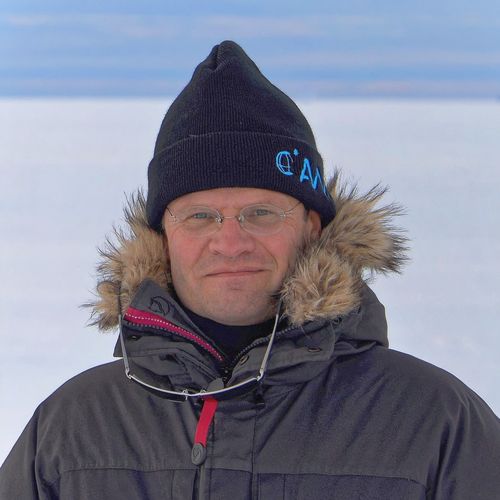
Markus Rex from the Alfred Wegener Institute leads MOSAIC as the chief scientist (Photo: Alfred Wegener Institute).
"MOSAiC and YOPP – both projects strive to better understand the Arctic climate system", says MOSAiC expedition leader Markus Rex in his interview with PolarPredictNews.
The YOPP-endorsed Multidisciplinary drifting Observatory for the Study of Arctic Climate (MOSAiC) expedition has started last Friday night when Polarstern left from Tromsø for the central Arctic to drift an entire year with the sea ice. This biggest Arctic expedition ever has played a key role for the Polar Prediction Project from the early start of MOSAiC planning. The unique comprehensive data sets which are expected from this huge overwintering field campaign will substantially contribute to improving polar predictive capabilities. We spoke with expedition leader Markus Rex from the Alfred Wegener Institute about his excitement for this upcoming science adventure, the challenges of such an international campaign and how MOSAiC and YOPP are strongly tied together.
Read the interview in our background stories.
Follow the MOSAiC expedition at https://www.mosaic-expedition.org, on social media (instagram, twitter) and use the progressive Web App at https://follow.mosaic-expedition.org/.
Read more about the link between YOPP and MOSAiC in PolarPredictNews #12 and the Background Stories.
20 September 2019: Waving Goodbye to Polarstern
Today, the German research icebreaker Polarstern departs from Tromsø, Norway, to spend an entire year drifting through the Arctic Ocean, trapped in sea ice. A total of six hundred people from 19 countries will participate in the expedition. The data gathered during six cruise legs, covering full polar night and polar day conditions and everything in between, will be used by numerous researchers to take climate and ecosystem research to a next level.
The Multidisciplinary drifting Observatory for the Study of Arctic Climate (MOSAiC) will be the first year-round expedition into the central Arctic exploring its climate system. It is the largest Arctic expedition following the concept of Fridtjof Nansen’s Fram expedition in 1893. The project with a total budget exceeding 120 Million Euro has been designed by an international consortium of leading polar research institutions, under the umbrella of the International Arctic Science Committee (IASC), led by the German Alfred Wegener Institute, Helmholtz Centre for Polar and Marine Research (AWI), the Russian Arctic and Antarctic Research Institute (AARI) and the University of Colorado, Cooperative Institute for Research in Environmental Sciences (CIRES), United States. RV Polarstern will serve as the central observatory, drifting with the sea ice across the central Arctic towards Fram Strait for a year. A distributed regional network of observational sites will be set up on the sea ice in an area of up to ~50 km distance from RV Polarstern. The ship and the surrounding network will drift with the natural ice drift across the polar cap towards the Atlantic, while the sea ice thickens during winter.
Link between MOSAiC and YOPP
A strong link between MOSAIC and YOPP has existed right from the beginning of MOSAiC’s planning. “Both projects strive to better understand the Arctic climate system”, explains expedition leader Markus Rex in his interview with PolarPredictNews (see #16). “MOSAiC has always been considered one of the key projects contributing to the Year of Polar Prediction”, says PPP Steering Group chair Thomas Jung. MOSAiC is thus also one of the first projects which received endorsement by the Year of Polar Prediction in late 2015, as it ‘supports YOPP by the evaluation of near-real-time observational data in a long-term context’. Ever since, MOSAiC planning has involved YOPP as an important partner.
Read more about the link between YOPP and MOSAiC in PolarPredictNews #12 and the Background Stories.
Back to School
Not only Polarstern will leave Tromsø harbour this Friday but also the Akademik Federov. During the six weeks of the expedition, the MOSAiC School 2019 will take place on board this Russian icebreaking vessel, which will support Polarstern on her way into the central Arctic. During the transit into the ice, twenty early career scientists will attend lectures, workshops, and hands-on exercises on e.g., Arctic atmosphere, sea-ice and ocean conditions aboard the floating university. YOPP supports Thea Schneider, one of the twenty early-career scientists, and mathematician and climate scientist Thomas Rackow who will join the school as a lecturer for climate and sea-ice modelling.
Once arrived in the Arctic, MOSAiC School participants will support the MOSAiC teams to set up the distributed regional network of observational sites within an area of up to ~50 km distance from RV Polarstern. On their way back to Tromsø, students will be given another set of workshops and practical exercises, this time on media and outreach. Each participant will work on an individual communication project to prepare becoming a MOSAiC ambassador after returning from the cruise.
Read about the eager and happy expectations, master student Thea Schneider and MOSAiC lecturer Thomas Rackow have shared with us before leaving for the Arctic in PolarPredictNews #12 and the Background Stories.
Follow @polarprediction on instagram and twitter, to find out about Thea’s and Thomas’ adventurous time with the MOSAiC School and follow the MOSAiC expedition at https://www.mosaic-expedition.org, on social media (instagram, twitter) and use the progressive Web App at https://follow.mosaic-expedition.org/.
18 September 2019: PolarPredictNews #12 – MOSAiC Edition
The September issue 2019 of PolarPredictNews, the newsletter for the Year of Polar Prediction, is now ready for download.
Waving Goodbye!
This Friday, the German research icebreaker Polarstern departs from scenic Norwegian town Tromsø to spend an entire year drifting through the Arctic Ocean, trapped in sea ice. Just in time for the start of the biggest Arctic expedition ever, the 12th issue of PolarPredictNews is all about MOSAiC. We invite you to read about how planning of YOPP and MOSAiC went along right from the early start of MOSAiC preparations. And do not miss our interview with expedition leader Markus Rex from the Alfred Wegener Institute about the YOPP-endorsed MOSAiC project.
Back to School
Not only Polarstern will leave Tromsø harbour this Friday but also the Russian icebreaking vessel Akademik Federov, onboard with her are twenty, very lucky early-career scientists who get the chance to join the MOSAiC School for the next six week in support of Polarstern making its way into the ice. Read about their eager and happy expectations, master student Thea Schneider and MOSAiC lecturer Thomas Rackow share with us in PolarPredictNews #12.
There is More to it
Make sure you know about the Météo France Arctic and Antarctic forecast data sets which can be used to compare with observational data produced during the YOPP Special Observing Periods. We invite you to participate in the survey developed by Vicki Heinrich who is a weather observer at Macquarie Island in the Southern Ocean seeking dialogue with people who have been in Antarctica at least for six weeks. Also, the YOPP-endorsed SIRT team successfully reporting about their just completed fifth summer citizen-science season in the Arctic on board the Russian nuclear icebreaker 50 let Pobedy.
By the Way
German Weather Service DWD President Gerhard Adrian was elected new WMO President. And: EGU has launched a new open-access journal on "Weather and Climate Dynamics".
Meetings, publications, events – check out PolarPredictNews #12 here.
8 September 2019: Forefront of European Weather Research
The European Meteorological Society (EMS) offers a platform for scientific exchange in the week from the 9th to the 13th of September 2019 in Copenhagen.
Up to six hundred representatives of European excellence in the fields of meteorology and climatology are expected to present results, draw common approaches and forge collaborations at the annual EMS meeting: not only scientists but also businesses, civil society and users will contribute to carry European weather and climate discussions forward.A special focus of this year’s edition will be Arctic and Antarctic issues and challenges. Amongst others, colleagues from ECMWF will also showcase their centre’s contribution to advancements in polar forecasting. On Monday, 9 September, PPP Steering Group chair Thomas Jung will present recent activities and results from the Polar Prediction world in the Opening Session. The Year of Polar Prediction will thus be featured in one of the most important weather and climate-related scientific gatherings contributing to the considerations on how to enhance research and activities in the field of polar prediction. Visit the EMS Annual Meeting webpage to browse the complete schedule and check other sessions at the conference.
5 September 2019: Sea Ice at the Interface

Polar bear at the Assiniboine Park Zoo of Winnipeg (Manitoba, Canada). The picture was taken during the visit to the "Journey to Churchill Northern Species" exhibit organized in the frame of the IGS conference. The polar bears kept in the zoo were young cubs abandoned by their mothers that could not be reintroduced into the wild (photo: Lorenzo Zampieri/Alfred Wegener Institute).
(by Lorenzo Zampieri, Alfred Wegener Institute)
The city of Winnipeg (Manitoba, Canada) hosted the Sea Ice Symposium of the International Glaciological Society (IGS) from 19 to 23 August 2019. The Sea Ice Symposium is a gathering of the scientific sea-ice community that takes place every five years.
The focus of the 2019 event has been the “sea ice at the interface” and set a new participation record for an IGS events (see IGS website), with approximately 350 scientists from all around the world taking part to the meeting. Focusing on both polar regions, state-of-the-art sea ice research has been presented with an interdisciplinary approach. Beside the typical geophysical sea-ice research with observational and modelling approaches, the conference touched themes related to global climate, polar marine ecosystems, globalization, and Indigenous cultures. Specifically, the sessions focused on the implications that changes to sea ice, ice sheets, glaciers, ice shelves and continental runoff have on climate systems within and beyond polar regions, including consequences for environmental and ecological integrity, and socioeconomic development.
Manitoba, Arctic-Facing Region
Arctic economy on different scales. The town of Churchill represents a good example in this context, being the only Arctic arbor connected to the rest of north America with a train line. The retreat of the Arctic sea ice in the Baffin Bay is opening new opportunities for this settlement and this summer, for the first time, a cargo ship transporting grain sailed from the Canadian Arctic towards the Mediterranean Sea. The expansion of human activities in these remote regions should, however, be accompanied by solid and seamless research to reduce the risks associated with the extreme polar environment but also to protect the fragile Arctic ecosystem and to allow local communities to be the first beneficiaries of this development, and not only marginal spectators. All these themes and open questions are well aligned with the mission of the Year of Polar Prediction, and this shows nicely how sea ice, and more generally polar research, is proceeding together to address the upcoming challenges.
The next IGS Sea Ice Symposium will take place in 2022 in the Bremen region (Germany), and will be organized by the Alfred Wegener Institute and the University of Bremen. This event will serve as an excellent occasion to take stock of the upcoming MOSAiC expedition, which is expected to further bring forward our understanding of the sea-ice system and its interaction with the global climate.
More information can be found on the workshop website.
3 September 2019: PAMIP – Investigate Causes and Consequences of Polar Amplification
(by Tido Semmler, Alfred Wegener Institute)
From 24 to 27 June 2019, almost forty invited participants met in Exeter (UK) to discuss first results of the Polar Amplification Model Intercomparison Project (PAMIP).
A coordinated modeling effort is a must-have to assess how mid-latitude weather and climate are affected by the ongoing rapid changes in the polar regions. The Polar Amplification Model Intercomparison Project (PAMIP) investigates the causes and global consequences of polar amplification, through creation and analysis of an unprecedented set of coordinated model experiments. From 24 to 27 June 2019, almost forty representatives of various modelling centers worldwide met in the surroundings of Exeter, United Kingdom, to present early results from PAMIP and related modelling activities, and to strengthen collaboration between PAMIP contributors. The YOPP-endorsed European Horizon2020 project APPLICATE is one of the leading projects contributing to this effort.
As a result of the workshop, a common work plan has been established to efficiently organize the evaluation of the results. A series of papers will be submitted to peer-reviewed journals till the end of the year which is the deadline for consideration of the results in the sixth assessment report of the Intergovernmental Panel on Climate Change (IPCC). Presentations from the workshop can be found here.
Contact: Doug M. Smith doug.smith@metoffice.gov.uk
26 August 2019: YOPP Session at 2019 IUGG General Assembly
(by Barbara Casati, Environment and Climate Change Canada and Taneil Uttal, NOAA Earth Systems Research Laboratory)
First Results from the Year of Polar Prediction (YOPP) at the 2019 International Union of Geodesy and Geophysics (IUGG) General Assembly.
The International Union of Geodesy and Geophysics (IUGG) General Assembly took place in Montreal, Canada, from 8 to 18 July 2019. Several scientific sessions and joint symposia were organized by the nine IUGG associations, including the International Association of Cryospheric Science (IACS) and the International Association of Meteorology and Atmospheric Science (IAMAS). Three polar-related sessions took place: "Past and Future Changes in Polar Climate System and their global Linkages", "The Arctic in the 21st Century: a Hotbed of Global Changes" and "First Results from the Year of Polar Prediction (YOPP)". The latter showcased several contributions gravitating on monitoring, prediction and verification efforts during YOPP including presentations describing the YOPP supersite model intercomparison (YOPPsiteMIP), preliminary results for the Canadian site of Iqaluit, the Finnish site Sodankylä, and the Antarctic sites Dumont D’Urville and Dome C/Concordia. The Canadian Arctic Prediction System (CAPS) developed specifically for YOPP by Environment and Climate Change Canada was also presented, along with verification results comparing the Canadian numerical weather prediction systems during the YOPP Special Observing Periods and post-processing and forecast products based on YOPP datasets for Arctic sea-ice and blizzard warnings. One track of the YOPP session dedicated to the Southern Hemisphere featured the significant contribution of Météo France with the AROME Numerical Experiments over the Antarctic, and several studies on measurements and validation of the microphysic structure of clouds and precipitation, as well as the atmospheric boundary layer. The session was overall quite successful and mirror the strong YOPP contribution to polar science.
Links to the three tracks of the YOPP session are:
Saturday, July 13th, 08:30 - 10:00
Saturday, July 13th, 13:30 - 15:00
Saturday, July 13th, 16:30 - 18:00
21 August 2019: Gerhard Adrian Elected New WMO President
(by Malena Andernach, Alfred Wegener Institute)
The World Meteorological Organization (WMO), whose World Weather Research Programme runs the Polar Prediction Project, has a new President: After 19 years of collaboration within the committees and bodies of the World Meteorological Organization (WMO), Prof. Dr. Gerhard Adrian, president of the German Weather Service DWD, was elected President of the WMO by the 18th World Meteorological Congress in Geneva.
The PPP Steering Group and International Coordination Office would like to thank the former president David Grimes for his continuous support of activities under the Year of Polar Prediction. At the same time, we welcome Gerhard Adrian elected as new WMO President during the 18th World Meteorological Congress held from 3 to 14 June 2019 in Geneva. Gerhard Adrian who has been leading the German Weather Service for nine years is the first German WMO President who will now coordinate future activities of WMO. He succeeds David Grimes, Assistant Deputy Minister and Head of Environment and Climate Change Canada's Meteorological Service, who served two four-year terms for WMO. The Argentinian WMO Permanent Representative Celeste Saulo, who participated in the launch event of YOPP in 2017 and has promoted the strategy of YOPP widely, was elected First Vice-President of WMO.
Gerhard Adrian has become Germany’s Permanent Representative at WMO in 2010; since 2011 he has also been member of the WMO Executive Council. During the coming four years, Adrian will further strengthen WMO through a sustainable strategy plan and efficient governance. He is engaged in implementing the current Governance Reform of WMO ensuring the motivation and commitment at all WMO levels will be preserved. A big effort will be devoted to enhance collaboration among the different WMO offices and members, as a contribution to an improved global meteorological infrastructure, including a global exchange of data.
Aim of the recently held World Meteorological Congress was to develop strategies to support the nations’ efforts to increase their resilience to extreme weather, water, and climate, to enhance meteorological observations and predictions, and to close capacity gaps by e.g, agreeing on a common future strategy. By the end of Congress, a new WMO strategic plan for the time period from 2020 until 2023 has been presented. It includes the high-level vision and overarching priorities of the future direction of WMO, expressed as long-term goals for 2030 and strategic objectives. Three overarching priorities are to (1) enhance preparedness and to reduce any kind of damage, to (2) support climate-smart decision making and to (3) enhance the socioeconomic value of WMO services. New governance structures set up at WMO will particularly help to better address major risks and to meet the challenges posed by a changing world.
The inauguration of Mr Adrian and the new strategic plan of the WMO will set new goals and policies for WMO with potential implications also for the Polar Prediction Project. The International Coordination Office will provide regular updates.
19 August 2019: This Week in Winnipeg, Canada – The 2019 Sea Ice Symposium
Not just a science conference: this year's Sea Ice Symposium organized by the International Glaciological Society will provide a platform for scientists to discuss updates, work on common strategies, and refresh partnerships.
The website www.igsoc.org describes it as "An international gathering of the world’s leading polar researchers and stakeholders": Winnipeg, Canada, seems to be the place to be in the week from 18 to 23 of August 2019. Every five years, the International Glaciological Society set up a stage for researchers to come together and share their knowledge with each other. For five days, scientists from institutes all over the world will meet in the capital of Manitoba to present their studies and show the latest progresses of projects working in the polar regions. Dialogues with stakeholders and policy makers will also be initiated to develop common strategies to manage undergoing changes affecting sea ice.
More to find at https://www.igsoc.org/symposia/2019/winnipeg/proceedings/index.html.
13 August 2019: Where to Track the Sea Ice
(by Malena Andernach and Kirstin Werner, both Alfred Wegener Institute)
The website seaiceportal.de makes an important contribution to YOPP by providing up-to-date information on Arctic and Antarctic sea-ice changes, including expert knowledge and a cartographic data archive with comprehensive sea ice information.
With the aim to share scientific knowledge and data of sea-ice trends in the Arctic and Antarctic with all levels of society, the Helmholtz Climate Initiative REKLIM, the Institute of Environmental Physics (IUP) at the University of Bremen and the Alfred Wegener Institute, Helmholtz Centre for Polar and Marine Research (AWI) launched the information and data portal seaiceportal.de (German version at meereisportal.de) in 2013. With its focus on weather and climate in the polar regions and beyond, seaiceportal.de is of particular interest for the YOPP community.
Coordinated by AWI colleagues Dr. Klaus Grosfeld and Dr. Renate Treffeisen, the website seaeiceportal.de provides background information on, e.g. the global relevance of sea ice and its trends and fluctuations. – What exactly is sea ice? When does it form? And how does the freezing process actually take place? The website provides answers to these and further questions. In addition, users can learn about sea ice modelling and monitoring methods of sea-ice variables. The observational data are presented in a wide range of maps, charts, and animations, while the original data collected by the University of Bremen can also be downloaded from the portal.
During the upcoming Arctic ice drift MOSAiC (Multidisciplinary drifting Observatory for the Study of Arctic Climate, see more information also at https://www.mosaic-expedition.org/), seaiceportal.de will provide up-to-date maps about sea ice related information of the expedition as well as showing the current position of the German research icebreaking vessel Polarstern. Find more here: www.seaiceportal.de/mosaic
Read the full article here.
Contact: Renate Treffeisen renate.treffeisen@awi.de
05 August 2019: Arctic and Antarctic Forecast Data from Météo France

Surface temperature from the ARPEGE-SH model version for the Antarctic. The inlet map displays the high-resolution orography used over the Antarctic region with the YOPP Supersites Dumont d’Urville, Alexander Tall Tower!, and McMurdo that will soon be available from the AROME model output (source: Météo France).
As a contribution to the modelling efforts of the Year of Polar Prediction, Météo France now provides Arctic and Antarctic forecast data sets. The model output is publicly available and can be used to compare with observational data produced during the YOPP Special Observing Periods.
During three YOPP Special Observing Periods, the number of observations of the weather and sea-ice conditions were increased in the Arctic and Antarctica. Model experiments during the remainder of the Polar Prediction Project until 2022 will show at what locations and which frequencies extra observations will be needed so that meteorological and sea ice forecasts in the polar regions can be improved.
Small-Scale Large-Scale Research Action
One of the operational centers contributing to YOPP is the French weather service Météo France. The National Centre for Meteorological Research CNRM provides forecast data for the three Special Observing Periods that were held in 2018 and 2019 in the high northern and southern latitudes. CNRM’s essential tools for operational weather forecasting are the two global numerical weather prediction models ARPEGE (ARPEGE stands for Action de Recherche Petite Echelle Grande Echelle; in English: Small-Scale Large-Scale Research Action) and AROME (AROME is the acronym for Application of Research to Operations at Mesoscale).
A Data Point at Every 2.5 km
For the two Arctic Special Observing Periods from 1 February 2018 to 31 March 2018 and from 1 July 2018 to 30 September 2018, modelling output from ARPEGE are available with data points at about every 7.5 to every 12.5 km over the thirteen YOPP Supersites in the Arctic (Fig 1). This output data contains forecasts of temperature, wind, clouds, humidity and other parameters for three days. In addition, within the YOPP-endorsed project APPLICATE, model experiments were carried out with the higher resolution model AROME over a domain around Svalbard and the Barents Sea: "The model output from AROME provides data every 2.5 km for each day during the Arctic Special Observing Periods at 00 and 12 UTC", says Eric Bazile who leads this Météo France effort in support of YOPP.
High-resolution Area from France Moved to Antarctica
In the Antarctic, the Special Observing Period took place during the last austral summer, from 16 November 2018 to 15 February 2019. As a contribution to the YOPP in the Southern Hemisphere (YOPP-SH) effort, Bazile and his colleagues Vincent Guidard and Niramson Azouz have developed a dedicated configuration of the ARPEGE model, called the ARPEGE-Southern Hemisphere (ARPEGE-SH) version. Usually, ARPEGE has a rather low resolution over Antarctica (one data point at every 35 km) and a much higher one over France (around 7.5 km distance between each data point). But for this Antarctic experiment, Bazile and his team have moved the high-resolution area to Antarctica instead. Five- and ten-day forecasts at 00 and 12 UTC, as well as six-hours forecasts at 6 and 18 UTC are thus available for all 17 YOPP Supersites in the Antarctic (Fig. 2) and for four additional sites over the Third Pole/high mountain area. The experiments of the high-resolution AROME model forecasts with data points at every 2.5 km are still running but will be provided soon for the Antarctic YOPP Supersites Dumont d’Urville, Alexander Tall Tower!, and McMurdo.
The data and corresponding technical information are available from the YOPP Data Portal and from the ftp server ftp://ftp.umr-cnrm.fr (user: yopp/password: Arpege).
For any questions, please contact Eric Bazile eric.bazile@meteo.fr.
Fig 1: Surface temperature from the ARPEGE model in the Arctic. The inlet map displays the high-resolution orography used over a domain around Svalbard and the Barents Sea for the AROME model output.
Fig 2: Surface temperature from the ARPEGE-SH model version for the Antarctic. The inlet map displays the high-resolution orography used over the Antarctic region with the YOPP Supersites Dumont d’Urville, Alexander Tall Tower!, and McMurdo that will soon be available from the AROME model output.
31 July 2019: Survey on the Use of Weather and Climate Information
For the YOPP-endorsed project "Use of Weather and Climate Information: Risk perception and decision-making in the Antarctic" (UWCI), the psychology researcher and weather observer Vicki Heinrich seeks dialogue with people who have been in Antarctica at least for six weeks in the past three years.
In her exploratory study of weather and climate information use and decision-making in Antarctica (see more on the project in the latest PolarPredictNews #11, item #20, pages 17-19), Vicki Heinrich who is currently based at Macquarie Island in the Southern Ocean invites eligible participants to complete a pre-interview questionnaire and conduct an interview with her (via skype or in person) so she learns how decisions based on weather conditions in Antarctica and the sub-Antarctic are being made, and how people use, think about, and interpret climate and weather information.
The information collected in this survey will help provide evidence-based recommendations for improvements in weather and climate products for use in Antarctica and inform best practice weather-related decision-making. The outcome of this and following surveys and research within the UWCI study will particularly contribute to the efforts of the Year of Polar Prediction Task Team working on Societal and Economic Research and Applications (PPP-SERA).
The pre-interview questionnaire contains a few general questions about weather-related decisions and information sources that will contribute valuable data to the study from the additional participants. To complete the questionnaire please use the following link:
http://surveys.utas.edu.au/index.php/235241?lang=en
The full invitation can be found here.
Project updates are posted on the @UWCIAntarctica project Facebook page.
Contact: Vicki Heinrich vicki.heinrich@bom.gov.au
26 July 2019: Winter is Coming – MET Norway Contribution to 'Polar Prediction Matters'
In the new contribution to Polar Prediction Matters – the dialogue platform of providers and users of polar forecast services – Gunnar Noer and Rafael Grote report on recent advances in forecasting of snow avalanches in mountainous parts of Norway.
Norwegian winter sports activities in the mountains have always been closely linked to being aware of avalanche risks. A well-prepared alpine skier thus carries an avalanche transceiver when leaving Tromsø for a cross-country skiing tour in the Lyngen Alps.
In the past few years, the unusually high number of polar lows and long spells of heavy snowfall in northern Norway have led to an increase of winter accidents caused by snow avalanches, report Rafael Grote and Gunnar Noer from the Norwegian Meteorological Institute (MET Norway) in their article just published in Polar Prediction Matters.
Therefore, MET Norway has recently adjusted their avalanche forecast to international standards. The authors of the article provide information about the Norwegian snow avalanche service VARSOM and explain how decisions about the level of hazard risks are being made and communicated to alert the Norwegian public.
Read the full article here.
About Polar Prediction Matters
Polar Prediction Matters is a non-peer reviewed forum initiated as a means to foster the dialogue between those that research, develop, and provide polar environmental forecasts and those that use (or could use) polar environmental forecasts to guide socio-economic decisions. It is hosted by the Helmholtz Association of German Research Centers blog portal and maintained by the International Coordination Office for Polar Prediction at the German Alfred Wegener Institute.
23 July 2019: Ninth International Workshop on Sea Ice Modelling, Data Assimilation and Verification (IICWG-DA)
(by Lorenzo Zampieri and Sara Pasqualetto, both Alfred Wegener Institute)
More than sixty scientists attended the ninth International Workshop on Sea Ice Modelling, Data Assimilation and Verification (IICWG-DA) from 17 to 19 June in Bremen, Germany. IICWG-DA is a joint initiative of the International Ice Charting Working Group (IICWG), the Year of Polar Prediction, GODAE Oceanview (GOV), and the Coordination & Support Action KEPLER by the European Commission. The meeting in Bremen was part of a series of workshops organized by the IICWG Data Assimilation Working Group to discuss cross-cutting issues in sea-ice modelling, observations and data assimilation and how deficiencies of current systems can be more efficiently diagnosed and addressed.
'Diversity' and 'sharing' are probably the words that express the success of the IICWG-DA initiative. The meeting represented a friendly and inclusive forum for scientists from three different continents (America, Europe and Asia) with different backgrounds and working approaches. The synergies between the modelling and observational communities, as well as the collaboration between research institutions, numerical weather prediction centers and national agencies generated a constructive discussion that set the bar for further developments in the field of sea-ice prediction.
The workshop certified the tendency of assimilating more and more sea-ice observational products, together with their uncertainties in our sea-ice prediction models. Sea-ice thickness and freeboard measurement are now considered the new standard for data assimilation, and the sophistication of the assimilation techniques themselves has grown substantially in recent years. Interestingly, the resolution increase of the models has brought the community towards the employment of high-resolution observational products (SAR and MODIS images), while the fact that our models can now explicitly resolve linear kinematic features such as ice leads and ridges is currently boosting the research on new sea-ice rheologies for a better agreement of the model results with observations.
Presentations and posters of the IICWG-DA workshop can be downloaded from the workshop website.
8 July 2019: A Centennial of Geodesy and Geophysics
This week, the 27th General Assembly of the International Union of Geodesy and Geophysics starts in Montréal, Canada. One of the sessions will be dedicated to the "First Results from the Year of Polar Prediction".
More than 4,000 participants from Canada and around the world are expected to come to Montréal this week to discuss latest research results in geosciences. This year is the 100th anniversary of the IUGG meetings which is going to be celebrated from 8 to 18 July 2019 at the Congress Palais, a 10-minute walk away from downtown Montréal. The international science community will not only look at what has been achieved during a century of Earth and space science but more importantly is going to look forward into the future of geoscientific advancements.
Among the diverse ten-days program with various Union symposia, sessions, workshops, panels and special events, a session dedicated to the "First Results from the Year of Polar Prediction" – the flagship activity of the World Meteorological Organization’s decade-long Polar Prediction Project – will be held on Saturday, 13 July. The session is chaired by Amélie Kirchgässner from the British Antarctic Survey: "Significant improvements in environmental prediction capabilities for the polar regions and beyond will be presented in this symposium. I am particularly excited about advances in our knowledge that connect and combine disciplines, and look forward to lively discussions." Speakers will present their latest contributions to the Year of Polar Prediction, particularly first results from recent field campaigns in the Arctic and Antarctic, connecting the atmosphere with the ocean, cryosphere and biosphere.
The program for the agenda can be found here. For any questions, please do not hesitate to contact Amélie Kirchgässner (acrki@bas.ac.uk) or the International Coordination Office for Polar Prediction (office@polarprediction.net).
1 July 2019: Start of YOPP Consolidation Phase
With 1 July 2019, the YOPP Consolidation Phase has officially started. To highlight the achievements of the Year of Polar Prediction to date and the challenges that lie ahead, three online seminars have been organized at the German Alfred Wegener Institute, the European Centre for Medium-Ranged Weather Forecasts (ECMWF) and Environment and Climate Change Canada (ECCC) on 24 and 25 June.
The Year of Polar Prediction is moving forward, and so is the restless effort to deliver enhanced prediction capacity for the polar regions. With 1 July, the YOPP Consolidation Phase is officially launched. During the final three years of YOPP, the data collected during its Core Phase will be made available to the community to improve predictive models and eventually transform these into more reliable products for people living and working in polar regions. The aim is to translate scientific achievements of YOPP into more reliable weather and sea ice forecast services.
Revised YOPP Implementation Plan
While cutting-edge science activities will also underpin the upcoming phase, the challenge for the Polar Prediction Project is to translate the scientific insights gained during the YOPP Core Phase into more reliable weather and sea-ice forecast services. In addition to consolidating and synthesising YOPP research and science, it will be necessary to prepare the ground for a post-YOPP structure of coordination and communication. "After three very successful Special Observing Periods in the Arctic and Antarctic, we are now very much looking forward to starting this new final phase of YOPP which is crucial for developing a legacy and making sure that the work initiated by the Year of Polar Prediction can continue past 2022", says Thomas Jung, chair of the Polar Prediction Project's Steering Group.
To provide guidelines and structures on how to realize these goals, a third version of the YOPP Implementation Plan will be published during summer 2019. This document updates the previous two versions of the plan, giving detailed descriptions of actions during the YOPP Consolidation, including strategies and objectives in light of the results achieved until now.
Three Online Seminars
To launch the new exciting period that lies ahead, the Polar Prediction Project (PPP) has organized three online seminars on 24 and 25 June 2019. These online courses were held by the German Alfred Wegener Institute (see on YOPP YouTube), the European Centre for Medium-Range Forecasts (see on YOPP YouTube) and by Environment and Climate Change Canada (see pdf here). These online seminars by the chair of the Polar Prediction Project's Steering Group (PPP-SG) Thomas Jung and the two PPP-SG members Irina Sandu and Greg Smith provide an overview of the work carried out as part of YOPP so far.
24 June 2019: PAMIP Workshop in Exeter (UK)
(by Tido Semmler, Alfred Wegener Institute)
From 24 to 27 June 2019, a workshop will take place in the surroundings of Exeter (UK) to share and discuss first results of the Polar Amplification Model Intercomparison Project (PAMIP).
Since it is well known that the Arctic and also the Antarctic peninsula are undergoing rapid change since a few decades, an important question is how the mid-latitude weather and climate may be affected. The need for a coordinated modeling project on this topic is evident and has been expressed at various workshops and conferences, to result then in the Polar Amplification Model Intercomparison Project, which is endorsed by the Coupled Model Intercomparison Project 6 (CMIP6). In this project, at least eight modeling centers worldwide are currently carrying out and evaluating model simulations according to a common protocol. The YOPP-endorsed European Horizon2020 project APPLICATE is one of the leading projects contributing to this effort.
For more info, please contact Doug M. Smith doug.smith@metoffice.gov.uk.
17 June 2019: APPLICATE-YOPP Online Seminars – Training on Northern Hemisphere Weather and Climate Predictive Capability
The Year of Polar Prediction, in collaboration with APPLICATE, the Association of Polar Early-Career Scientists (APECS) and other partners will run a free online course "Advancing Predictive Capability of Northern Hemisphere Weather and Climate" in fall 2019.
The online course is designed for early-career researchers (e.g., Master and PhD students, and Postdocs) with a specific interest in Arctic weather and climate prediction and modelling. Various online lectures from September to December 2019 will provide an overview of the state-of-the-art knowledge of northern high-latitude weather and climate predictions, including aspects relevant for the Arctic climate system; linkages between Arctic and mid-latitude/global weather, and specific challenges of Arctic climate prediction and modelling. An important aspect of the course is the engagement of stakeholders who are using weather and climate predictions in their daily operations. The registration for either the entire course or separate sessions is now open. For more information, including the preliminary course syllabus, please visit the APECS webpage.
12 June 2019: PolarPredictNews #11
The June 2019 issue of the PPP newsletter is now available.
In the 11th PolarPredictNews newsletter issue, read about the final phase of the Polar Prediction Project: The Consolidation Phase comes with a revised YOPP Implementation Plan and three online lectures on 24 and 25 June where everyone is invited to join and discuss with the chair of the PPP Steering Group Thomas Jung (Alfred Wegener Institute), and the PPP Steering Group members Irina Sandu (ECMWF) and Greg Smith (ECCC) about YOPP research findings, community efforts and those activities that lie ahead.
Also, find out in the new issue what is behind the YOPPSiteMIP recipes for model and observation efforts, and learn about a tiny island in the Southern Ocean that contributed extra radiosoundings to the recent YOPP Special Observing Period in the Southern Hemisphere.
In an interview with the Executive Secretary of the Arctic Council’s Working Group PAME, Soffia Gu∂mundsdóttir provides insights on what is the Arctic Shipping Data Base.
Also, don’t miss François Massonnet summarizing findings of the YOPP-endorsed SIPN South project; and read about a master thesis carried out in the Environmental Policy Group of Wageningen University (The Netherlands) about groups of forecast users from Arctic YOPP-endorsed projects.
Much more news to find in PolarPredictNews #11: download for screen or for print.
11 June 2019: Launch of YOPP Consolidation Phase – Three Online Seminars and a New Implementation Plan
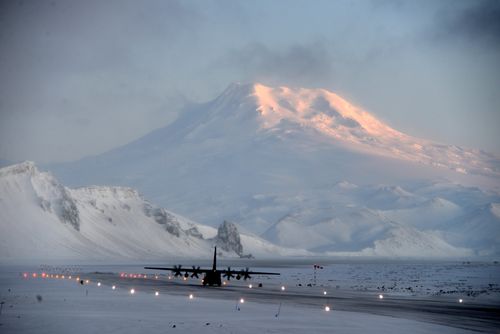
While during the next phase of YOPP cutting-edge science activities will also underpin the upcoming phase, the challenge for the Polar Prediction Project is to translate the scientific insights gained during the Core Phase into more reliable weather and sea-ice forecast services (photo: Vera Lund, Jan Mayen).
1 July 2019 marks the official start of the YOPP Consolidation Phase. On 24 and 25 June, three online seminars will highlight the achievements of the Year of Polar Prediction to date and challenges that lie ahead.
The Year of Polar Prediction is moving forward, and so is the restless effort to deliver enhanced prediction capacity in the polar regions. June 2019 will mark the official start of the YOPP Consolidation Phase. During the final three years of YOPP, the data collected during its Core Phase will be made available to the community to improve predictive models and eventually transform these into more reliable products for people living and working in polar regions. The aim is to translate scientific achievements of YOPP into more reliable weather and sea ice forecast services.
Revised YOPP Implementation Plan
While cutting-edge science activities will also underpin the upcoming phase, the challenge for the Polar Prediction Project is to translate the scientific insights gained during the Core Phase into more reliable weather and sea-ice forecast services. In addition to consolidating and synthesising YOPP research and science, it will be necessary to prepare the ground for a post-YOPP structure of coordination and communication so that the work initiated by the Year of Polar Prediction can continue.
To provide guidelines and structures on how to realize these goals, the third version of the YOPP Implementation Plan will be published in late June. This document updates the previous two versions of the plan, giving detailed descriptions of actions during the YOPP Consolidation, including strategies and objectives in light of the results achieved until now.
Three Online Seminars
To launch the new exciting period that lies ahead, the Polar Prediction Project (PPP) invites everyone to join three online seminars. Participants will be given an overview of the work carried out as part of YOPP so far, and they will have a chance to ask questions about the concluding elements of the Polar Prediction Project.
AWI Online Seminar
The first online seminar, hosted by the Alfred Wegener Institute, Helmholtz Centre for Polar and Marine Research (AWI), will take place on Monday, 24 June 2019 from 09:00 to 10:30 UTC. The chair of the PPP Steering Group, Thomas Jung, will provide an overview of the YOPP Core Phase and the plans for the Consolidation Phase. Please join the AWI online lecture on the day from your computer, tablet or smartphone (no prior registration required). If you have any questions, please send an email to office@polarprediction.net.
ECMWF Online Seminar
A second online seminar, hosted by ECMWF, will take place later that day, from 15:00 to 15:45 UTC. PPP Steering Group member Irina Sandu will talk about how YOPP helps to address challenges in modelling, observations and data assimilation - all key ingredients of numerical weather prediction. Please join the ECMWF online lecture on the day from your computer, tablet or smartphone (no prior registration required).
ECCC Online Seminar
A third online seminar will be run by Environment and Climate Change Canada (ECCC) on 25 June 2019. At 15:00 UTC, PPP Steering Group member Greg Smith will talk about YOPP activities at Environment and Climate Change Canada (ECCC) and efforts toward improved sea-ice forecasting. To join the live stream at ECCC, use the connection details below. Any questions can be directed to Gregory.smith2@canada.ca.
Video only:
https://pwgsc-nh.webex.com/meet/Gregory.Smith2Canada.ca | 558537926
Audio:
Join by phone
1-877-413-4791 Call-in toll-free number (US and Canada)
1-613-960-7515 Call-in number
279 263 6 Attendee access code
14 May 2019: Giving the People What They Want: "Translating" Weather and Climate Information in the North American Arctic

Communities with unreliable and low band-width internet still need weather and climate information. Gay Sheffield (NOAA SeaGrant) and Rick Thoman (ACCAP) talk by phone with community residents at Little Diomede, Alaska to review the winter 2018-19 sea ice outlook (photos, left to right: Gay Sheffield, Opik Ahkingha).
In the new blog post on the Polar Prediction Matters website, Rick Thoman from Fairbanks, Alaska, and Gita Ljubicic from Ottawa, Canada, give practical examples how local weather, water, ice and climate information can effectively be disseminated today within Arctic communities.
Residents' needs in the North American Arctic are often very different from standard services on weather and ice conditions that have historically been provided in lower latitudes. In this new contribution to Polar Prediction Matters, Rick Thoman and Gita Ljubicic write about their experiences with Indigenous and northern residents who often consider sea ice as a platform for travel, subsistence, and economic activities such as hunting and fishing. Anticipating rapid changes of winds and the sea ice breaking off the floe edge is thus key for community members who make decisions about when or where to travel. Modern communication of weather and ice information is particularly challenging in northern North America due to limited bandwidth and unreliable Internet connectivity. The authors provide best-practices examples how to connect with local residents via traditional radio, newspapers, and social media.
Read the full article here.
29 March 2019: Fifth PPP-SERA meeting in Punta Arenas, Chile
The next PPP-SERA meeting will take place from 8–12 April in Punta Arenas, Chile. On Wednesday, 10 April, an Open Session will be held ath the Universidad de Magallanes (Auditorium Australis).
The fifth meeting of PPP-SERA, to be held in Punta Arenas, Chile, in April 2019, will focus on the development and planning of activities PPP-SERA promised to deliver during YOPP, including Special Services Projects and Weather and Society workshops. Furthermore, the PPP-SERA task team will use the opportunity to develop joint funding proposals in response to the Belmont Forum call, will work on an editorial to a Special Issue in Polar Geography, and will respond to requests by the YOPP Steering Group.
The PPP-SERA Open Session in Punta Arenas will extend the PPP-SERA network within South America. During the session, PPP-SERA will be reporting on current research to generate awareness of relevant themes and approaches and to engage in discussions with researchers, service providers and end-users from South America.
There will be remote connection to the PPP-SERA meeting and the Open Session at Punta Arenas time (CLST/UTC-3). If you would like to participate in the meeting remotely, please send an email to office@polarprediction.net.
A preliminary agenda can be found here.
20 March 2019: YOPP Antarctic Community Meets in Charleston SC This Year

Broad Street, Charleston SC (photo: licensed under the Creative Commons Attribution-Share Alike 3.0 Unported license creativecommons.org/licenses/by-sa/3.0/deed.en).
The fourth YOPP Southern Hemisphere meeting will again be aligned with the annual Workshop on Antarctic Meteorology and Climate. The meetings will be held this summer in Charleston SC.
The Workshop on Antarctic Meteorology and Climate will be held 25-27 June, 2019 in Charleston SC, USA, at the Charleston Marriott Hotel. The Year of Polar Prediction in the Southern Hemisphere (YOPP-SH) meeting will be held in Charleston SC, USA, on June 27 Thursday afternoon and Friday morning of June 28 at the Charleston Marriott Hotel. This workshop focuses on bringing together all parties involved in Antarctic meteorology and the advancement of this discipline through research science and improving operational support.
Registration and detailed information are posted on the AMRC meetings page. This will be updated periodically with agenda and workshop details. There are twenty rooms blocked for the event at the Charleston Marriott*.
Informal Icebreaker:
Monday June 24, 2018, 1800-2200 at Charleston Marriott Hotel, Aqua Terrace Roof-Top Bar, 170 Lockwood Blvd, Charleston, SC
Workshop Location:
Charleston Marriott Hotel
170 Lockwood Boulevard, Charleston, SC 29403
Charleston, SC, USA
25-28 June, 2019
Hotel:
Charleston Marriott Hotel
*Rooms available Friday-Sunday (June 21-July 1)*
PH (843) 723-3000
170 Lockwood Boulevard, Charleston, SC 29403
Rates: $179/room
Group Name: 14th Annual Workshop on Antarctic Meteorology & Climate
(Available until May 24, 2019)
* Book your group rate for 14th Annual Workshop on Antarctic Meteorology & Climate
https://www.marriott.com/event-reservations/reservation-link.mi?id=1552680781798&key=GRP&app=resvlink
(The title on the web page may say "Navy Workshop on Antarctic Meteorology & Climate" which is this event)
Chairperson for this event and POC is:
Arthur Cayette
SPAWAR Atlantic, Office of Polar Programs
DSN 588-4945, Comm +1 (843)-218-4945
Arthur.cayette@navy.mil
The deadline for submission of abstracts will be:
Abbreviated Abstract Submission Deadline - 1 May 2019.
- Provide your "abbreviated abstract" information via web page registration.
Extended Abstract Submission Deadline - 30 May 2019.
- E-mail your "extended abstracts" to arthur.cayette@navy.mil.
- Presentations will be collected at the time of the meeting 25-27 June 2019.
The deadline for registration is 30 May 2019.
For all abstract submission, registration details and general information, go to: http://amrc.ssec.wisc.edu/meetings/meeting2019/
For any question on the WAMC, please do not hesitate to contact Matthew Lazzara mattl@ssec.wisc.edu Questions related to the YOPP-SH meeting can be directed to office@polarprediction.net or to David Bromwich bromwich@polarmet1.mps.ohio-state.edu.
11 March 2019: PolarPredictNews #10 Out Now
A new issue of PolarPredictNews is now available for download.
The recently finished Special Observing Period in the Southern Hemisphere is one of the topics in this tenth issue of PolarPredictNews: Daily LIDAR plots are now publicly available from the French-Italian Antarctic Concordia station. It was also Concordia station where, thanks to the Italian educational project CAPIRE-YOPP, two more radiosondes per day could be added during two weeks in January.
Pick up news about an aircraft campaign over Iqaluit, Canada, last November, and make sure to check out an article previously published in Polar Prediction Matters about the efforts to develop forecasts for fish swarms. We are quite happy to feature the YOPP-endorsed project 'Wisconsin AWS' in this issue – PI Matthew Lazzara from the University of Wisconsin-Madison tells us about one of the largest Antarctic meteorological observing networks with more than forty years of observations.
Finally, if you haven't yet done online – enjoy reading the interview with the Peter Bauer, Helmholtz International Fellow, about his research at ECMWF and his efforts to advance weather prediction and the future prospects of technology and science (you can also watch the interview on
YouTube)
.
Download PolarPredictNews #10 here.
07 March 2019: Antarctic LIDAR Data now Available

A sample of LIDAR data plot, as available on the public server. (Upper plot: signal. Lower plot: depolariation, log. Z units). A "snake-like" red cloud in the signal plot appears to be a liquid water fog/cloud in the depolarization plot (deep blue). Ice precipitates from the cloud are visible after 5 AM (light blue to red on the lower depolarization plot) (source: Massimo Delguasta).
Daily LIDAR plots are now available from the Antarctic Concordia Station.
As a contribution to YOPP, daily LIDAR plots are now available to the public from the Antarctic Italian-French Concordia Station. The tropospheric LIDAR instrument provides year-round tropospheric profiles of aerosol and clouds every five minutes, 24 hours per day. The LIDAR instrument was funded through the Italian Antarctic Research Programme PNRA and has been used during the YOPP Special Observing Period in the Southern Hemisphere as part of the YOPP-endorsed project "Water Budget Over the Dome C Station" (in short: H2O-DC) to distinguish solid from liquid cloud layers, with a vertical resolution of 7.5 m and a minimum overlap altitude of 10 m. The LIDAR covers the local troposphere from the surface up to approximately 7,000 m altitude, operating fully automatic at 532 nm.
Using the same wavelength as the CALIPSO satellite science mission, the new LIDAR data starting from 1 January 2018 provide a ground-truth point for satellite-borne LIDAR data. The capability to discriminate between water and ice phases provides a unique test ground for microphysical aerosol and cloud modelling in Antarctica. The altitude of origin of the precipitation can easily be estimated from the LIDAR plots, thus providing a reliable tool for tracking the origin of locally collected precipitation for isotopic and contamination studies. Studies on the inversion of radiometric and photometric data sensitive to the type and altitude of clouds will also benefit from the LIDAR-derived knowledge of cloud properties such as bottom and thickness.
The pre-processed data are updated on a daily basis but no quality-check is applied. Users of the data should note that the continuity of the data series might be broken by laser/datalink failures. Time-lapse videos of cloud coverage are also automatically collected. Further information and data samples are available at http://lidarmax.altervista.org/englidar/_Antarctic%20LIDAR.php.
The data (quick-look, daily false colour LIDAR plots), starting from 1 January 2018, are available at the following ftp server:
IP: 149.139.18.31 (port 21)
user: Concordia
pw: station
For numerical data, the use of the data in publications, copyright credits or any other information, please contact the P.I. Massimo Delguasta massimo.delguasta@ino.it.
05 March 2019: PPP Steering Group meeting #10 – Meeting Report
The meeting report from the tenth session of the Polar Prediction Project Steering Group (PPP-SG) is now available.
The tenth meeting of the Polar Prediction Project Steering Group (PPP-SG) took place in Helsinki, Finland, at the headquarters of the Finnish Meteorological Institute (FMI) from 16 to 18 January 2019. The meeting report that is now available for download summarizes discussions during the meeting with regards to refining the plan for the YOPP Consolidation Phase, developing plans for the third Special Observing Period for the Northern Hemisphere (SOP-3) as well as general coordination and administrative matters.
The full meeting report can be downloaded here.
28 February 2019: Aircraft Campaign over Canada’s Iqaluit YOPP Supersite
(by Mengistu Wolde, National Research Council, Canada, Zen Mariani and Alexei Korolev, both ECCC)
An aircraft campaign to measure cloud microphysics and snow precipitation in the Canadian Arctic has been conducted the over Iqaluit, Nunavut, Canada (~64N, 68W) in November.
The field project RadSnowExp is a multi-platform and multi-sensor study to address the pressing need for provision of precipitation measurements globally. For the project, the National Research Council (NRC) Convair-580 aircraft was instrumented by NRC and Environment and Climate Change Canada (ECCC) with state-of-the-art in-situ sensors, triple frequency (Ka, X, and W-band) polarimetric and Doppler radars, lidars, and a G-band radiometer. The aircraft was deployed to Iqaluit, Nunavut, between 19 and 30 November 2018 and conducted four flights (totaling twenty flight hours).
Iqaluit is one of ECCC’s Canadian Arctic Weather Science (CAWS) supersites which has also been identified as a YOPP Supersite. It is equipped with an extensive array of in-situ and remote sensing sensors; including a scanning Ka-band polarimetric radar and multiple lidars and radiation flux sensors, all of which operate 24 hours during seven days of the week for research purposes. Although satellite calibration and validation (cal/val) activities are not a core component of the RadSnowExp campaign, attempts have been made to fly along the satellite tracks of the Global Precipitation Measurement (GPM) satellite mission, CloudSat, and ADM-Aeolus satellites, taking coincident measurements at the same time the satellite was overhead.
Results from the campaign will provide information on the sensitivity and variability of the multi-frequency polarimetric radar and passive microwave signatures to different precipitation types in the Arctic, including intensive snow events over different surface types.
Contact: Mengistu Wolde mengistu.wolde@nrc-cnrc.gc.ca, Zen Mariani zen.mariani@canada.ca, Alexei Korolev alexei.korolev@canada.ca
25 February 2019: YOPP-IASC Arctic Science Workshop
(by Kirstin Werner and Helge Goessling, both ICO)
More than one hundred participants discussed recent progress and ways toward improved polar prediction at the Arctic Science Workshop that took place from 14 to 16 January 2019 in Helsinki, Finland. The meeting was jointly organized by the International Arctic Science Committee (IASC), the Year of Polar Prediction (YOPP) International Coordination Office, and the Finish Meteorological Institute as host.
The first day of the meeting was dedicated to keynote lectures to set the stage on current efforts to bring together observations and modelling during the Year of Polar Prediction. One of the foci during the following science sessions was the analysis of additional observations that have been obtained during the first two YOPP Special Observing Periods (SOPs) in the Arctic. Extra polar observations during the SOPs captured several extreme weather events that provide useful benchmarks to assess current forecast capabilities and to understand how such events unfold. A Sudden Stratospheric Warming during the Arctic winter SOP (February-March 2018) occurred ahead of the rare event of a polynya opening north of Greenland. While warm anomalies prevailed over the Labrador region as well as the Beaufort and Bering seas in March, northern Russia and large parts of Europe experienced a 'Beast from the East', or what the Finns whimsically call a 'Finnish Wednesday', with extremely low temperatures and heavy snowfall. Interestingly, the polynya north of Greenland re-opened during the Arctic summer SOP (July-September 2018), resulting from another period of anomalously warm southerly winds.
Results presented from first data denial experiments capitalising on the SOP data indicate that the polar observing systems clearly have impacts on forecast skills not only in polar regions but also in the mid latitudes, and that in particular conventional (i.e., surface, wind profiler, and upper-air) observations are most influential during winter.
A too simplistic, or partly completely missing, surface snow component in state-of-the-art numerical prediction systems has been highlighted as a prevailing cause of surface warm biases, both over land and on sea ice. The use of multi-layer snow schemes is a promising way to improve near-surface temperatures and the energy budget in models in cold atmospheric conditions.
During parallel breakout sessions on predictability, processes, verification, and user engagement, the workshop participants discussed current questions and topics that are particularly relevant to help shaping the YOPP Consolidation Phase (July 2019 to 2022). During this final phase, YOPP data and research will be synthesized to ensure sustained improvements in environmental prediction capabilities for the polar regions and beyond. Recommendations from the breakout groups included: to further promote and maintain YOPP observational and model data; to put focus on case studies with regard to extreme events captured by the SOP observations, Arctic process understanding, and user engagement; to work toward specific and practical recommendations for the polar observing system; and to endurse the transfer of YOPP outcomes into operation and services, including the securing of funds for service development.
The abstract book and agenda with links to presentations can be downloaded from the workshop website.
20 February 2019: Renewal of Memorandum of Understanding between WMO and AWI


An extension of the Memorandum of Understanding (MoU has been signed by the World Meteorological Organization (WMO) and the German Alfred Wegener Institute (AWI). This MoU will ensure continued support of the Year of Polar Prediction (YOPP) by the International Coordination Office until YOPP will come to an end in 2022.
With the MoU, AWI has offered to continue hosting the International Coordination Office (ICO) of the Polar Prediction Project in form of an in-kind contribution. Currently lead by Kirstin Werner, the International Coordination Office supports the PPP Steering Group in the planning and implementation of PPP and YOPP priorities and coordinates activities with other WMO programmes and international partner organizations. The renewal of the MoU ensures administrative and organizational support by the ICO until the end of the Year of Polar Prediction in 2022.
19 February 2019: In the Mind of the Modeller – Interview with Helmholtz International Fellow 2018 Peter Bauer
In 2018, Peter Bauer, Deputy Director of Research at the European Centre for Medium-Range Weather Forecasts (ECMWF) received the Helmholtz International Fellow Award. Antje Boetius, Director of the Alfred Wegener Institute (AWI), handed over the Helmholtz Fellow certificate to Peter Bauer for his frontier work in the field of high-resolution modelling, prediction and computing on 5 February 2018. During his one-week visit at AWI, we had the chance to meet the Helmholtz International Fellow for an interview about his research at ECMWF, the challenges that come with it, and the potential for future advancements in the field of weather prediction.
Peter Bauer, Deputy Director of Research and Manager of the Scalability Programme at the European Centre for Medium-Range Weather Forecasts (ECMWF), has been one of the pioneers shaping the Polar Prediction Project and the Year of Polar Prediction as a Steering Group member from Day 1. For his frontier work in the field of high-resolution modelling, prediction and computing he has now received the Helmholtz International Fellow Award: "I am very grateful for that as it emphasises the need and opportunity for international collaboration. An international fellow is, by definition, based on collaboration between Helmholtz as a whole, with its different institutes and disciplines, and an international organisation like ECMWF."
Peter’s work brought significant advancements in many fields of Earth system research, such as satellite remote sensing in weather and climate prediction, the assimilation of observations in numerical models, climate monitoring, weather and climate model development and, more recently, the preparation of models and forecasting systems for extreme-scale computing. In the different roles he had since he first joined ECMWF in 2000, Peter Bauer has significantly supported the Year of Polar Prediction (YOPP), as well as large-scale projects such as the EU Horizon-2020 APPLICATE and Helmholtz Earth System Modelling (ESM) projects.
Read the full interview here.
Watch the video interview on the YOPP Youtube channel.
6 February 2019: APPLICATE General Assembly 2019 and Early Career Event
Based on an article published on the ECMWF website.
Some 70 scientists reviewed 'exciting first results' at the second General Assembly and an early career event of the EU-funded APPLICATE project on polar prediction at ECMWF from 28 January to 1 February 2019. The overarching goal of APPLICATE is to develop enhanced predictive capacity for weather and climate in the Arctic and beyond, and to determine the influence of Arctic climate change on northern hemisphere mid-latitudes, for the benefit of policy makers, businesses and society.
"Just over half-way into the project, APPLICATE is well on track: exciting first results were discussed and we expect to make further substantial progress over the next year", says Irina Sandu, the coordinator of polar prediction activities at ECMWF and member of the PPP Steering Group.
One of the findings to date, reported by ECMWF scientist Heather Lawrence, is that existing observing systems in the Arctic improve forecast skill in the region in the short and medium range and in the mid-latitudes in the medium range.
"Interestingly, it appears that a better use of existing satellite observations, in particular over snow and sea ice, is probably just as important as new observations", Heather Lawrence notes.
In terms of modelling, ECMWF scientist Gabriele Arduini presented progress on a new multi-layer snow scheme being developed at ECMWF.
"Our results suggest that a better description of snow physical processes improves the representation of the snowpack in our numerical weather prediction (NWP) models and reduces systematic errors in short-range wintertime forecasts of minimum temperature over the Arctic", Gabriele Arduini says.
Other topics included atmospheric interactions between the Arctic and the mid-latitudes (Kunhui Ye, Alfred Wegener Institute); improving the representation of sea ice variability (Eduardo Moreno-Chamarro, Barcelona Supercomputing Center); and the Northern Hemisphere atmospheric response to Arctic summer sea ice loss (Svenya Chripko, CERFACS).
Training Sessions for Early Career Scientists
The last two days of the meeting were dedicated to supporting the work of early career scientists, which is also part of APPLICATE’S objectives. The event was jointly organized by APPLICATE, APECS and ECMWF and involved stimulating lectures on scientific writing by François Massonnet, project management by Luisa Cristini, and development of case studies by Dragana Bojovic and Marta Terrado.
"Training of early carreer scientists is critical for transfering comprehensive skills to the next generation of climate scientists. We were delighted to have such high-profile talks from ECMWF including Peter Bauer, Irina Sandu, the Copernicus team led by Jean-Noël Thépaut, and from other APPLICATE partners", says APPLICATE project manager Luisa Cristini.
5 February 2019: YOPP in the Southern Hemisphere meeting #4 – SAVE THE DATE
The 4th YOPP in the Southern Hemisphere meeting will take place on 27-28 June 2019 in Charleston, South Carolina.
As in previous years, a YOPP in the Southern Hemisphere (YOPP-SH) meeting will be held in conjunction with the Workshop on Antarctic Meteorology and Climate (WAMC). Hosted this year by the Space and Naval Warfare Systems Center (SSC) Atlantic, the 14th WAMC will is scheduled for 25 to 27 June 2019 to take place at the Citadel College, Bond Hall in Charleston, SC. Following WAMC, the YOPP-SH meeting #04 will start at 1 pm on 27 June and will be continued in the morning of 28 June.
Project investigators and representatives of national agencies active in Antarctica are invited to provide updates on their activities during the YOPP Special Observing Period (SOP) in the Southern Hemisphere, November 16, 2018 to February 15, 2019. To make most effective use in data denial experiments of all the additional radiosonde observations collected during the SOP, we want to assemble complete radiosonde data sets from all operators. We will likely want to assemble all surface observations as well. A key question to be decided by the meeting is whether to hold a winter SOP in the April-June time period in either 2020 or 2021.
For further information about the 14th WAMC, please see here. Details on registering for 14th WAMC and YOPP-SH#04 meetings will follow.
Any questions can be directed to David Bromwich bromwich@polarmet1.mps.ohio-state.edu and Kirstin Werner office@polarprediction.net.
1 February 2019: Why Don’t We Have Forecasts of Fish?
Many challenges remain before fish forecasts become a less fanciful reality, says Mark R. Payne, senior scientists at the Technical University of Denmark (DTU-Aqua), in the new contribution to Polar Prediction Matters.
The sea not only is a source of food but sustains a source for employment, revenue, tradition and culture. Foreseeing fluctuations of e.g., fish swarms would enable many societies and communities in the Arctic and beyond to much better prepare for the variable conditions of marine life. In his article for Polar Prediction Matters, Mark Payne who leads the Climate Services work package within the EU Horizon2020 project Blue Action, describes the efforts to develop forecasts of living marine resources where the dynamics of a fish species and interactions between species are still complex and difficult to measure. While first fish forecast products have emerged already a decade ago, a predictive understanding of the relationship between the physical and biological environment remains challenging.
Read more here.
31 January 2019: Polar Prediction Project Steering Group Meeting #10 in Helsinki
The tenth session of the Polar Prediction Project Steering Group (PPP-SG) took place in Helsinki, Finland, at the headquarters of the Finnish Meteorological Institute (FMI) from Wednesday 16 January 2019 to Friday 18 January 2019.
The meeting specifically focused upon refining the plan for the YOPP Consolidation Phase, developing plans for the third Special Observing Period for the Northern Hemisphere (SOP-3) as well as general coordination and administrative matters.
An updated plan for the YOPP Consolidation Phase (1 July 2019 to 31 December 2022) will be subsequently incorporated into a third version of the “WWRP Polar Prediction Project Implementation Plan for the Year of Polar Prediction (YOPP)” which is expected to be completed prior to the launch of the Consolidation Phase at the 18th World Meteorological Congress in Geneva in June 2019. The new draft plan for the Consolidation Phase builds upon the original plan identifying the key research, operations and services activities that will need to be carried out over the four years of YOPP Consolidation. As well, a range of evaluation metrics will be identified in the new version of the YOPP Implementation Plan to determine the success of YOPP prior to and following the conclusion of PPP in 2022. The PPP-SG also agreed on a new working structure to better fit the activities foreseen for the next four years.
A full meeting report is currently being prepared.
17 January 2019: Four Daily Radiosoundings from Antarctic Concordia Station

Radiosondes are providing important atmosphere data that can be used to verify and improve currently available weather forecasts. The students involved in CAPIRE-YOPP work together with researches at the stations to learn how to carry out science projects in vast areas like the East Antarctic Plateau (photo: Giuseppe Camporeale).
About four hundred students are involved in the educational project which has added two more radiosondes daily for two weeks to the Italian Meteo observatory programme of the French-Italian Antarctic research station Concordia. As a contribution to the Year of Polar Prediction’s Special Observing Period in the Southern Hemisphere, for the first time, four daily soundings at synoptic hours were performed from this station on the Antarctic Plateau which is considered one of the coldest places on Earth.
In addition to the two radiosoundings launched by the Italian meteorological observatory programme as a contribution to YOPP, two more weather balloons were deployed every day from the Italian-French station Concordia (also known as Dome C station), as part of the Italian education project CAPIRE-YOPP. CAPIRE is the acronym of the Italian title of the project "Comprendere lA PrevIsione meteoRologica in antartidE sostenendo YOPP" and means "Understand Antarctic weather forecast sustaining YOPP". At the same time CAPIRE translates to UNDERSTAND. From 1st to 14th January 2019, Concordia station for the first time performed four daily radiosoundings at synoptic hours 00, 06, 12 and 18 UTC. The unique data set that has been produced during these two weeks in early January adds to the meteorological activities performed at Terra Nova Bay on the Antarctic coast. It will allow modellers and operational forcasting centers to evaluate the effect of enhanced weather observations to their weather forecasts for the Ross Sea and Victoria land areas throughout to the East Antarctic Plateau.
Outstanding Educational Activity
The field activities within CAPIRE-YOPP are related to an outstanding educational activity involving 17 intermediate and high schools of the Milan metropolitan area and are promoted by the University of Milano-Bicocca and the Italian National Research Council CNR. Thanks to the fundamental contribution by the Italian National Agency of New Technologies, Energy and Sustainable Economic Development ENEA and by the Meteo Service of the Italian Air Force, about four hundred students could be involved in the various activities connected to polar meteorology and climate such as in-depth events, seminars, lessons including a visit to one of the operational meteorological centres in Italy. High school class students will be also involved in performing data analysis and present their scientific results.
On 27 November 2018, the field campaign of CAPIRE-YOPP has been launched with a live connection to Concordia station when students and teachers were able to directly talk to scientists who are staying at the station to carry out meteorological observations during this ongoing austral summer. With closing of the field work on 14 January another live connection to the station allowed a delegation of students and professors to meet the researchers engaged with the extra-soundings activities during YOPP’s Special Observing Period in Antarctica. Students will analyse the data, report their findings and be awarded at a final event in summer which also marks the end of the YOPP Core Phase. With this educational activity, students who might become the next generation of polar researchers are given a unique opportunity to learn and apply scientific methodologies and techniques, but also become familiar early in their career with the language of scientific research, well as with topics related to polar meteorology.
Live connection events, together with movies and pictures showing balloon launches and field activities can be followed here: https://volarebeyondyopp.blogspot.com/.
Any questions can be related to Vito Vitale V.Vitale@isac.cnr.it or Massimo Gervasi massimo.gervasi@unimib.it.
24 December 2018: PolarPredictNews #09
A new issue of PolarPredictNews (#09) is now available for download.
On 16 November 2018, the first YOPP Special Observing Period in the Southern Hemisphere started. Read about the activiites of weather services and international scientists who are more than doubling the number of atmospheric and sea-ice observations from different Antarctic land stations, during terrestrial field expeditions, and aboard research vessels in the Southern Ocean for three months. Learn about the recent Italian support of the Year of Polar Prediction, read how YOPP was featured by the British Royal Meteorological Society, and find out about the sea-ice program from the German overwintering station Neumayer III in support of the Special Observing Period in the Antarctic. This and much more to find in PolarPredictNews #09.
24 December 2018: Initial Forecast Analysis of Seasonal Antarctic Sea Ice

(by François Massonnet/UC Louvain)
The initial analysis of seasonal sea-ice forecasts in Antarctica have been made available.
As part of its activities, the SIPN South project has collected seasonal forecasts of Antarctic sea ice aligned with the Year Of Polar Prediction Special Observing Period (austral summer 2018-2019).An initial analysis of these forecasts can be found in the following document:
http://www.climate.be/users/fmasson/SIPNSouth_initialassessment_2018-2019.pdf
The full report will be produced after the summer season when verification data will be available.
The SIPN South Leadership team: F. Massonnet, P. Reid, J. Lieser, C. M. Bitz, J. Fyfe, W. Hobbs
21 December 2018: Newly Installed Ice Stress Sensors on Labrador Coast

Buoy deployment in Nain, Labrador comprised of a weather station for surface turbulent flux measurements (wind, surface air temperature, sea level pressure and relative humidity), three ice stress buoys with three stress sensors each deployed at different depth in the sea ice and a UpTempO instrument measuring water temperature at different depths (photo: courtesy of Carolin Mehlmann).
(by Adrienne Tivy, Jean-François Lemieux/both Environment and Climate Change Canada, and Bruno Tremblay/McGill University)
New sensors to measure ice stress have been installed recently by Environment and Climate Change Canada south of the community of Nain in Canada.
Goal of the multi-year field experiment project in Voisey`s Bay on the Labrador Coast is to study the internal ice stresses in a landfast ice cover under the effect of tidal and wind forcing and interaction between ice floes at the mouth of the fjord. With this, the team around Adrienne Tivy, Bruno Tremblay and Jean-François Lemieux aims to confirm the recent finding by Hata and Tremblay (2015) that (1) thermal stresses exhibit anisotropy in land-locked sea ice, (2) thermal stresses at depth have the opposite sign as those at the surface (tensile at the surface and compressive at depth when the surface cools, and vice versa), and (3) whether low (inertial to synoptic) frequency forcing from tidal currents and surface wind can be recorded by a strain gauge.
In spring 2018, three ice stress buoys (with three sensors each) were deployed for a short time along with a weather station and a MetOcean UpTempO instrument to measure ocean temperature with depth. This first deployment of the new sensors aimed at testing the equipment and identify potential problems before the first full season measurements start in winter 2019. Next year the team will also deploy a seasonal ice-mass balance buoy at the beginning of the freeze-up season in late fall.
Contact: Adrienne Tivy adrienne.tivy@canada.ca
18 December 2018: Ninth International Workshop on Sea Ice Modelling, Data Assimilation and Verification

The 9th International Workshop on Sea Ice Modelling, Data Assimilation and Verification hosted by the Alfred Wegener Institute will take place from 17-19 June 2019 at the Haus der Wissenschaft (House of Science) in Bremen (photo: Maria Santos).
A joint workshop of the International Ice Charting Working Group (IICWG), the Year of Polar Prediction, GODAE Oceanview (GOV) and the Coordination & Support Action KEPLER by the European Commission will be held from 17 to 19 June 2019 in Bremen, Germany.
Hosted by the Alfred Wegener Institute, the workshop builds on a series of successful workshops organized by the IICWG Data Assimilation Working Group to advance international capabilities for automated sea ice analysis and prediction on timescales from hours to a season. In conjunction with the Year of Polar Prediction (YOPP) organized by the WWRP-PPP and GOV, a particular need has been identified regarding the development of more mature and meaningful methods for sea ice verification. The focus of the workshop is to discuss cross-cutting issues in sea ice modelling and data assimilation and how deficiencies of current systems can be more efficiently diagnosed and addressed.
Registration is due on 15 January 2019 via this website.
Participants will be contacted by 15 February 2019 regarding their proposed contribution. More information can be found here.
10 December 2018: YOPP Session at 27th IUGG General Assembly

YOPP will hold a session at the 27th General Assembly of the International Union of Geodesy and Geophysics that takes place from 8-18 July 2019 in Montréal, Québec, Canada.
Conveners of the session are Amelie Kirchgaessner (UK), Tom Bracegirdle (UK), Annick Terpstra (Norway) and Holger Schmithusen (Germany). The session will review efforts contributing to the Year of Polar Prediction (YOPP), particularly reports and first results from recent Special Observing Periods and field campaigns in the Arctic and Antarctic. In line with the interdisciplinary nature of the Year of Polar Prediction, contributions connecting the atmosphere with the ocean, cryosphere and biosphere are invited.
Deadline for abstract submission is 18 February 2019. Find more about IUGG 2019 at the meeting website. The description of the session M02 - FIRST RESULTS FROM THE YEAR OF POLAR PREDICTION (YOPP) can be found via iugg2019montreal.com/m.html
03 December 2018: New Director of YOPP International Coordination Office
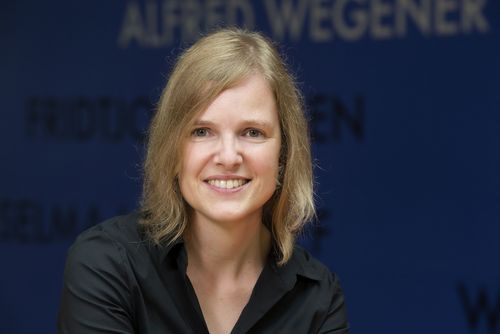
Kirstin Werner will serve as the new Director of the International Coordination Office for Polar Prediction from 1 December 2018 (pic: Alfred Wegener Institute/Martina Buchholz).

WMO's World Weather Research Programme, the Polar Prediction Steering Group and the YOPP International Coordination Office are grateful for Helge's dedicated work as ICO Director from 2014 to 2018 to promote activities of the Year of Polar Prediction, ranging from modelling and forecasting via the polar observing system to user engagement, education, and dissemination (pic: Alfred Wegener Institute/Martina Buchholz).
From 1 December 2018, Kirstin Werner will serve as Director of the Year of Polar Prediction International Coordination Office.
Together with the chairman of the Polar Prediction Project Thomas Jung and the Steering Group, Kirstin Werner will continue fostering collaboration between international projects, initiatives, and programmes related to polar prediction research. Kirstin is an Arctic paleoclimatologist and has a master in science marketing with a focus on science communication. As project officer, she has already been engaged with the YOPP office since 2016 and is thus up-to-date and well-involved in a broad range of YOPP-related activities. The former Director Helge Goessling, who has taken over new responsibilities as research group leader at the Alfred Wegener Institute, will continue to support the International Coordination Office (ICO) and to contribute research aimed towards enhanced polar prediction. Paolo Ruti, chief of the World Weather Research Programme, the PPP Steering Group and the ICO thank Helge Goessling for his diligent efforts and committed support to plan, implement and internationally promote the Year of Polar Prediction.
28 November 2018: APPLICATE Scientists Involved in New Book on Sub-Seasonal to Seasonal Prediction
(by François Massonnet) Scientists of the YOPP-endorsed project APPLICATE contribute a chapter on "The Role of Sea Ice in Sub-seasonal Predictability” in the newly published S2S book edited by Andrew Robertson and Frederic Vitart.
Predicting weather and climate fluctuations at sub-seasonal to seasonal (S2S) time scales is of high relevance for society, in the current context of rapid climate changes. Rapid progress in this emerging area of research has been possible thanks to an improved understanding of physical processes underpinning predictability, the sustained development of prediction systems and observational networks, as well as the advent of high-performance computing. In that sense, the APPLICATE project endorsed by the Year of Polar Prediction is a prominent example of how the scientific community addresses the S2S prediction challenge.
The scientific literature on S2S prediction has flourished in recent years, and it appears difficult to have a broad and synthetic view on the current state of knowledge. In addition, S2S prediction is a multi-faceted research area using concepts from mathematics and statistics (data assimilation, bias correction, forecast verification, ensemble forecasting), physics (atmospheric dynamics, predictability mechanisms, teleconnections), computational sciences and even social sciences, when it comes to communicating climate information in meaningful ways. To embrace and synthesize all this knowledge, the book “Sub-seasonal to Seasonal Prediction” has recently been published. As an accessible yet rigorous synthesis of what is known on S2S prediction, this book edited by Andrew Robertson and Frederic Vitart will quickly become a reference for students, teachers and researchers all alike.
Review by APPLICATE Scientists
The five APPLICATE scientists Matthieu Chevallier, François Massonnet, Helge Goessling, Virginie Guemas, and Thomas Jung were solicited to contribute a chapter on “The Role of Sea Ice in Sub-seasonal Predictability”. In this article, the main sources of Arctic and Antarctic sea-ice predictability, the current sea-ice forecasting capabilities and their limits are reviewed by the authors. Evidence is presented that sea ice can also be seen as a source of S2S predictability for the polar and extra-polar atmosphere. The chapter highlights the central role that sea ice is playing on S2S predictability in polar regions and beyond.
This contribution also is a recognition of the authors’ individual and collective leaderships in the field of polar prediction. To a larger extent, the chapter also underlines that global S2S prediction systems will have to account for the rapidly changing conditions happening at the poles – a notion that has been at the heart of APPLICATE since its inception.
The book “Sub-seasonal to Seasonal Prediction“ is available from here.
26 November 2018: Everyday Life in the Arctic – New Contribution to Polar Prediction Matters
In the new contribution to the Polar Prediction Matters dialogue platform, Tanja Joona, senior researcher at the Arctic Centre of the University of Lapland in Rovaniemi, Finland, provides a personal report on the everyday life in Finnish Lapland.
While the Arctic is often described as a vulnerable, cold and exotic place with stereotypical images of indigenous and non-indigenous communities, it is not such a homogenous area. Tanja Joona’s article provides insights to the daily life in Finnish Lapland which is home to approximately 183,000 people, including indigenous people: the Sámi.
Read more here.
22 November 2018: Call for Applications – MOSAiC School 2019

For one year, the German research icebreaker RV Polarstern will drift with the Arctic sea ice from the central Arctic towards Fram Strait. During the first leg of the MOSAiC expedition, APECS and MOSAiC partners such as YOPP offer the unique opportunity to participate in the MOSAiC School 2019 aboard the icebreaker RV Akademik Fedorov that supports RV Polarstern on her way into the ice (Photo: Kirstin Werner).
Applications are now accepted to participate in the MOSAiC School 2019. The school is jointly organized by the project 'Multidisciplinary drifting Observatory for the Study of Arctic Climate' (MOSAiC) and the Association of Polar Early Career Scientists (APECS). The Year of Polar Prediction is one of the partners for the school.
From September 2019 to September 2020, RV Polarstern operated by the Alfred Wegener Institute will drift with the Arctic sea ice from the central Arctic Ocean towards Fram Strait. During one year, about three hundred scientists will be on board the German research icebreaker to investigate processes and the coupling of atmosphere, ocean, sea ice, bio-geochemistry, and ecosystem conditions. The MOSAiC ice drift will therefore help to better understand consequences of Arctic warming and related sea-ice loss. As MOSAiC is amongst the many projects that have been endorsed by the international WMO initiative Year of Polar Prediction (YOPP), detailed data sets to improve weather and climate forecasts will be obtained during the one-year ice drift.
For the first cruise leg of the MOSAiC expedition, APECS and MOSAiC partners such as YOPP offer the unique opportunity to participate in the MOSAiC School 2019 aboard the Russian icebreaker RV Akademik Fedorov that supports RV Polarstern on her way into the ice. The school will start and finish at the port of Tromsø in Norway, and is envisaged to take place from 15 September to 26 October 2019 (plus/minus a few days depending on logistical or weather conditions). There will be no registration fee for the school participants. However, travel to and from Tromsø, Norway, has to be organized and covered by school participants. In case, additional travel support to cover flights to and from Tromsø should become available, MOSAiC School organizers will contact selected participants. However, travel support cannot be guaranteed at this point.
The MOSAiC School 2019 is open to up to twenty early career researchers, i.e., advanced graduate students and PhD students with none to limited experience with ship-based research. International experts who are part of the MOSAIC expedition will share their knowledge with students, engage in discussions and hands-on experiences in ground-breaking research, and thus help to educate future Arctic researchers. In addition to lectures, the participants will help the MOSAiC teams on site to set up their instruments and experiments.
For more information and how to apply, please visit the MOSAiC School 2019 website. Application deadline is 22 January 2019 13:00 GMT
For any questions, please contact mosaic-school@apecs.is
20 November 2018: Year of Polar Prediction Featured by Royal Meteorological Society
On Wednesday, 21 November 2018, the Royal Meteorological Society will discuss advances and challenges to predict key Arctic processes during the Year of Polar Prediction.
"Arctic Prediction in a Changing Climate: Understanding Key Processes and Challenges" is the title of the Royal Meteorological Society meeting that takes place this Wednesday, 21 November, in London. Speakers at the meeting are representing operational forecasting centers and academia involved in the international Year of Polar Prediction (YOPP) effort. YOPP has been initiated by the World Meteorological Organization in response to the rapid environmental changes in polar regions and related transformation of human activities demanding improved forecasts of polar weather and sea-ice conditions. During two Special Observing Periods earlier this year, additional atmospheric and sea-ice measurement were obtained from many land stations and research cruises in the Arctic to increase the number of observations both in winter and summer time helping to improve numerical forecast models. New insights provided by several YOPP-related field campaigns and modelling experiments, and advances and challenges associated with the understanding and prediction of key Arctic processes will be discussed at the meeting.
The program and abstracts of the meeting can be found here. See also here for registration to attend the meeting at the Society of Chemical Industry (SCI) in London. The meeting can be publicly followed from 14:00 - 18:00 (UTC) via a Facebook Live stream (see here).
15 November 2018: Antarctic Summer Special Observing Period Starts This Week

From different stations on the Antarctic continent, from aboard research vessels and during YOPP-endorsed field campaigns, extra observations will be obtained during the Antarctic summer Special Observing Period (Source: YOPP Observation Layer, Google Earth).
This week, the Special Observing Period in the Antarctic starts. For three months, weather services and international scientists will increase the number of atmospheric and sea-ice observations from different Antarctic land stations, during terrestrial field expeditions and aboard research vessels in the Southern Ocean. Goal of the international Year of Polar Prediction is to improve weather and sea-ice forecasts in the polar regions.
When days are getting longer and research stations become busy, the summer is about to start on the Antarctic continent. November is the month when the austral field season begins. This summer, extra atmospheric and sea-ice measurements in addition to the routine observations will be carried out as a contribution to the Year of Polar Prediction (YOPP). YOPP has been initiated by the World Meteorological Organization’s (WMO) World Weather Research Programme (WWRP). In response to the rapid climate changes in polar regions and related transformation of human activities, the project aims to improve environmental safety by improving forecasts in the Arctic and Antarctic. Earlier this year, two YOPP Special Observing Periods already took place in the Arctic.
More than 2,000 extra radiosondes expected
Expected are more than 2,000 extra radiosondes released from numerous meteorological stations from 16 November 2018 to 15 February 2019. In addition to atmospheric observations, YOPP-endorsed field campaigns and expeditions as well as autonomous instruments will feed their real-time or near-real time data into the Global Telecommunications System of WMO. The additional data generated during the Special Observing Period in the Southern Hemisphere (YOPP-SH SOP) will be used for numerical experimentation and internationally coordinated verification activities as well as for forecast evaluation and observational impact studies. Extra measurements help to identify ways to improve the prediction systems. Based on more accurate and reliable forecasts of weather and sea-ice conditions, recommendations for the future Southern Hemisphere Polar Observing Systems can be provided.
The Antarctic Special Observing Period marks another milestone for the Year of Polar Prediction. Preparations for the YOPP-SH SOP have been ongoing since the YOPP Summit in Geneva in 2015. Here, the YOPP-SH committee formed. Since then, the committee led by David Bromwich from the Byrd Polar and Climate Research Center at the Ohio State University has been meeting every year to report on national commitments and plans for the Antarctic Special Observing Period.
Antarctic YOPP Supersites
In particular, Antarctic YOPP Supersites such as the French site Dumont D’Urville, the German Neumayer III station, the Korean station King Sejong or the British Halley and Rothera stations will launch extra weather balloons (for exact locations of YOPP Supersites see the YOPP Observations Layer). The increased radiosonde activity from meteorological stations and cruise expeditions can be followed on the ECMWF observation monitoring webpages (see here; chose different observing systems and regions). Data obtained by surface buoys in the Southern Ocean is also sent to the GTS; additional buoy deployments will increase the network once the research icebreakers start heading into the Antarctic waters for the summer.
As during the first two SOPs in the Arctic earlier this year (see here for an overview), many field campaigns and expeditions endorsed by YOPP provide additional specific observations which will enable a better understanding and hence representation of environmental processes in the Antarctic weather, climate, and sea-ice models. Details on the YOPP-endorsed projects contributing to the Antarctic SOP can be found through the YOPP Explorer and by following on twitter and instagram @polarprediction and hashtags #polarprediction and #YOPPextraobs.
08 November 2018: Blizzards in the Canadian Arctic – New Article for Polar Prediction Matters
In the new contribution to Polar Prediction Matters, two forecasters from Environment and Climate Change Canada (ECCC) report on automated prediction products to help forecasting blizzards in the Canadian Arctic.
In the Canadian Arctic, blizzards regularly occur from October to May. Blizzard conditions are determined from a number of different weather elements so forecasting of these severe snow storms with temperatures below 0°C, wind speed stronger than 40 km/h, and visibility less than 400 meters are still a major challenge for meteorologists. In the new contribution to the Polar Prediction Matters user feedback forum, William Burrows and Curtis Mooney from ECCC introduce different automated products that may help predict blizzard and near-blizzard conditions. These prediction products have been developed over a period of years and are meanwhile often used in operations.
Read the full article here.
06 November 2018: SIPN South Call for Contributions – Antarctic Summer 2018-2019 Sea Ice Prediction Experiment
The Sea Ice Prediction Network South (SIPN South) invites contributions to the second coordinated sea ice prediction experiment in the Southern Ocean.
SIPN South is an international project endorsed by the Year of Polar Prediction (YOPP). Its goal is to make an initial assessment of the ability of forecasting systems to predict circumpolar-average, regional-average, and local Antarctic sea ice conditions, with a focus on the summer season. SIPN South is inviting contributors to participate to the second coordinated sea ice prediction experiment in the Southern Ocean, targeting December 2018-February 2019 and aligned with the Year Of Polar Prediction (YOPP) Special Observing Period in the Southern Ocean. Deadline for submission of the forecasts is 1st December 2018.
For more information about SIPN South see here http://acecrc.org.au/sipn-south/
Guidelines for submission are outlined in the call for contributions at www.climate.be/users/fmasson/SIPNSouth_2019_call.pdf
Questions or feedbacks may be directed to François Massonnet
(francois.massonnet@uclouvain.be).
22 October 2018: Second Arctic Science Ministerial Meeting in Berlin
17 October 2018: Italy Supports Year of Polar Prediction with a Budget of 500,000 EUR
This year's PNRA call has been the first specifically devoted to YOPP while in a call for project proposals in 2016, two YOPP-endorsed projects were already reviewed eligible for funding. Together with these, the five new Antarctic projects will strongly enrich the Italian contribution to the YOPP initiative with highly relevant new data sets and modeling activities to further help making YOPP a success.
10 October 2018: Call for Abstracts – Special Issue in Polar Geography
Human activities in polar regions involve hunting and travel by Indigenous communities, industrial activities associated with resource extraction in the Arctic or transit of commercial vessels, tourism operations such as cruise ships, pleasure yachts or adventure tourism, but also search and rescue operations, government and research operations, and/or military enforcement. For a special issue in Polar Geography, the YOPP Task Team on Societal and Economic Research and Applications (in short: PPP-SERA, see more here) invites abstract submissions for manuscripts that aim to explore how weather, water, ice and climate information is currently used by and produced for various polar activities and operations. Results and perspectives on the use and improvement of polar weather and environmental prediction services will be collected in Polar Geography in an effort to translate scientific and technological advances into societal value. Abstract submission is due on 1 November 2018, full manuscripts are requested by 1 February 2019. The Call for Papers can be downloaded from here. Abstracts shall be sent by email before the deadline (1 November 2018) to one of the editors Machiel Lamers (machiel.lamers@wur.nl) and Daniela Liggett (daniela.liggett@canterbury.ac.nz)
25 September 2018: PolarPredictNews #08
19 September 2018: YOPP in the Southern Hemisphere – A Special Observing Period during Austral Summer
As an international forum for current results and ideas in Antarctic meteorology, numerical weather prediction, and weather forecasting, annual activities and the status of the observing (e.g., Automatic Weather Stations) and modelling (e.g., Antarctic Mesoscale Prediction System) efforts have been addressed during WAMC. During the YOPP-SH #03 meeting, project investigators and representatives of national agencies operating in Antarctica provided updates on the current status of planning with regard to the Special Observing Period (SOP) in the Southern Hemisphere that is scheduled from 16 November 2018 to 15 February 2019.
Amongst others, operational numerical weather prediction (NWP) support provided by involved national weather centres was discussed. The YOPP Supersites in the Southern Hemisphere will be key locations for joint modelling and verification efforts. An in-depth data set from these key Antarctic stations will enable process-based verification of model-based forecasts against high-frequency observations. In addition to plans for the upcoming austral summer YOPP-SH SOP, the oceanographic community, in particular, suggested another (‘light version’) Special Observing Period is needed during austral winter, perhaps during 2019 or 2020; discussion during the coming months will determine the feasibility and timing of this new effort.
Presentations from the YOPP-SH meeting are available from the YOPP-SH webpage hosted by the Byrd Polar and Climate Research Center, Columbus, Ohio, USA. See also the WAMC meeting website for more information.
SIPN South on YouTube
A SIPN South presentation is now available via the YOPP YouTube channel. Because François Massonnet, the lead of the Sea Ice Prediction Network South (SIPN South), could not join the third YOPP in the Southern Hemisphere meeting (YOPP-SH#03) in person, he recorded his presentation prior to the meeting. The recording has now been uploaded on the YOPP YouTube channel for everyone to learn more about this initiative to coordinate seasonal predictions of sea ice in the Southern Ocean. Find the recording on SIPN South here.17 September 2018: Message from the Oden
13 September 2018: Welcome to the PPP Steering Group
Taneil Uttal is a supervisory meteorologist and leads the Polar Observations and Processes
group in the Physical Science Division of the NOAA Earth Systems Research Laboratory.
Her research is based on direct observations from the surface of all components of the Arctic
system including surface energy budgets, aerosols and clouds. She was the originator of the
International Arctic Systems for Observing the Atmosphere (IASOA). This consortium of Arctic
Observatories around the Arctic Ocean comprise the YOPP Supersites, and the IASOA consortium is coordinating observing assets and expertise to support the verification goals of YOPP.
Machiel Lamers is Associate Professor in Environmental Policy at the Wageningen University, The Netherlands. He coordinates the Environmental Mobilities theme in his chair group and is interested in the role of environmental information in governing mobility systems and the relation between tourism and nature conservation. Machiel is one of the co-chairs of the PPP Task Team Societal and Economic Research and Applications (PPP-SERA) and is PI of the YOPP-endorsed project SALIENSEAS. For all members of the PPP Steering Group see here.
6 September 2018: The YOPP super-site Model Inter-comparison Project

Ice crystals suspended in the atmosphere, also called diamond dust, produce the sun dog – a halo effect around the sun. The lidar instrument installed at the ECCC site Whitehorse, Yukon detects the ice crystals via their ability to reflect the laserbeam enhancing the backscattered signal (photo: Mike Harwood).
The YOPP super-sites comprise a number of key locations in the Arctic and Antarctic including the super-sites of the International Arctic Systems for Observing the Atmosphere (IASOA; www.iasoa.org), super-sites operated by Environment and Climate Change Canada (ECCC; ecpass.ca), key locations in the Arctic Ocean, selected Antarctic research stations, and key locations covering the so-called “third pole” (Tibetan plateau). At these locations, suites of instruments such as micrometeorological towers, lidars, radars, ceilometers, and radiometers provide detailed measurements, continuously characterizing the vertical column of the atmosphere as well as the surface conditions and energy fluxes. The data from these sites extend far beyond the traditional synoptic surface and upper-air observations, and efforts are underway to create Merged Observatory Data Files with variables from different observing systems formatted to be consistent with model output during the YOPP Special Observing Periods.
For these key sites at the poles, operational centres have kindly offered to provide numerical weather prediction (NWP) model output during YOPP. This unique data set enables in-depth process-based verification of model-based forecasts against high-frequency observations. The target processes include representation of hydrometeors and cloud micro- and macro-physics, radiation, turbulence and energy budgets, and the representation of energy and momentum fluxes. The process-diagnostic aim is to identify strengths and weaknesses of current prediction systems, with the final goal of improving the reliability for weather and environmental predictions in polar regions (and beyond).
The YOPP Task Teams (TT) on Modelling and Verification have worked closely together to finalize a guidance document for the modelling efforts at YOPP super-sites. The YOPPsiteMIP document can be downloaded from the PPP Modelling TT website. This document lists the different YOPP super-site locations and site-specific variables to be produced by the different models. The standardization of the YOPPsiteMIP model output enable a direct comparison of the model output from the participating forecasting centres.
Modelling centers are invited to join this project called ‘The YOPP super-site Model Inter-comparison Project’ or in brief YOPPsiteMIP. For any questions, please contact Gunilla Svensson (Modelling) gunilla@misu.su.se and Barbara Casati (Verification) barbara.casati@canada.ca
21 August 2018: Extra radiosonde launches from Korean research icebreaker ARAON
The Korean icebreaking research vessel ARAON left the Alaskan Port of Nome on 4 August in order to set sail to the Western Arctic Ocean during the Arctic Summer Special Observing Period. The Arctic research mission to the Chuckchi and Est Siberian Seas in two legs (with a 3-day break from 26 to 29 August at Barrow, Alaska) will last until 20 September. Every six hours, meteorological radiosondes are launched from aboard ARAON. In partnership with the Korea Meteorological Administration, radiosonde data are broadcasted into the World Meteorological Global Telecommunications System GTS. Four researchers on board ARAON are taking care of the weather balloon rises during the first expedition leg in the frame of the project ‘Korea Polar Prediction System for Climate Change and Weather Disaster’ (KPOPS) endorsed by the Year of Polar Prediction (see more information here). The 4-year project funded by the Korea Polar Research Institute (KOPRI) aims to enhance the predictability of Arctic and mid-latitude climate change and weather disasters. Taking meteorological profiles over the data-sparse high-latitude Arctic Ocean will help to improve climate/weather forecast models. KPOPS is also the title of the two models that will be developed in the project, a global climate model (KPOPS-Climate) and a weather forecast model (KPOPS-Weather).
20 August 2018: Polar Prediction School 2018 – Meeting Report Available
Education is one of the key activities within the World Meteorological Organization’s (WMO) Year of Polar Prediction initiative. In cooperation with the European Union Horizon 2020–funded project ‘Advanced Prediction in Polar Regions and Beyond’ (APPLICATE) and the Association of Polar Early Career Scientists (APECS), the second Polar Prediction School has been organized at the Abisko Research Station in Northern Sweden from 17 to 27 April 2018. In order to prepare the next generation of polar weather and climate researchers, theory lectures, practical exercises, and fieldwork were combined with a dedicated science communication program. To ensure present limitations in our ability to predict polar weather and climate changes on scales from days to decades are addressed in future science work, topics such as satellite and conventional observation techniques; numerical modelling of the polar atmosphere, sea ice, and ocean, data assimilation and model evaluation were included in the 10-day course. The meeting report is now available in the Eos Earth and Space News. The first Polar Prediction School took place in 2016. Read more here.
17 August 2018: Atmospheric Measurements from the Chinese icebreaker research vessel Xuelong
IAS aims to study the vertical atmospheric profile above the Arctic Ocean by looking at meteorological parameters such as air temperature, humidity, wind speed, wind direction, or air pressure. The meteorological data obtained by the IAS radiosoundings are transferred to the Information Center of the China Meteorological Administration. Here, data will be converted into WMO BUFR format to send it to the WMO Global Telecommunication System (GTS) and to the YOPP Data Portal. The measured data will therefore be available for the YOPP community to improve predictions of weather and environmental conditions in Arctic regions. Aboard Xuelong, seven expedition members are involved in the IAS project, representing the Chinese Academy of Meteorological Sciences which is part of the China Meteorological Administration, and the National Marine Environment Forecasting Center which belongs to the Ministry of Natural Resources in China.
16 August 2018: New High-Resolution Coupled Arctic Atmosphere-Ice-Ocean Forecasts by Environment and Climate Change Canada
23 July 2018: Polar Forecasts Against Impacts of Declining Bering Sea Ice on Alaska Coastal Communities – Part 1
16 July 2018: U.S. Naval Research Laboratory Contributions to the Year of Polar Prediction
1) Operational support during second YOPP Arctic Special Observing Period (experimental forecasts)
NRL is providing 27/9/3km nested-domain forecasts, zooming from pan-Arctic into the Fram Strait region. The forecasts are based on the Navy's Coupled Ocean Atmosphere Mesoscale Prediction System (COAMPS®) model for the YOPP Arctic Summer Special Observing Period (SOP2) through September 30, and the forecast range is 48 hours. In addition to numerous atmospheric and surface variables provided on the 27/9/3km grids, very-high-resolution sea-ice output based on a 1km-CICE is provided for the Fram Strait region (see figure upper right). Model forecasts are provided out to 48-hours at 00Z. COAMPS is run to 12 hours at 12Z.
COAMPS was developed by NRL. Its atmospheric components are used operationally by the U.S. Navy for short-term numerical weather prediction for various regions around the world. COAMPS represents an analysis, nowcast and short-term forecasts applicable to any given region of the Earth.
The most recent forecasts and those from the previous 5 days can be obtained here (graphics only): https://cavu.nrlmry.navy.mil/COAMPSOS/YOPP/
Forecasts dating back to 1st of July can be obtained here (graphics only):
https://cavu.nrlmry.navy.mil/COAMPSOS/YOPP_ARCHIVE/
Please contact Shouping Wang shouping.wang@nrlmry.navy.mil or Dave Hebert david.hebert@nrlssc.navy.mil, or Rick Allard Richard.allard@nrlssc.navy.mil for questions. COAMPS® is a registered trademark of the Naval Research Laboratory.

(Left) Sea ice thickness (m) and (right) sea ice speed (cm/s) and drift from the Global Ocean Forecast System (GOFS) 3.1 on 27 June 2018 at the analysis time (tau 000).
2) Arctic and Antarctic Sea-Ice Forecast Research Datasets
Sea-ice forecasts for both hemispheres from two NRL systems – the fully coupled Navy Earth System Model (NESM) and the Global Ocean Forecast System (GOFS) 3.1 – for the period 1 Feb 2018 through 15 Feb 2019 (spanning all YOPP SOPs during the YOPP Core Phase) are made available to the research community. Outputs from the CICE sea-ice model, which is part of both systems, are available for download and use through PANGAEA, the Data Publisher for Earth & Environmental Science maintained by the German Alfred Wegener Institute.GOFS 3.1 is a sea ice-ocean prediction system consisting of the HYbrid Coordinate Ocean Model two-way coupled to the Community Ice CodE (CICE) and is forced with the NAVy Global Environmental Model (NAVGEM). GOFS 3.1 has ~3.5 km resolution at the North Pole and employs the Navy Coupled Ocean Data Assimilation (NCODA) for available in-situ ocean observations and satellite data, including sea-ice concentration from SSMIS and AMSR2 (see figure lower right). The system is run daily and produces 7-day forecasts; near-real-time graphical output from this system can be obtained here: https://www7320.nrlssc.navy.mil/GLBhycomcice1-12/POLAR.html
NESM is a fully coupled atmosphere-ocean-sea ice model (NAVGEM/HYCOM/CICE). Operational NAVGEM 1.4 and pre-operational GOFS 3.1 provide the initial conditions. Each week, a time-lagged 4 member ensemble starting on Sat-Sun-Mon-Tue is run out 45 days. These ensemble forecasts are part of NOAA’s Subseasonal eXperiment (SubX: http://cola.gmu.edu/kpegion/subx/index.html).
Both datasets (gradually filled, not in real time) can be obtained here: https://doi.pangaea.de/10.1594/PANGAEA.890343
Please contact Joe Metzger joe.metzger@nrlssc.navy.mil for questions. For any questions related to PANGAEA, please contact Amelie Driemel Amelie.Driemel@awi.de.
3) Contributions to the YOPP Sea Ice Drift Forecast Experiment
NRL is contributing (sub-)seasonal forecasts to the YOPP Sea Ice Drift Forecast Experiment (SIDFEx) based on the Navy Earth System Model (NESM) in a setup that is used for NRL’s contributions to the Sea Ice Prediction Network (SIPN) Sea Ice Outlook (SIO). In this setup, the fully coupled air/ocean/ice system is used to run time-lagged ensemble simulations from June/July/August out to September following the SIO protocol. Drift forecasts are currently being made for selected buoys of the International Arctic Buoy Program (IABP).An additional contribution to SIDFEx consisting of near-real-time short-term forecasts based on GOFS 3.1, driven with NAVy Global Environmental Model (NAVGEM) forcing, is currently under consideration.
Details on SIDFEx can be found here: http://www.polarprediction.net/yopp-activities/sidfex/
The NRL (sub)seasonal drift forecasts can be obtained here (GroupID nrl001): https://swiftbrowser.dkrz.de/public/dkrz_0262ea1f00e34439850f3f1d71817205/SIDFEx_processed/
Please contact Joe Metzger joe.metzger@nrlssc.navy.mil for questions.
13 July 2018: Increase in High Waves and Winds in Ice-free Arctic Ocean Waters
The larger the ice-free area in the Arctic, the greater is the probability of larger waves causing turbulence and potential flooding and erosion in coastal areas of the Arctic, states Takuji Waseda, the lead author of a study published in scientific reports in March. Co-author and PPP Steering Group member Jun Inoue from the Japanese National Institute of Polar Research points to the implications of such findings as the gradual change in wave heights and frequency over the ice-free Arctic Ocean would not only impact safe navigation for instance by sea-spray icing on a ship but would also affect coastal communities. Skilful surface wind speed forecasts will therefore be needed to reliably predict wave heights and frequency to support shipping and coastal regions to prepare for potential impacts of waves under a new and unusual state of the Arctic Ocean. An article on the study in EurekAlert! has been published at https://www.eurekalert.org/pub_releases/2018-06/rooi-rit060718.php Reference:
Waseda, T., Webb, A., Sato, K., Inoue, J., Kohout, A., Penrose, B., Penrose, S., 2018: Correlated increase of high ocean waves and winds in the ice-free waters of the Arctic Ocean. nature scientific Reports, 8, 4489. doi.org/10.1038/s41598-018-22500-9
11 July 2018: The "YOPP Virtual Field Campaign” – ECMWF YOPP Analysis and Forecast Dataset
Background information:
https://www.ecmwf.int/en/about/media-centre/science-blog/2018/improving-prediction-and-climate-monitoring-polar-regions
https://software.ecmwf.int/wiki/display/YOPP/Description
https://applicate.eu
Links to the data:
http://apps.ecmwf.int/datasets/data/yopp/levtype=sfc/type=cf/
https://yopp.met.no
09 July 2018: Start of the YOPP Arctic Summer Special Observing Period
For three months – from 1 July to 30 September – extensive extra observations will be carried out at numerous land stations in the Arctic, as part of YOPP-endorsed field campaigns and expeditions, and by autonomous instruments. Numerical experimentation and internationally coordinated verification activities will use the additional observations generated during SOP2 for forecast evaluation and observational impact studies. The measurements will enable us to identify ways to improve forecast systems towards more accurate and reliable forecasts of weather and sea-ice conditions in the Arctic, and to provide recommendations for the future Arctic Observing Systems. Forecast centres will provide model data in unusual detail, in particular for Arctic YOPP Supersites such as the Canadian sites Whitehorse and Iqaluit (for exact locations of YOPP Supersites see the YOPP Observations Layer). The increased radiosonde activity at 6 and 18 UTC has already been noticed by the European Centre for Medium-Range Weather Forecast (ECMWF; see picture to the upper right). An increase in buoy data that is sent to the WMO Global Telecommunication System (GTS) was already perceived since the beginning of June (see picture to the lower right) as many of the buoys have been deployed in advance to the start of SOP2. Extra observational data which feed into the ECMWF system during SOP can be monitored here (chose different observing systems and regions).
As during the first SOP earlier this year (see here for an overview), many field campaigns and expeditions are carried out by YOPP-endorsed projects to provide specific observational data. These will enable better understanding and representation of environmental processes in the Arctic in weather, climate, and sea ice models. Three examples:
- The YOPP-endorsed project Arctic Climate Across Scales (ACAS) will embark on the Swedish research icebreaker Oden on 1 August to build an ice camp north of Svalbard and drift on the multiyear ice floe for about five weeks. During the expedition, they will monitor the ice surface and atmospheric column (see more information about ACAS in the current PolarPredictNews #07 issue).
- As part of the YOPP-endorsed project KPOPS, radiosondes will be launched 4 times daily from 5 August to 17 September over the Chukchi Sea and north of the East Siberian Sea from the Korean research icebreaker Araon. Data will be broadcasted to the GTS whenever the satellite data transmission allows.
- Radiosondes will be launched twice daily (00UTC and 12 UTC), and data will be sent to GTS in real time, during late July to early September from Chinese icebreaker XUELONG during the IAS campaign.
- Extra weather balloons will be launched for YOPP during three cruise legs through the YOPP-endorsed Nansen LEGACY project aboard the Norwegian research vessel RV Kronprins Haakon in the northern Barents Sea.
Details on these and other YOPP-endorsed projects contributing to the current SOP can be found through the YOPP Explorer. Follow on twitter and instagram @polarprediction and hashtags #polarprediction and #YOPPextraobs during the Arctic summer SOP.
06 July 2018: Where will the Ice be Tomorrow? – Polar Prediction Matters on Predictive Ice Images
05 July 2018: PolarPredictNews #07 Now Online
In this brand new summer issue, find out about the different channels of communication, not only where you can find further information about YOPP but even place your own announcement to the PPP community. Also, learn about the investments and personnel that are being been made by the many different projects endorsed by the Year of Polar Prediction. PI of the YOPP-endorsed project Arctic Climate Across Scales (ACAS) Michael Tjernström shares his expectations about ACAS measurements that will take place during the upcoming summer's cruise on the Swedish research icebreaker Oden to the North of Svalbard. As well featured is the Sea Ice Prediction Network South initiative (SIPN South) that just released their post-season report on the ability of different models to predict Antarctic sea ice conditions as a test for the Southern Hemisphere Special Observing Period scheduled during the next austral summer season.
Many of you used this spring to meet colleagues at workshops and conferences where YOPP activities were further discussed; read about the YOPP APPLICATE Townhall meeting at EGU in Vienna, Austria, the Polar Prediction Workshop in Montréal, Canada, or the MOSAiC workshop in Potsdam, Germany. Another highlight during spring has been the second Polar Prediction School which took place in April in Northern Sweden.
This and much more to read in PolarPredictNews #07.
04 July 2018: PPP Steering Group Meeting Report Available
The PPP Steering Group convenes once a year to discuss current developments, activities and plans for the Year of Polar Prediction's successful implementation. From 13-15 March 2018, the group had been invited by the Icelandic Meteorological Office to hold their ninth meeting in Reykjavík, Iceland. Highlights of the current report involve the decision to hold another third Special Observing Period in the Arctic aligned with the MOSAiC drift experiment; agreement on priorities for the YOPP Consolidation Phase that will already start in about a year from now; YOPP data sharing; and coordination of activities at YOPP Supersites. Please find the full report here.
26 June 2018: Advances in Atmospheric Science – Special Issue on Antarctic Meteorology and Climate
The ongoing effort of the Year of Polar Prediction (YOPP) in the Antarctic provides a stimulus for a focused research effort on Antarctic meteorology and climate, i.e., a Special Observing Period will take place from mid-November 2018 to mid-February 2019, which will have intensified research activities, including enhanced synoptic observations. More comprehensive and precise observations, increased computing power and improving understanding of Antarctic meteorology and climate, suggest that we expect that coupling of the atmosphere, ocean and sea ice in numerical weather prediction will be achieved with sufficient skill as to become operational in coming years. A special issue in Advances in Atmospheric Science will showcase recent and ongoing research progress in 1) Antarctic meteorology and numerical weather prediction and 2) Climate variability and change in the Antarctic. The compilation of research papers in this special issue is expected to contribute to a more thorough understanding of issues in Antarctic meteorology and climate in the past, present and future.
Important dates:
Manuscript submission open: March 1, 2019 Manuscript submission deadline: August 31, 2019 Estimated publication time: January 2020 Submission URL: https://mc03.manuscriptcentral.com/aasiap Please select: “Special issue: Antarctic” More information can be found in the announcement (pdf).18 June 2018: YOPP Arctic Science Workshop – Call for Abstracts
Pierre Rampal, Ian Renfrew, Greg C. Smith, Gunilla Svensson
Abstracts can be submitted until 3 September 2018 following this link.
More information on the workshop can be found at the workshop website. Please direct any questions to the YOPP International Coordination Office office@polarprediction.net.
14 June 2018: PPP-SERA Open Session – Meeting Report Available
During their annual meeting, the YOPP Task Team on Societal and Economic Research and Applications (PPP-SERA) had organized an open session to engage with Europeans operating in Arctic waters. The European Polar Board (EPB) had invited PPP-SERA to hold their open session The Hague, The Netherlands, on 18 April 2018. The session entitled "Generating Societal Value from Improved Weather, Water & Ice Forecasts in the Polar Regions“ aimed at sharing insights and recent developments from the Polar Prediction Project and the social science agenda during the Year of Polar Prediction. Invited speakers representing different maritime sectors provided perspectives to the PPP-SERA group and guests on their understanding of the role and societal value of weather, water, ice and climate services in the Arctic. The final meeting report is now available for download.
11 June 2018: SIPN South Post-Season Report
http://acecrc.org.au/sipn-south/ The forecast data are open to public in order to maximize their use within and outside the polar prediction community. SIPN South currently prepares for their next milestone which will be the coordination of sea ice forecasts for January-February 2019, that is, during the YOPP Special Observing Period for the Southern Hemisphere, scheduled from 16 November 2018 to 15 February 2019.
08 June 2018: Polar Prediction Workshop 2018
While oral and poster presentations highlighted recent advances in Arctic prediction systems and their evaluation, the workshop also hosted its first end-user panel, providing a tribune for forecast end-users to present valuable feedback to the scientific community about their needs in terms of sea-ice products. Specifically, the need for ice pressure and ice motion information (on a weekly to daily time scale), as well as forecasting of beginning/end of open-water season for specific navigation routes were identified as pressing needs by the end-users.
Another major outcome of the Polar Prediction Workshop 2018 was a consensus forecast statement for the September 2018 sea-ice conditions. Based on a review of observed conditions for winter 2018, breakout groups were tasked with specifying the ice cover conditions in the marginal Arctic seas and drawing the September minimum ice-edge. The resulting consensus forecast agreed fairly well with early model forecast contributions also submitted at the workshop, with medium/high confidence for higher sea-ice cover in the Beaufort Sea and lower sea-ice cover in the Chukchi Sea. Breakout groups also identified higher sea-ice cover along the Eurasian coastline due to lower coastal divergence and positive ice thickness anomalies this spring, but uncertainty in the model forecasts for this region were high.
Supported by the Marine Environmental Observation Prediction and Response (MEOPAR) Network, the Canadian Ice Service, and the Climate and Cryosphere (CliC) project, results of the Polar Prediction Workshop 2018 activities were used as input for the Forecasting Regional Arctic sea ice from a Month to Season (FRAMS) meeting and the first Pan-Arctic Regional Climate Outlook Forum (PARCOF-1) meeting, both held shortly after PPW.
The workshop presentations, documents, and videos are now available for reference at ppw2018.com
06 June 2018: MOSAiC Workshop – Paving the Way for Exciting Research
(i) strengthening a pan-Arctic observation component, in particular during the third Arctic YOPP Special Observing Period, scheduled for February/March 2020, through extra radiosonde launches and meteorological buoys;
(ii) providing valuable modelling datasets, such as extra model output of operational forecast systems at the MOSAiC location by copying the concept of „YOPP Supersites“, and the ECMWF YOPP Dataset (confirmation of extension to include MOSAiC pending); and
(iii) helping to provide operational support by real-time meteorological forecasts as well as forecasts of the MOSAiC drift trajectory as part of the YOPP Sea Ice Drift Forecast Experiment (SIDFEx). A detailed workshop report will be made available through the MOSAiC website.
29 May 2018: YOPP Coordination Office Welcomes New WMO Consultant Jeff Wilson

(Photo: private)
Prior to holding his position as Director of the WMO Education and Training Office for nearly nine years until 2016, Jeff Wilson worked as an educator, trainer and Principal of the Australian Bureau of Meteorology Training Centre for more than 27 years. In addition to his extensive experience in education and training, he worked as a forecaster with the Australian Bureau of Meteorology for five years including three summer seasons providing forecasting support for land, sea and air operations in Antarctica. Jeff Wilson started his career as a glaciologist with the Australian Antarctic Division analysing Antarctic ice cores for evidence of climate change and was awarded a Polar Medal for his work in Antarctica in 1977. Jeff will provide his support to the International Coordination Office for Polar Prediction in particularl in view of the upcoming YOPP Consolidation Phase from mid-2019 to 2022 when the legacy of YOPP data, science and publications will be prepared.
25 May 2018: Looking back at the Polar Prediction School 2018
17 May 2018: ECMWF Science Blog Features Year of Polar Prediction
In the new article entitled 'Improving prediction and climate monitoring of polar regions – challenges and priorities', ECMWF colleagues Irina Sandu and Peter Bauer discuss the challenges of forecasting in the polar regions. The authors who both play an active role in the PPP Steering Group highlight the contributions and priorities for ECMWF to help make YOPP a success. Read the ECMWF Science Blog here.
16 May 2018: YOPP Arctic Science Workshop

14 May 2018: Looking North – New Polar Prediction Matters Entry on 'Perspectives of European Arctic Users'
In the new article for the Polar Prediction Matters feedback platform, the authors Rick Thoman and Machiel Lamers report on the different perspectives presented by Europeans from different shipping sectors operating in Arctic waters. Stakeholders were invited by the authors and their colleagues from the Polar Prediction Project's (PPP) Societal and Economic Research and Applications Task Team to the Open Session that was held on 18 April at the premises of the European Polar Board in The Hague, The Netherlands. How does a family-owned sailing venture make use of the currently available weather and ice information in Greenland waters? What does a ship master with long-year experience in Baltic Sea ice operations share about the reality of ice navigation? And how does modern bridge communication need to be re-organized to ensure safe decision-making? Observations and forecasts are just one piece of the puzzle as personal experience and non-environmental factors are playing additional important roles in polar maritime operations. See the new PPM contribution here.
09 May 2018: Expert on Environmental Economics joins PPP-SERA team
During the recent PPP-SERA annual meeting at Wageningen University, The Netherlands, another new face joined the PPP-SERA Task Team. Riina Haavisto has been working as an environmental economist at the Finnish Meteorological Institute, in Helsinki, Finland, since 2013. Her research focuses on projects related to weather and climate risk management as well as to climate change adaptation. Riina will support the PPP-SERA team in particular with her background in user engagement and about the provider-user interface of WWIC (Weather, Water, Ice and Climate) information with regards to e.g., decision-making, risk management and adaptation to climate change from an economic point of view. In addition to this, she is looking into future needs of WWIC services and their value to different sectors in the northern hemisphere.
08 May 2018: Where the Poles Come Together – YOPP Side Event at POLAR2018
The YOPP side event will take place on June 19th, from 12.30 to 2 pm in the Room A Dischma. Amongst others, the YOPP Data Portal, the societal aspects within YOPP, and the YOPP in the Southern Hemisphere will be showcased during the meeting. Attendees are invited to take part in the following panel discussion to share thoughts and ideas essential to the success of the Year of Polar Prediction. Everybody interested in improving forecast skills in the polar regions is very welcome to participate in the meeting. The agenda for the meeting can be downloaded from here. Where the Poles come together: POLAR2018 is a conference jointly held by the Scientific Committee on Antarctic Research SCAR and the International Arctic Science Committee IASC. POLAR2018 takes place in Davos, Switzerland, from 15 - 26 June 2018. See more on the POLAR2018 conference website.
07 May 2018: YOPP Research Publications and Acknowledgement
In the next PolarPredictNews newsletter issue (issue #07 is considered to be published in June 2018), a new category on 'Featured Research Publications’ will be opened where five to ten new YOPP-related publications are going to be listed in each of the newsletters.
Therefore, the ICO welcomes any information on new papers that provide contributions to YOPP, optionally including a short summary on the paper, formulated for a general audience, to potentially feature selected publications on the website or in the newsletter to inform the wider community.
In order to help determining the success of PPP and YOPP towards the end of the Consolidation Phase, the ICO would like to ask authors of papers to include the following statement in the acknowledgements part of future articles:
'This is a contribution to the Year of Polar Prediction (YOPP), a flagship activity of the Polar Prediction Project (PPP), initiated by the World Weather Research Programme (WWRP) of the World Meteorological Organsation (WMO).'
Please send references of newly published papers (plus a short summary) to office@polarprediction.net
04 May 2018: Winter 2018 Sea Ice Conditions in the Bering Strait – New Summary Available
The amount of sea ice in the Bering Sea this winter was the lowest since written records of the commercial whalers started in 1850. Communities throughout the region were significantly impacted. In collaboration with NOAA (United States National Oceanographic and Atmospheric Administration), the International Arctic Research Center at the University of Fairbanks, Alaska, recently produced a new summary about these conditions. Bering Strait: an overview of winter 2018 sea ice conditions brings together community observations with scientific background to explain why so little sea ice formed during winter 2018. The 4-page document is written for a general audience and is part of an effort to increase communications between IARC scientists and Bering Strait communities. For more information about the summary, please contact Heather McFarland (hrmcfarland[at]alaska.edu).
03 May 2018: New Issue of WMO WWRP e-Newsletter now available
As a guest editor, Director of the Meteorological Research Division of Environmental and Climate Change Canada Gilbert Brunet identifies synergies and challenges of 'The Future of Weather-Climate Prediction'. Amongst others, the new April 2018 issue also spotlights the Year of Polar Prediction including a portrait of Thomas Jung, chair of the PPP Steering Group, as featured expert. See here for the WWRP newsletter: https://mailchi.mp/ce841986c808/april-2018-final-version-newsletter
02 May 2018: YOPP Session at Canadian Meteorological and Oceanographic Society’s Congress
The 52nd Canadian Meteorological and Oceanographic Society’s Congress and Annual Meeting (CMOS) takes place from June 10 to 14, 2018 in Halifax, Canada. During the morning and afternoon sessions entitled 'Research and Operational Activities supporting the Year of Polar Prediction', contributions and activities during the Year of Polar Prediction will be displayed and discussed on Wednesday, June 13th. Further information can be found at http://congress.cmos.ca/site/congress_home Early Bird registration is possible until May 7th under http://congress.cmos.ca/site/registration/information
24 April 2018: PolarPredictNews #06
Thanks to the many station staff members from 16 Arctic met stations, more than 1,900 extra weather balloons could be launched during the Arctic Winter Special Observing Period. In the new issue of PolarPredictNews, read about the first eight weeks of enhanced routine operations in polar regions to improve weather and sea ice forecasts; find more information about how Arctic warming drives Arctic summer storms; and learn about new Arctic real-time high-resolution atmosphere, ice and ocean forecasts as a contribution by ECCC to YOPP. Find this and much more in the PolarPredictNews#06.
Special thanks goes out to all authors who provided fabulous contributions to the new issue. Any questions, ideas for articles or announcements you would like to distribute via our newsletter can be sent to office@polarprediction.net.
20 April 2018: Arctic Warming to Increase Summer Storminess
Analogue Approach
In a recent paper published in Geophysical Research Letters, APPLICATE scientist Jonny Day from the European Centre for Medium-Range Weather Forecasts (ECMWF) and Kevin Hodges from the University of Reading develop an analogue approach to assess the impact of Arctic warming on Arctic storms, using the ECMWF reanalysis, ERA-Interim, which performs well in the Arctic. Reanalyses use a combination of computer model simulations and observations to produce a gridded data set constrained by historical observations.Heating at Different Rates
Because near-surface air temperatures over the Arctic Ocean and Arctic land areas are heating up at different rates, with the land heating up about twice as fast as the ocean, the authors hypothesize that the increase in coastal temperature gradients will make the Arctic a much more favorable place for future cyclone development. Day and Hodges compare cyclone statistics for years with high temperature contrast between land and at sea against years with low contrast, as an analogue for the effects of climate change. Based on this method, they argue that storms over the Arctic Ocean are likely to become more frequent and more dynamically intense as the Arctic warms, increasing the risk to shipping and other human activities.Contact: Jonathan Day jonathan.day@ecmwf.int
Day, J. J. & Hodges, K. I. (2018). Growing land-sea temperature contrast and the intensification of Arctic cyclones. Geophysical Research Letters, 45. doi.org/10.1029/2018GL077587
13 April 2018: Statement on Gender Equality for YOPP
During the recent PPP Steering Group meeting in Reykjavík, Iceland, a statement in support of gender balance within PPP/YOPP has been discussed and formulated based on the WMO Gender Action Plan. In addition to the statement, few actions were identified including setting times for teleconferences and meetings to predictable weekday working times, paying attention for gender equality in education activities, and increasing the number of female members in the PPP Steering Group and in YOPP-endorsed activities to a minimum of 30%.
The full PPP/YOPP statement in support of gender balance ist available here. For more information, please also see the WMO Gender Action Plan and the paragraph of the 17th WMO Commission of Atmospheric Sciences session (CAS-17) session regarding gender equality.
For any question, please contact the ICO at office@polarprediction.net
10 April 2018: Year of Polar Prediction Arctic Winter Special Observing Period Successfully Concluded
Station staff from 16 different meteorological stations in the Arctic launched more than 1,900 additional weather balloons from 1 February to 31 March 2018, amounting to up to four extra radiosonde launches per day. In preparation of the ascent, balloons were filled with hydrogen, and a sonde to measure atmospheric conditions was attached on a rope to the weather balloons. On its rise through the atmosphere, the radiosondes monitored temperature, humidity and winds from which properties such as clouds, turbulence, icing, or wind shear can be detected.
In addition to radiosonde deployments from Arctic stations, YOPP-endorsed field campaigns such as the Iceland-Greenland-Seas Project (see more at their blog website and via the IGP twitter account) and the OASIS-YOPP project at the Thule Air Base station in Greenland launched extra radiosondes to get additional observational data into the WMO Global Telecommunications Systems (GTS). Forecasters at operational weather centres such as the European Center for Medium-Range Weather Forecast (ECMWF), the Finnish Meteorological Institute (FMI), or the Norwegian Meteorological Institute used the information from the GTS for carrying out enhanced operational predictions. These operational forecasting centers will also carry out so-called data denial experiments in order to provide gudiance for the development of the Arctic observing system and thus provide much improved predictions of weather and sea ice conditions for the Arctic and beyond.
Three further Special Observing Periods are planned during the Year of Polar Prediction: The next one will start this coming summer in the Arctic running from 1 July to 30 September 2018. The Antarctic Special Observing Period is scheduled for the coming austral field season from 16 November 2018 to 15 February 2019. Another Arctic Winter Special Observing Period will take place from 1 February to 31 March 2020; it will be aligned with the first year-round International central Arctic Drift Expedition MOSAiC.
A photo gallery of radiosonde launches during the Arctic Winter Special Observing Period can be found here.
05 April 2018: Polar Prediction Matters – Engaging Users of Sea Ice Forecasts

Sea-ice forecasters and stakeholders met in Tromsø, Norway, to explore ways to improve the utility of sea ice forecasts (Photo: Juhyeong Han, WMO).
22 March 2018: PPP-SERA Open Session with European Polar Board
Anyone is welcome to join. Please see agenda with more information on the PPP-SERA Open Session here.
To register, please send an email to Berill Blair (berill.blair@wur.nl).
Any further questions can also be directed to Machiel Lamers (machiel.lamers@wur.nl)
10 March 2018: Start of MACSSIMIZE aircraft campaign

Photo: George Tanski/Alfred Wegener Institute
09 March 2018: The Nansen Legacy Project Kicks Off

160 participants gathered for the Nansen Legacy project's kick-off meeting in Tromsø. The aim of this new Norwegian interdisciplinary research project covering a time line from 2018 to 2023 is to gain a holistic understanding of the climate and ecosystem responses to the changing Arctic climate, with a focus on the northern Barents Sea where sea ice conditions have changed considerably over the past decade. Physical and human impacts on the marine ecosystem will be crucial to the Nansen Legacy project to understand how the past and present are key to address predictive capabilities. Improved ice and weather forecasts for the region are thus one of the main project's goals. The Nansen Legacy will therefore utilize the new Norwegian ice-breaking research vessel Kronprins Haakon to carry out annual and seasonal investigations along a climatic gradient from the central Barents Sea into the Arctic Basin from 2018 to 2022. A seasonal study is scheduled for 2019/20, synoptic to the planned MOSAiC drift. Five cruises are envisaged already this year to collect data related to physical and biogeochemical conditions and processes, in addition to ecosystem studies starting in mid-June. The Nansen Legacy is a collaboration between ten Norwegian universities, governmental and private institutes with complementary expertise in Arctic research. The financial frame is 740 mill NOK (ca. 77 mill EUR), where 50% is provided as in-kind from the participating partners. It is funded by the Research Council of Norway, and the Ministry of Science and Education. Data will be made accessible through SIOS. The project also links with several international initiatives, including the Year of Polar Prediction.
07 March 2018: YOPP Open Session and Ninth PPP Steering Group Meeting at Icelandic Met Office

Hallgrimskirkja Church as one of Reykjavík's landmarks (Photo: Nicolas Van Nieuwenhove)
20 February 2018: Siri Jodha Khalsa Appointed as New Member of PPP Steering Group

Photo: University of Colorado
07 February 2018: 13th WAMC and YOPP-SH#3 Meetings – Registration now open
The Antarctic Meteorological Research Center (AMRC) at the University of Wisconsin-Madison invites you to participate in the 13th Workshop on Antarctic Meteorology and Climate (WAMC) July 16-18, 2018, which will be held at the University of Wisconsin's Pyle Center on the shore of Lake Mendota in beautiful Madison, Wisconsin, USA. The third Year of Polar Prediction in the Southern Hemisphere meeting (YOPP-SH#3) will be held following WAMC on Thursday, July 19th, 2018.
The WAMC brings together those with research and operational/logistical interests in Antarctic meteorology and forecasting and related disciplines. As in the past, the annual activities and status of the observing (e.g. Automatic Weather Stations) and modeling (Antarctic Mesoscale Prediction System) efforts will be addressed, and feedback and results from their user communities are solicited. More broadly, this workshop also is a forum for current results and ideas in Antarctic meteorology, numerical weather prediction, and weather forecasting, from contributors around the world. There will be discussions on the relationships among international efforts and Antarctic forecasting, logistical support, and science. We welcome papers and posters on these topics. For the third YOPP-SH meeting, project investigators and representatives of national agencies active in Antarctica are invited to provide updates on the current status of planning with regards to the YOPP Special Observing Period (SOP) in the Southern Hemisphere that will be launched during the next austral summer season taking place from 16 November 2018 to 15 February 2019.
Please see the meeting website for more information, including registration and abstract submission:
http://amrc.ssec.wisc.edu/meetings/meeting2018/
There is a registration fee of $75 to attend both WAMC and YOPP-SH#3. Attending only YOPP-SH#3 on July 19th will be free of charge.
For accommodation** information please see:
http://amrc.ssec.wisc.edu/meetings/meeting2018/hotel.shtml
** For travelers who may be staying in Madison longer or staying for YOPP-SH#3, we would suggest staying at The Madison Concourse since our block of rooms is available Saturday-Friday. All other blocks of rooms are available Sunday-Thursday. ** Please direct any questions related to YOPP-SH#3 to Dave Bromwich bromwich@polarmet1.mps.ohio-state.edu and office@polarprediction.net. General questions on the meeting and organization can be sent to local organizers Carol Constanza carol.costanza@ssec.wisc.edu and Matthew Lazzara mattl@ssec.wisc.edu
02 February 2018: New ECCC High-Resolution Arctic Atmosphere-Ice-Ocean Forecasts for YOPP

Additionally, forecasts from the Regional Ice and Ocean Prediction System (RIOPS), implemented in experimental mode in June 2016 are also being made available. The model domain covers the North Atlantic from 26N and the whole Arctic Ocean at a resolution of 3 to 8 km. The data are interpolated to a grid in north-polar stereographic projection with 5 km resolution. These data are now available on the MSC Datamart testing data repository at the address: http://dd.alpha.meteo.gc.ca/yopp/model_riops/
The data for both CAPS and RIOPS will be available on-line during the entire period of the YOPP core phase, namely until mid-2019, which offers an exceptional data base for users interested in Arctic polar regions. Following the first YOPP Arctic Winter Special Observing Period, these two systems will be coupled together.
Please note that these systems are experimental, such that modifications may occur on relatively short notices, and that product availability can not be guaranteed at the same level as for an official operational system.
For any question, you may contact Greg Smith gregory.smith2[at]canada.ca or office@polarprediction.net
01 February 2018: YOPP Arctic Winter Special Observing Period Commences Today

Extra Radiosonde Launches
At various stations across the Arctic, extra radiosondes will be launched at increased frequency (up to six times per day). Numerous national weather services, EUMETNET, and academic research institutions are providing the material and human resources for overall more than 1,500 additional radiosonde launches. For an overview of extra radiosoundings during YOPP, including SOP1, please see our kml file for download at http://www.polarprediction.net/yopp-activities/yopp-observations-layer/.
Buoy Deployments
Arctic researchers and collaborators of the International Arctic Buoy Programme (IABP) have been busy distributing autonomous measurement platforms in the Arctic during the past months. Despite substantial progress, a good coverage of the Arctic Ocean with buoys is a continuous challenge. Thanks to a collaboration between the Arctic and Antarctic Research Institute (AARI), EUMETNET, WMO, and IABP, the first few of overall about two dozens of buoys to be distributed close to the Eurasian Arctic coast will be deployed from Cape Baranova and by Russian vessels during the coming two months.
YOPP-endorsed Field Campaigns
A number of field campaigns carried out under challenging winter conditions as part of YOPP-endorsed projects will provide specific measurements that will shed light on key polar processes that need better understanding and representation in weather and climate models. For example, the campaigns MACSSIMIZE (pdf) and IGP (pdf), both with a major airborne component, will scrutinize processes governing the interaction between the ocean or land surface and the peculiar polar atmospheric boundary layer. Details on these and other valuable YOPP-endorsed projects contributing to the current SOP can be found through the YOPP Explorer.
Social Media
During the next two months, we will share SOP1 activities, in particular related to extra observations from stations and in the field, via social media, so you should not miss following us on Twitter @polarprediction. Moreover, you are heartily invited to post a tweet or picture yourself. Make sure to tag @polarprediction and to use #polarprediction and #YOPPextraobs so we can re-tweet you!
After almost six years of planning, we are delighted for the first SOP to finally launch. For any questions, please do not hesitate to contact us via office@polarprediction.net.
29 January 2018: Polar Prediction Matters – Sailing Frozen Oceans

Arctia’s icebreaker Polaris making its passage through the ice (Photo: Arctia/Raitio Markus)
05 January 2018: Subject-Matter Expert for PPP-SERA

New aboard PPP-SERA: Jorge Carrasco (Photo: Gaston Torres)
14 December 2017: Interview with Thomas Jung

Credit: Martina Buchholz/Alfred Wegener Institute
07 December 2017: Impact of a Rapidly Changing Arctic on Eurasian Climate and Weather – Special Issue in Advances in Atmospheric Sciences
The special issue focuses on understanding how changes in the Arctic influence the mid-latitude regions of the globe. These areas which include Europe, most of Asia, north Africa, and much of North America sandwich the central tropical region and are capped by the Earth’s poles. While the increased near-surface temperature of the Arctic and the significantly decreased sea ice are undisputed facts, the link between such changes and the extreme climate and weather events in the mid-latitudes is still debated. Full reference: Zhang, X., T. Jung, M. Wang, Y. Luo, T. Semmler, and A. Orr, 2018: Preface to the special issue: Towards improving understanding and prediction of Arctic change and its linkage with Eurasian mid-latitude weather and climate. Adv. Atmos. Sci., 35(1), 1–4, https://doi.org/10.1007/s00376-017-7004-7
04 December 2017: +++UPDATE+++ YOPP Online Conference #02 re-scheduled to 14 December 2017
23 November 2017: SAVE the DATE - 3rd YOPP in the Southern Hemisphere Meeting
16 November 2017: PANGAEA Data Portal serves as YOPP Data Hub
The Data Publisher for Earth and Environmental Science PANGAEA hosted by the German Alfred Wegener Institute Helmholtz Centre for Polar and Marine Research offers to serve as a data hub for the Year of Polar Prediction. YOPP-relevant data can now be submitted to the PANGAEA database where it will be flagged as a 'YOPP' data set. Data archived at PANGAEA will then be harvested from the YOPP Data Portal metadata base. As the majority of data collected during observational campaigns as well as by modelling and verification efforts will be stored at national data centres and portals, the YOPP data portal provides metadata and links to respective data sets generated during the Year of Polar Prediction. As a legacy for YOPP, this data portal takes into account the various requirements of end-users working with the YOPP data collection. The YOPP Data Portal is hosted by the Norwegian Meteorological Institute and can be accessed at http://yopp.met.no/. Colleagues who would like to upload their YOPP-relevant data to PANGAEA, shall use the link https://pangaea.de/submit/ for data submission: The word ‘YOPP’ needs to be stated in the “label field“ of the data submission form in order to have the data flagged as ‘YOPP’ data set. Please note that PANGAEA does not have any templates for data submission. Since well-established in the weather and climate community, the data should preferably be formatted as NetCDF/CF (including ACDD elements) for reuse purposes by the modelling community allowing to reformat into BUFR if needed.
For any questions related to PANGAEA please contact Amelie Driemel Amelie.Driemel[at]awi.de. General questions and those regarding the YOPP Data Portal shall be directed to Øystein Godøy o.godoy[at]met.no and to the International Coordination Office at office[at]polarprediction.net.
14 November 2017: YOPP Modelling Plan published
10 November 2017: YOPP Online Conference #02 on 01 December 2017
31 October 2017: Sea-Ice Information Services in the World – 2017 Update Released
The World Meteorological Organization (WMO) publication ‘Sea Ice Information Services in the World’ (WMO-No.574) is intended to provide to mariners and other users information on best practices in sea-ice services available world-wide and by this is formally extending the two WMO publications No.9, Volume D – Information for Shipping and No.558 – Manual on Marine Meteorological Services (WMO-No. 558).
The 2017 update of this comprehensive document has now been released by the Joint World Meteorological Organization/Intergovernmental Oceanographic Commission Technical Commission for Oceanography and Marine Meteorology (WMO-IOC JCOMM) Expert Team on Sea Ice (ETSI). The document reflects new types of sea ice and icebergs information, forms of collaboration and delivery of the products through August 2017. Areas that have seen substantial progress over the last seven years are the complementation of classical ice services by sea-ice forecasts based on numerical models and Southern Ocean sea ice and icebergs analysis, which are reflected by corresponding additions to the document by numerous ice services. The document greatly facilitates getting an overview on current sea-ice services - just in time for the Year of Polar Prediction (YOPP) research community which is currently ramping up concerted efforts to improve our capabilities to forecast weather, climate, and sea ice in the polar regions.
The document and future updates can be obtained from 'WMO-IOC JCOMM Sea-Ice Regulatory Documents', subsection 'Sea-Ice Information Services in the World' - http://www.jcomm.info/index.php?option=com_oe&task=viewDocumentRecord&docID=9607. Additional requests on JCOMM sea-ice regulatory material may be also forwarded to ETSI chair Dr Vasily Smolyanitsky (vms(at)aari.aq).
30 October 2017: Operational Support during the Year of Polar Prediction
A number of operational services, in particular related to weather and sea-ice information, offer operational support for YOPP-related campaigns in the Arctic. Possible services include the dissemination of existing services, open data, operational and site-specific forecasts, or aviation briefings. More details can be found here.
Operational services that would like to offer similar products or services are invited to contact the YOPP office at office@polarprediction.net. A list of weather and ice services that offer operational support during YOPP in the Southern Hemisphere will be following.
25 October 2017: YOPP Online Conference #01 online available

16 October 2017: Navigating Weather, Water, Ice and Climate Information
PPP-related research initiatives should „explore how weather, water, ice and climate (WWIC) information is currently being used and produced in the Polar Regions, by whom, and for what reasons“ in order to help better understand decision-making processes when operating in the Arctic and Antarctica. The document is available for download.
12 October 2017: Polar Prediction Matters – Medivac from the East Greenland Coast
The newly established dialogue platform Polar Prediction Matters is hosted by the Helmholtz Association and maintained by the YOPP Coordination Office, the PPP-SERA subcommittee, and the EU-funded Horizon 2020 research consortia APPLICATE and Blue-Action. In our second contribution, two staff members from the Icelandic Coast Guard report from their everyday duties. With the unpredictable weather around Iceland, with the changing sea-ice conditions leading to increasing maritime traffic in the North Atlantic, and with various responsibilities for maritime and aeronautical safety, search and rescue, and environmental protection, the tasks of the Icelandic Coast Guard are unusually complex. Snorre Greil and Soley Kaldal provide detailed insights of their daily work where maintaining situational awareness in the areas of responsibility proves most important. A real-life inspired medivac scenario demonstrates their motivation to support the Year of Polar Prediction's activities to improve polar environmental forecasting products on which operation such as those by the Icelandic Coast Guards depends. See here for the new PPM article.
09 October 2017: YOPP Observations Overview

In order to provide a better overview on observational activities that will take place during the Year of Polar Prediction, the International Coordination Office has developed a layer (kmz file) to be opened e.g., with Google Earth. This file displays information about extra observations such as buoys, automatic weather stations and radiosonde launches during the Special Observing Periods of the Year of Polar Prediction (YOPP SOPs). One of the main sources for this file has been information received from national weather centres replying to a letter WMO officially sent out early this year to inform Permanent Representatives of WMO Member States about YOPP-SOPs. Observations taking place during field campaigns of YOPP-endorsed projects are also included. This file is available for download here and will continuously be updated in response to any new information. For any comments and updates on observational activities, please contact the ICO at office@polarprediction.net.
02 October 2017: YOPP Online Conference #01 on 17 October 2017

The Year of Polar Prediction (YOPP) has been initiated by the World Meteorological Organization as a response to rapid polar climate change and related transformation of societal and economic activities in the Arctic and Antarctic. From mid 2017 to mid 2019, an international and interdisciplinary network will improve environmental prediction capabilities in order to ensure future safety in polar regions and beyond. On October 17th, 3 pm GMT, the chair of the Polar Prediction Project Steering Group, Thomas Jung (for more information see here), will provide an update on the planning of the Year of Polar Prediction. He will flag activities that contribute to the planning of the upcoming YOPP Special Observing Periods which will take place in winter (February–March) and summer (July–September) 2018 in the Arctic and during summer 2018/19 (mid November 2018–mid February 2019) in the Antarctic. The presentation will be followed by a discussion session, which will allow participants to engage in the planning. In order to register for the meeting, please use the following link https://attendee.gotowebinar.com/register/3816362364745971714. For any questions, please contact the International Coordination Office at office@polarprediction.net.
18 September 2017: YOPP in the Southern Hemisphere meeting report now available
The YOPP-SH2 meeting took place on June 28–29, 2017 at the National Center for Atmospheric Research (NCAR) in Boulder, Colorado, United States. Modeling efforts such as the Antarctic Mesoscale Prediction System AMPS, observations both at Antarctic stations and during various field campaigns, as well as involvement of Southern Ocean community were discussed. A joint session together with the Southern Ocean Regional Panel (SORP) took place on Thursday, June 29th. The full report on the meeting can be downloaded here.
15 September 2017: Understanding and Modelling Atmospheric Processes – Call for Abstracts
The meeting will mainly cover the following themes, but can include other topics related to understanding and modelling the atmosphere:
● Surface drag and momentum transport: orographic drag, convective momentum transport
● Processes relevant for polar prediction: stable boundary layers, mixed-phase clouds
● Shallow and deep convection: stochasticity, scale-awareness, organization, grey zone issues
● Clouds and circulation feedbacks: boundary-layer clouds, CFMIP, cirrus
● Microphysics and aerosol-cloud interactions: microphysical observations, parameterization, process studies on aerosol-cloud interactions
● Radiation: circulation coupling; interaction between radiation and clouds
● Land-atmosphere interactions: Role of land processes (snow, soil moisture, soil temperature, and vegetation) in sub-seasonal to seasonal (S2S) prediction
● Physics-dynamics coupling: numerical methods, scale-separation and grey-zone, thermodynamic consistency
● Next generation model development: the challenge of exascale, dynamical core developments, regional refinement, super-parametrization
● High Impact and Extreme Weather: role of convective scale models; ensembles; relevant challenges for model development Abstracts
On the above topics, we invite you to submit abstracts broadly addressing one of the key ingredients for modelling atmospheric processes:
● Process understanding
● Recent model developments and their impact on weather and climate prediction
● Observational and high resolution constraints for improving models
● Emerging and innovative observing and modelling approaches
Abstract submission is open from 1 September and will close on 31 October 2017. Abstract submission is free. Registration
Click here to register for the conference. Registration costs 165 AUD and will close on 15 November 2017. The fee includes all sessions, coffee breaks and lunches for all conference days, a conference ice-breaker, and the conference dinner.
More information can be found on the website at http://singh.sci.monash.edu/Pan-GASS/index.shtml
14 September 2017: User Engagement Session at Arctic Frontiers 2018

In this session, we explore the user-provider interface of weather, water, ice and climate (WWIC) information in the Polar Regions: how is it currently being used and (co)produced, by whom and for what reasons. First, we are interested in exploring WWIC use in various human activities, including hunting and travel by Indigenous communities, industrial activities associated with resource extraction or transit of commercial vessels, tourism operations, search and rescue operations, government and research operations. There is a wide range of WWIC information available to support diverse aspects of polar operations, but how these are accessed or are influencing various decision-making and operational practices is largely unknown. Second, we are interested in exploring ways in which WWIC services can become more salient, or tailored towards decision practices of different users, in terms of content, format and interface. In an effort to better understand these issues, we seek submissions for this session from researchers, decision-makers, community members, operators, and others who regularly access and use WWIC to make decisions polar operations.
Deadline for abstract submission is September 19th. See here for registration. For any questions, Machiel Lamers (machiel.lamers@wur.nl) and Maaike (maaike.knol@uit.no) can be contacted.
02 September 2017: POLAR2018 Call for Abstracts

01 September 2017: Polar Prediction Matters launched today
We are delighted to launch Polar Prediction Matters today at https://blogs.helmholtz.de/polarpredictionmatters/ with the specific aim to foster the exchange between information users and experts on polar prediction. The platform is a means to collect and share individual insights by polar environmental forecast users. These user perspectives will be complemented with contributions by “providers”, such as natural scientists working at meteorological and sea-ice services and at universities, but also by social scientists trying to shed light on how forecast information and products are created, delivered, and utilised.
Polar Prediction Matters is launched with two short articles: The first contribution is a welcome statement by Helge Goessling, Director of the YOPP Coordination Office, introducing briefly the idea behind Polar Prediction Matters and what to expect from the format. In the second article, Uwe Pahl, who served as the master of a research icebreaker for almost two decades, provides his view on the role of environmental information in the practical planning and management of an ice passage. We hope these articles find your interest and provoke curiosity about forthcoming contributions.
Polar Prediction Matters is hosted by the Helmholtz Association Blogs and is maintained by the YOPP Coordination Office, the PPP-SERA subcommittee, and the EU-funded Horizon 2020 research consortia APPLICATE and Blue-Action. For any questions related to YOPP and Polar Prediction Matters, please contact office@polarprediction.net.
30 August 2017: Two ArcticChange sessions with PPP-SERA involvement

Photo: Jackie Dawson/private

Photo: Gita Ljubicic/private
Abstracts can be submitted until September 22, 2017, directly through the ArcticChange website: http://www.arcticnetmeetings.ca/ac2017/pages/abstracts.php
For further information you may either contact Gita (Gita.Ljubicic@carleton.ca) or Jackie (Jackie.Dawson@uottawa.ca or check the conference webpage at http://www.arcticnetmeetings.ca/ac2017/index.php
18 August 2017: Ice Watch Ship Observation Protocol

03 August 2017: MOSAiC Implementation Workshop

01 August 2017: PPP Steering Group Welcomes & Departures

Vasily Smolyanitsky (Photo: private)

Bob Grumbine (Photo: private)

Jørn Kristiansen (Photo: Kamilla Pedersen/MET Norway)
New to PPP SG are:
Vasily Smolyanitsky is the head of the laboratory of sea ice climate manuals, at the Arctic and Antarctic Research Institute (AARI), St. Petersburg, Russia. His expertise includes sea-ice and iceberg climatology, sea-ice information systems, and operational services. Vasily Smolyanitsky chairs the WMO/IOC JCOMM Expert Group on Sea Ice (ETSI) and is the national coordinator of the WMO GCW CryoNet and APRCC-network RA-II node currently under implementation.
Robert Grumbine is a polar oceanographer working for NOAA/National Weather Service, Environmental Modeling Center, College Park, Maryland, USA. He works on both observing and modeling of the oceans and sea ice, for both the Arctic and Antarctic, including inland waters such as the Great Lakes. Bob also acts as the US lead for the WMO Data Quality Monitoring System Task Team. Jørn Kristiansen is Director of the Development Centre for Weather Forecasting at the Norwegian Meteorological Institute (MET Norway). He is involved in the development and operational running of the high-resolution forecast model Arome-Arctic. This includes the optimization of observational data usage in polar areas, improvements in the representation of physics, as well as novel post-processing of the model output. His future work involves the investigation of dynamical and physical processes within a coupled model system. Being in charge of the web portal yr.no, Jørn has an end-to-end responsibility for the operational MET Norway weather forecasts. We are looking forward to a fruitful and joyful cooperation with the three new members. See here for all members of the PPP Steering Group.
24 July 2017: Institutional YOPP Endorsement Launched

Since October 2015, more than fifty projects aiming at improving polar prediction skills by various scientific approaches have been endorsed by the Year of Polar Prediction (YOPP) initiative. We now open the institutional YOPP endorsement and invite research institutes, operational forecasting centers and various other groups and networks whose activities contribute to the succes of YOPP to request endorsement. Institutional endorsement differs from the hitherto available project endorsement by YOPP as it addresses general contributions to improving polar predictive skill rather than individual academic projects or programmes often sponsored through third party funding. With the institutional endorsement we provide the possibility for research consortia such as operational weather forecasting centres, academic institutions, and networks to link with the Year of Polar Prediction.
To submit a request for institutional YOPP endorsement, please go to http://apps3.awi.de/YPP/. Please register at http://apps3.awi.de/YPP/register and log-in to the site. You will be able to choose between institutional or project endorsement to fill out the respective request form. Entering your information requested includes a short summary (max. 250 words) and a detailed description (max. 1000 words) of your institution or project focusing on details on how your institutional or project activity links to YOPP.
After having received the submission, the International Coordination Office for Polar Prediction (ICO) forwards your request to two members of the Polar Prediction Project's Steering Group who review the request with regards to the relevance for YOPP and provide their recommendation to officially endorse the institution or project.
For any question, please contact the ICO at office@polarprediction.net. More information can also be found at http://www.polarprediction.net/yopp/yopp-endorsement/.
20 July 2017: Arctic Frontiers 2018 – Joint session

This time, YOPP will organize a joint topic together with the APPLICATE, MOSAiC, Nansen Legacy, N-ICE2015, GreenEdge and BAYSYS projects. The topic on “The New Arctic in the Global Context” will include sessions highlighting the following research aspects:
- Observations – sea-ice changes and decline, snow changes, ocean warming and circulation, atmospheric circulation and weather, ecosystem changes, observing system design
- Modelling – assessment and development of weather and climate models, interdisciplinary model approaches.
- Prediction – from weather forecast to seasonal and subseasonal prediction and climate projections.
- User engagement – bringing together the forecast community, end users of polar prediction products, and communities in the Arctic that might be influenced by weather and environmental changes.
- Linkages to mid-latitudes – how Arctic climate change influences weather and climate across the Northern Hemisphere.
Deadline for abstract submission is September 19th, 2017. For more information, download the Call for Papers and visit the Arctic Frontiers 2018 website.
For questions particularly related to the joint session, please contact any member of the Science Committee
• Marcus Rex (lead), Markus.Rex@awi.de
• Thomas Jung, Thomas.Jung@awi.de
• Sebastian Gerland, Sebastian.Gerland@npolar.no
• Jackie Dawson, Jackie.Dawson@uottawa.ca
• CJ Mundy, cj.mundy@umanitoba.ca
or related project officers:
• Luisa Cristini, luisa.cristini@awi.de
• Anja Sommerfeld, anja.sommerfeld@awi.de
• Kirstin Werner, kirstin.werner@awi.de
12 July 2017: Iceberg broke off the Larsen C ice shelf area at the Antarctic Pensinsula
The Year of Polar Prediction aims at improving the forecasting capabilities in the Antarctic to enhance the safety of travelers and larger-scale weather processes. This includes a better understanding of the nature, movements and changes of icebergs like Larsen C. We will follow the iceberg on his way northwards away from the Antarctic Peninsula. More information on this topic can be found at the AWI website (German only).
11 July 2017: Communicating the Polar Prediction Project
The German Alfred Wegener Institute (AWI), Helmholtz Centre for Polar and Marine Research, hosts the International Coordination Office (ICO) for the Polar Prediction Project. The ICO coordinates research foci, Task Teams, meetings and other aspects of the project. On the other hand, the ICO communicates research agendas and results, together with general information on the purpose of the Year of Polar Prediction, to researchers in Germany and around the World, who are interested or already involved in the project. In addition, the public who takes interest in the topic around the developments in the Arctic and Antarctica also finds a hub of information, for example in the project website or on the YouTube channel (in different languages).
The AWI media team has joined the initiative to explain and broadcast the topic of the Year of Polar Prediction to the German (and international) public, by featuring it on the AWI website and in an explanatory video on YouTube, both in German and English language. A press kit was prepared for the international launch of the Year of Polar Prediction in May 2017, including a press release, illustrations, infographics, texts, and much more, suitable for readers and various communicators such as journalists and bloggers.
Besides the AWI, also other partnering research institutes contributed to the outreach of the launch of the Year of Polar Prediction. For questions or ideas, contact Sina Loeschke from the Communications and Media Relations department of the Alfred Wegener Institute or the International Coordination Office.
20 June 2017: YOPP in the Southern Hemisphere meeting at NCAR
19 June 2017: YOPP Launch Event in Italy
The meeting titled "IL CONTRIBUTO ITALIANO ALL' YEAR OF POLAR PREDICTION Project (YOPP): una giornata di presentazione e discussione" aimed at a better coordination within Italy and with regard to the Polar Prediction Project and the International Coordination Office (ICO), i.e. by establishing a more focused, single entry-point communication with the ICO.
The participants of the meeting, more than 40 Italian scientists, agreed on further stimulating Italian contributions. As can be seen in the list of endorsed projects, many Italian partners are already engaged with YOPP and motivated to consider specific activities devoted to YOPP during the special observing periods (SOPs), and discuss how to better secure data and results of these activities, including the use of the GTS infrastructure. The Foreign Ministry and the National Meteo Service are supporting these goals.
14 June 2017: Report on 3rd PPP-SERA Meeting available Online
The 3rd meeting of the PPP Societal and Economic Research and Applications subcommittee (PPP-SERA) was held in Fairbanks Alaska from April 5–9, 2017. The report is now available online.
PPP-SERA members convened for the third time to discuss various issues regarding YOPP planning aspects from a social point of view. During their Alaska meeting, focus was laid on jointly finalizing the document entitled "Navigating Weather, Water, Ice and Climate Information for Safe Polar Mobilities" which sets base for the scope of PPP-SERA work during the Year of Polar Prediction, bringing in a social science perspective with regards to user requirements of polar forecast products. This scoping document is currently in the publication process and will be announced officially via the polarprediction.net website. Further discussion at the annually PPP-SERA meeting included next steps of the subcommittee and research needs regarding the next steps within YOPP.
Download the meeting report here.
13 June 2017: Polar Prediction School 2018 – First Call for Applications
The EU Horizon 2020-funded APPLICATE project, in cooperation with the World Meteorological Organisation’s Polar Prediction Project (PPP) in occasion of the Year of Polar Prediction, the Association of Polar Early Career Scientists (APECS) and other partners are organising the second Polar Prediction School 2018 on weather and climate prediction in the polar regions from 17 - 27 April 2018 at Abisko Scientific Research Station in Sweden.
This school, for early career scientists, will include a combination of polar weather and climate theory lectures with exercises on modelling and field meteorology techniques as well as soft skill training. Each of these components forms a crucial pillar of the prediction problem, and the motivation for combining these is to provide participants with a complete overview of the components required to understand and predict polar weather.
The Polar Prediction School 2018 will be open to 30 early career researchers (focus on advanced graduate students, PhD students, and postdoctoral researchers) from around the world. An international set of instructors will be teaching the sessions. As during the first Polar Prediction School in 2016, classes will be held at the Abisko Scientific Research Station, in Sweden, where the instructional facilities are conveniently located in an environment well suited to Arctic observations.
More information and how to apply can be found on the Polar Prediction School 2018 website. Application deadline is 15 September 2017.
25 May 2017: Report from YOPP Open Session and 8th PPP Steering Group Meeting now online
24 May 2017: Start of two Arctic Amplification (AC)3 campaigns
The artist Kerstin Heymach is accompanying the Longyearbyen campaign and will view the Arctic scientific work from a different perspective by producing drawings, pictures and documentation of the field work of scientists. See her blog and facebook page
A book with Kerstin Heymach's artwork will be produced following the campaign. For more information, please contact Annette Rinke (annette.rinke(at)awi.de)
15 May 2017: Launch of the Year of Polar Prediction
15 May 2017: Report on "Verification of Environmental Prediction in Polar Regions: Recommendations for the Year of Polar Prediction"

The mandate of the WWRP Joint Working Group in Forecast Verification Research (JWGFVR) is to promote good verification practices and the development of new verification methods, to address the emerging needs of a variety of diverse user communities. As contribution to the PPP, the JWGFVR has prepared a document which outlines specific verification recommendation for YOPP. The document describes both diagnostic methods for model developers, summary statistics for monitoring and comparing, and user-tailored meaningful verification (e.g. sea-ice edge distance for navigation safety). Challenges (e.g. the large observation uncertainties and sparseness) characterizing polar regions, and new avenues of research are also identified. To find the report and more information, please visit the website of the YOPP Verification Task Team.
5 May 2017: Workshop on Prospective Airborne Activities in the Arctic

Polar aircraft Polar5 and Polar6 on expedition. Runway in Inuvik, Canada. (Photo Raimund Waltenberg, Alfred Wegener Institute)
Currently, Arctic climate research is receiving more and more attention. There are numerous exciting and still open questions to be answered in order to understand the causes and consequences of the ongoing drastic changes of the Arctic climate system. As a consequence, a number of large Arctic field projects are being planned in the coming years (e.g., MOSAiC).
Airborne observations are an important part of these intended field measurements in the Arctic. There is thus the right time to bring together the airborne community to discuss coordinated airborne activities in the Arctic planned for the coming years during a workshop on "Airborne Activities in the Arctic: Science and Prospects", which will take place in Leipzig, Germany, on 5-6 October 2017.
The general objectives of the meeting are:
- To summarize the scientific aims and plans for Arctic airborne observations for the years to come, and
- To discuss possibilities to combine and coordinate the projects.
If you are interested to join this meeting, please send a note and comments by the end of May 2017 to Manfred Wendisch (m.wendisch@uni-leipzig.de) and Andreas Herber (Andreas.Herber@awi.de). The specific workshop agenda and information on the meeting place and available hotels will be distributed in early summer.
25 April 2017: 8th International Workshop on Sea Ice Modelling, Data Assimilation and Verification
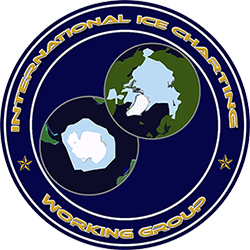
Organizing Committee:
Leif Toudal Pedersen (eolab.dk, IICWG-DAWG, DTU, Laurent Bertino (NERSC), Gilles Garric (MERCATOR OCEAN, ICE-ARC), Frank Kauker (OASys, AWI, ICE-ARC) and Greg Smith (ECCC, PPP, GOV).
Webpage and registration:
events.nersc.no/8th-international-workshop-sea-ice-modelling-data-assimilation-and-verification
24 March 2017: International sea ice experts meet in Bremerhaven next week
As in previous years, sea-ice prediction will again play a central role, with one desired outcome being the compilation of recommendations for the 2017 Sea Ice Outlook season. With regards to the Year of Polar Prediction, which will be officially launched in May 2017, the workshop also aims to stimulate discussion about other relevant predictands of the polar weather and climate system.
The workshop will start in the morning of Monday, March 27th with the Alfred Wegener Lecture given by Cecilia Bitz (Atmospheric Science Department, University of Washington).
From Monday noon to Wednesday noon, oral and poster presentation sessions as well as discussion sessions will cover different aspects of polar prediction (see for more information)
The last day of the workshop (Wednesday noon to Thursday noon) is devoted to discussions about the sea ice simulations from the upcoming CMIP6 experiments (SIMIP), with a focus on new observational datasets for model evaluation and analysis plans.
The International Coordination Office for Polar Prediction, based at the Alfred Wegener Institute Helmholtz Centre for Polar and Marine Research, is hosting the meeting that builds on a series of international workshops held in Boulder, USA (2014), Reading, UK (2015), and Palisades, USA (2016).
Online streaming is available but limited to a certain number of participants. If you like to participate in the workshop remotely, please send an email to office@polarprediction.net to request the information needed to connect.
15 March 2017: YOPP Side Meeting at ASSW2017
14 March 2017: YOPP Open Session at NOAA/NCEP (USA)
25 January 2017: Exchanging Prediction Information in Polar Regions
23 January 2017: YOPP Open Session at Polar Prediction Steering Group Meeting
The YOPP Open Session, which will be held in the morning of February 27th 2017 (YOPP Open Session agenda) provides an overview about the current level of YOPP planning and encourages discussion with the US community interested in YOPP. The agenda for the 8th meeting of the WMO WWRP PPP Steering Group, held from February 27th to March 1st is available here. For any question please contact office@polarprediction.net
12 January 2017: YOPP session at Canadian Meteorological and Oceanographic Society's 51st Congress
More information about the Congress can be found at http://congress.cmos.ca/.
Any questions on the conference and the YOPP session can be sent to Greg Smith, Meteorological Research Division, Environment and Climate Change Canada, gregory.smith2[at]canada.ca or to office@polarprediction.net
05 January 2017: EGU2017 session on "Polar Climate Predictability and Prediction
04 January 2017: Polar Prediction Workshop 2017 – Call for Abstracts now open
20 December 2016: Antarctic Circumnavigation Expedition (ACE) sets sail
The Antarctic Circumnavigation Expedition (ACE) is the first project of the recently launched Swiss Polar Institute (SPI). The Russian research vessel Akademik Tryoshnikov has been chartered for the interdisciplinary expedition where international scientists with various scientific backgrounds such as biology, climatology, or oceanography work in 22 different research projects. ACE leaves Cape Town, South Africa today in the late afternoon.
One of the researchers aboard the vessel is the atmospheric scientist Julia Schmale who is PI of the project ACE-SPACE. With her project over the Southern Ocean that is still considered as "the most pristine aerosol environment on Earth", Julia Schmale aims to find out how the atmosphere was like during pre-industrial times, before any human impact could change it. Her project ACE-SPACE has been endorsed by YOPP as it contributes to the Year of Polar Prediction objections to "enable a significant improvement in environmental prediction capabilities for the polar regions". During the three-months austral summer expedition, Julia Schmale will carry out on-board measurements in order to better understand "how emissions from the ocean to the atmosphere influence particles, how these particles form and grow in the air, and what they are chemically composed of" (see more about her project also the expedition's website). ACE-SPACE will thus improve the representation of aerosol-cloud interaction in models in order to better understand linkages between polar regions and lower latitudes. To find more about ACE-SPACE and the 21 other projects, follow Julia Schmale on her blog and learn more about this Southern Ocean cruise on the ACE expedition website and on twitter.19 December 2016: PolarPredictNews #02
Read in the PolarPredictNews #02 about the YOPP Task Teams that have been recently formed in order to advance preparations for the Year of Polar Prediction. Find out how you can get involved with the Year of Polar Prediction and make sure to save the dates of the Special Observing Periods (SOPs) that have just been finalized. The SOPs will be carried out to enhance routine observations for several weeks during the Year of Polar Prediction in the attempt to close the gaps in polar observing systems.
Amongst others, learn more about a recently completed international airborne experimental campaign which involved four research aircraft and 584 additional radiosondes to examine the jet stream and its role over Europe and the North Atlantic, and meet with the leader of the YOPP Task Team on Airborne Platforms, Manfred Wendisch, who coordinates a German Transregional Collaborative Research Centre to quantify the contribution of different atmospheric processes causing Arctic Amplification.
As with this newsletter, we are aiming to build a common platform to exchange information, updates, and developments in polar prediction, we are looking forward to your active contributions sharing your topics relevant to the community. Please send any information including announcements you would like to distribute via our newsletter to office@polarprediction.net.
16 December 2016: MOSAiC Workshop at ASSW2017
From April 4th to 5th, relevant topics of MOSAiC will be discussed at the Arctic Science Summit Week held from March 31st until April 7th 2017 in Prague, Czech Republic. The first year-round expedition into the central Arctic is anticipated to start in fall 2019. MOSAiC will significantly contribute to an enhanced understanding of the regional and global consequences of Arctic climate change and sea-ice loss as well as enhancements in weather and climate predictions. During the two-day workshop, presentations by MOSAiC teams will complement breakout sessions and a plenum discussion that provides participants with the opportunity to learn and discuss about this key international field campaign. Contributions in the form of posters are welcome by anyone interested in presenting their plans for MOSAiC. For poster abstract submission, the submission form at the MOSAiC website can be used http://www.mosaic-expedition.org/abstract.html The deadline for abstract submission is January 15th, 2017. More information (including the workshop program once finalized) can be found on the MOSAiC website. See for information also on the ASSW2017 and IASC websites.
14 December 2016: YOPP in the Southern Hemisphere planning meeting 2017
In conjunction with two other Antarctic-related meetings to be held June 26-30, 2017, the 12th Workshop on Antarctic Meteorology and Climate and the Southern Ocean Regional Panel (SORP) meeting, the Year of Polar Prediction in the Southern Hemisphere planning meeting will take place from June 28 (noon) to June 29 (noon). Modeling efforts such as the Antarctic Mesoscale Prediction System, observations both at Antarctic stations and during various field campaigns, as well as the collection of Southern Ocean data to feed into the YOPP data portal will be discussed. Effective participation of the oceanographic community in YOPP will be a key goal of the meeting. Abstract submission will be open until May 12, 2017. More information can be found on the workshop website as well as on the website on YOPP-SH maintained by the Polar Meteorology Group at the Byrd Polar and Climate Research Center. For any question, please contact the PPP International Coordination Office at office@polarprediction.net.
22 November 2016: Article on YOPP and PPP-SERA in Northern Notes autumn/winter issue 2017
The text entitled Understanding user needs to improve weather and environmental forecasts in the polar regions provides an overview on the research fostered by PPP-SERA during the duration of the Year of Polar Prediction from mid-2017 to mid-2019. Their research aims at better finding out how people can be supported in their daily living and working routine in the polar regions by improved weather and sea-ice forecasts. Northern Notes issue 46 can be downloaded here.
21 November 2016: YOPP Special Session at the 9th International Congress on Arctic Social Science (ICASS IX)
The deadline for abstract submissions is December 16. Please visit the conference website (http://iassa.org/icass-ix) to submit your abstract. Under the “Themes, Sessions, & Submission” tab, click on "Theme 17 - Research Methodologies”. Click the green “Submit” button, and then select session 17.15 to be included in the YOPP session. For any questions, please contact Gita (gita_ljubicic@carleton.ca) or Machiel (machiel.lamers@wur.nl)
Session Organizers:
Dr. Gita Ljubicic (Carleton University), Dr. Machiel Lamers (Wageningen University), Dr. Jackie Dawson (University of Ottawa), Dr. Maaike Knol (University of Tromsø)
17 November 2016: Polar Prediction Workshop 2017 – 2nd Circular
The International Coordination Office for Polar Prediction, based at the Alfred Wegener Institute Helmholtz Centre for Polar and Marine Research, is hosting the meeting that builds on a series of international workshops held in Boulder, USA (2014), Reading, UK (2015), and Palisades, USA (2016).
As in previous years, the focus will be on environmental prediction in the polar regions on subseasonal to
interannual timescales, thereby helping to build a „seamless“ polar prediction community. Sea ice prediction
will again play a central role, with one desired outcome being the compilation of recommendations for the 2017 Sea Ice Outlook season. With regards to the Year of Polar Prediction, which will be officially launched in May 2017, the workshop also aims to stimulate discussion about other relevant predictands of the polar weather and climate system.
For any questions, contact the International Coordination Office at office@polarprediction.net
Organisation Committee: Helge Goessling, Kirstin Werner, Cecilia Bitz, Ed Blanchard-Wrigglesworth,
Ed Hawkins, John Fyfe, Alexandra Jahn and Dirk Notz
16 November 2016: A data portal for the Year of Polar Prediction
The YOPP data portal will provide metadata and links to respective data sets generated during the Year of Polar Prediction. As a legacy for YOPP, this data portal will be developed taking into account the various requirements of end-users working with the YOPP data collection. A task team on the YOPP Data Component has been formed during the meeting which was hosted by the Norwegian Meteorological Institute. As the majority of data collected during observational campaigns as well as by modelling and verification efforts will be stored at national data centres and portals, the YOPP data portal will be particularly developed in close collaboration with those data centres which provide sufficient interoperability and work with the so-called FAIR Guideline Principles. Following these guidelines the data will be Findable, Accessable, Interoperable, and Re-usable. YOPP-endorsed projects and programmes will play a key role for the envisaged data management activities. More on the YOPP Data Component will be announced in due course here.
08 November 2016: INTERACT Transnational Access Call open
31 October 2016: 17th Annual Meeting of the International Ice Charting Working Group (IICWG)
19 October 2016: Advancing prediction capacity in the polar regions – Overview paper on the Polar Prediction Project now published in BAMS
The need for a dedicated polar prediction effort is outlined in the paper "Advancing polar prediction capabilities on daily to seasonal time scales" now published in the Bulletin of the American Meteorological Society (BAMS).
Anthropogenic climate change in polar regions comes with both new opportunities for the shipping industry but also higher risks for maritime accidents in ice-covered seas. Sufficient environmental prediction systems will be needed in order to ensure a peaceful and environmentally sensitive use of the future polar sea's potentials. In the paper now published in BAMS "possible ways forward in advancing prediction capacity in polar regions and beyond" are outlined. The authors identify certain research priorities that help fostering environmental polar prediction capabilities such as an improvement of the polar observing system; the use of coupled atmosphere-sea ice-ocean models; and insight into polar-lower latitude linkages and their role for forecasting. In order to rapidly progress, a coordinated international effort such as the Year of Polar Prediction (YOPP) from mid-2017 to mid-2019 will be needed. This period of intensive observing, modelling, prediction, verification, user-engagement and educational activities not only involves the international research and operational forecasting community but reaches out to various stakeholder groups to ensure polar forecast products adequately meet various users' needs.Reference: Jung, T., N. Gordon, P. Bauer, D. Bromwich, M. Chevallier, J. Day, J. Dawson, F. Doblas-Reyes, C. Fairall, H. Goessling, M. Holland, J. Inoue, T. Iversen, S. Klebe, P. Lemke, M. Losch, A. Makshtas, B. Mills, P. Nurmi, D. Perovich, P. Reid, I. Renfrew, G. Smith, G. Svensson, M. Tolstykh, and Q. Yang, 2016: Advancing polar prediction capabilities on daily to seasonal time scales. Bull. Amer. Meteor. Soc. doi:10.1175/BAMS-D-14-00246.1.
18 October 2016: PPP-SERA Meeting Report published in BAMS
17 October 2016: MEOPAR Expert Forum on Implementation of the Year of Polar Prediction
13 October 2016: Report on YOPP Planning Meetings online available
08 October 2016: The Abisko Polar Prediction School published online in BAMS
07 October 2016: ECMWF Interview with WMO's WWRP Chief Paolo Ruti

Picture: private
06 October 2016: PolarPredictNews #01
In this first issue, learn more about a flying laboratory and new colleagues joining the Polar Prediction Steering Group. Read about the preparation of the Year of Polar Prediction in Columbus, Ohio and Reading, UK, and meet with Dave Bromwich chatting about his YOPP-endorsed project in West Antarctica.
02 September 2016: Live Streaming of YOPP Planning Meetings next week in Reading, UK
In less than a year the Year of Polar Prediction Core Phase will be launched. In order to make further progress in the planning of the various activities during YOPP, the Planning Workshops on Arctic Observations and the YOPP Modelling Component will be held at ECMWF in Reading, UK, from September 5-7 and September 7-9, 2016, respectively. Invitees from operational centers, research institutes, universities, and initiatives from all over the world will plan on observational campaigns in the Arctic as well as various modelling activities such as forecasting experiments, dedicated reanalyses, or data denial experiments. During a Joint Session on Wednesday, September 7, from 9:00 am to 12:00 pm (GMT+1), modellers and observationals will be discussing on how to improve polar forecasting in a joint effort. Live streaming will be available throughout the week, from Monday 12:00 pm (GMT+1) to follow the meetings online. In order to join the meetings remotely, the agendas including the links to the web stream can be found here: Arctic Observations and the YOPP Modelling Component.
26 August 2016: New version of the Year of Polar Prediction Implementation Plan released
The new Implementation Plan (version 2.0) includes a number of changes that reflect important recent developments, in particular outcomes and decisions made at the YOPP Summit held last year in Geneva. Among the most significant changes are (i) a revised description of how the social component of YOPP will be implemented, (ii) an updated description of the coordination between YOPP and the international Arctic research initiative MOSAiC, (iii) a new section describing the YOPP endorsement process, and (iv) additional information on special and intensive observing periods during the Year of Polar Prediction. The Year of Polar Prediction (YOPP) is a major international activity that has been initiated by the World Meteorological Organization’s World Weather Research Programme (WWRP) as a key component of the Polar Prediction Project (PPP). During the Year of Polar Prediction scientists from various Arctic and Antarctic research fields work together with operational forecasting centers and people who rely on weather and sea-ice predictions in their everyday life. The Year of Polar Prediction initiative starts in mid-2017 with the goal to substantially improve environmental forecasts in polar regions. For further information please visit http://www.polarprediction.net/yopp/ or contact us at office@polarprediction.net
17 August 2016: Russian Aircraft Laboratory available for Arctic Environmental Studies
16 August 2016: Welcome to four new PPP Steering Group Members
Four new members are joining the Steering Group of the Polar Prediction Project this summer. Welcome to Barbara Casati, Jackie Dawson, Daniela Liggett, and Steffen M. Olsen who were elected new members during the 7th Steering Group meeting held this May in Beijing, China.
Barbara Casati is a research scientist working for Environmental and Climate Change Canada. She will support the Steering Group with her expertise in forecast verification. In polar regions verification poses particular challenges that will be addressed within YOPP.
Steffen Olsen is a lead scientist in coupled model systems and oceanography at the Danish Meteorological Institute (DMI) in Copenhagen, Denmark. Regionally focussed on the North Atlantic and Arctic, his expertise includes modelling of thermohaline processes and climate predictability studies. Steffen coordinates the new Arctic H2020 program Blue-Action and is involved in several YOPP-relevant EU-FP7 projects.
Jackie Dawson and Daniela Liggett are strengthening the social component of PPP and YOPP. Both are part of the PPP subcommittee on Societal and Economic Research Applications (PPP-SERA). Jackie Dawson is a professor at the University of Ottawa, Canada, and the director of the Environment, Society and Policy Group studying the human and political dimensions of environmental change. Daniela Liggett is a lecturer at the University of Canterbury, New Zealand, focussing on environmental management and tourism regulation in polar environments.
All members of the current PPP Steering Group are listed here.05 August 2016: Report on Planning Meeting for YOPP in the Southern Hemisphere available
03 August 2016: Online Request for YOPP Endorsement Launched

21 July 2016: Report from 7th PPP Steering Group Meeting now available
20 July 2016: AAS Special Issue Impact of a Rapidly Changing Arctic on Eurasian Climate and Weather
Description of the Special Issue:
The Arctic climate system has experienced many drastic changes during recent decades, such as its average surface air temperature increasing at around twice the global average rate, and a large decline in sea ice cover. At the same time, an increase in frequency of climate and weather extreme occurrences has also been observed. It has therefore been hypothesized that changes in mid-latitude atmospheric circulation and weather patterns may be attributable to Arctic climate change. Pronounced scientific controversy in testing this hypothesis, along with important socio-economic implications of a possible Arctic-Eurasia climate linkage, makes this one of the most timely and attractive scientific topics in climate research.
This special issue will showcase recent progresses in our understanding of the coupling between Arctic climate change and Eurasian mid-latitude climate and weather, including extremes. The compilation of the research papers in this special issue is expected to fill key scientific gaps and hence contribute to a more thorough understanding of the problem. Submissions in, but not limited to, the following research areas, are invited:
- Observational and statistical evidence of changes in Eurasian weather and climate, as well as occurrence of extremes, in conjunction with changes in Arctic climate;
- Detection and attribution of linkages between Arctic climate change and Eurasian midlatitude climate and weather based on observations and numerical model experiments;
- Evaluation of uncertainties and their potential impacts on Arctic-Eurasia linkages arising from the use of relatively short observational records and caused by model deficiencies.
20 July 2016: AGU 2016 Fall Meeting Session on Sustained observations of rapid Arctic change
A rapidly changing Arctic challenges our ability to predict and effectively respond to major environmental and socio-economic transformations underway in the North and reverberating throughout the global system. Sustained observations of key variables and processes that capture variability, long-term trends and regime shifts, including high resolution paleoclimate records, are central to furthering understanding of the drivers and impacts of change, the development of prediction systems from sub-seasonal to decadal timescales and to the implementation of adaptation and mitigation measures. This session welcomes presentations that describe major findings and lessons learned from existing observing efforts at high and mid latitudes, as well as those that address the full range of scientific issues underlying development and implementation of Arctic observing systems, such as advances in the science and technology of sustained observations (incl. autonomous sensor systems), observing system design and implementation. Organizers of this session (Hajo Eicken, Julie Brigham-Grette, Craig Lee and Peter Schlosser) welcome any contributions on the potential role of YOPP in the context of sustained observations, such as providing guidance on sensor placement, the role of sustained observations in the context of synoptic, seasonal and inter annual predictions etc. More information can be found here.
04 July 2016: Arctic Predictability dataset APPOSITE now published
24 June 2016: Dynamics of Atmosphere-Ice-Ocean Interactions in the High Latitudes – Workshop Report now available online
The report on the workshop Dynamics of Atmosphere-Ice-Ocean Interactions in the High Latitudes has now been published online in the Bulletin of the American Meteorological Society. From 23-27 March, 90 scientists from 13 different countries gathered in the scenic fjord village of Rosendal, Norway, in order to discuss our current understanding of the physical processes for weather and climate prediction, significantly relevant for PPP and YOPP. Participants agreed that for a comprehensive coupling of atmospheric processes with sea ice and ocean conditions in future forecast models corresponding time scales need to be considered carefully. Advances in forecasting skills also means to better understand the human impact to natural weather and climate systems. The report by Thomas Spenger et al. can be downloaded at http://journals.ametsoc.org/doi/pdf/10.1175/BAMS-D-15-00302.1. Reference: Spengler, T., I. Renfrew, A. Terpstra, M. Tjernström, J. Screen, I. Brooks, A., Carleton, D. Chechin, L. Chen, J. Doyle, I. Esau, P. Hezel, T. Jung, T. Kohyama, C. Lüpkes, K. McCusker, T. Nygård, D. Sergeev, M. Shupe, H. Sodemann, and T. Vihma, 2016: High Latitude Dynamics of Atmosphere-Ice-Ocean Interactions. Bull. Amer. Meteor. Soc. doi:10.1175/BAMS-D-15-00302.1, in press.07 June 2016: SAVE THE DATE – Polar Prediction Workshop 2017
The 4th Polar Prediction Workshop is scheduled for 27-29 March 2017. Jointly organised by the Polar Climate Predictability Initiative (WCRP-PCPI), the Polar Prediction Project (WWRP-PPP), and the Sea Ice Prediction Network (ARCUS-SIPN), the workshop will be hosted by the International Coordination Office for Polar Prediction at the Alfred Wegener Institute in Bremerhaven, Germany.The workshop will build on a series of international workshops held in Boulder, USA (2014), Reading, UK (2015), and Palisades, USA (2016). As in previous years, the focus will be on environmental prediction in the polar regions on a wide range of timescales, thereby helping to build a „seamless“ polar prediction community. Sea ice will again play a central role, with one desired outcome being the compilation of recommendations for the 2017 Sea Ice Outlook season. However, the workshop also aims to stimulate discussion on other interesting predictands of the polar weather and climate system.
Details will be announced in due course here.
Workshop Organisers: Cecilia Bitz, Helge Goessling, Kirstin Werner, Ed Blanchard-Wrigglesworth, Ed Hawkins, and John Fyfe
06 June 2016: International Arctic Climate & Environment Young Scientists School in Russian Arctic, Apatity, Kola Peninsula
The International school-conference for young scientists “Climate, geography andenvironment of the Russian Arctic” will take place in Apatity town, Murmansk region, in Russia from 4-10 September 2016. Registration is now open for Bachelor, Master or PhD students and any other young scientists. No registration fee is required. Travel and accommodation costs are covered by participants. For more information and registration please go on the conference website apatity2016.ru
02 June 2016: PPP-SERA meeting report now available online
From 18-22 April 2016, the Societal and Economic Research and Applications (SERA) sub-committee of PPP convened for the second time for their annual organizing meeting at Gateway Antarctica, Canterbury University in Christchurch, New Zealand. The meeting report which is now available online provides an overview of the working group's future plans to help collaborating with stakeholders of PPP and YOPP such as forecasting services and their individual users. Download the report here.01 June 2016: New WMO Consultant appointed for the International Coordination Office for Polar Prediction
Richard Swinbank has been appointed as the new WMO Consultant supporting the International Coordination Office for Polar Prediction in PPP and YOPP activities. The atmospheric scientist has managed the ensemble forecasting research group of the Met Office in Exeter, United Kingdom. In particular, he has worked for the Met Office's contribution TIGGE as part of the international research programme THORPEX which aimed at improving the accuracy of short- and medium-range weather forecasts. Richard was also founding co-chair of the WWRP working group on Predictability, Dynamics and Ensemble Forecasting.17 May 2016: Paving the Way for the Year of Polar Prediction – Finalized Meeting Summary of YOPP Summit available online
On May 14th, the finalized version of the YOPP Summit meeting summary has been published online in the Bulletin of the American Meteorological Society (BAMS). The paper with the above title gives a concise overview of important decisions made at the YOPP Summit. Strategies and the elements for the implementation of the Year of Polar Prediction were discussed and further developed during the summit that took place from 13-15 July 2015 in Geneva. Goessling, H. F., Jung, T., Klebe, S., Baeseman, J., Bauer, P , Chen, P., Chevallier, M., Dole, R., Gordon, N., Ruti, P., Bradley, A., Bromwich, D. H., Casati, B., Chechin, D., Day, J. J., Massonnet, F., Mills, B., Renfrew, I., Smith, G. and Tatusko, R. (2015): Paving the Way for the Year of Polar Prediction, Bulletin of the American Meteorological Society. doi: 10.1175/BAMS-D-15-00270.109 May 2016: PPP is co-sponsoring CLIVAR Workshop 'Arctic Change & Its Influence on Mid-Latitude Climate & Weather'
From February 1-3, 2017, the workshop 'Arctic Change & Its Influence on Mid-Latitude Climate & Weather' will be held at Georgetown University, Washington, DC. PPP is one of the co-sponsors of the workshop that is organized by the US Climate Variability and Predictability Program (CLIVAR). During the workshop possible links between Arctic change and mid-latitude climate and weather that has spurred a rush of new observational and modeling studies will be discussed. More information is available here.Download the workshop flyer (pdf).
04 May 2016: New Project Officer for the International Coordination Office for Polar Prediction
This week Kirstin Werner joined the International Coordination Office for Polar Prediction at the Alfred Wegener Institute in Bremerhaven. As the project officer, she will be supporting the ICO team in PPP and YOPP activities. Kirstin did her PhD at GEOMAR Kiel where she studied the Arctic oceanographic and sea-ice variability over the past ca 12,000 years in high-resolution sediment cores from the eastern Fram Strait. She has worked as a postdoc in the US, at the Institute for Arctic and Alpine Research in Boulder, Colorado and the Byrd Polar and Climate Research Center in Columbus, Ohio. Recently, Kirstin started an 'on the job' master program in the field of science marketing at Technical University Berlin.27 April 2016: Transfer between information-providers and stakeholders under focus
The YOPP sub-committee on Societal and Economic Research and Applications convened in Christchurch, New Zealand, 18-22 April, under the leads of Brian Mills, ECCC, Canada, and Jackie Dawson, University of Ottawa, Canada, to discuss future improvements in knowledge transfer. A brief report of the outcomes will soon be made available.19 April 2016: Impressions of the Abisko Polar Prediction School
The first Polar Prediction School ended on 14 April 2016. The feedback from students and lecturers is very clear: PPS2016 was a great success! View some impressions on Storify: https://storify.com/meteodenny/pps201607 April 2016: Polar Prediction School at Abisko commenced
First experiments and measurements were carried out in Swedish Abisko by 28 polar early career scientist who gathered for the first school on polar prediction organized by the Bolin Centre, CliC/WCRP, and PPP. From April 5-15 the young scientists will acquire a better understanding for the rapid changes in the polar regions and the necessity of enhanced polar prediction capabilities as a crucial tool for environmental services systems. Instructors from Sweden, France, Norway, UK, US, and Germany have prepared a comprehensive set of lecutres, exercises, and field experiments and are looking forward to share their knowledge.16 March 2016: QJRMS special issue on polar prediction online
A special section of the Quarterly Journal of the Royal Meteorological Society dedicated to polar prediction has been published online. You will find a collection of articles that provides an assessment of the current state of the art of weather prediction of the polar regions, and provides guidance for future research priorities needed to advance our predictive capabilities. View special14 March 2016: YOPP features at ASSW2016
The Year of Polar Prediction (YOPP) features at several sessions during the Arctic Science Summit Week 2016 at UAF, Fairbanks, Alaska. Next YOPP event is Monday, March 14, 5pm local time, UAF campus, Duckering building, room 252. Conveners: Thomas Jung, Renee Tatusko. View agenda.09 February 2016: Additional funding for outreach and knowledge transfer component within the International Coordination Office (ICO) secured
Winfried Hoke has recently joined the ICO at the Alfred-Wegener-Institute in Bremerhaven. For the preparation of the Year of Polar Prediction Project, he will further the Outreach and Knowledge Transfer component in close cooperation with PPP’s societal and economic research applications (SERA) committee within a project funded by the Earth System Knowledge Platform (ESKP) of the Helmholtz Association. Winfried Hoke completed the master programme ‘Natural Resources Management and Ecological Engineering’ at University of Natural Resources and Life Sciences, Austria and at Lincoln University, New Zealand.03 February 2016: Polar Predictability Workshop 2016 - Call for Abstracts
The Polar Predictability Workshop 2016, co-organized and co-sponsored by the Lamont-Doherty Earth Observatory, the Sea Ice Prediction Network, the Polar Climate Predictability Initiative, and the Polar Prediction Project, will be held 4-6 May in Palisades, New York. Read more, submit an abstract, and/or register on the workshop page.02 February 2016: YOPP-UK workshop report available
UK scientists met to discuss the UK's contribution to the Year of Polar Prediction. A workshop report is now available on the science workshops page.26 January 2016: Rick Thoman joins the Societal and Economic Research Applications committee for the Polar Prediction Project
With three decades professional experience in the western science side of high latitude weather and climate and working with Athabascan communities in Alaska as a linguist, Rick intends to bring in a prospective to SERA that will help bridge two quite different worldviews. Each has important assets to offer the other, and with sustained partnerships and working together in a respectful manner, science and indigenous communities can achieve more than either can alone and will help keep the North a place to work, play and call home. Welcome to the Polar Prediction Project (PPP) and the Year of Polar Prediction (YOPP), Rick!20 January 2016: How to improve polar prediction capacity? BAMS paper Early View Online Version available
An overview paper summarizing PPP's approach to advance polar prediction capabilities on daily to seasonal time scales has just been published online in BAMS, the Bulletin of the American Meteorological Society at http://journals.ametsoc.org/doi/abs/10.1175/BAMS-D-14-00246.1Reference: Jung, T., N. Gordon, P. Bauer, D. Bromwich, M. Chevallier, J. Day, J. Dawson, F. Doblas-Reyes, C. Fairall, H. Goessling, M. Holland, J. Inoue, T. Iversen, S. Klebe, P. Lemke, M. Losch, A. Makshtas, B. Mills, P. Nurmi, D. Perovich, P. Reid, I. Renfrew, G. Smith, G. Svensson, M. Tolstykh, and Q. Yang, 2016: Advancing polar prediction capabilities on daily to seasonal time scales. Bull. Amer. Meteor.
Soc. doi:10.1175/BAMS-D-14-00246.1, in press.
15 January 2016: Vacancy at AWI Bremerhaven - Project Officer position in the International Coordination Office (ICO) for Polar Prediction
The International Coordination Office (ICO) for Polar Prediction is hosted by the Alfred Wegener Institute Bremerhaven, Germany. We are seeking to appoint a Project Officer to support the management and implementation of the Year of Polar Prediction (YOPP) and the Polar Prediction Project (PPP). www.awi.de/nc/en/work-study/jobs/job-offer/detail/jobs/12gkli-project-officer-in-the-international-coordination-office-ico-for-polar-prediction.html07 January 2016: Meeting summary "Polar-lower latitude linkages" published
The "Polar-lower latitude linkages" workshop that was held in Barcelona, Spain, in late 2014 formulated recommendations how to foster the current understanding of the polar-lower latitude linkages and their role for weather and climate prediction. Read more about the atmospheric and oceanic linkages from the prediction and services perspective.27 November 2015: Read how "Additional Arctic observations improve weather and sea-ice forecasts for the Northern Sea Route"
New Scientific Report by Inoue et al. now online open at http://www.nature.com/articles/srep1686818 November 2015: 7th IICWG International Workshop on Sea Ice Data Assimilation and Verification - Call for abstracts open
The call for abstracts for the7th IICWG International Workshop on Sea Ice Data Assimilation and Verification is open now.This joint workshop between the International Ice Charting Working Group (IICWG), the World Weather Research Programme (WWRP) Polar Prediction Project (PPP), WWRP Joint Working Group on Forecast Verification Research (JWGFVR) and GODAE Oceanview (GOV) will be held 5-7 April 2016 at ESA(ESRIN), Frascati, Italy.
Open workshop page
10 November 2015: Paving the Way for the Year of Polar Prediction
A paper with the above title has been published in the Bulletin of the American Meteorological Society (BAMS). The paper gives a concise overview of important decisions made at the YOPP Summit that took place in July in Geneva: link .05 November 2015: First projects endorsed
The launch of the endorsement process for YOPP was well received in the community and triggered a dozen proposals in the first weeks. So far, three requests for endorsement were reviewed by the PPP steering group and formally endorsed. FAMOS, the MOSAiC project, and additional radiosondes for upper air soundings from Polarstern and automatic weather stations (AWS) on the Antarctic continent through AWI were the first projects endorsed. The review process for all proposals submitted is continuing.22 October 2015: YOPP endorsement process launched
Since a few days the YOPP endorsement process is up and running. The Steering Group of the Polar Prediction Project (PPP) provides endorsement for projects, programs, and initiatives that plan to contribute to the aims of the Year of Polar Prediction (YOPP): click here .07 October 2015: YOPP representation at ICSHMO, Santiago, Chile
At the 11th Session of the International Conference on Southern Hemisphere Meteorology and Oceanography, 05-09 October 2015, Santiago, Chile, PPP & YOPP were respresented by Neil D. Gordon, Otaki, New Zealand.Download presentation, http://www.icshmo-2015.com/index.php
02 October 2015: The Arctic Circle in 2050: Charting a new course through the last frontier
A televised panel discussion moderated by David Eades from BBC World on Saturday, 17 October, 15.30-17.00 as part of the Arctic Circle meeting. Join the panel of world-leading experts as they discuss what climate and weather information will be needed to successfully journey through the Arctic Circle in 2050.16 September 2015: New article on polar-lower latitude linkages now online
An article on Polar-lower latitude linkages and theit role in weather and climate prediction by Francois Massonnet is now available in Physics Today athttp://scitation.aip.org/content/aip/magazine/physicstoday/article/68/9/10.1063/PT.3.2894;jsessionid=36u51jdorimt.x-aip-live-06
04 September 2015: YOPP Summit Final Report available
The YOPP Summit for the preparation of the Year of Polar Prediction was held 13-15 July at WMO Headquarters in Geneva, Switzerland. The meeting report is now available.28 August 2015: Final report of the 6th Steering Group Meeting available
The final report of the 6th Steering Group Meeting of the Polar Prediction Project, held 15-16 July at WMO Headquarters in Geneva, Switzerland, is now available here.25 August 2015: Workshop on Arctic-Central U.S. hydrology linkages announced
Registration is now open for the workshop 'Implications of a Changing Arctic on Water Resources and Agriculture in the Central U.S.' to be held at the University of Nebraska-Lincoln from November 10-12, 2015. For more information and to register for the workshop, visit the website http://go.unl.edu/arcticclimateworkshop10 August 2015: SOOS-SORP Comment on YOPP Implementation Plan Published
The Southern Ocean Observing System (SOOS) and Southern Ocean Regional Panel (SORP) have published a comment on the Year of Polar Prediction (YOPP) Implementation Plan: https://zenodo.org/record/27261?ln=en#.VciZIYuWZAw
31 July 2015: Call for AOS 2016 White Papers and Short Statements: NOW OPEN!
The Arctic Observing Summit Executive Organizing Committee now welcomes community input and the submission of white papers on the AOS 2016 themes:
- International and national strategies for sustained support of long-term Arctic observing
- Technology and innovation for sustained Arctic observations
- Contributions of the Private Sector and Industry to sustained Arctic observations
- Actor and Stakeholder engagement and needs in sustained Arctic observations
- Arctic Observations in the context of Global Observing initiatives
- Interfacing Traditional Knowledge, Community-based Monitoring and Scientific Methods for sustained Arctic observations
09 July 2015: YOPP Summit to commence Monday, 13 July
To inform about and to finalize planning for the Year of Polar Prediction (YOPP) is the main goal of the YOPP Summit that will commence on Monday, 13 July, at 1pm at WMO headquarters in Geneva. Stakeholder and science sessions as well as discussions in plenaries and breakout groups will be used to engage natural and social scientists, stakeholders, representatives of operational weather and climate prediction centres, international organizations, univiersities and funding agencies into the planning to make YOPP a community effort and success.
Live streaming of the plenary sessions will be available at www.wmo.int/yopp
29 June 2015: WWOSC Book now online
The WWOSC book „Seamless Prediction of the Earth System: from Minutes to Month“ (chapter 19 on PPP) is now available online at http://library.wmo.int/pmb_ged/wmo_1156_en.pdf. Hard copies are expected for September. World Meteorological Organization, 2015: Seamless Prediction of the Earth System: from Minutes to Months, (G Brunet, S Jones, PM Ruti Eds.), (WMO-No. 1156), (ISBN 978-92-63-11156-2), Geneva.17 June 2015: Improved polar prediction is part of one of seven WMO priorities for the period 2016-2019
World Meteorological Congress agrees priorities for 2016-2019 Read more at https://www.wmo.int/media/content/world-meteorological-congress-agrees-priorities-2016-201916 June 2015: Call for abstracts: Session on polar-lower latitude linkages at AGU Fall Meeting, 14-18 December 2015, San Francisco.
Abstract submission now open for a session on "Predictability of Subarctic Weather: Internal Variability, Teleconnections, and Local Forcing". Session details10 June 2015: Linkages workshop report available as early online release
An early online release of the report of the workshop on "Polar-lower latitude linkages and their role in weather and climate prediction" has been published in the Bulletin of the American Meteorological Society. View report13 May 2015: BAMS paper discusses the future of three THORPEX legacy projects
The discussion outcomes of a U.S. community meeting about the future of the three THORPEX legacy projects PPP, S2S and HIWeather were published in a BAMS paper which suggests the development of an integrated, multiagency programme including the elaboration of a science plan. Read more...08 May 2015: APECS-WWRP-Polar Prediction Project Online Seminar Series - Part 2: Progress and,Challenges in Predicting Arctic Sea Ice on May 11, 18:00 CET
This seminar is the second in the APECS-WWRP-Polar Prediction Project Online Seminar Series. The speakers are Cecilia Bitz (University of Washington, USA) and Julienne Stroeve (National Snow and Ice Data Centre/University of Colorado) Registration URL: https://attendee.gotowebinar.com/register/174329034268135426
The seminar will be recorded and archived afterwards in the APECS Past Webinar list http://www.apecs.is/career-resources/apecs-webinars/past-webinars.html
17 April 2015: Fast access to CryoSat's Arctic ice measurements now available
13 April 2015: Latest Mercator Ocean Quarterly Newsletter features YOPP
The latest Mercator Ocean Quarterly Newsletter issue #51 dedicated to sea ice modelling and data assimilation is now available at: http://www.mercator-ocean.fr/eng/actualites-agenda/newsletter/newsletter-Newsletter-51-Special-Issue-with-ICE-ARC Chapter 3 presents the challenges and opportunities of YOPP (The Year of Polar Prediction).30 March 2015: Workshop Résumé available
A résumé of the "Polar-Lower Latitude Linkages Workshop" that took place in Barcelona from 10-12 December 2014 is now available at http://www.polarprediction.net/linkages/resume.html A set of recommendations is currently being compiled and will be available as workshop report very soon.23 March 2015: High Latitude Dynamics Workshop starting today
Polar scientists have assembled in Rosendal, Norway, to discuss the dynamics of polar weather and climate. The workshop goal is to summarize our fundamental understanding and description of small-scale processes in the coupled atmosphere-ocean-ice climate system at high latitudes in order to assess and reduce bias and uncertainties in weather prediction and climate models. Read more at http://highlatdynamics.b.uib.no.17 March 2015: APECS Online Seminar on Polar Environment Prediction now on vimeo
Thomas Jung introduces the Polar Prediction Project. View the presentation on vimeo at https://vimeo.com/122323499

04 March 2015: IARPC Online Seminar Series on YOPP on March 17, 3 to 4pm EDT
Online seminar series on the Year of Polar Prediction (YOPP) with Drs Don Perovich, Marika Hollands, and David Bromwich.
Read more at http://www.iarpccollaborations.org/events/1892
Connect to this event via WebEx or teleconference at bit.ly/YoPP15
03 March 2015: UK-Report "Responding to a Changing Arctic" recommends to support Arctic science
In their recently published report "Responding to a Changing Arctic" the UK's House of Lords Arctic Committee recommends to support Arctic science more strongly.The requirement for improved environmental prediction is mentioned numerous times in the report and in many contexts and refers to the written evidence submitted by the PPP Steering Group.
The report is UK-focused, and very wide ranging, covering science, societal impacts and change, politics, industry and security issues. One key recommendation is "... that the Government looks to establish a substantial and better co-ordinated long-term programme of Arctic research […]“
Read more at http://www.parliament.uk/business/committees/committees-a-z/lords-select/arcticcom/news/report-published/
26 February 2015: WWRP/WCRP/Bolin Centre Polar Prediction School
A Polar Prediction School will be held at the Abisko Field Station in Arctic Sweden from 5-15 April 2016 sponsored by WWRP, WCRP, and the Bolin Center. The school is part of the WWRP Polar Prediction Project and the WCRP Polar Climate Predictability Initiative.This course on Polar Prediction will provide training for 30 PhD and early career post-doctoral polar scientists, focusing on topics such as: polar mesoscale atmospheric processes; sea ice prediction, near term ensemble prediction, and seasonal-to-decadal climate variability and prediction in the polar regions. The program will combine lectures on key areas relevant for polar prediction and a number of field observation and modelling exercises to foster an interactive learning environment.
We are asking for people interested in this school to fill out the Expression of Interest form by 15 May. You can find the form here: http://www.climate-cryosphere.org/wcrp/pcpi/meetings/abisko-pp-2016/expression-of-interest
Limited travel support may be available, particularly for participants from developing countries.
For more information on the school, visit http://www.climate-cryosphere.org/wcrp/pcpi/meetings/abisko-pp-2016. For any questions, contact Jonny Day <j.j.day@reading.ac.uk>

24 February 2015: APECS-WWRP-Polar Prediction Project Online Seminar Series - Part 1: Polar Weather Prediction
New APECS online seminar series in Spring 2015. The first online course in this series on 2 March at 16 CET with the title "Polar Weather Prediction"will introduce Professor Dr. Thomas Jung, chair of the Polar Prediction Project, read more...
4 February 2015: Polar Predictability Workshop - Call for Abstracts
The "Polar Predictability Workshop", to be held April 8th-10th 2015 at the University of Reading, UK, will discuss polar climate variability & predictability on seasonal to decadal timescales. Abstracts for talks or posters are encouraged for sessions on understanding causes of polar climate variability in observations and models, idealised predictability studies, operational polar forecasts and use of polar predictions by stakeholders. Submission deadline is Friday, 20th February. For more info, see the workshop website.19 January 2015: WCRP launches Polar Challenge
The World Climate Research Program (WCRP) is launching a Polar Challenge to reward the first team able to send an Autonomous Underwater Vehicle (AUV) for a 2000km mission under the sea-ice in the Arctic or Antarctic. The ultimate aim is to demonstrate a sorely-needed monitoring tool for the Polar regions to expand scientific research capabilities and climate services in both the Arctic and Antarctic. Data collected by such vehicles can potentially make a strong contribution to improved polar predictions. Find out more at http://www.wcrp-climate.org/index.php/polarchallenge.17 December 2014: International workshop on Polar-lower latitude linkages held in Barcelona
80 experts from 20 different countries met in Barcelona, Spain, from 10-12 December 2014 to discuss extensively about Polar-lower latitude linkages and their role in weather and climate prediction, one of the flagship activities of the Polar Prediction Project. A workshop report and recorded talks will be made available early next year. For details, see the workshop page.9 December 2014: Workshop on polar-mid latitude linkages begins tomorrow - online participation possible!
The WWRP-WCRP "International workshop on polar-lower latitude linkages and their role in weather and climate prediction" begins tomorrow, December 10, in Barcelona. Experts from all over the world will meet to discuss this subject which is also an important aspect of the Polar Prediction Project. We encourage anyone interested to attend this important event online via the GoToWebinar platform (kindly provided by the CliC Project Office). You can find all relevant information on the workshop page.19 November 2014: PPP Progress Report at WWRP Scientific Steering Committee
Thomas Jung presented progress on the development and implementation of PPP to the Scientific Steering Committee of the World Weather Research Programme at their latest meeting in Geneva, Switzerland. The presentation along with a progress report is available at http://www.wmo.int/pages/prog/arep/wwrp/new/documentation_plan_WWRSSC7_2014.html19 November 2014: Year Of Polar Prediction - Implementation Plan released
we are pleased to let you know that the Implementation Plan for the Year of Polar Prediction (YOPP) has been officially released. It is available at http://www.polarprediction.net/documents.html. YOPP is a key activity of the WMO/WWRP Polar Prediction Project (PPP) and aims to enable a significant improvement in environmental prediction capabilities for the polar regions and beyond, by coordinating a period of intensive observing, modelling, prediction, verification, user-engagement and education activities.We would like to point out that YOPP is a community effort and that everyone interested is invited to make contributions. For further information visit http://www.polarprediction.net or contact helge.goessling@awi.de.
18 November 2014: The PPP steering group welcomes four new members
We are happy to announce that four outstanding scientists have joined the PPP steering group: Jun Inoue (top left) from the National Institute of Polar Research, Japan; Alexander Makshtas (top right) from the Arctic and Antarctic Research Institute, Russia; Matthieu Chevallier (bottom left) from the National Centre for Meteorological Research, France; and Qinghua Yang (bottom right) from the National Marine Environmental Forecasting Center, China. These new members, reflecting the international composition of the steering group, are an important addition to move PPP and the Year of Polar Prediction forward. Welcome aboard!29 October 2014: Could forecasting problems put Arctic shipping plans on ice?
PPP steering group member Jonny Day and colleagues at the University of Reading demonstrate the importance of proper sea-ice thickness initialisation for skillful sea-ice predictions. This research highlights the need for better sea-ice thickness observations and thus corroborates the importance of additional observations to be taken within the PPP Year Of Polar Prediction. Read the press release and the corresponding publication!08 October 2014: New mailing list for prediction and predictability in polar regions
Arctic and Antarctic weather and climate prediction and predictability issues are high up on the polar (research) communities' agenda. A vast amount of information is available in different media. To help connect sending and receiving parties, a dedicated electronic mailing list tailored to people interested in Arctic and Antarctic prediction and predictability is being set up by CliC and the ICO for Polar Prediction. We will strive to keep you informed about upcoming events, recent findings, new papers and developments. To be added to the list, please send an email to info@climate-cryosphere.org with the subject line: subscribe prediction mailing list. Members of the list will be able to post directly. If you are not a member and you would like to send something, please send your message to Stefanie Klebe <stefanie.klebe@awi.de>. We encourage you to forward this announcement to your colleagues.06 October 2014: PPP chairman Thomas Jung attended the 4th meeting of WMO's Polar Satellite Task Group
The meeting was held on 29 September 2014 at NASA Goddard Space Flight Centre in Maryland, US. PPP has been invited by the space agencies to develop a document outlining the satellite requirements necessary to advance polar prediction capabilities in the framework of the Year of Polar Prediction (YOPP)01 Oct 2014: Helge Goessling appointed director of International Coordination Office (ICO) for Polar Prediction
As of today climate scientist Helge Goessling serves as director of the ICO for Polar Prediction. Together with the chairman of the Polar Prediction Project Thomas Jung and the Steering Group he will foster collaboration between international projects, initiatives, and programmes related to polar prediction research. One of his major tasks will be the promotion of the Year of Polar Prediction (YOPP) planned for mid-2017 to mid-2019.30 Sep 2014: House of Lords Committee on the Arctic publishes call for evidence
Today PPP Steering Group members submitted written evidence to the UK Parliament on the state of weather and environmental prediction in the Arctic. The House of Lords Select Committee for the Arctic is in the process of gathering written evidence and will report in February 2015. The call for evidence is available at http://www.parliament.uk/business/committees/committees-a-z/lords-select/arcticcom/news/arctic-call-for-evidence/ Read the PPP submission17 Sep 2014: Workshop on the Dynamics of Atmosphere-Ice-Ocean Interactions in the High-Latitudes in March 2015
The workshop aims to summarise our fundamental understanding and description of small-scale processes in the coupled atmosphere-ocean-ice climate system at high latitudes in order to assess and reduce bias and uncertainties in weather prediction and climate models. 23-27 March, 2015. Application deadline 8 October 2014 http://highlatdynamics.b.uib.no/19 June 2014: Arctic influence on subseasonal mid-latitude prediction
A new paper, published in the journal Geophysical Research Letters, shows that improved Arctic prediction capabilities do have a beneficial influence on weather forecasts in mid-latitudes, especially over Asia, Eastern Europe and North America. http://onlinelibrary.wiley.com/doi/10.1002/2014GL059961/abstract13 May 2014: Thomas Jung visits NMEFC in Beijing, China
Thomas Jung,chair of the WWRP Polar Prediction Project (PPP), visited the National Marine Environmental Forecasting Centre (NMEFC) on 13 May 2014 to discuss possible future contributions of NMEFC to PPP. Photo: Prof. Hui Wang, director general of NMEFC, and Prof. Thomas Jung, chair of the WWRP Polar Prediction Project07 May 2014: Final report of YOPP Planning Meeting #2 available
Download final report05 May 2014: David Carlson appointed WCRP Joint Planning Staff Director
...and will take duty in June 2014. Read more: http://www.wcrp-climate.org/07 April 2014: WMO Bulletin 63(1) 2014 online
The latest WMO Bulletin is online and includes a contribution by the Polar Prediction Project (PPP). View Bulletin, view PPP article.02 April 2014: ASSW and AOS with participation of PPP
The Arctic Science Summit Week (ASSW) and the Arctic Observing Summit (AOS) in Helsinki are approaching. The Polar Prediction Project (PPP) will be represented with their second planning meeting (YPM-2) for the Year of Polar Prediction (YOPP) April 8 2014. Thomas Jung, chair of PPP, will serve as one of the panelists in the AOS "Stakeholder Integration in Arctic Observation" session April 9. A townhall meeting and panel in the evening of April 9 will discuss three main questions related to polar prediction: What is holding us back? What are the observational needs? How can stakeholders best be involved and what services do they need?13 February 2014: Draft YOPP plan available
The PPP steering group has developed a draft version of the YOPP Implementation Plan. The international community is invited to provide feedback to office@polarprediction.net by end of April 2014. View draft plan09 January 2014: "Polar regions under climate change" public lecture
View and listen to Prof. Peter Lemke, former PPP Steering Group Member, in a public seminar on "The polar regions under climate change" in a lecture series of IIASA and the Austrian Academy of Sciences: Listen to his lecture on YouTube31 December 2013: PPP session at WWOSC 2014
The World Weather Open Science Conference in Montreal, 16-21 August 2014 offers a session on Polar Prediction convened by members of the PPP steering group. Drs. Marika Holland (NCAR) and David Bromwich (Byrd Polar Research Center) have confirmed their invited talks. The call for abstracts and registration is open now: http://wwosc2014.org/welcome_e.shtml20 December 2013: International workshop on verification methods: Abstract submission by 15th January 2014
The call for abstract for the 6th International Verification Methods Workshop is open until 15th January 2014.09 December 2013: PPP mentioned favourably during WMO's November CAS session in Antalya
The Sixteenth Session of the Commission for Atmospheric Sciences (CAS-16) was held in late November in Antalya, Turkey. During the session the Commission noted the progress made in the implementation of the Polar Prediction Project (PPP) so far and encouraged all WMO members to engage in the planning process of the Year of Polar Prediction (YOPP). Read more about CAS-16 and, more general, on the WMO-CAS pages.03 December 2013: SAVE THE DATE of the next PPP SG-meeting
The fifth Steering Group Meeting SG-5 is scheduled for 22-23 August 2014, Montreal, Canada. View PPP meetings schedule01-03 October 2013: 4th Steering Group Meeting at NCAR and NOAA, Boulder, CO
The Steering Group met for the fourth time. One of the points the Steering Group discussed was the Implementation Plan for YOPP, the Year of Polar Prediction, which will be available for download after revision. Read more about SG-426 September 2013: Memorandum of Understanding between WMO and AWI signed
The Memorandum of Understanding between World Meteorological Organization (WMO) and Alfred Wegener Institute (AWI) has been signed which assigns AWI the hosting of the International Coordation Office for the Polar Prediction Project.16 August 2013: New members in PPP Steering Group
WMO has appointed new members to the Polar Prediction Project Steering Group: Francisco Javier Doblas-Reyes of the Catalan Institute of Climate Sciences will serve as full member to the Steering Group. So will Phillip Reid of the Bureau of Meteorology, Australia. Jonathan Day of the University of Reading, Department of Meteorology, has been appointed a liaison member to the project.
13 August 2013: WWRP-THORPEX workhop on polar prediction: Final report available
The WWRP-THORPEX workshop on polar prediction was held 24-27 June at ECMWF, Reading. About 40 experts discussed questions on predictability and forecast error diagnosis, teleconnections, data assimilation, representation of polar key processes in (coupled) modelling, and polar observing systems. Download final report. ECMWF link28 June 2013: YOPP planning meeting #1
The first planning meeting for the Year of Polar Prediction (YOPP) was held. Read more
20 June 2013: Print versions of PPP documents available
The Implementation Plan and the Science Plan are now available as published documents. Here, presented by WMO project officer Tetsuo Nakazawa.02 June 2013: ECMWF-WWRP/THORPEX workshop on polar prediction approaching
24-27 June 2013 ECMWF host a WWRP-THOPEX workshop for polar prediction experts. The workshop will be dedicated to advancing observational and predicitive weather, climate and water informational systems. Research areas addressed are: Predictability and forecast error diagnosis, teleconnections, data assimilation, representation of polar key processes in (coupled) modelling, polar observing systems. Read poster for details...30 May 2013: Arctic Oberserving Summit (AOS) assembled more than 150 participants
The Arctic Oberserving Summit (AOS) assembled more than 150 participants from 12 nations with various backgrounds and expertise. PPP was represented by Janet Intrieri of NAOO. Read a summary of AOS...
21 May: S2S-prediction project office set up
Korean Meteorological Administration to host project office for subseasonal to seasonal prediction. Read more...
WMO News site
Read more...
WMO News site
12 April 2013: ITV News: Met Office investigates Arctic link to record low temperatures in UK
"After some of the coldest temperatures in almost 100 years, the Met Office says it is "urgent" that we address the causes of our changing weather and the possibility that recent record melts in the Arctic are to blame." Read more....19 March 2013: Science Plan finalized
The Science Plan has been finalized. This document provides a description of the scientific background of the Polar Prediction Project.18 March 2013: YOPP planning workshop in preparation
The first planning workshop for the Year of Polar Prediction (YOPP) is being prepared. It shall be held June 27-28, 2013 at ECMWF, Reading, UK. Details to be available soon.15 February 2013: White paper submitted to AOS
A white paper has been submitted to AOS, the Arctic Observing Summit 2013, April 30 - May 2 by Fairall et al., download paper1 February 2013: Implementation Plan adopted
The Implementation Plan for the Polar Prediction Project has been adopted. The Science Plan is still in preparation.PolarPrediction Mailing List
If you wish to subscribe to polarprediction@climate-cryosphere.org, the joint mailing list for polar weather and climate prediction and predictability by CliC and PPP, please send an e-mail to office@polarprediction.net.

